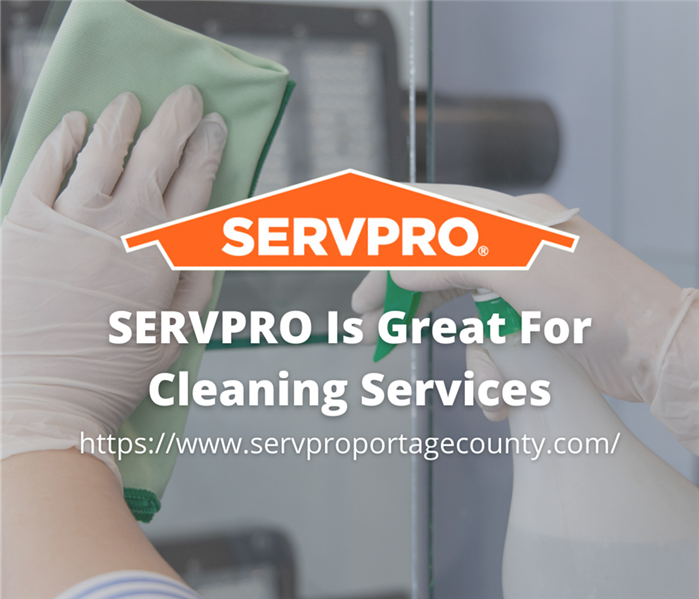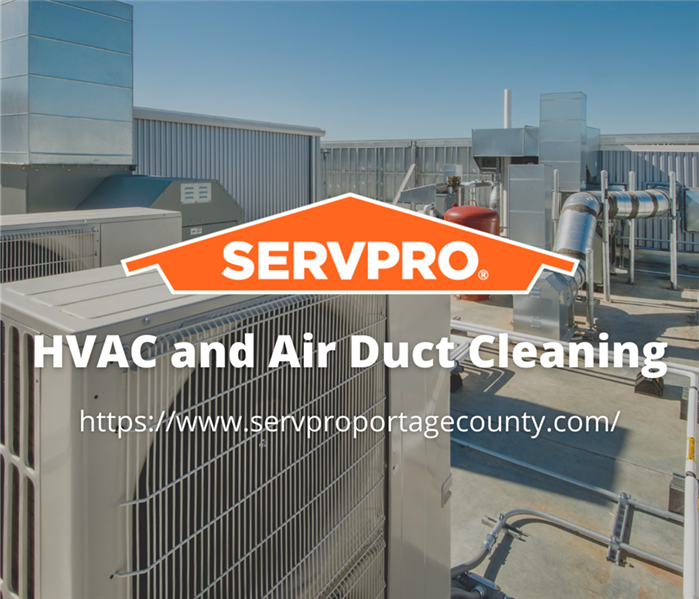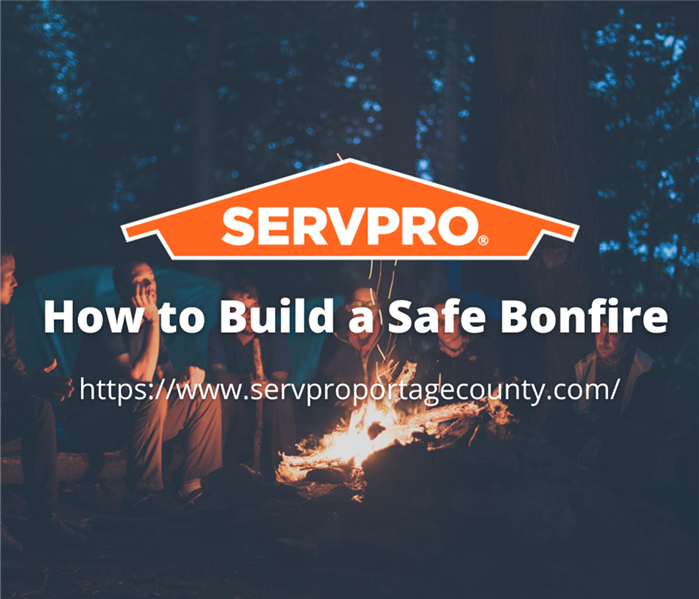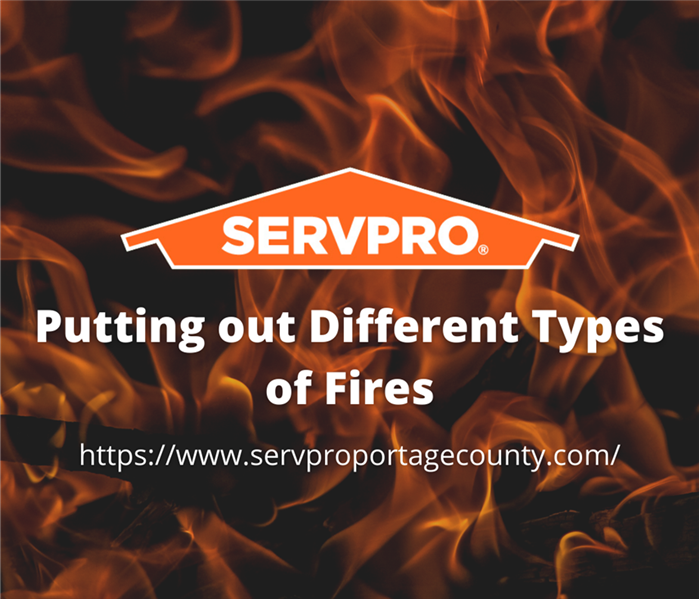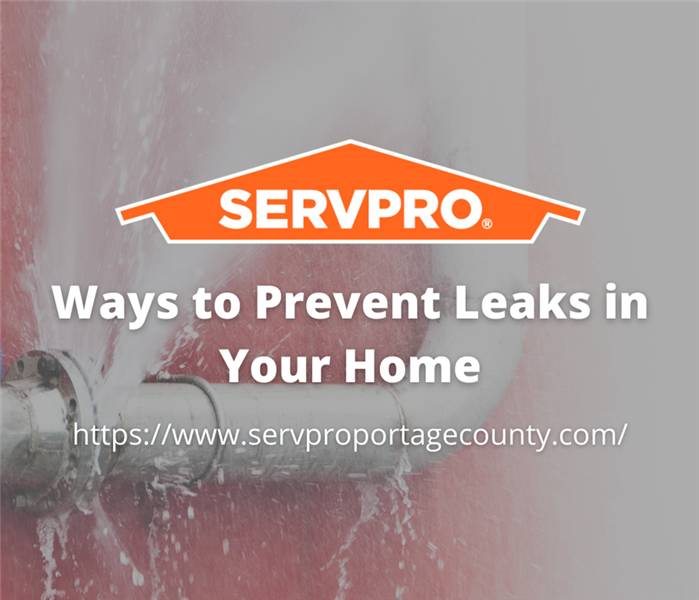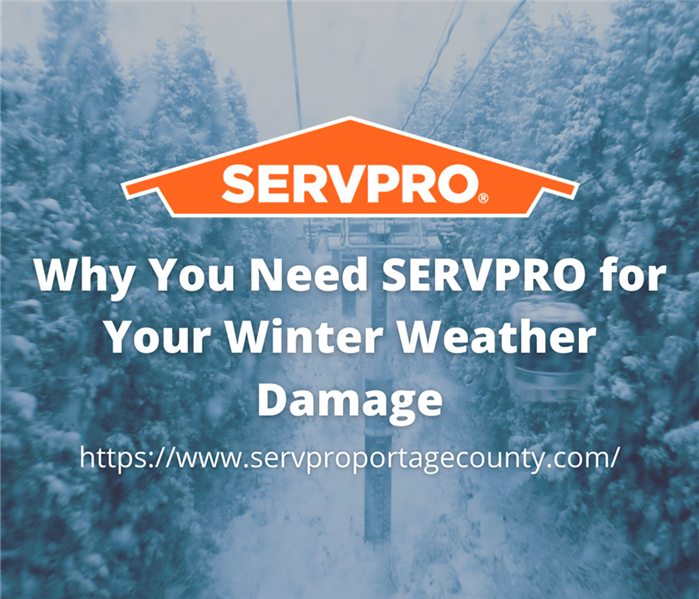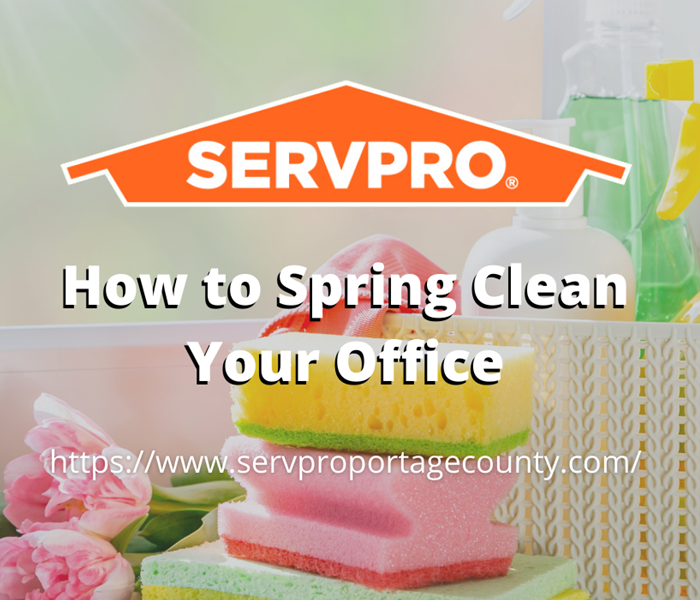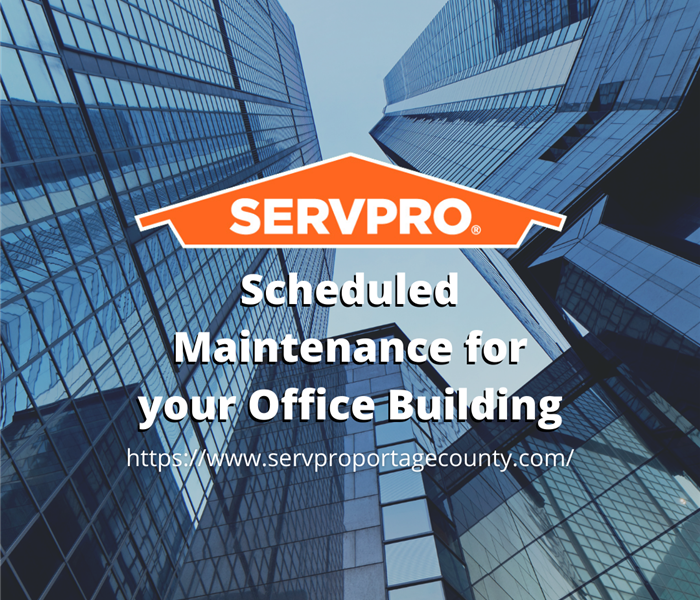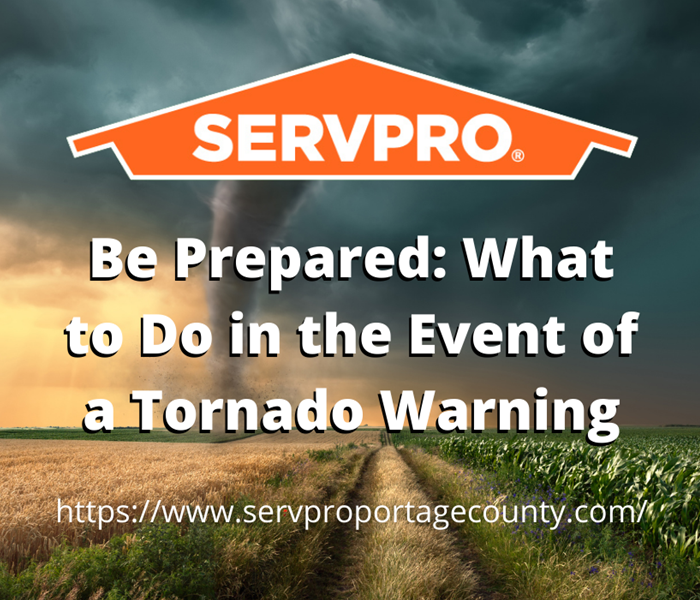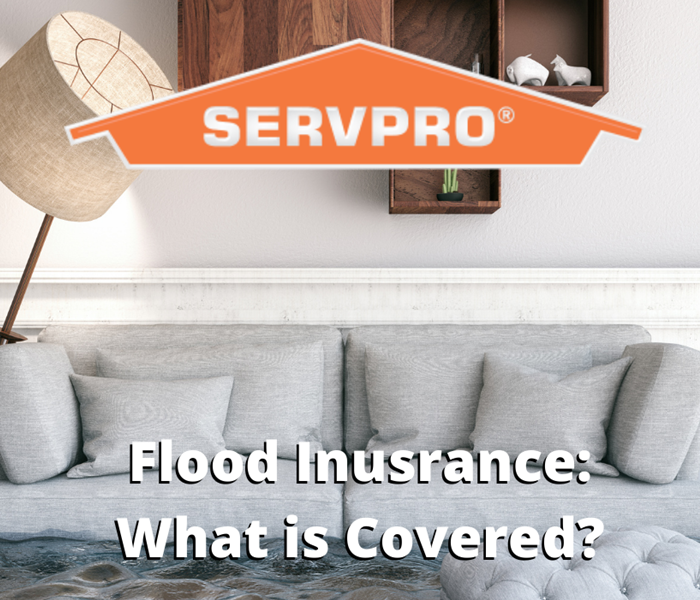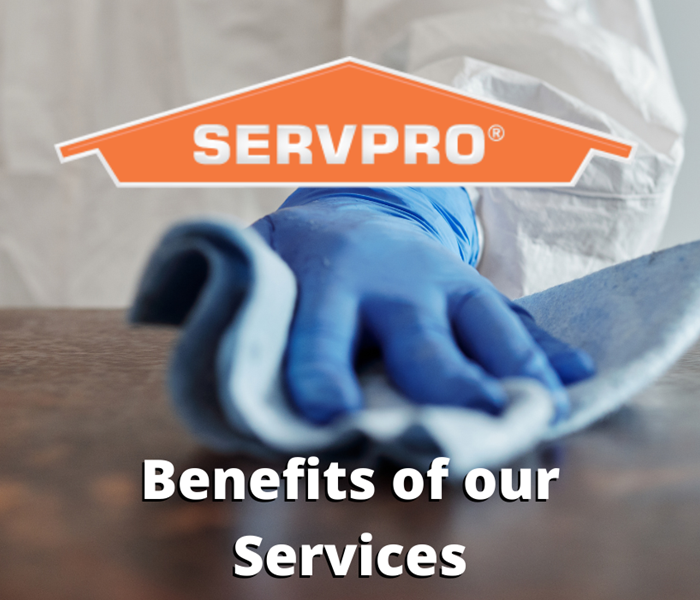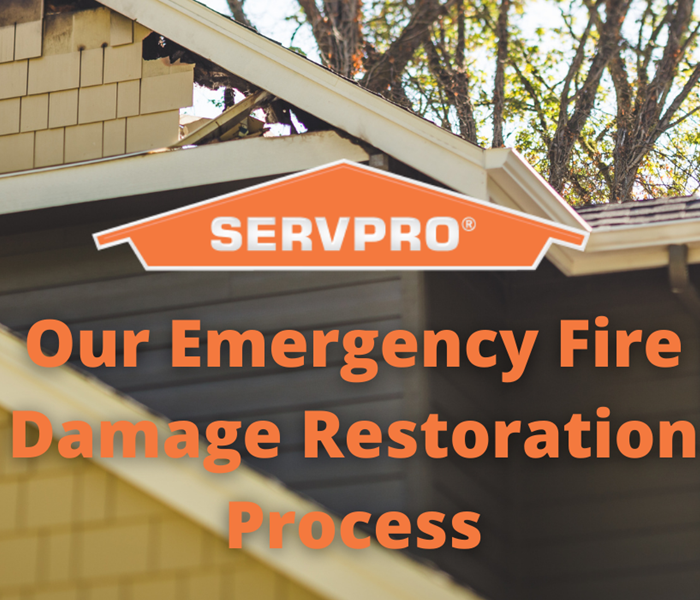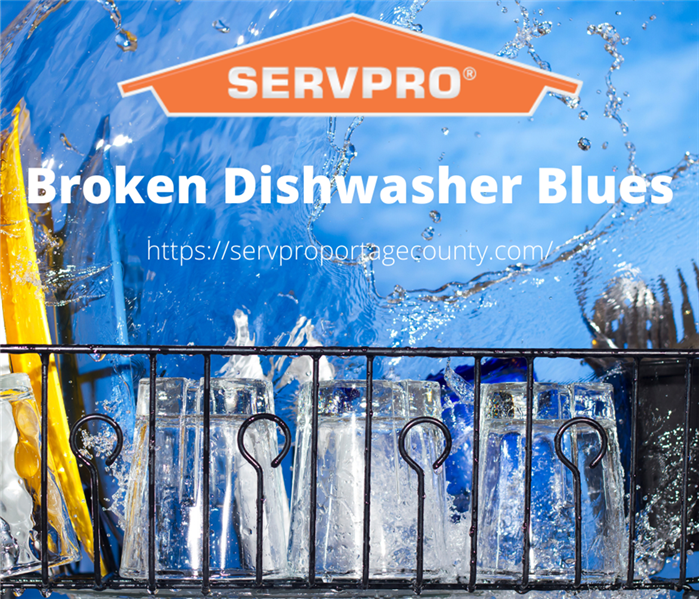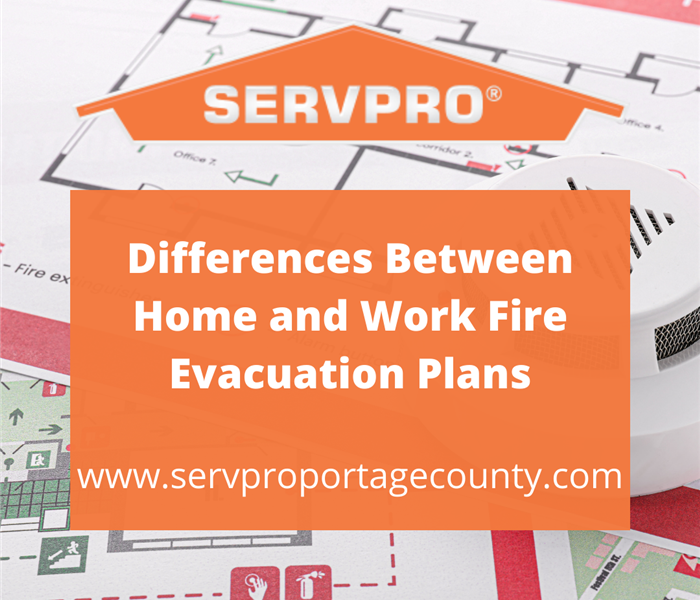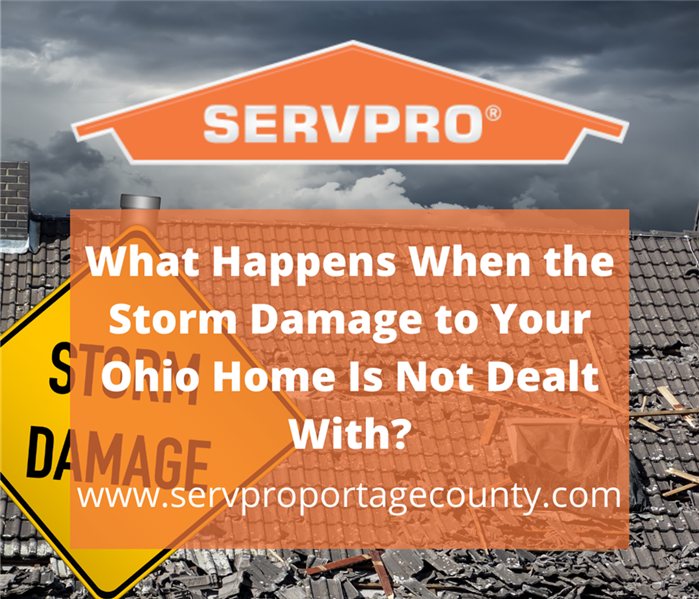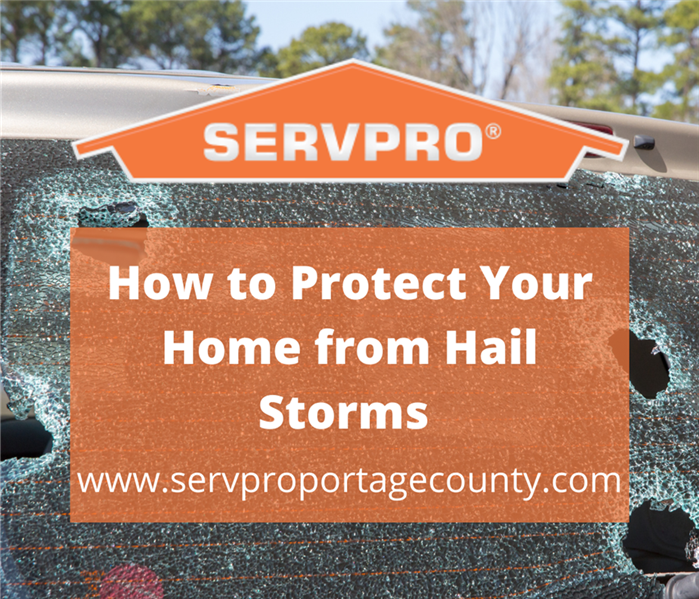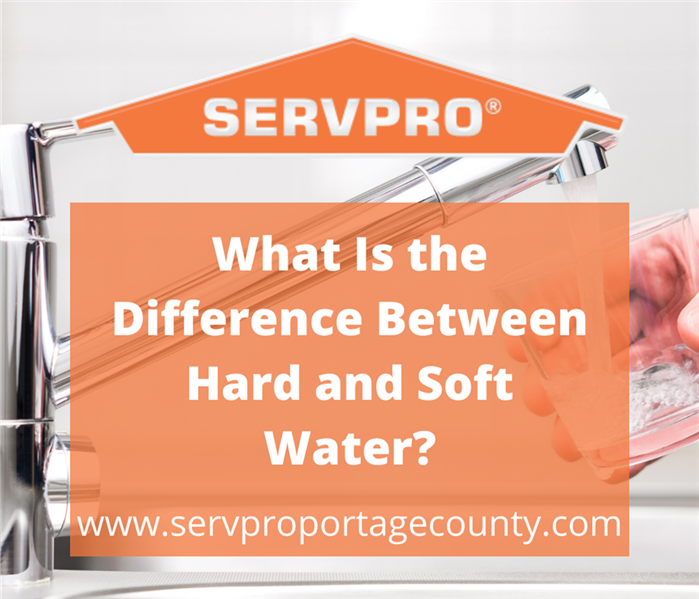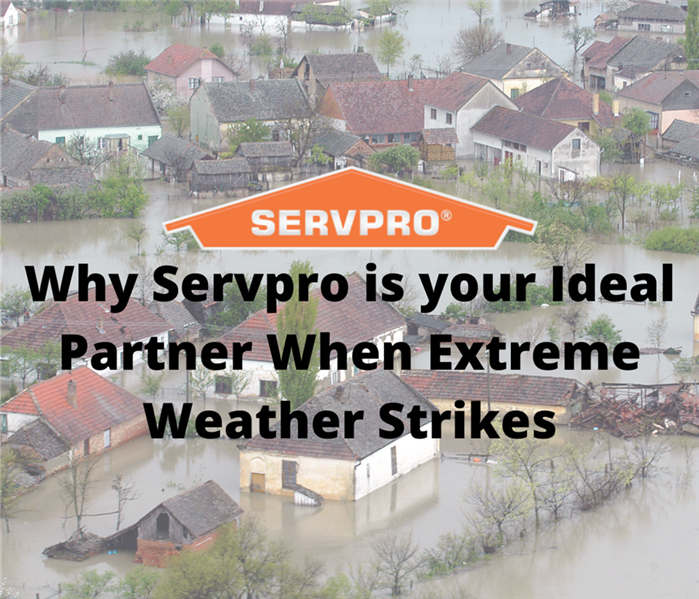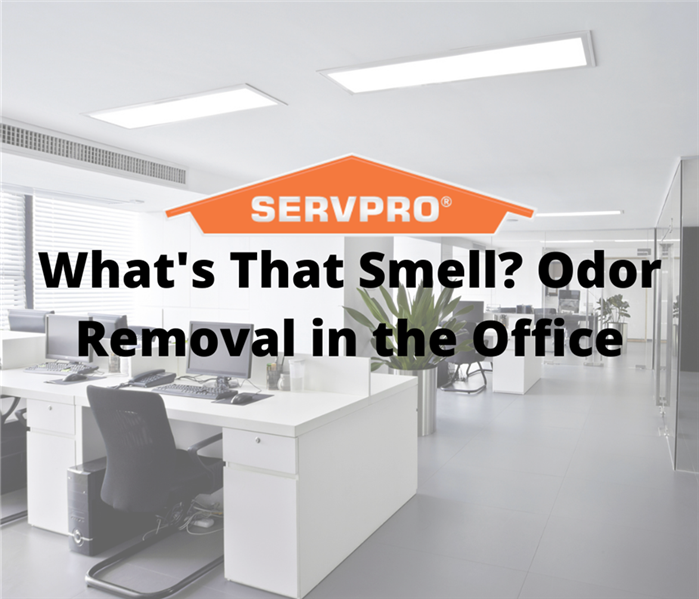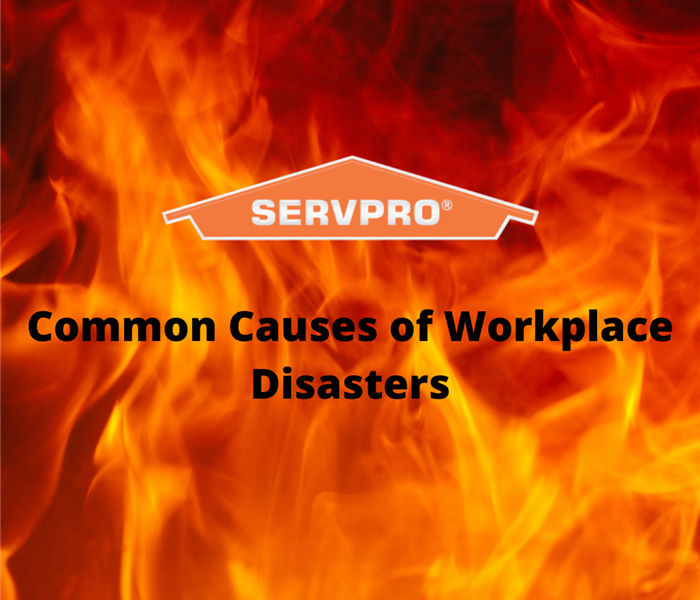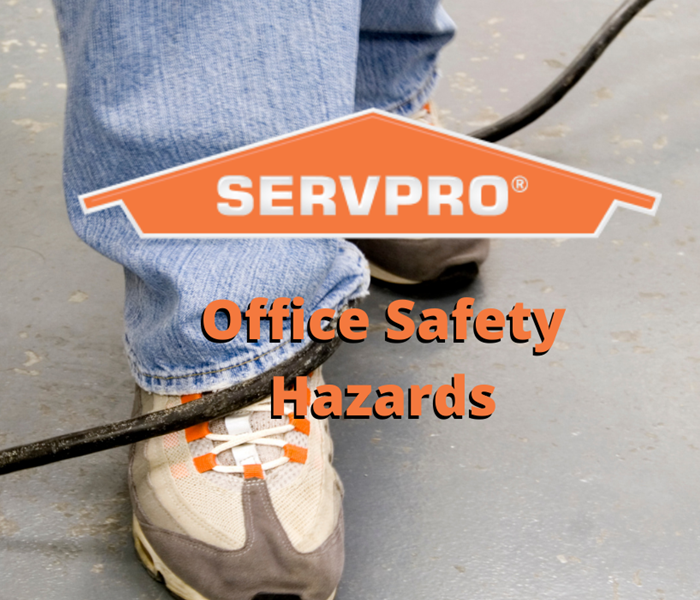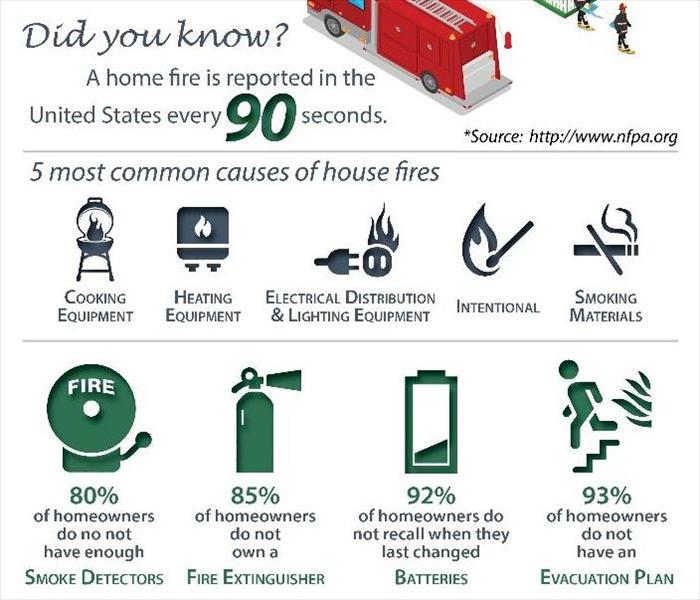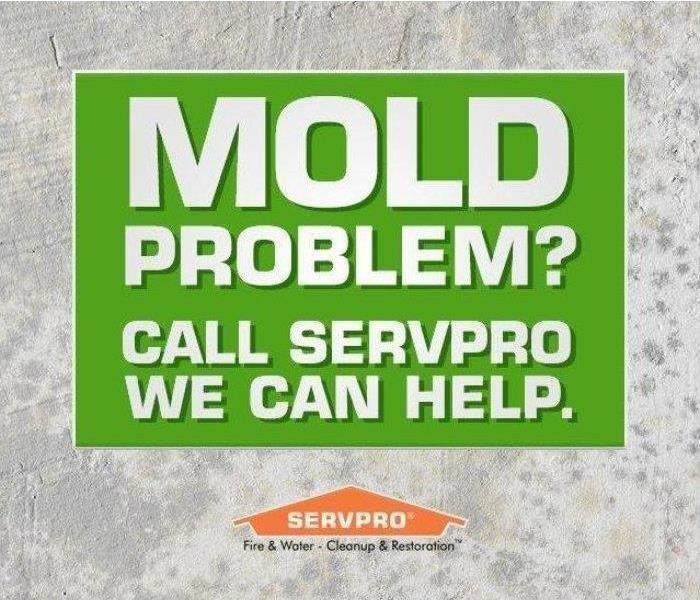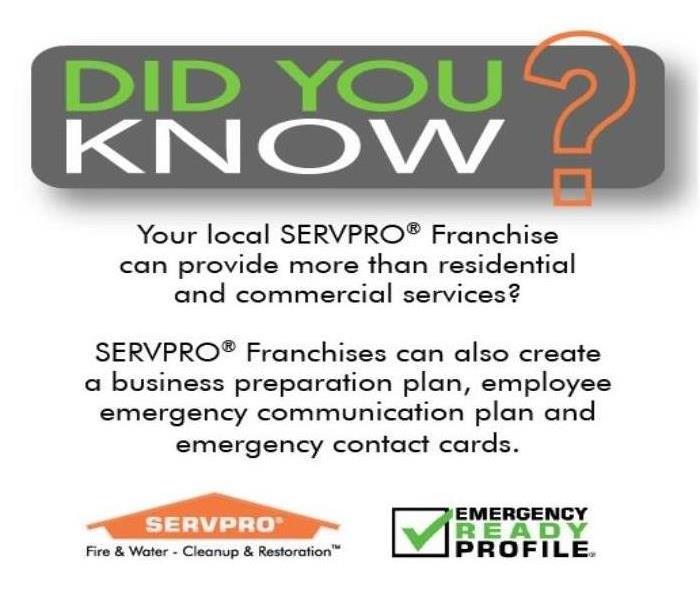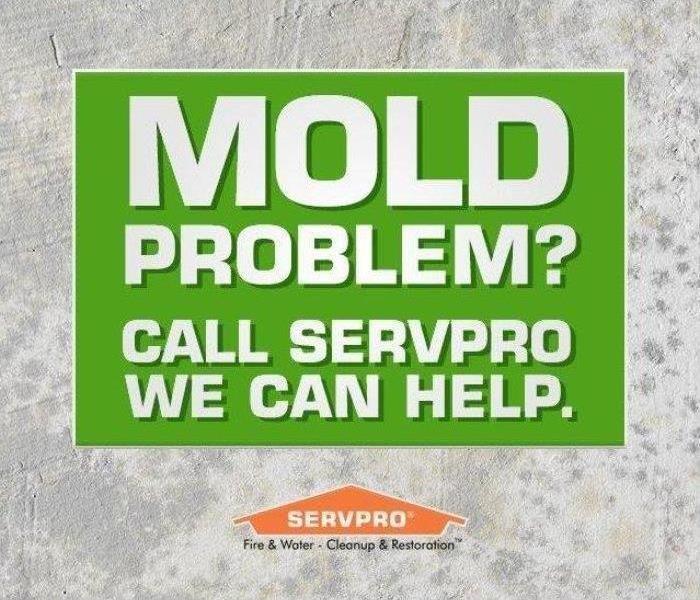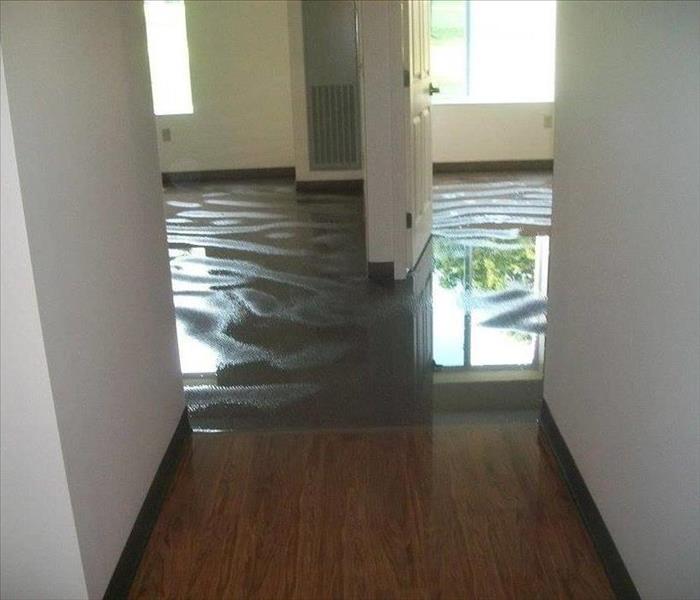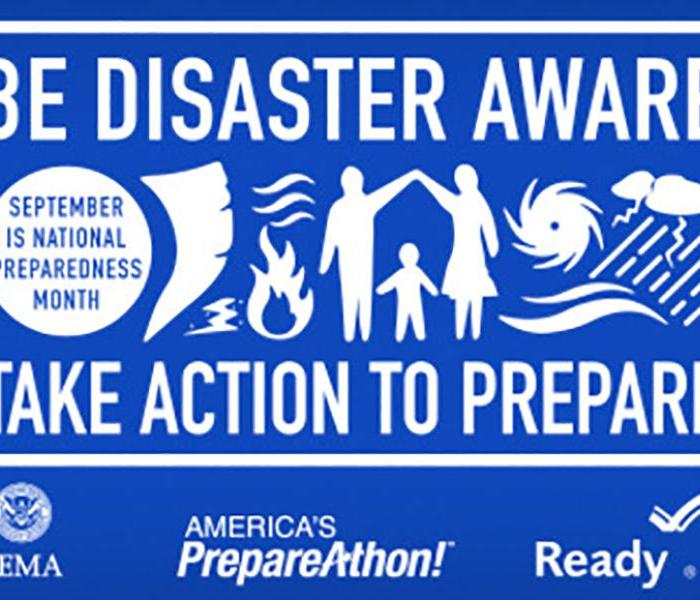Archived Blog Posts
SERVPRO Is Great For Cleaning Services
7/6/2022 (Permalink)
SERVPRO is great for many different reasons and we have a cleaning service for any size disaster. From HVAC/Air Duct Cleaning to COVID-19 Cleaning, SERVPRO® does it all, so that you don’t have to.
HVAC/Air Duct Cleaning
If the air ducts and vents in your home are looking a bit dirty, you may need our services for HVAC duct cleaning to inspect them and give you the next steps toward better home air quality. Making sure that the air in your home is of good quality and that you’re checking this frequently is important.
Biohazard/Crime Scene Cleanup
The restoration of your property following a biohazard event or a crime requires experienced and empathetic professionals like those at SERVPRO® to safely clean them to our professional standards. Challenging cleanup requires a professional, and that professional is SERVPRO®.
Document Restoration
When a home or business has been damaged by a flood, fire, or some other emergency, acting quickly to restore small but important items made of paper, such as photographs, certificates, and vital documents, will help prevent them from being lost for good. When this disaster happens, you need professionals in document restoration, that’s why SERVPRO® is here to help.
Odor Removal
SERVPRO® uses state-of-the-art products, equipment, and techniques to rid your home of pervasive odors, getting to the source and leaving your place smelling fresh. From pet odor to sewage odor, SERVPRO® is here to help.
Vandalism & Graffiti
When your home has been targeted by vandals, SERVPRO® can clean up the mess, including broken windows and graffiti, before it becomes a larger issue with more costly repairs.
COVID-19
As we all move forward in the battle against COVID-19, inspiring safety and confidence in our communities remains the number one concern. That’s why at SERVPRO®, we remain dedicated to bringing a higher standard of cleanliness to businesses across the country through Certified: SERVPRO® Cleaned. We’ll be here to help if you are ever in a COVID outbreak situation, and we’ll make sure that you feel better, your family feels better, and your team feels better.
We have many different services available at SERVPRO® and that is why you should always choose SERVPRO® we’re the experts.
HVAC and Air Duct Cleaning
7/6/2022 (Permalink)
Ventilation systems are often the biggest culprit in poor indoor air quality in businesses within Portage County. Make it a priority to inspect the ductwork of your business. If your HVAC has been operating for some time without attention, it could be circulating one or more of the following: dust, pollen, odors, dirt, and debris. We will get this clean and taken care of so you can have the great air quality you deserve. SERVPRO of Portage County Professionals routinely inspects the heating, ventilation, and air conditioning unit (HVAC). Keeping them clean can extend the life of the equipment.
However, duct cleaning is not always necessary. We will make recommendations about the best way to address any indoor air quality concerns. This can save you money and provide peace of mind about the health of your system.
The benefits of servicing your HVAC unit include:
- Helps to restore energy efficiency.
- Can help to eliminate offensive odors.
- Helps reduce the potential for mold growth.
How to Build a Safe Bonfire
6/23/2022 (Permalink)
To build a safe bonfire, there are a few tips to remember. Building a bonfire is fun because you can tell ghost stories, make smores, roast hotdogs, and sing campfire songs. You just need to pile up dry wood in a safe place and light a match. Building a bonfire can be very fun, but it is important to remember that safety comes first.
Before you make your bonfire:
- Make sure that bonfires are legal in your area, and during which times of year
- Contact your local fire department to see if there are any requirements for building an outdoor fire
Proper Bonfire supplies:
- Tinder (newspaper, bark, needles, pine)
- Kindling: Kindle are larger sticks to be used for the fire
- Fuel: Logs will be used to keep the fire going for however long you please
How to build the fire:
- Make a circle with bricks or stones. If you are considering making a permanent bonfire pit in your yard, consider digging a hole and bordering it with stone or bricks.
- Stand the tinder up in a teepee shape in the center of the circle.
- Make a teepee using the tinder, and be sure to leave gaps so that oxygen can escape.
- Add some fuel logs. Make sure they are parallel to each other on either side of the teepee. Repeat this process up to 5 times depending on how large you want your bonfire to be.
- When the bonfire is set up, drop a match in the center of the teepee to get the fire started. Make sure the match is completely inside the teepee.
Putting out Different Types of Fires
6/1/2022 (Permalink)
Fires are complex, and each fire has different plans for action and for extinguishing. There are five different types of fires, Class A, Class B, Class C, Class D, and Class K. There are ways to approach each type of fire, and knowing tips and ways to extinguish these fires will be beneficial if you are ever caught in a fire safety situation.
Class A
Extinguishing with water, using a hose to have constantly flowing water into the fire is the best way to put these out. These types of fires are commonly ignited by wood, trash, papers, plastics, and more. Dumpster fires are prime examples of Class A fires.
Class B
Extniguies by depleting oxygen. If a Class B fire ignites, the best bet for extinguishing is by trying to smother the flames. If you use water on these types of fires the flame will spread and cause more damage. These types of fires are commonly ignited by the exploding of flammable liquids. Gasoline, alcohol, oil, and more can cause Class B fires.
Class C
Extinguishes by shutting off the power. These are known as electrical fires and the best way to extinguish these fires is by cutting the power off, which is described as the fuel source for the fire.
Class D
Extinguishes with dry powders. These types of fires are common in laboratories and are ignited by combustible metals. Never use water to extinguish, this will worsen the flames. Powdered copper, graphite, and sodium chloride are effective in extinguishing Class D fires.
Class K
Extinguishes with fire extinguishers. These are cooking fires, and these fires are sparked by greases, oils, and fats. The chemical fire extinguishers you have on hand are the best for putting these out because the chemical agents contained in these fire extinguishers absorb the heat of the flames.
Ways to Prevent Leaks in Your Home
5/24/2022 (Permalink)
Leaks can span from a pipe bursting to a leaky roof that is extremely noticeable when there are high amounts of rainfall. There are ways to prevent any types of leaks in your home, and these will be beneficial in preventing any water damage.
Inspect Drains and Gutters
Making sure that your drains and gutters are not damaged or water is not trapped in them is a great way to prevent any leaking on the outside or inside of your home. One tiny leak can lead to a bigger problem, and preventing this from happening is what you should aim for.
Damaged Sump Pump
Making sure that you or your provider are checking your sump pump regularly is a great way to prevent any water damage. Catching these issues early and keeping up with any issues you may have is a great strategy for preventing further damage.
Rain Runoff
Making sure that your rain runoff setup is away from your house is a great prevention technique in making sure that the water does not pool around your home or seep into cracks and holes that could lead to bigger problems.
Water Main Shutoff Valve
Making sure that you have steps to prevent any water damage before it happens is the goal. Having a water main shutoff valve is great for keeping track of your water and seeing when there is too much, or when your home could be at potential risk of flooding or a leak.
There are many ways to prevent leaks to your home, and keeping up with your home and catching these issues before escalation is a great way to prevent future water damage. SERVPRO is here when you need us, 24/7.
What is a Boil Alert?
5/2/2022 (Permalink)
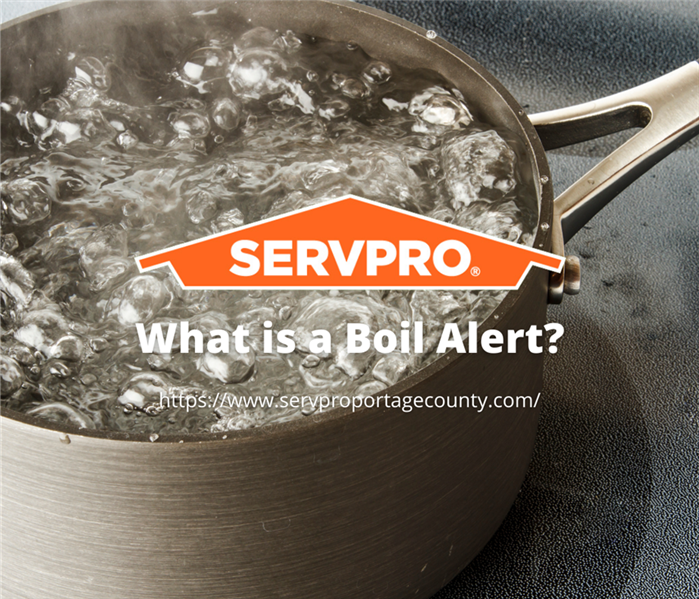 What is a Boil Alert?
What is a Boil Alert?
Boil alerts are not extremely common, but there is always a chance that these could happen wherever you are. Knowing what to do and understanding what this means will be beneficial to you and your family in the long run.
Boil Alerts or Boil Water Advisories are known as circumstances where local health officials will advise you to use bottled water or to boil water from your sink. This is because boil advisories are due to germs being found in your water or a potential threat for germs being found in your water. What is some common advice for these occurrences?
Using Bottled or Boiled Water
This will be suggested for drinking and for cooking and preparing food. Even if your tap water is filtered, you should still boil it for extra caution.
Handwashing
You are usually still able to wash your hands with soap and water. Just make sure you are doing it for the recommended 20 seconds.
Showering or Bathing
This is also still okay, but be cautious and do not swallow the water that you are showering or bathing in.
Brushing Your Teeth
When you are brushing your teeth, it will be advised to use bottled or boiled water.
Dishes
Rather than using and washing dishware, it will be advised to use disposable plates, cups, and utensils if possible.
These are the main occurrences that you should be aware of if you are ever in a Boil Alert or Boil Water Advisory.
Why You Need SERVPRO for Your Winter Weather Damage
3/30/2022 (Permalink)
At SERVPRO, we use advanced technology and techniques to not only clean up after your disaster occurs but to detect any damage it may have left in its tracks.
This time of year, moisture detection is imperative to keeping your home safe and damage-free. When ice melts, the water seeps into the ground, which can cause two problems:
- The soil can expand, causing pressure against the foundation of your home. This pressure can cause damage such as cracks, which can lead to…
- Water getting into your foundation. This can cause water damage not only to your foundation but to integral parts of your home, such as your basement or garage.
Luckily, SERVPRO has specially-designed equipment for detecting and measuring moisture. Once the water damage has been found and assessed, we use advanced water extraction technology to speed up the process of removing water from your home and drying your belongings.
Our odor removal and deodorization equipment are first-class in removing the musty smell that water can leave behind.
When times get tough, you shouldn’t have to worry about cleaning up afterward– leave that to the pros!
Why Our Customers Love Us!
3/3/2022 (Permalink)
When a pipe on the second floor of his mother’s house burst, Brian knew exactly whom he was going to call – SERVPRO.
“The burst had probably happened at least a day before, and the heater had been running non-stop, flooding the whole of the downstairs,” he said.
But an earlier experience of a similar flood years before meant Brian had no qualms whatsoever when his insurance agent gave him a list of approved contractors.
“SERVPRO was on the list so I just said call them,” said Brian. “The earlier leak was at least 15 years ago and was nowhere near as bad as this one as the water had only been running an hour, but they came immediately, dried the carpets, and did the tests for mildew and mold. They were quick and efficient.”
“I was comfortable with using SERVPRO and just automatically said use them again.”
And Brian was delighted to discover the service was just as good with the new flood. “They did the full water mitigation and clean up,” he said. “Their team had to cut up pretty much two feet on every wall, and even cut out some ceilings from where the water had come through from the floor above.”
“The house was trashed with water and stuff all over the place, but the SERVPRO team was fast. They had all the furniture moved, carpets out and demolition done in a couple of days, and drying equipment brought in.”
Now SERVPRO is helping Brian reconstruct his mother’s home in Cuyahoga Falls and said: “My contact at SERVPRO, Joanne, walked us through everything. I was especially happy as my mom is 80 and she took the time to make sure she understood everything that was happening.”
“I would absolutely recommend SERVPRO to other people,” said Brian.
How to Spring Clean Your Office
2/2/2022 (Permalink)
There’s something about spring that makes us want to clean up and start fresh. Maybe it’s the vibrant colors as trees begin to leaf and flower. Maybe it’s the warmer temperatures that wake us up from our winter hibernation. Whatever it is, the same urge follows us to our workspace, and we feel compelled to spring clean the office.
But cleaning an office space can feel overwhelming, depending on how big and how messy the office is. So here are some ways to make spring cleaning your office space less overwhelming.
Make it a team effort. Chances are you share the office with other employees. If so, then it shouldn’t fall on you alone to do the cleaning. If your colleagues aren’t so excited about a clean office, schedule a time during office hours when everyone can clean together. Assign each of them a manageable task that they can do in a short period of time. If there is a lot to do, then schedule more cleaning times, but make sure to spread them out.
Divide and conquer! Instead of cleaning the entire office, break the office into smaller sections, and clean one section at a time. For example, today you can plan to clean up one room and tomorrow the next. If you have a plan of attack, then cleaning won’t feel overwhelming. And the great part about breaking the task into smaller tasks is that you can create a list and check off the tasks as you complete them. It’s so satisfying!
As you clean, remember that cleanliness and sanitation is more important than ever. Take the time to thoroughly clean all furniture and surfaces with disinfectant. Do the same for keyboards, mouses, telephones, door handles and lightswitches. Any surfaces that get a lot of hand traffic should be thoroughly cleaned daily.
If you’re looking for a certified cleaning program that will keep your employees safe, your local SERVPRO franchise can help with the following:
Click here to find a SERVPRO near you!
Scheduled Maintenance for your Office Building
2/2/2022 (Permalink)
The condition of your office directly impacts your team’s productivity, health, and happiness. Keeping your office space clean and maintained can seem like a fulltime job in itself and requires constant attention. Taking a systematic approach to office cleaning and maintenance can not only keep your office looking presentable and functional, but save you time and money.
Scheduled maintenance is any repair and upkeep work performed within a set timeframe. It details when given maintenance tasks are performed and by who and occurs at repeating intervals. The common categories of scheduled maintenance include: Cleaning, Roofing, HVAC, Plumbing, and Lighting.
Cleaning- Cleaning tasks should be performed daily, weekly, monthly, and quarterly in order to keep your office spotless. Deep cleaning should be performed quarterly or bi-annually. In order to ensure a manageable routine, hiring a cleaning company for these tasks can be helpful.
Roofing - Should be inspected twice a year and after adverse weather conditions. Based on the inspections you may need to take action to prevent damages.
HVAC - Inspections on HVAC units should take place twice a year, and this should be performed by a professional. Air filters should be cleaned once a month or twice a year, depending on the type, be sure to find out what type you own.
Plumbing - Plumbing requires full annual inspections completed by a licensed plumber.
Lighting - Lighting usually will be pretty obvious when maintenance is required, but you can stay ahead by creating a relamping schedule. Electrical system check ups must be done by licensed electricians every 3 to 5 years.
While cleaning has always been an important and necessary part of owning an office space, COVID-19 has increased the need even further. SERVPRO offers commercial cleaning services guaranteed to keep your office looking its best. In response to the recent pandemic SERVPRO introduced, Certified: SERVPRO Cleaned, a defensive cleaning program gives your business a way forward to provide your employees and customers ongoing safety as you operate after the COVID-19 pandemic. Schedule your first cleaning appointment today and add us to your scheduled maintenance routine.
Be Prepared: What to Do in the Event of a Tornado Warning
2/2/2022 (Permalink)
Tornado warnings are not something to take lightly. In the event of a Tornado warning, you should be vigilant, prepared, and quick. These are some tips and some things you should watch out for in the event of a Tornado warning.
Keep an eye on weather alerts
In the case of a Tornado warning, you should always be keeping up to date on what the weather channels and radars are saying and showing. In the event of a warning, this means that a Tornado has been spotted near your area, which means you should always be watching the news live, or keeping up with what’s happening on a mobile phone or device.
Go to the safest spot in your home or the place in which you are residing
The safest place for Tornadoes is the lowest part of your home. In many cases, this is the basement, but, if you do not have a basement, a small room with no windows, a bathroom, or closet will be your safest bet, the lowest floor of your home, or the place you are in is the best option.
Have a safety kit ready.
The safety kid should be ready and easily accessible, the kit should have a flashlight, water, food, and other necessities for survival, or extreme situations.
Remove or secure outdoor furniture
If these items or furniture pieces are not secured, they can act as weapons that may hurt you and your loved ones. If you know of a possible chance of high winds, secure the furniture, or store it in your garage or a safe place to be extra cautious.
How to Always Be Prepared for the Next Winter Snowstorm
2/2/2022 (Permalink)
The North American winter storm of 2021 and the Texas power crisis showed us that we need to be ready for any kind of weather anomaly. Even in April, it’s important to be prepared for the next winter snowstorm.
Here are some tips to keep you and your family safe when winter gives us its worst.
Know winter storm watch terms
- Winter storm watch -- Current conditions are favorable for hazardous winter weather within 48 hours. It’s not certain, but it’s possible.
- Winter weather advisory -- There is either freezing rain or 2 to 4 inches of snow that could cause inconveniences.
- Winter storm warning -- Life-threatening winter weather is expected. It could include 5 or more inches of snow in 12 hours; more than 7 inches of snow in 24 hours; extreme ice accumulation that could damage trees and powerlines; or a combination of snow, ice, and wind.
Prepare ahead of time
- Stock up on essential items: flashlights, snow shovels, rock salt, first aid kits, batteries, blankets, emergency radio.
- Inspect your chimney, roof, and gutters.
- Invest in a generator in case of power outages.
- Weatherize your doors and windows.
- Make sure your home is adequately insulated.
- Check pipes to prevent freezing.
- Inspect your smoke and carbon monoxide detectors.
- Winterize your car and fill your gas tank. (Do not drive during a snowstorm unless there is an emergency.)
- Charge all phones and electronic devices.
- Stock your pantry with nonperishable foods and water.
During a snowstorm
- Dress in warm, waterproof clothes.
- Stay inside and turn the heat up, in case of a power outage.
- Stay hydrated.
- Run a slow and steady drip of water to prevent pipes from freezing and bursting, if they aren’t insulated.
After a snowstorm
- Stay tuned to the local weather stations.
- Avoid driving until weather and road conditions improve.
- Shovel snow safely. Know your limits and don’t overdo them.
- Sprinkle rock salt, sand, or kitty litter to create traction on slippery surfaces.
Follow these tips, and you’ll avoid many of the most common dangers posed by snowstorms.
Flood Insurance: What is Covered
1/18/2022 (Permalink)
Have you ever been told that you should purchase flood insurance? If you live in a flood-prone area, the chances are you probably have, and you probably have questions. We’re here to answer them for you!
What Does Flood Insurance Cover?
There are two main types of flood insurance-- building coverage and contents coverage. Building coverage covers your electrical and plumbing systems, furnace, water heater, permanent appliances, permanent flooring, cabinets, walls, and most other things that are physically a part of the building you are insuring.
Contents coverage covers personal belongings, such as furniture, clothing, curtains, removable appliances (such as washers, dryers, or microwaves), non-permanent flooring, and your valuables.
What DOESN’T Flood Insurance Cover?
Luckily, flood insurance will cover most of your property and belongings, but there are some things that it won’t cover. For example, most flood insurance will not cover vehicles, temporary housing while your home is restored, valuables such as currency or precious metals, or personal property that you keep in your basement.
Even when it comes to the items that are generally covered by flood insurance, your coverage may ultimately depend on the cause of the flood. For example, a backed-up sewer will not be covered by flood insurance unless the backup was a direct result of the flood.
Benefits of our Services
1/18/2022 (Permalink)
Life happens-- things get spilled, pets have accidents or track mud through the house, factories have spills, among all the other things life can throw at you. Luckily, SERVPRO is here to help you with any clean-up you may need! We can help clean up messes you may not have even known were there!
Here’s how we do it:
Carpet
- Bonnet Cleaning: A less aggressive method for short piled carpets. Carpets that are cleaned using this method also tend to dry in 30 minutes or less, and spots and stains are less likely to return in comparison with other carpet cleaning methods.
- Hot Water Extraction: A deeper cleaning method for all carpet types. Hot water extraction is an eco-friendly way to get dust and allergens out of your carpet while also disinfecting it. This method is also ideal for commercial carpet cleaning, as it’s much more gentle than many other carpet cleaning methods.
- Deluxe Precondition and Rinse: Helps restore deeply soiled areas by removing deep stains and conditioning your carpet. This method can also help to restore carpet piles and is ideal for the restoration of water-damaged carpets.
- Showcase Premier Cleaning: The most thorough cleaning method in the industry. Showcase Premier Cleaning is a 2-step process where the carpet is shampooed and then conditioned and rinsed. This is also the ideal cleaning method for carpet restoration after fire damage.
- Dry Cleaning: When color-fastness is an issue. Dry cleaning allows you to break down dirt by applying a pre-treating agent prior to the use of other cleaning methods.
Air Duct/HVAC
When it comes to your air ducts or HVAC system, it’s all about preventative maintenance. SERVPRO professionals will inspect your heating, ventilation, and air conditioning units and help you to keep them clean, saving you money that you may have otherwise spent on repairs and keeping your air fresh! It can also help to prevent or eliminate odors or mold.
Ceilings, Walls, and Hard Floors
While your ceilings, walls, or hard floors may not look dirty, they probably are. These parts of your home are exposed to things like cooking oil, pet dander, and dust, among other things, every single day! This means that even if your home or office looks clean, they’re most likely beginning to accumulate soil.
Using our advanced cleaning methods, SERVPRO can help you restore your ceilings, walls, and hard floors and get them looking brand new without needing a coat of paint! If you are planning on painting, however, it’s still a good idea to get your walls professionally cleaned first-- that way, you can be sure your primer and paint will adhere to the wall properly!
An Overview of Our Emergency Damage Restoration Process
1/3/2022 (Permalink)
Have you ever wondered how SERVPRO can restore and clean your home so quickly after a fire? It’s easy-- we have to! Continue reading for an overview of what we do, when we do it, and why it has to be done quickly!
- One Hour: SERVPRO professionals will contact you to arrange for your restoration within 1 hour of your initial contact.
- Four Hours: Within 4 hours, SERVPRO will be onsite and begin services-- the key to a successful restoration project is to begin immediately!
- Detailed Explanation: A SERVPRO professional will walk you through the restoration process so you can be confident in our services.
- Pretesting: We will begin pretesting to see how much we can restore by beginning directly from the source of the damage.
- Eight Hours: A verbal briefing will be provided to the property owner or manager.
- Cleaning, Restoration, & Deodorization: We will work neatly and efficiently to help you restore the damage to your property using state-of-the-art techniques and equipment.
Final Walk-Through: Once the restoration process is complete, a SERVPRO professional will conduct a final walk-through of your property to ensure that your home is restored to your satisfaction.
Broken Dishwasher Blues: Cleaning After An Appliance Causes Water Damage
1/3/2022 (Permalink)
One of our primary focuses here at SERVPRO is storm damage-- but there are a lot of other things that can cause damage to your property. For example, have you ever thought about what you should do if your dishwasher causes a flood?
The first thing you should do as soon as the flood has occurred is to shut off the circuit breaker and mop up the water in your kitchen. It’s important that you shut off the circuit breaker rather than attempting to unplug your dishwasher-- unplugging any electrical appliances during a flood can be extremely dangerous.
Once this is done, it’s time to open your dishwasher and inspect the damage. Carefully remove any dishes that may have been in the dishwasher and keep an eye out for anything that may have broken. Also, check to see if any parts of the dishwasher could have been blocked up, causing the flood.
Depending on your dishwasher’s warranty, some things, such as hoses, can be easily repaired or replaced on your own. However, if your dishwasher is still under warranty or the problem appears to be a particularly difficult fix, it’s best to hire a professional. Depending on the extent of the damage to your kitchen, you may need to hire a water damage professional, like SERVPRO, to begin the restoration process.
Space Heaters: Do's and Dont's
12/30/2021 (Permalink)
It has cooled down and it’s officially time to turn on the heaters. Space heaters are high-wattage items that have the potential to create fire and set items like curtains and clothing on fire. According to the DoE, 6,000 people go to the emergency room with burns from coming into contact with space heaters. If you follow the proper safety precautions, your space heater will be safe to operate.
DO:
- Check the label of the heater. Your space heater should be listed by a qualified testing laboratory.
- Buy a heater with a smart sensor. Some space heaters have sensors, and they will turn off when they overheat or if it tips over.
- Check here to make sure your space heater has not been recalled.
- Make sure that your space heater has been updated and has been tested. In addition, make sure that your carbon monoxide detector is tested monthly.
- Examine your space heater and check the cord and plug. If you think that there is damage, do not run your space heater.
- Unplug your heater when it is not in use.
DON’T:
- Keep your heater near water. Your space heater should not be left in kitchens or bathrooms, where water is likely to splash around.
- Keep your space heater near flammable objects. Objects such as curtains, papers, furniture, pillows, and bedding are all objects to avoid when using your space heater.
- Leave your heater alone. Make sure that you are in the room while you are using your space heater, especially if there are young children nearby. In addition, do not leave your space heater on while you are sleeping.
If you have questions or concerns about your space heater, check it frequently and make sure that it is working correctly. Lastly, before you buy your heater, make sure that it is not recalled.
What to Do if There's a COVID Outbreak in the Office
12/28/2021 (Permalink)
As if work wasn’t already stressful enough, this year, you also have to add in company shutdowns, working from home, masks, and so much more to the list. During this time, it is important to have a plan in place in case Covid-19 comes into your workplace.
If someone is experiencing symptoms that have been linked to Covid-19, they should begin to quarantine and get tested. If an employee tests positive, it is important that anyone that had close contact* with that individual also gets tested, as well as anyone experiencing symptoms. If it is possible to work remotely it is ideal to do so for the next 2 weeks.
If an employee tested positive for COVID-19 and worked while contagious, it is recommended to thoroughly clean this space using EPA-approved disinfectants, a diluted bleach solution, or 70% alcohol solution. According to CDC, the following cleaning and disinfecting should be performed in your facility:
- Close off areas used by the person who is sick. Companies do not necessarily need to close operations, if they can close off affected areas.
- Open outside doors and windows to increase air circulation in the area. Wait 24 hours before you clean or disinfect. If 24 hours is not feasible, wait as long as possible.
- Clean and disinfect all areas used by the person who is sick, such as offices, bathrooms, common areas, shared electronic equipment like tablets, touch screens, keyboards, remote controls, and ATM machines.
- Vacuum the space if needed
Once the area has been properly disinfected, business can be reopened and workers that did not have close contact* with the infected individual can return to work. If any customers or clients had close contact with the employee, they should be notified, but you do not need to reach out to all.
The employees who tested positive or came in close contact* are able to return to work once they have both been fever free without medication for 24 hours and it has been 10 days since the onset of symptoms. If asymptomatic, 10 days after the positive test.
Stay vigilant about preventing the spread of Covid-19 by following CDC guidelines. SERVPRO can help with Covid cleaning after an outbreak, or in prevention.
*close contact is defined as being within 6 feet of an infected person for a prolonged period (15 minutes or more) starting from 2 days before illness onset. The 15 minutes does not need to be continuous. Face coverings do not eliminate all risk
Five Things you Should Never Burn in your Outdoor Fire Pit
11/1/2021 (Permalink)
Though it may be fun or therapeutic to burn items in a fire, there are a few that should never be burned in a fire for your safety. Do not burn rubber, old paper, plastics, trash bags, or any sort of garbage in a fire. Many items that are processed can release toxic chemicals and pollute the air and create an unpleasant smell. This includes batteries and aerosol cans.
While it may be fun to burn a pizza box in the fire, this is all something that should never be burned in a fire. Cardboard and paper boxes can create an abundance of smoldering ash that can spread to nearby trees, bushes, and houses.
Poison Ivy or oak should never be burned in a fire. Poison Ivy isn't good for human skin, and it could be even worse for your lungs if ingested. To avoid burning poison ivy or oak, be sure to watch the type of vines that are wrapped around wood you are putting into a fire.
Lighter fluid or gasoline should also never be used to keep a fire going. It can be tempting or fun to see the temporarily big flame, it can be very harmful to those around you. AS a precaution, this should never be used in a fire.
Other items to avoid are soft woods, food scraps, or yard clipping. Yard clippings should especially be avoided because they could trigger allergies to those around you.
Lastly, if you are very unsure of what to be adding to a fire, stick to adding firewood as it is the safest option. Please contact your local fire department if you have more questions concerning a safe bonfire experience.
Should You Update Your Company Sick Policy Post COVID?
9/6/2021 (Permalink)
Before the COVID-19 pandemic began, how many times did you go into work sick?
If you did, you are not alone, not even close. In January of 2020 - studies showed 74% of workers felt pressured to avoid taking sick days and when the survey was geared solely towards the younger generation that number increased to a resounding 88%.
It was a common theme in the workplace to only call in sick when you were basically on your deathbed and a lesser issue, such as a cold or fever, was not enough to qualify for a call-off.
Whether the reason was fear of losing your job, money, or even a promotion, people tended to go to work with mild illnesses that could in fact be contagious.
Things changed last year with the emerging pandemic. Millions of businesses were forced to close their doors to both employees and customers and move to remote work. Those able to stay open had strictly enforced regulations including temperature checks before entering the building and quarantines for being exposed to the virus.
In response to the coronavirus pandemic, Congress passed the Families First Coronavirus Response Act, which gave employees up to 80 hours of paid sick leave to care for themselves or family members. Unemployment also received huge boosts to provide assistance to those unable to work during this time.
During the pandemic businesses did not have much of a choice in the updates to their sick policies, but now that the worst has passed and vaccinations are now accessible to all, how many changes are going to be made permanent?
Many of the effects of COVID-19 were devastating and brought about negative changes, but there were also quite a few positive results. Consistent handwashing and sanitizing of hands, keeping a distance from others, being aware of contagious symptoms, and taking action when they are present are some that are positive changes to stick to.
In the workplace, it will be important to make any changes to the existing sick policy that can ensure employees feel comfortable calling off as needed. 74% of people going into work sick is not ideal and it is up to employers to bring that number down.
If possible employers should add paid sick days to their policy, as after the last year we can see that option is a lot less costly than a global pandemic.
If not possible, employers should remove call-offs for being sick from any point systems or policies that provide negative results. Keeping employees and consumers safe should continue to be a number one priority.
SERVPRO has the knowledge and training to clean and disinfect businesses to CDC standards to help maintain this level of safety. Call today to receive more information on how we can help with any post-pandemic safety needs.
Differences Between Home and Work Fire Evacuation Plans
9/6/2021 (Permalink)
Fire evacuation plans are a way to make sure that you are safe in case of an emergency, whether you are at home or the office. Creating these plans differ based on the people and location; therefore, work and home require two different fire evacuation plans.
Establishing Roles
At home, your responsibilities will be divided amongst your family, which will be greatly influenced by the age of the members of your household.
In the office, your roles will have to be divided by the employees and what they feel comfortable doing. No matter where you are, make sure everyone is confident in their skills to complete their tasks.
Plan Escape Route
Both at home and at work, explore all ways to exit fast during a fire. At home, you should find routes out of each room. Similarly, you should create plans to get out of each workspace in the office.
Communication
Communication will look different from your home and office. Home communication will most likely be very simple, as every member of your household will need to completely understand the plan. It will also involve fewer people.
Workplace communication may be much more formal and involve a large team. Make sure everyone knows their role in communicating important information.
Practice
Whether you are at work or at home, practicing is the most important part of your fire evacuation plan.
Creating an emergency plan has many similarities from your home and office, but there are a few key details that change from one plan to the next.
Make sure your plan is comprehensive, so you are prepared for an emergency. If you ever find yourself in a fire, call 911.
If there is any damage afterwards, call a trusted professional, such as SERVPRO of Portage County, to make sure your space is properly restored afterwards.
What Happens When the Storm Damage to Your Ohio Home Is Not Dealt With?
9/6/2021 (Permalink)
If your home is damaged by a storm, it is not wise to let it go for long periods of time—or any time. It’s best to act immediately. Here’s why…
The most common damage storms wreak on homes is water-related. And when water damage goes unchecked, bad things happen. For example, if left unchecked, water damage can weaken the entire structure of your roof leading to not only leaks but even collapse.
When water seeps behind your siding, it can not only rot the siding but also rot the walls of your home, which can weaken the integrity of your home.
If water damage is bad enough, it can even weaken your home’s foundation. Water can sneak into cracks, and when it freezes in the winter, can split your foundation. Over time, the split can become wider and less stable.
And, of course, whenever you talk about water damage, mold is never far behind. In the right conditions, mold can start growing and spreading in just 48 hours after water damage occurs. The mold spores are difficult to treat, and they can be deadly. The tiny spores can become airborne and can get into your and your family’s and pets’ lungs.
If your home is damaged during a storm, and you notice any water damage or moisture, act quickly and fix the problem before it grows. If the problem has already progressed, call SERVPRO of Portage County, and we clean up the mess and fix the damage.
How to Protect Your Home from Hail Storms
9/6/2021 (Permalink)
Hail storms most commonly occur in the spring and summer months during thunderstorms. If you see all the makings of a thunderstorm--dark clouds, wind, rain, thunder, and lightning--and you feel a drop in temperature, prepare for hail.
Hailstones range from pea-sized to grapefruit-sized and can reach a speed of 9 to 100mph, depending on their size. The bigger the stone, the faster it falls. The faster it falls, the more damage it causes.
While Ohio isn’t part of “hail valley,” Verisk’s Analytics ranked Ohio number 5 in a list of states experiencing the most hail damage in 2019. 358,706 properties, or 7% of all Ohio properties, experienced hail damage.
Prepare for hail storms when severe weather is forecast between March and September.
How to prepare for hail storms
Stay informed
Listen to the weather forecast when you notice storm clouds approaching and temperatures dropping. Radio and television weather stations can accurately predict hail storms.
Protect your vehicles
Automobiles are the most frequent victims of hail damage. Protecting them is easy if you have a garage. But if you don’t, investing in a carport is less expensive and inconvenient than filing insurance claims.
As a last resort, you can also cover your vehicle with blankets or towels. But make sure to secure them because strong winds normally accompany hail storms.
Protecting your home from hail
Hail damages roofs, vinyl siding, and it even breaks windows. Before storm season begins in April, have your roof professionally inspected for any vulnerable areas. If possible, request impact-resistant materials for your roof covering.
Close your blinds, shades, or window drapes during hailstorms to prevent shattered glass from being blown inside your home.
After a hail storm, if you suspect your roof or siding has been damaged, call a professional for a free roof inspection. If the professional agrees that your roof has been damaged by hail, file an insurance claim through your homeowner’s insurance company. Quality homeowner’s insurance is the best protection against hail damage.
If you’ve experienced damage to your home or business, SERVPRO of Portage County offers expert storm damage cleanup and restoration.
What Is the Difference Between Hard and Soft Water?
9/6/2021 (Permalink)
Water makes a big difference to your home and lifestyle – whether you are in a hard or soft water area is important to know.
What is the difference? Unless you only drink distilled water, all water has traces of other minerals in it depending on where it has been sourced from.
Hard water simply has higher and more noticeable quantities of dissolved minerals in it, mainly calcium from areas with lots of limestone in the ground. Soft water has low levels of other minerals and is closer to being just H2O.
(Do not confuse hard water with heavy water….that is a slightly different molecular makeup of water used in nuclear reactors and not in your home.)
Rainfall is naturally soft water, but as it soaks into the ground it picks up minerals from the rocks and earth before finding its way into our water supplies.
There is nothing inherently wrong with either type – both are fine to drink. Hard water can even be sought after for the extra mineral content as good for bones, and some say they prefer the flavor. Soft water can have a salty edge, especially if it is soft because it has been run through a household softener that uses sodium.
But hard water does have its drawbacks – the minerals in it reduce the effectiveness of soaps and detergents, creating fewer bubbles and leaving a film or soap scum behind, or dulling laundry.
And when hard water is heated in appliances like washing machines, water heaters, and kettles, the minerals come out of the solution and solidify as white chalky flakes. Again, these are harmless to humans – but not your appliances. The residue – effectively small pieces of limestone – will make your equipment less energy-efficient and shorten its useful life as the limescale builds up over time.
How Does a Sump Pump Work?
9/6/2021 (Permalink)
Has your home ever flooded? Sump pumps are what help prevent this from happening to your home. They help to keep out any groundwater intrusions from coming through and causing damage to your home.
What do sump pumps do?
The main purpose of a sump pump is to send water away from your home to a place where it won’t cause any problems. It collects water coming into a building from rain, melting snow, etc, and leads it out. Without a sump pump, your home may flood, or build up high levels of water and moisture. These can be damaging to your home and the things within it.
How exactly does it work?
A sump pump is typically located on the bottom floor of a home to prevent flooding. Its purpose is to collect water and dispose of it, but how exactly does it do that? All of the water collected from the sump pump is drained into pits beneath it. The water is then pumped from those pits away from the home’s foundation, whether it's to a drain or elsewhere. A sump pump isn’t always running because the amount it does depends on the amount of water and moisture your home has that needs to be drained.
Next time it rains just know that your sump pump is doing its job to protect your home. Here at SERVPRO of Portage County, we want to ensure you and your home's safety.
Benefits of a Locally Owned and Operated Franchise
8/4/2021 (Permalink)
 Work with real people who have their feet on your community ground.
Work with real people who have their feet on your community ground.
SERVPRO is a franchisor with restoration franchises all over the United States. This means that each and every one of our SERVPRO franchises are locally owned and operated! But what does that mean?
In many cases, locally owned businesses are more likely to spend their money at other local businesses when it comes to purchasing products or services for their company. Because of this, SERVPRO can help local areas not only by offering restoration services but by keeping money circulating throughout the local economy.
Our locally owned franchises also allow for more locations, meaning that in most cases, your local SERVPRO franchise is never far away. This allows us to reach your location faster than any other restoration company-- being closer to your location means that we can respond immediately-- day or night-- with our 24-Hour Emergency Service. Since we can help faster than other companies, that means we can also save you money, since faster clean-up likely means that water or fire damage will be less extensive.
SERVPRO’s locally owned and operated franchise system also means that we’re able to specially train our restoration professionals in whatever type of restoration the local area needs most. For example, in areas that are prone to flooding, our main focus is water damage. In hot, dry areas, we may put more emphasis on fire damage. However, all SERVPRO professionals are ultimately proficient in both types of restoration, so there’s no need to worry, even if you have fire damage in an area that tends to flood!
SERVPRO also helps the areas of their locations by helping others to continue their education when it comes to water and fire damage, mold, restorative drying, and mitigation awareness. These classes are offered to franchise staff, insurance agents and adjusters, and real estate professionals, which means that even your real estate agent will know what to do if you’re considering buying a house to restore!
In addition, SERVPRO staff also has access to even more education through voluntary e-Learnings. This means that no matter where you’re located, your local SERVPRO team will always be up-to-date on industry standards and the best cleaning processes for whatever damage you may have in your home or commercial space.
As you can see, there are many benefits to having a locally owned SERVPRO in your area, both for you as a customer and for the community. We hope that next time you need restoration services, you’ll consider your local SERVPRO!
Will Homeowner’s Insurance Cover Tornado Damage Caused by Spring Storms?
8/4/2021 (Permalink)
 Ensure your home is protected. Any season. Any time.
Ensure your home is protected. Any season. Any time.
Tornadoes can occur at any time of year, but the peak of tornado season is May and June. When the warm, moist air from the Gulf of Mexico meets with the cool, dry air from Canada, severe thunderstorms and tornadoes are likely to occur.
If a tornado were to touch down and damage your home, do you know if your homeowner’s insurance would cover the damages? It’s incredibly important to know, preferably before any such event happens.
Because insurance policies vary, it’s hard to say whether your homeowner’s insurance policy does or does not cover tornado damage. The best action you can take is to meet with your insurance agent to discuss the details of your insurance policy.
When you meet with your agent, make sure that your policy does indeed cover damage caused by windstorms. Not all policies do. The next factor to check is if you’re underinsured. Ask your agent whether your policy includes language about inflation adjustment. With the increasing prices of construction materials, this is important.
The worst thing that can happen in a scenario where your home is damaged by a tornado is to find out that your home is covered for an amount significantly less than what is needed to fix or rebuild your home.
Avoid this nightmare by speaking with your insurance agent today.
Tips to Remove Water from Carpets
7/8/2021 (Permalink)
Water, the invisible stalker of carpets and drywall! When your home or business is faced with water damage or even general moisture, you may not see it, but it will cause damage and possibly even danger. One of the least fun places to have water sitting is in your carpets, not only will it smell but it will eventually create mold and other harmful bacteria. So how exactly do you make sure that water is properly removed from carpets?
There are a few different options and steps to take when it comes to getting water out of the carpet.
Good ole fashion towel dry
A good place to start is soaking up the water with large towels. This will be an option to at least get the process started and hopefully get a good amount out. Of course, some situations won’t allow for an immediate towel dry.
Wet Dry Vac
If you do not have your own wet-dry vacuum, you may be able to rent one. Using one of these will be a good method to get the water that you may not see or feel, the power of the vacuum will suck up that water at the base (even under) your carpet.
Dry it out
Another easy method to help the process is to use industrial size fans and dehumidifiers to air dry the rest of the water in the room. This is helpful, but will usually be towards the end of the process and paired with other methods.
These are just a few simple DIY methods to remove water from your carpets. It is crucial to get the area dry and cleaned as soon as possible. This will help to preserve your carpets, but also protect you and your loved ones from the build-up of mold and bacteria. If you find that your floors are far too saturated to handle on your own, give SERVPRO a call, our disaster recovery team will be able to help you get your property dry and back to normal in no time!
Why SERVPRO is your Ideal Partner When Extreme Weather Strikes
7/8/2021 (Permalink)
Isn’t it amazing that the weather is so predictable? It comes in handy that severe storms only happen during business hours Monday through Friday and never on holidays! If only that were true! Weather is more unpredictable than most things in the world, especially in Ohio where you can have rain, snow, hail, sleet, low 70’s, high 30’s, all in a 7-day span.
Extreme weather can cause all sorts of damage or distress to your home. What do you do at 2 am on a Saturday when a tree branch crashes into your roof, or your home begins to flood? You call SERVPRO!
Why should SERVPRO be our first call when disaster strikes? SERVPRO:
- Provides 24/7 Emergency Service
- Employs only Highly Trained Water Restoration Specialists
- Is Faster to Any Size Disaster
- A Trusted Leader in the Restoration Industry with over 1,700 Franchises
Why is it important to get help fast?
An immediate response can help minimize the damage and the cleaning and restoration costs. Water Damage can be particularly invasive and start its warpath at an extremely quick rate.
Water Damage Timeline:
- Within Minutes:
- Water quickly spreads throughout your property, saturating everything in its path.
- Water is absorbed into walls, floors, upholstery, and belongings.
- Furniture finishes may bleed, causing permanent staining on carpets.
- Photographs, books, and other paper goods start to swell and warp.
- Hours 1 - 24:
- Drywall begins to swell and break down.
- Metal surfaces begin to tarnish.
- Furniture begins to swell and crack.
- Dyes and inks from cloth and paper goods spread and stain.
- A musty odor appears.
- 48 Hours to 1 Week:
- Mold and mildew may grow and spread.
- Doors, windows, and studs swell and warp.
- Metal begins to rust and corrode.
- Furniture warps and shows signs of mold.
- Paint begins to blister.
- Wood flooring swells and warps.
- Serious biohazard contamination is possible.
- More Than 1 Week:
- Restoration time and cost increase dramatically; replacing contaminated materials and structural rebuilding may be extensive.
- Structural safety, mold growth, and biohazard contaminants pose serious risks to occupants.
Storms can come any time of day or night and don’t discriminate between weekends or holidays. Usually, there is not much warning before a devastating storm hits, and being able to call someone you trust to take care of damages right away can make all the difference. At SERVPRO they know exactly how important it is to respond fast! Once they receive a call they will be on their way to assess and begin restoration immediately. Regardless of the type of damage, SERVPRO has knowledge and certifications to help with any storm damage ranging from fires, water, ice, and wind to make sure they are a company you can put all your faith in.
What's that smell? Odor Removal in the Office
7/8/2021 (Permalink)
Did you know your sense of smell is the most powerful of them all? Well unless you are maybe gifted with a sixth sense that is. This can be both a blessing and a curse. For instance, walking into mom's house while she's baking cookies or cooking your favorite dinner, your mood may genuinely lift and you will be glad you possess the power of scent. On the other hand, if you walk into your office for an 8 hour day at the desk, and you are assaulted with a horrible sense that you can’t imagine being stuck in for 10 seconds let alone for hours, and you may start feeling edgy and crabby.
Odor can be difficult to both pinpoint and eliminate for good. While you may be able to cover it up, or air out the air, finding the source usually will require equipment and training. Odors can come from inside or outside, they can travel through vents, and have a source nowhere near where you believe it to be.
Tips to Eliminate Stubborn Odors
- Clear the Air. Allowing a regular stream of air through enclosed spaces is the first step in getting rid of bad smells.
- Open a window if possible to help.
- If unable to open windows, implement HEPA filtered HVAC filters in kitchens, restrooms, and common areas as needed
- In the Kitchen, odors will normally originate from microwaves, refrigerators, and trash cans.
- Try a fresh lemon cut in half to freshen the air
- For refrigerators, place an open box of baking soda, or opened can of fresh coffee beans in the back of the refrigerator.
- White vinegar can help with stinky trash cans, garbage disposals, microwaves, and dishwashers. For trash cans, spray down and let sit for 5-10 mins before wiping out. For microwaves, place two parts vinegar and one part water in a microwave-safe container and turn on for a couple of minutes, using a microfiber cloth to wipe inside. Two cups of vinegar on full cycle for the dishwasher, or freeze into cubes and run in garbage disposal until they are gone.
- Old carpet and furniture.
- Animal Activity, as they could be taking care of business in areas you’d rather they didn’t.
- Workplace Placement. If possible ensure workspaces are not too close to kitchens, restrooms, and other common areas where offensive odors can occur.
Odor in the workplace can be a serious issue if they persist. You may not always be able to eliminate the odor at the source on your own. SERVPRO has the training, equipment, and products to successfully rid your office of unpleasant odors, they have access to several odor removal products capable of penetrating surfaces to neutralize an unpleasant odor thoroughly. If you are dealing with this unfortunate problem call 1-800-SERVPRO today and leave the smelly stuff to the pros.
What NOT to do After a Fire
6/4/2021 (Permalink)
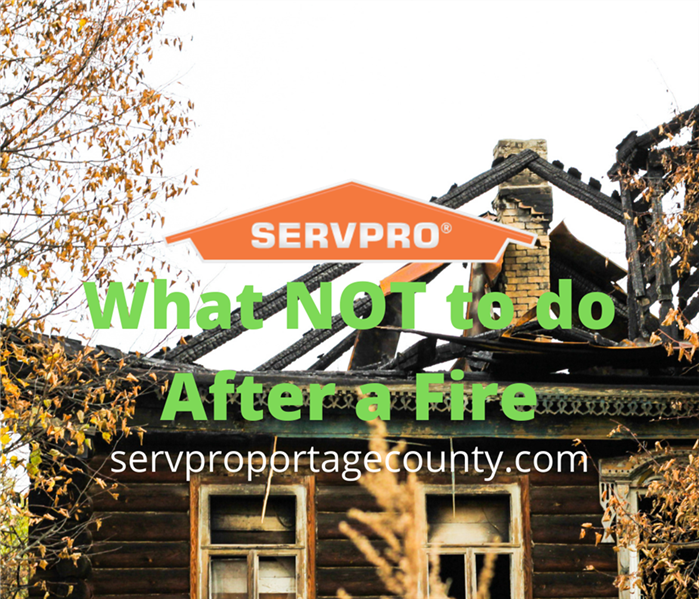 Prevent and protect your home from fire damage with help from SERVPRO.
Prevent and protect your home from fire damage with help from SERVPRO.
Fires are dangerous, even in the aftermath. It’s pertinent that you know what to do, and more importantly, what NOT to do after a fire breaks out in your home or business. There are a few very critical actions you should avoid when dealing with a fire outbreak, remember these four fire don’ts:
DO NOT enter the building until you are given professional advisory that it is safe to do so.
DO NOT turn on any gas, water, or electric utilities until a professional has assessed the severity of the situation.
DO NOT start or move any vehicle that has been impacted or affected by the fire.
DO NOT attempt to clean any soot, smoke, or burn damage yourself. Wait for the professionals with the proper experience to arrive at the scene. It’s important to not risk anything or leave any factors up to chance without the proper education.
One of the most important things you CAN DO after fire damage is to call your local SERVPRO. We are your trusted fire damage restoration company and will take care of any mitigation, restoration, and clean-up services you could possibly need after a fire strikes. We guarantee it will be no sweat off your back.
Managing Humidity in Portage County
5/4/2021 (Permalink)
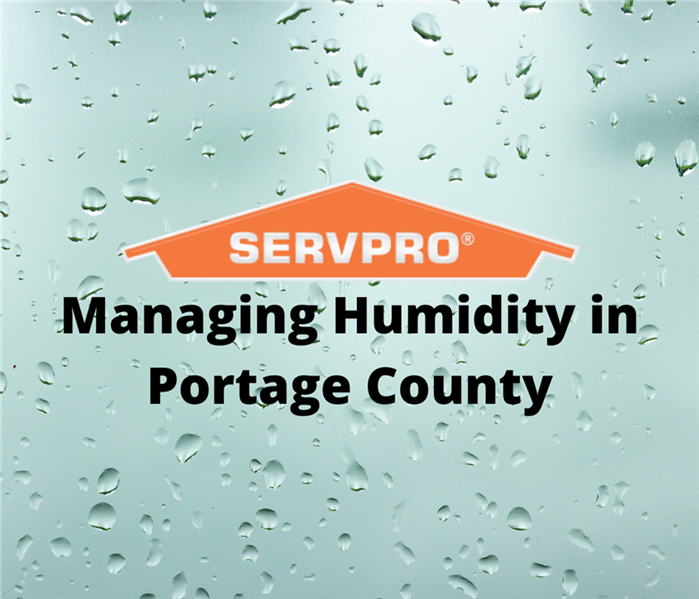 Make sure your home is prevented from humidity-caused water damage.
Make sure your home is prevented from humidity-caused water damage.
Humidity is the concentration of water vapor that is present in the air, and the level of water the air can hold. We all know those “humid” summer days that just feel hot and sticky. While this is most definitely uncomfortable, what is worse is when humidity enters your home or business. While small amounts of humidity may not be anything to worry about, it is a different story when your basement remains humid. The good news is that warm damp basements can be managed and even avoided.
- One very simple and common step to take in order to avoid humidity in your home is placing a humidifier in the most concentrated area. The silica gel beads that are used will help to absorb the water vapor in the air, and therefore prevent mold and mildew build-up.
- Another simple, and even free option is to clean! If cleaning is already on your “To-Do list”, then this should not be too much of a hassle. When you keep the area clean and clear, there are fewer spots for mold and mildew to grow. Plus, there is the added benefit of enjoying a clean and clutter-free environment!
- As you do your cleaning and usual chores, take a little walk around the perimeter of the basement. If you notice any gaps or holes, you can seal those up for an extra barrier against moisture.
- Don’t just stick to the basement! Check your roof, gutter, and other drainage areas, if these spots are backed up, they may cause more issues for down below!
By taking just a few simple measures, you can avoid having a build-up of mold, mildew, and other bacteria in your home or business. Like most building repairs and tweaks, this may seem like a minor issue that could actually lead to a lot of trouble later on. If your basement is past the point of managing, and you need a good cleaning, you may consider a professional cleaning service to rid the area of any bacteria. For help getting your basement clean and clear, give us a call and ask about our unique 3 C’s when it comes to cleaning!
SERVPRO of Portage County Preserves Your Property
4/5/2021 (Permalink)
 Ensure the protection of your property with your trusted SERVPRO for when disaster strikes.
Ensure the protection of your property with your trusted SERVPRO for when disaster strikes.
When disaster strikes it can be devastating to your family or your business.
Floods, fires, and storms can destroy property – whether a home or an office or a factory – and everything inside, whether photos of the family or state-of-the-art machinery
The loss of property can have huge implications. For families, it can mean losing your home and having to start again. And while a house can be rebuilt and appliances can be replaced, it can be impossible to replace items of sentimental value.
And for a business a catastrophic disaster can result at the end of a company – many firms never reopen after a large fire, even with insurance in place as customers cannot wait for firms to rebuild and reopen, and staff cannot afford to wait without pay for things to return to normal.
This is where SERVPRO helps – our expertise in damage control is second to none. We can help prepare your business proactively to minimize the danger of catastrophic loss in the first place, and should the worst happen, we are on hand to take control and get you up and running again as fast as possible by drawing on our wide range of highly skilled and qualified people in all the trades and services needed.
Common Causes of Workplace Disasters
4/5/2021 (Permalink)
When a disaster occurs in the workplace, mere seconds can be the difference between some extra paperwork and life-threatening situations. The main point of a workplace disaster or emergency is that you will never know when one is set to occur. This means understanding the types of disasters and what can potentially cause them is crucial.
Common Types of Emergencies
- Fires and Explosions - Fires can be caused by natural events as well as preventable accidents. Be sure to have clear safety guidelines when dealing with any potential fire hazards and enforce rules and regulations.
- Medical Emergencies - A medical emergency is unpredictable and usually hard to prevent, but you can prepare. Make sure you have relevant medical information on all staff along with individual emergency contact information.
- Severe Weather - Natural emergencies are the hardest to plan for and predict due to their very nature. A natural emergency could occur as a result of flooding, severe weather such as hurricanes or tornadoes, or forest fires. Be vigilant in watching the weather reports and listening to any and all warnings and advisories.
- Power Outages - Call your utility and report the power outage, or call 911 in case of immediate danger. Turn off and disconnect your small business’s equipment to prevent damage.
- Hazardous Material Spills - If you work with hazardous materials, it is imperative to provide your staff with proper training. Ensure everyone is aware of the potential dangers and knows how to properly handle these materials.
Knowing the common causes of workplace disasters can hopefully help to prevent any from occurring, but as there are some completely out of your control it is crucial to prepare for these worst-case scenarios to:
- Keep employees and responders free from harm
- Manage life-threatening situations
- Minimize damage to the environment, equipment, machinery, tools, etc.
- Minimize downtime
SERVPRO is faster to any disaster because we know the importance of the first few minutes following an emergency and how important it is to the outcome of such events. SERVPRO also has over 50 years of experience in biohazard cleanup and restoration after water or fire damages. Add them into your emergency response plan to make sure you minimize damages to your business if a disaster is to occur.
How to Prepare Yourself for Ohio's Storm Season
4/5/2021 (Permalink)
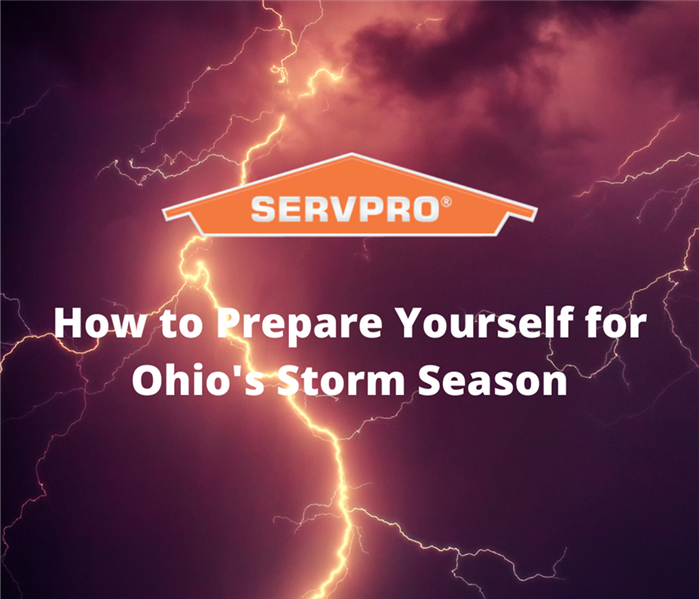 Storm season affects all of Ohio, make sure your NE Ohio home/business stays protected.
Storm season affects all of Ohio, make sure your NE Ohio home/business stays protected.
Storm season is upon us in Northeast Ohio. In fact, March 21-27, 2021, is Spring Severe Weather Awareness Week.
It’s a reminder that tornado season is near, running from April to June. Now is the time to prepare.
How can you prepare for this year’s Ohio storm season?
We have you covered.
Secure light-weight items
When the weather warms up, we like to beautify our patios and decks with outdoor furniture. But strong winds can scatter your decor across your yard and even down the street. If winds are strong enough, your furniture can become dangerous projectiles.
Here’s an easy fix. Anchor furniture with bungee cords, ropes, ratchet straps, or chains. Cover your furniture with weather-resistant furniture covers. Use sandbags to weigh these items down.
Cover windows and glass doors
Storm shutters and storm doors prevent objects from cracking or shattering your glass doors and windows. If you don’t have storm shutters, you can find security window film at most hardware stores. The film prevents shattering.
And, of course, you can hang plywood sheets.
Inspect your roof
Roofs take a beating throughout the Ohio seasons. Rain, snow, ice, heat, humidity, high winds, and hail. We recommend getting your roof inspected regularly, especially before severe storm season begins in April.
Trim dead limbs
Severe storms often cause dead and weak branches to fall.
Make it part of your normal lawn maintenance to check your trees and large shrubs for low-hanging and dead limbs, especially those near your home and vehicles.
Protect your most precious asset
At SERVPRO we’re confident our services can restore your property. But we can’t restore you.
Do the necessary research, and create a severe weather and tornado plan for your family. Here are three steps to get you started:
- Stay informed
- Designate a safe shelter
- Prepare for long-term sheltering
You can find more information about tornado safety at Weather.gov and Ready.gov.
Be safe and be well!
Backyard Bonfires & Fire Safety
4/5/2021 (Permalink)
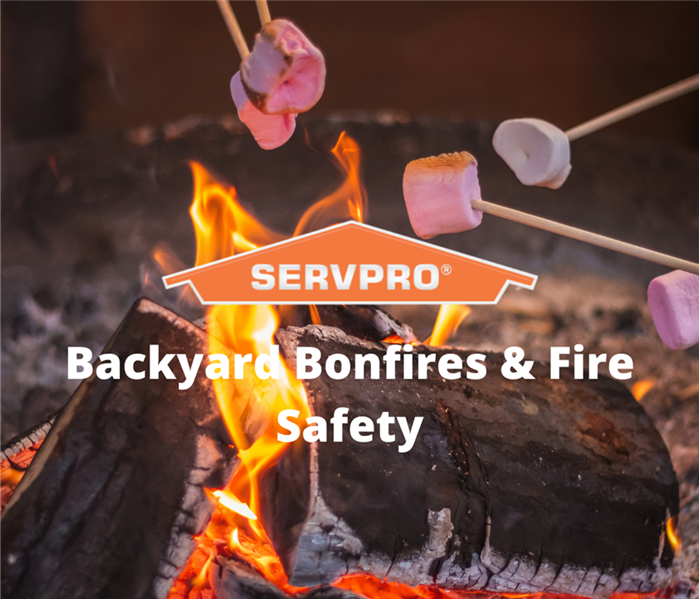 Ensure your backyard bonfire is as safe and fun as possible.
Ensure your backyard bonfire is as safe and fun as possible.
You have the perfect s’more in your hand, toasted golden brown marshmallow on 2 perfect squares of graham cracker, and chocolate on top and bottom. You can hear your uncle’s voice, telling his favorite ghost story for the umpteenth time. Raw throat from the top of your lungs rendition of Kumbaya. Life doesn’t get much better than sitting around a bonfire with your friends and family on a cool fall evening. However, if you do not follow safety precautions the best night ever could become the worst with no warning.
Before the Fire
- Only build fire in enclosed, contained areas.
- Clear the area around the pit of dry paper, grass, leaves, or pine needles
- Make sure the pit is on a flat surface in an open area, away from any trees and the home
- Move furniture away from the fire pit
- Keep flammable materials away from the fire pit
- Check wind direction and be prepared to make any adjustments
During the Fire
- NEVER leave a fire unattended
- NEVER use garden waste or trash in a fire
- NEVER leave children unattended
- Keep your distance, sparks can fly unexpectedly
- ALWAYS keep a fire extinguisher or hose nearby
When the night is coming to a close, you must put the fire out completely before leaving the area. To do this you will want to douse the fire with water. Once the flames are extinguished use more water and stir with a stick or shovel to confirm all ashes, wood, and sparks have been successfully put out. Be sure to store any flammable items safely and away from children.
A backyard bonfire is one of the best ways to enjoy a warm or even cool night with friends and family. If you follow these safety tips, your only worry will be running out of marshmallows. Remember fire is dangerous, but handled with care and safety enjoying a night by the fire should remain a timeless tradition.
Does Stop, Drop, and Roll Really Work?
4/5/2021 (Permalink)
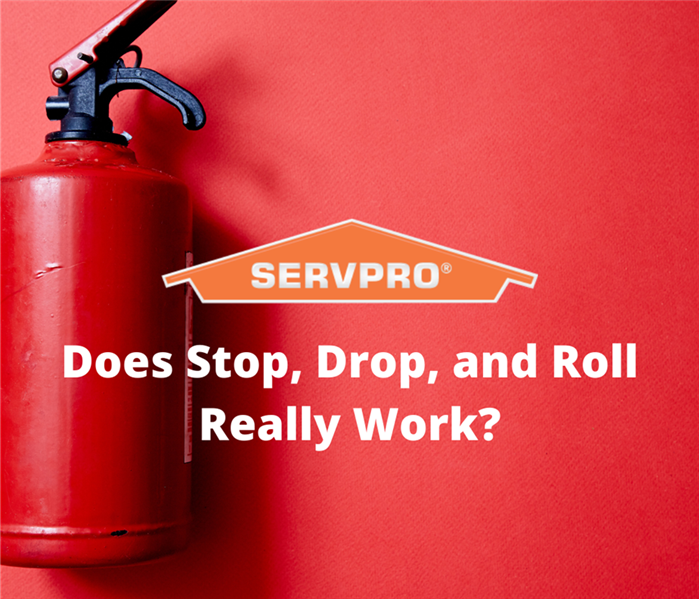 Practice the safest way to extinguish a fire on your body. Stop, Drop, and Roll.
Practice the safest way to extinguish a fire on your body. Stop, Drop, and Roll.
There are a few days in elementary school that stick with you for the rest of your life. Field Trips, special assemblies, fun science experiments, and the day the firefighter comes in to teach stop, drop, and roll. At the time it felt like a game, everyone was laughing and having a good time being allowed and even encouraged to roll around on the floor, not really understanding what the importance of the exercise could actually be in a life-threatening situation. It may have felt silly back then and even more so as an adult, but the imperative question is – Does it work?
Stop, drop, and roll does work. It is the best technique to put out a fire on the human body, or more precisely, to put out a fire that is on clothing that is being worn on the human body. The technique is extremely simple and easily remembered which is important because it is necessary during a time where every piece of knowledge you have acquired will be nowhere to be found. Having your clothes on fire is a situation likely to involve quite a bit of panic and it would not be a good time to try and recall an 18 step process you learned decades ago.
As the name suggests this technique involves three fairly simple steps:
- Stop - the person who is on fire should stop immediately when they recognize that they are on fire. While it might seem a little trivial, continued motion can act to fan the flames and add more oxygen to the fire. This can make it burn faster and stronger and you don’t want that.
- Drop - this means the person who is on fire needs to drop to the ground, ideally into a full lying position, and at the same time they should cover their face with their hands (this will stop them from getting hurt as they carry out the last part of the process and may stop their face from getting burned too).
- Roll - then the goal is to roll over and over again (back and forth) until the fire is completely extinguished.
It may be hard to fathom that such a basic tool really can save your life, but science proves backs it up. In order for fire to burn – it needs oxygen. When you roll around on the floor over and over, you are removing the oxygen source from the flames and thus extinguishing them.
Hopefully, if you ever need to use this technique your clothes are the only thing on fire. If the unfortunate occurs and there are damages to your home and property from fire, calling SERVPRO — 1(800)SERVPRO — is the simple technique to do next, once everyone is safe from danger. With over 50 years of experience in fire damage restoration, they will take care of the rest.
Checklist of Questions When Hiring a Professional
3/11/2021 (Permalink)
 SERVPRO has all the right answers the first time, so you don't have to keep asking.
SERVPRO has all the right answers the first time, so you don't have to keep asking.
When starting a project in your home that requires a professional finding the right one may seem like an impossible task. Whether you found mold in the basement or are in need of repairs after a huge storm, there are a countless number of companies out there that say they can help. How do you know you are making the right choice in who you hire?
There are a number of questions that should be asked before making a decision.
- How long have you been working in the industry?
- Answer you want: Long enough to have at least 20 references that can be contacted.
- Answer you want: Yes, while no technician will intentionally cause more damage to your home, things happen and it is important to make sure you are covered.
- Do you have a list of references that I can contact?
- Answer you want: Yes, “Past performance is a great indicator of what future performance will be.” Hearing from a past customer could give you insight either to hire or stay away from the company in question.
- What is the projected timeline for the project?
- Answer you want: A specified length of time, not knowing this answer could mean the project will go on much longer than it should.
- Are your technicians certified?
- Answer you want: Yes, you want to make sure those knowledgeable and certified in any work they are doing,
At SERVPRO of Portage County, our answers to these questions are completely in line with what they should be. All of our technicians are IICRC certified and all training is up to date. We have over 35 years of experience in home restoration with multitudes of satisfied customers. We are available 24/7/365 to ensure whatever you need, whenever you need it will be taken care of by professionals that care. Call SERVPRO of Portage County today and let us show you why we are the right choice for you and your family.
Top 5 Safety Investments for Your Office
2/26/2021 (Permalink)
If you’re a business owner, store manager, or office manager safety of your place of business and your staff has probably been on your mind quite a bit over the past year. It can be hard to know what to prioritize with safety as recommendations seem to change and evolve all the time. However, there are some evergreen measure you can take to ensure the safety of your workplace. Here are our top 5 recommendations:
- Invest in a high quality air filtration system.
Good air quality is paramount in keep your place of business germ and illness free. If you own your building, make sure to regularly maintain your HVAC and change your furnace filters often. We recommend using top quality allergen rated filters. If you do not own your building or have access to your HVAC system, invest in an air filtration system like a Dyson or Molecule. Make sure to purchase the system that covers your total square footage and follow the maintenance instructions to the letter.
- Prioritize scheduled cleaning and sanitizing.
Some businesses have the luxury of hiring a cleaning crew to clean common areas at regular intervals. Make sure your bathrooms, break rooms, and common areas are thoroughly cleaned and sanitized at least one per week. Encourage your staff to adopt cleaning and sanitizing practices of their own personal spaces and work stations. Incentivizing clean work spaces by offering rewards can help boost motivations to keep your offices tidy.
- Regularly police trip hazards and walkways.
One of the most common workplace injuries is falling, and coincidentally is also the easiest injury or accident to prevent. Make sure you and your staff are clearing walkways and reporting and clearly marking trip hazards identified in the workplace. One suggestion is to appoint a manager or leader to be a designated monitor of these types of hazards and create a system for reporting and then mitigating the hazard.
- Conduct a safety inspection at a regular interval.
Sometimes an outside perspective can be necessary to identify safety risks in the workplace. Many businesses conduct a quarterly or annual assessment of workplace hazards or safety risks with an outside inspector or advisor. This can also boost confidence amongst employees when they see how serious an employer takes workplace safety.
- Create written policies and review safety procedures as a group.
Every business should have clear safety protocols in the event of any disaster. All employees should be aware of these protocols and regular trainings and reminder drills can help keep safety top of mind for everyone on your staff.
Safety is an important factor in workplace satisfaction but is often not prioritized as much as it should. Investing in these simple safety strategies will not only create a safer workplace but will ultimately boost the confidence and morale of your staff as well. SERVPRO is here to help business owners implement safety protocols and mitigate safety hazards in the workplace. Contact us to learn more about our commercial cleaning services and strategies to help keep your place of business safe.
Protecting Your Pets During Stormy Weather
2/26/2021 (Permalink)
STORMY weather can be unsettling enough for humans, but it can be terrifying for our four-legged friends.
Cats and dogs have much more acute hearing than humans and are highly sensitive to changes around them which causes them to seek shelter and security by hiding.
Loud thunderclaps, lightning flashes and atmospheric pressure changes all combine to cause great stress to our pets which can show itself in nervous behavior.
The best way to help your furry family member get through a heavy storm is preparation – some training can be done to reduce fear and anxiety. The best way to start this is always reward calm behavior, with petting and praise. This way your dog will be more receptive to your reinforcement of good behavior during a storm. Just like in us, training cannot eliminate fear but it can help us handle stressful situations in a better manner.
And during the storm, there are many ways to give your pet the security it needs until the weather passes.
Just like humans, our animals will look for a safe space by instinct, so create a warm, inviting, and comfortable one for them. If they have one already that they choose to relax or sleep in, make this their safe space. If you need to head to the basement for storm protection, take their favorite blankets, or bed or crate with you downstairs. Putting on background noise like a fan can also help as it can help obscure the storm sounds with a familiar one.
Have a treat or a new toy on hand to distract them during the storm and reward your pet for good behavior. If storms are a regular occurrence in your area, you can help train your pet to see a storm as linked to getting a treat.
If you have plenty of warning of the storm’s approach, take the opportunity to give them extra walks and exercise beforehand. This can help distract them from early warning signs in nature of the impending storm, give them quality time with you to calm them, and help tire them to reduce over-the-top behavior during the storm.
Weighted blankets have been shown anecdotally to help reduce stress and anxiety in pets – and humans – but this is one area to know your own pet. If they have a favorite shirt or blanket, make sure they have it to hand, or paw.
And stay calm yourself – your pet will be looking to you for protection and will feed off your emotions. Reassure your dog or cat with appropriate stroking and petting, showing you are calm. Do not punish your pet for bad behavior if it is frightened during a storm – it is a natural reaction, and a negative response may compound the problem in future storms as they link storms to punishment.
Determining the Severity of an Incoming Storm
2/5/2021 (Permalink)
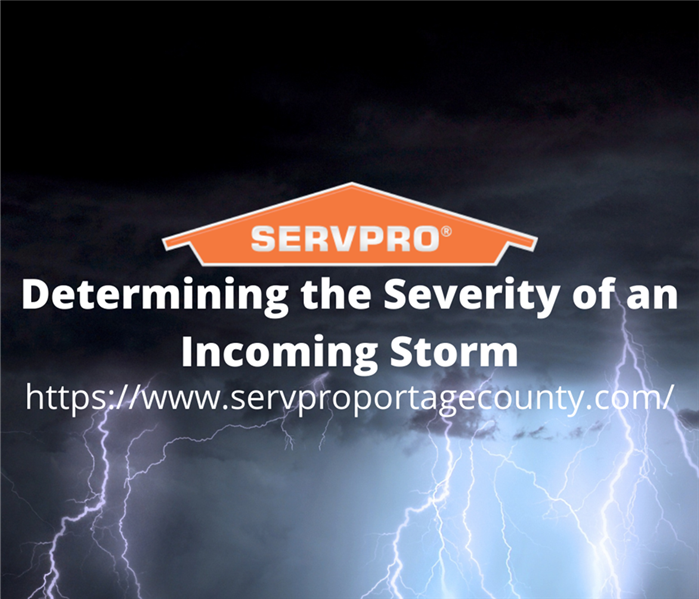 Know the signs of a serious storm so you can be prepared.
Know the signs of a serious storm so you can be prepared.
Almost everyone has been told sometime about the “counting rule” when it comes to thunderstorms. You’re told to count one-Mississippi, two-Mississippi, etc, from the moment you see lightning until the moment you hear thunder to determine how close the lightning is to you. Does this actually work? What do the seconds actually mean? This is the most common method of judging a storm and it does actually work. Lightning travels a speed 5 times faster than thunder, so you will always see the lightning first. The number of seconds between the two tells you the distance away the lightning actually is. When you see the lightning you start counting and stop when you hear thunder, whatever the number of seconds is between them tells you how far away the storm is. Divide the number of seconds by 5 and that will tell you how many miles away you are from the lightning. Five seconds between is one mile, fifteen seconds is three miles, and zero seconds means lightning is extremely close and you should be in a safe space. Using this method to determine the distance is common knowledge, but how can you determine the severity of the storm and if there is potential danger coming your way?
- Watch the Clouds Closely - Not all dark clouds are the same and can be used to help determine what is headed your way. If there is a storm coming that has dangerous even deadly potential the clouds will be extremely dark sometimes with a green tint as well. They will be big, low, and close to the ground cumulonimbus clouds and you will notice them rapidly develop vertically. Be sure to watch for any rotation in the clouds as well.
- Pay Attention to the Temperature - Severe storms and tornadoes form when low level, warm and moist air collides with dry cold air above. If you are outside and feel the temperature drop from warm or hot down to brisk in a short span of time you will know there is a severe storm quickly approaching.
- Beware of Sudden Wind and Precipitation Changes - The calm before the storm is not just an expression. If there are an abrupt calm following hail and heavy rain, this doesn’t mean the storm is over it can mean there is potentially dangerous weather coming very soon. A fast and intense wind shift is also a tell.
- Watch vs. Warning - There is often confusion on which of these means what. A watch simply means that tornadoes are possible in and near the watch area. A warning, on the other hand, means that a tornado has been spotted or indicated on the radar. Be sure to seek shelter when a warning is issued in your area.
Being aware of these warning signs can help you determine if the storm approaching is one that allows you to dance in the rain and jump in puddles or one that means you need to take precautions or head on down to the basement. These signs are not full proof as the weather is still vastly unpredictable and can change on a dime. Be sure to take necessary precautions when advised, better safe than sorry is a good rule of thumb when storms are on the way.
Carpet Cleaning in Your Office Is a Must
2/4/2021 (Permalink)
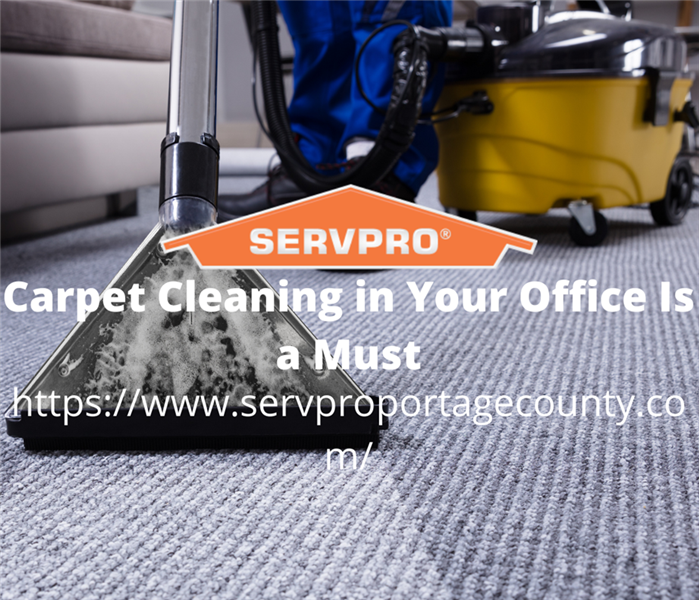 Trust SERVPRO to get your commercial carpet cleaning done right.
Trust SERVPRO to get your commercial carpet cleaning done right.
The carpets in our offices are widely used and sadly, often sparsely cleaned. Having fresh, clean carpets in the workplace offers a wide range of benefits for you and your employees, both in terms of health and functionality. Here are just a few of the many reasons you should opt for professional carpet cleaning in your business:
Allergens and Bacteria
Carpets can lay host to numerous germs and allergens that can cause potential harm to your employees. It is possible that these microorganisms can travel home in/on the shoes of your workers and invade their home life. Maintaining a regular carpet cleaning regimen for your business can work wonders in preventing the spread of these harmful substances.
Mold Prevention
A lack of proper carpet care can leave your floors at risk for serious mold damage. Mold can impact air quality and permanently damage your carpets if not treated properly. Protect your business from the harmful effects of mold damage with annual carpet cleaning treatments.
A Fresher Smell
Is there a lingering odor in your office that you just can’t seem to track down? Chances are it’s probably your carpet. Think about all of the substance we step in and thus track into the carpets with our shoes, because honestly, who is taking their shoes off before they walk into work? Getting all that funk and dirt out from your carpet with a thorough treatment will have the aura of the workplace radiating. We’re more productive when we can smell clearly!
Get Those Nasty Stains Out
Whether it’s spilled coffee, water damage, or mud tracked in from the rain; there is bound to be some staining on those office floors. This can look extremely unprofessional to customers, clients, and executive managers that visit your workplace. Carpet cleaning is a small price to pay to reflect a good image of your business.
Make sure those carpets stay clean, Certified SERVPRO Clean!
Mold Growth from Water Damage: Dangerous Types to Look For
1/4/2021 (Permalink)
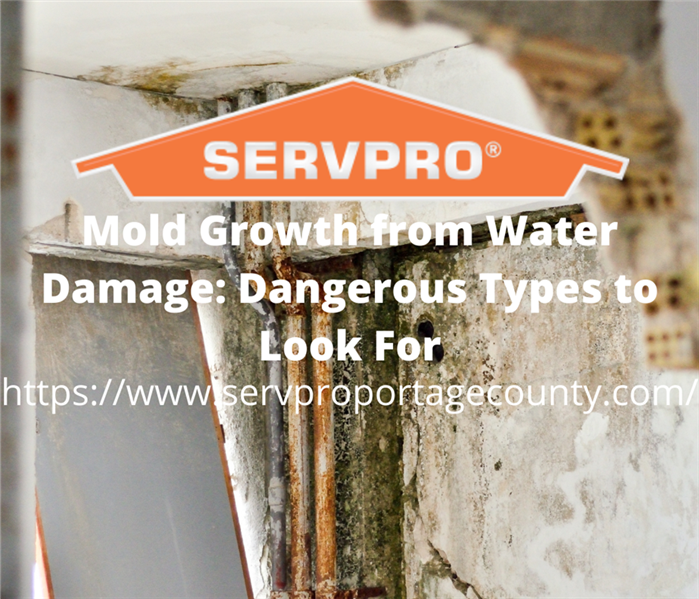 Prevent water damage in your Portage County home and business.
Prevent water damage in your Portage County home and business.
Discovering you have mold in your home can be scary, but it is important to know what exactly you are dealing with. Mold is a term for many types of fungi that are unwanted, unappealing patches of black, brown, yellow, pink, green, smelly, or fuzzy growths. There are countless varieties found both indoors and outdoors and almost always hold a negative connotation, but without mold, we wouldn’t have penicillin or bleu cheese! When it comes to your home, the negative connotation holds true and should be taken care of by a professional if found. Active mold needs water to grow and thrive, so having water damage in the home is a perfect breeding ground.
Harmful molds can be any of the following classifications:
Common Molds Found at Home:
- Acremonium - Toxigenic mold type that evolves in appearance over time. It starts out a small moist mold and turns into a fine powdery substance. Typically grows in areas near humidifiers, cooling coils, and drain pans.
- Alternaria - The most common form of allergenic mold in the world. It’s a velvet-textured mold with dark green or brown hairs. It typically grows wherever dampness occurs.
- Chaetomium - Toxigenic mold commonly found in water-damaged homes, most commonly in a damp or leaking roof, basement, or sink. It has a cotton-like texture and usually changes colors from white to grey to brown, and eventually black.
- Penicillin - Allergenic mold that is easily recognizable with blue or green color and velvety texture. Often found in water-damaged homes and buildings. It is found in materials such as carpets, wallpapers, ducting, and even mattresses.
- Stachybotrys - Toxigenic mold also known as “black mold”, also can cause health effects. It is dark green or black with a slimy texture. Stachybotrys thrive in damp, wet areas with high humidity levels that maintain these environmental conditions for weeks.
These are just a few of the most common mold types, but there are many more that can be found and can be harmful to you and your family. Since mold thrives in damp environments, a home with water damage becomes the perfect breeding ground. Mold can be dangerous and should be handled by professionals. If you have mold or suspect you might; call SERVPRO so you can rest easy knowing the problem will be handled quickly and safely.
SERVPRO of Portage County is a Locally Owned Franchise
1/4/2021 (Permalink)
 Trust SERVPRO as your locally owned and operated restoration service franchise.
Trust SERVPRO as your locally owned and operated restoration service franchise.
When disaster strikes, life can get stressful; and fast! If your home or business is in need of repairs and cleanup, the last thing you want to worry about is not being able to trust a company that you have hired to help you fix the mess. As you begin your search for the restoration company to assist in the cleanup, you will run across large corporations, small businesses, and even locally-owned franchises. So, what is the best route to take?
Many times, large businesses will get more notoriety because of the reputation they have already built, or simply because the overhead for marketing is much larger than that of a small business. While there are benefits to working with a large company such as resources and operating guidelines, there are also downsides. When it comes to bigger organizations, the management tends to become a bit detached. There is less cause or motivation for employees and managers to have the passion and care for what they are doing. In consideration of this, you may opt for a small locally owned business.
Support for local business is common and even promoted. It is important for many to build up the local economy and show support. Many people prefer to give their business to the neighbor next door, or their brother-in-law’s high school friend. While this is admirable, there can also be some hiccups with going this route. For example, they may not have the rules and regulations that a larger business does, simply because they do not have to. So, when it comes to dealing with restoration stresses, it might be the best time to look into a locally owned franchise.
When you choose to bring in a local company that is also a franchise, you almost get the best of both worlds. First, you have the guarantee from the big corporations of the work that will be done, but you also have the benefit of giving business to that neighbor or family friend, and investing in your local economy! If you find yourself in need of restoration services, and you would like to use a locally owned franchise like SERVPRO, give us a call, we are faster to any disaster!
How can SERVPRO Help After A Storm in Northeast Ohio
12/2/2020 (Permalink)
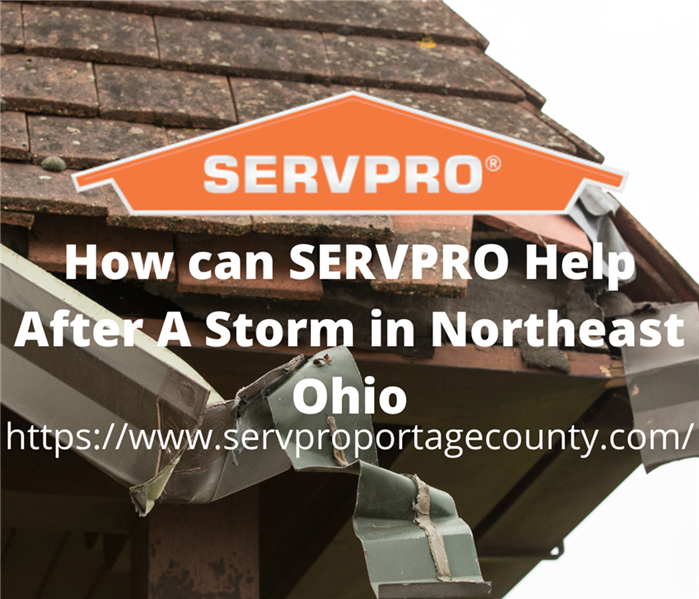 Count on SERVPRO of Portage County for your storm damage needs.
Count on SERVPRO of Portage County for your storm damage needs.
Northeast Ohio can have very unpredictable weather. One day it will be bright and sunny and the next could be blizzard conditions. A storm can come out of nowhere and could cause damage to your property. SERVPRO offers a variety of services to help you after a storm.
Flooding
SERVPRO has water damage restoration technicians to help you recover from any damage a heavy rain has caused to your home. In addition, we have applied structural drying technicians to help you dry out any areas of your home that may have been heavily flooded.
Roof Damage
Both rainstorms and snowstorms can cause damage to your roof. In the winters, a large amount of snow can accumulate on your roof, which can cause small cracks to form. The repetition of this can cause the cracks to grow larger. SERVPRO has a team consisting of a multitude of specialists to help with your roof damage.
Frozen Pipes
Ohio is known for getting cold in the winter, which can result in pipes freezing. A frozen pipe can lead to water damage. SERVPRO is able to fix the water damage quickly and safely.
Ice Dams
Northeast Ohio’s heavy snows and ice can result in ice building up in the eaves of your roof. The buildup can leak into your home, which will cause water damage. It can also break off your gutters. SERVPRO’s winter storm restoration specialist can help you resolve your issue quickly.
SERVPRO offers 24/7 emergency service to help compensate for NorthEast Ohio’s unpredictable weather. Storms can be a scary experience, as they have the ability to cause damage to homes, but our technicians are able to help you if you are in need. We are faster in any disaster!
Homeowner Tips for Living in a Floodplain
12/2/2020 (Permalink)
 Make sure you are prepared for floodplain living in all seasons.
Make sure you are prepared for floodplain living in all seasons.
Flooding is becoming more frequent and severe due to climate change. Heavy downpours, rising sea levels, and asphalt everywhere are all factors in increased flooding in recent years. If you live in a floodplain you are even more at risk. Flood plains are areas the National Flood Insurance Program considers at high risk for flooding, otherwise known as Special Flood Hazard Areas. The NFIP defines these as areas with a 1 percent annual chance of flooding, which is equivalent to a 26 percent chance over the life of a 30-year mortgage.
When living in a floodplain it is required that you hold flood insurance, this is a good thing to have if a flood does occur, the cost of damages can be substantial. Flood damage can range from somewhat manageable, like a couple of inches in the basement, to full-blown home destruction. There are precautions you can take as a homeowner to minimize flood damages.
- Elevate the living areas to above “base flood elevation.” You can find your specific level from FEMA.
- Build or retrofit your house with flood-resistant materials.
- Elevate your furnace, water heater, air conditioner, and electrical panel above the flood level.
- Turn off the electricity if your home is about to flood
- Change your landscaping - Add porous surfaces, dig trenches, and use absorbent mulch.
Learning how to prevent major flood damage can go a long way in easing the stress of living in a flood plain. Some tasks require the help of a professional. SERVPRO is here to help you with any storm prevention techniques, give them a call today!
Storing Flammable Products & Accessories in the Home
12/2/2020 (Permalink)
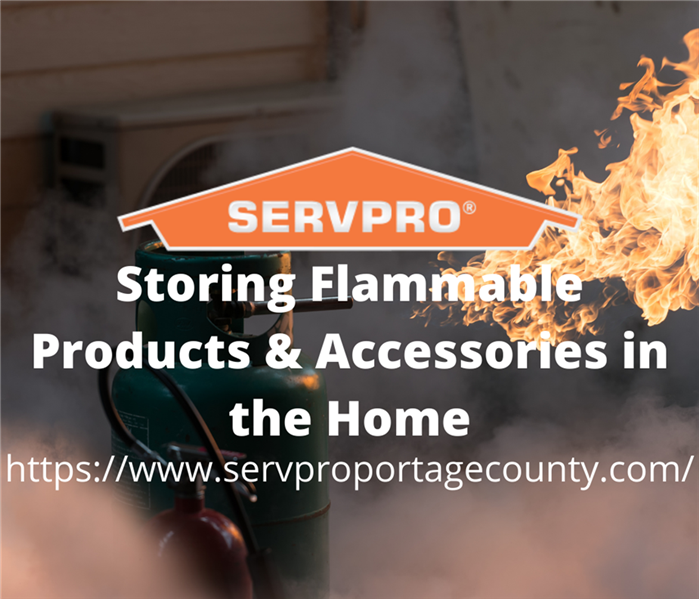 Keep your home safe from fire and properly store your flammable products.
Keep your home safe from fire and properly store your flammable products.
Everyone has flammable products within their homes, but do you think of how to store them after use? It is just as important to be safe with storing these products as it is to monitor them when they are in use. They can have dangerous and devastating consequences if improperly stored like fires, poisoning, or even explosions. Here are some tips on how to store your flammable products to avoid these problems that can happen.
Room Temperature
The temperature of the room you store flammable products is very important because it can be a fatal mistake if the room is too hot. If the room is constantly exposed to high heat whether it's from direct sunlight, high temperatures due to the climate, or even a room that is being purposely heated to higher temperatures it can cause all the devastating factors like fire, explosions, etc. that can be fatal. If you don’t think any areas in your home or workspace would meet the requirement for a safe room temperature for these items then there are alternatives you can use. It is possible to build a safe flammable storage cabinet to keep these products in.
The Proper Container
Not storing your items in a flammable cabinet or container can lead to problems. So it is very important to keep your products in the right container. When storing these products it is almost guaranteed to be safe if you store them in an approved container. If it is approved and tested vs a homemade container like a paint can, etc. it is guaranteed to be a lot more protected and has a substantially lower chance of causing any devastation. Storage containers for these products are very important and should be taken seriously.
Location of Storage
When you’re thinking about a location for keeping your flammable items it is vital to keep them away from certain locations. Many people tend to store these items in their garage, basement, etc. but that can be a fatal mistake. Don’t store flammable products by things that can spark. They need to be kept away from flames and sources of ignition like a car. Also, be careful of your flammable products and accessories around your HVAC systems because it can cause a spark with the item and may start a fire or other catastrophic disaster.
Be cautious with your flammable items to avoid a major problem that can occur later down the road. We have the experience and knowledge to be able to help you store your items in the safest way possible. Give us a call at 1-800-SERVPRO or visit our website for more information. We’ll take the worry for you.
Creative PPE for your Staff
12/2/2020 (Permalink)
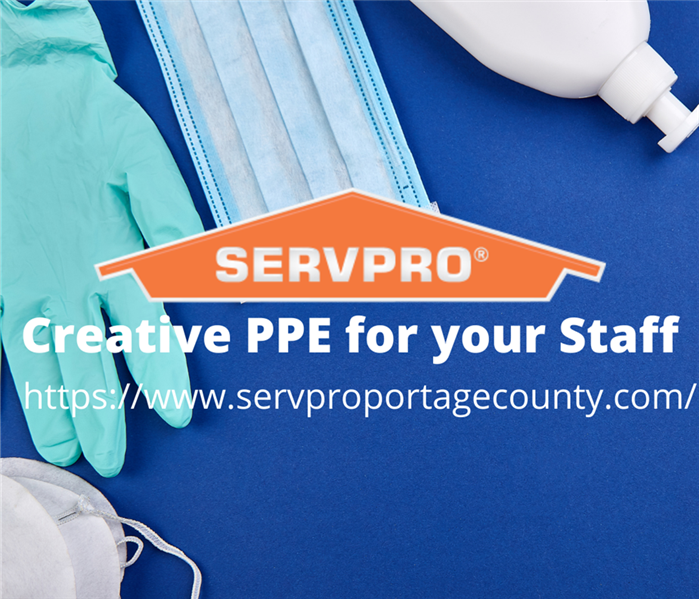 Make sure your employees are protected from any virus or bacteria.
Make sure your employees are protected from any virus or bacteria.
With a high demand for personal protective equipment (PPE) in the workplace, especially in industries that have not always required them, we are beginning to see a new level of creativity blossoming in the workplace. For those who are handy with a needle and thread, making masks is fairly easy, but not everyone is skilled in sewing. There is no need to worry, there are other avenues to take when it comes to PPE!
- Makeshift masks with layered paper towels and rubber bands
- Rubber Kitchen gloves if the store is sold out of latex gloves. Rubber kitchen gloves can even be sanitized and reused
- Well-fitting snorkel masks - an NYC physician suggested using a snorkel mask to help reduce droplet and aerosol exposure, as well as prevent touching your face!
- Make your own face shield from a hat or visor and clear vinyl from your local craft store
These ideas are just a few among many creative ways to protect yourself, your employees, and even your family. If you find that it is hard to keep personal protective equipment stocked, look into some creative avenues, and try to think of options that can be reused and sanitized.
Remember you can count on SERVPRO for any of your commercial business safety needs. We are faster to any disaster!
Avoiding Fires at Your Holiday Dinner
11/1/2020 (Permalink)
 Don't let disaster ruin your holidays. Stay safe with good fire safety tips.
Don't let disaster ruin your holidays. Stay safe with good fire safety tips.
Everyone loves the holidays. Spending time with family and friends is always enjoyable and there is always great food. But what would you do if the unexpected happened at your family holiday gathering? It can be hard to plan for things that you don’t think will happen but you can take certain steps to help lower your risk of trouble at your holiday event.
At holiday gatherings there is always a lot going on and it is hard to stay on top of your responsibilities. You could easily forget about the food in the oven or not hear the timer go off because you are talking to someone. A way to prevent this from happening is to set multiple timers to go off when the food is done so you get lots of reminders that you need to go get the food. This prevents you from forgetting about what you’re cooking and lowers the chances that something might burn or catch fire.
Another way to prevent a fire from happening is to have all of your smoke alarms set up and working. This alerts you when the food has been cooking for too long and if not taken out it could start a fire. It will prevent a fire from being started and keep the event going instead of it ending in a disaster. Being responsible with fire safety is very important when cooking.
Additionally, you can prevent a fire from starting at a family gathering by having multiple people watching the food that is being cooked. Having more than one set of eyes on the food is always helpful. This reduces the chance of forgetting about the food that is being cooked. The more people watching and taking care of the food will ultimately prevent a fire from starting and ruining the family event that is taking place.
There are many different ways you and your family can keep everyone safe from a fire during family gatherings. All it takes is responsibility and the event should be an enjoyable time for everyone. You never want to be a part of a disaster especially with the people you love and care about. In the event of a disaster, be sure to call SERVPRO of Portage County. We can make it look like there was never a fire with their fire restorations. Make sure you are being responsible and if you are in need of assistance call us. SERVPRO is always faster to any disaster.
Avoid Disaster with Good Grill Safety
9/22/2020 (Permalink)
 Don't let an out of control grill fire ruin your cookout or your dinner!
Don't let an out of control grill fire ruin your cookout or your dinner!
What is there NOT to love about getting outside on a beautiful day and firing up the grill! For thousands of years, our ancestors have answered the same call to cook our food on an open fire. Fire has been our greatest companion, but can also be our deadly enemy. Unpredictable and rapid, fire often seems to have a mind of its own. So, let’s be prepared!
The season is right, warm days lingering into cool nights, but there are some things to be aware of before stacking the charcoal or opening the propane valve. Our homes are where we store our memories, where we shelter our families, where we invest our earnings. It is underestimated how frequently small grilling mishaps become major disasters. We have these many things and more to protect. Let us be wise on how to keep them safe while enjoying the sacred rite of cooking out!
It will come as no surprise to read that children account for the majority of accidents involving outdoor cooking and grill fires. Thousands of people are treated for severe burns each year and property losses are extreme. Thankfully, only a few steps are necessary to keep this from happening to us.
Always keep the grill as far from the home as possible, at least 15 feet. Stay attentive of the grill or fire until you are sure it is completely extinguished. Keep a bucket of sand nearby and never use water on a fire involving grease or fat. The correct fire extinguisher is critical and should be close at hand. Keep grills from brush or tall grass, and always make sure to test your propane lines for leaks. Small handheld chimneys are great for getting charcoal grills started safely and quickly.
SERVPRO of Portage County wishes all the residents of our community a great time with family and friends outside by the grill. We hope that you will take these vital precautions and prepare yourself against accidents.
Moisture in the Air Could Lead to Mold
9/20/2020 (Permalink)
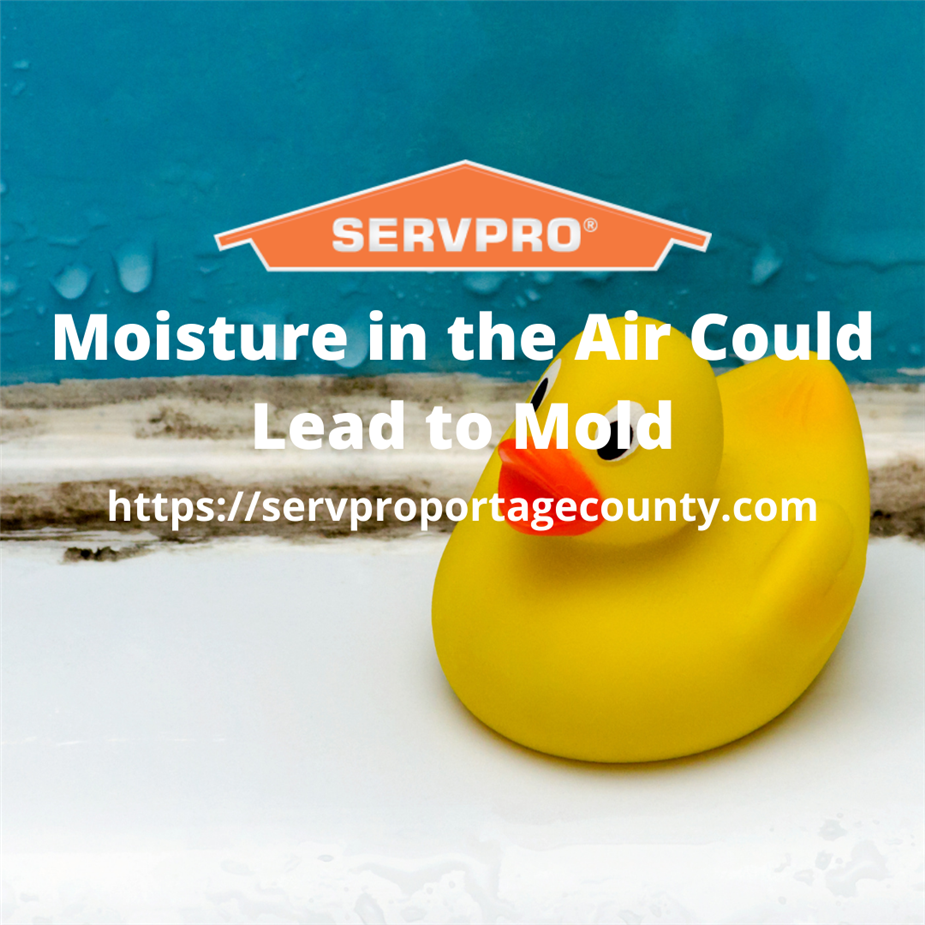 Take care to make sure that too much moisture in the air doesn't cause damage to your home.
Take care to make sure that too much moisture in the air doesn't cause damage to your home.
As if we didn’t already have enough to worry about, Covid has placed an extreme weight on our need to understand how tiny particles in the air can be directly harmful to our health. The air all around us is literally exploding with the seeds of life, most of which would never cause us any more than the hassle of a sneeze. But as the summer months fade, and the rain picks back up, moisture and breaking down plant matter create the perfect environment for mold and fungus spores.
Research has proven that simple steps to decrease the level of moisture in the home, in order to decrease the spread of molds, has tremendous health benefits. Many of us are unaware of the myriad of health effects that allowing molds and fungi to gain a hold in our homes can cause. Young children and the elderly are especially at risk.
As if that weren’t enough, untreated moisture issues in the home can attract cockroaches, rodents, and dust mites. Moisture laden building materials can also, when exposed to moisture, exhale volatile organic compounds that can cause health problems as well.
So, what can we do? It is not possible to eliminate all traces of mold and fungus from the air: there are far too many and are carried even by our pets and ourselves. So it’s critical to treat the moisture issue to keep the spores from settling in and becoming harmful. SERVPRO of Portage County’s highly trained mold removal and remediation specialists are on call to make this added problem a distant memory, so we can get back to living safely and happily at home!
Preparing for Winter in Portage County
9/15/2020 (Permalink)
 Don't let winter sneak up on you. Get your preparations done this fall.
Don't let winter sneak up on you. Get your preparations done this fall.
September has already brought along with it just enough cool weather to remind us of another winter coming. None of us wants to be freezing in knee-deep snow trying to imagine what we forgot to do to keep the heat in and the cold out. And that’s only one element of preparing for winter around the home that we need to remember. A few slightly inconvenient chores now, however, are a far sight better than having to deal with major issues in the midst of the next Northeast Ohio winter.
Probably the most overlooked and yet critical steps in preparing our homes for winter are to run a test on the heating system. Turn the thermostat to the heat position and make sure there is free-flowing air. Check and replace any necessary filters, and that the fuel supply is unobstructed and not leaking. Carbon monoxide readers should be tested for optimal function and all vents should be clear of obstruction.
Another place we sometimes forget that can cause serious energy loss, and that can even pose a real danger, is the chimney and fireplace. Have a professional out to make sure no mortar joints are damaged in the firebrick. Loose or damaged brick and mortar in this area may allow a fire to start in the walls of your home, a disaster we must try to prevent!
Keep in mind also that a great deal of our energy loss, which can represent a major hit to our wallets, are leaky or drafty windows and doors. From winterizing water pipes and reviewing insulation, to inspecting the roof and shutting down the sprinkler system, there’s a great deal to consider. At SERVPRO of Portage County, they specialize in making sure your home is safe and properly prepared for all seasons. They are always available for emergency repairs and clean-up, but specialists are on hand also to come out and review and assist in any preparations that help avoid disaster! Stay warm and dry this winter.
SERVPRO of Portage County is Your Restoration Specialist and General Contractor
9/15/2020 (Permalink)
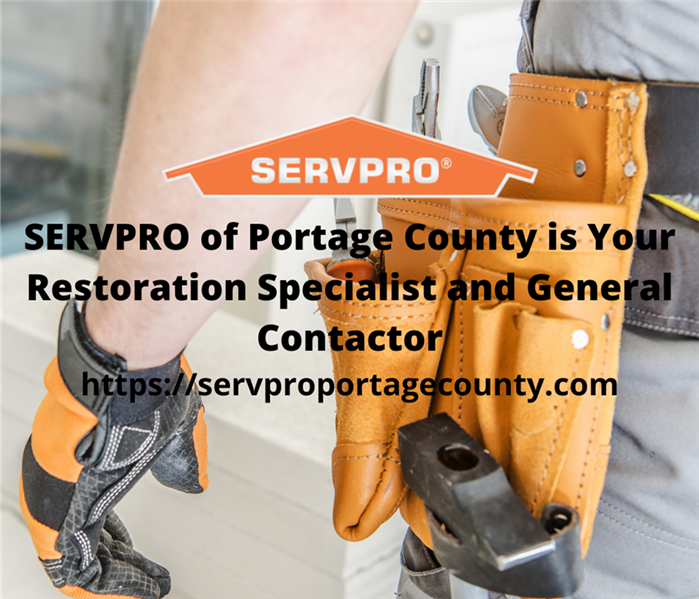 Trust a team that can restore and rebuild all together for you!
Trust a team that can restore and rebuild all together for you!
When unforeseen disasters wreck our homes and disturb our way of life, the stress and anxiety we experience is through the roof! What do I do now? Who should I call? These and many other questions are racing through our thoughts, and it can be a real hassle. What if instead of having to call multiple companies, talk to various specialists for one job and the other, we could make one phone call and have everything taken care of? Never having to experience accidental damage or disasters at home would be ideal, but things happen outside our control all the time. That’s why we are always better off prepared.
One of the biggest obstacles to project completion is poor communication. One of the easiest solutions to communication problems is to have everyone on the same team! Lots of companies offer services to contract jobs, restore and repair, but at SERVPRO of Portage County we employ contractors, disaster preparedness specialists, and restoration crews all under the same roof. What this allows is for customers to reach out in a stressful time to one of our team members, so they can relax a little while the job gets done!
Do You Need Flood Insurance?
9/15/2020 (Permalink)
 If you're in a high-risk flood area, you might be in danger of big losses if you don't have flood insurance.
If you're in a high-risk flood area, you might be in danger of big losses if you don't have flood insurance.
Did you know that homeowners and renters insurance policies typically do not cover flood damage? Many of us may now be wondering if it is a good idea to be insured for flooding as well. Well, according to Ohio.gov, 98% of US counties have been impacted by flooding events. Once water damage has set in, it can easily set off a domino effect of expensive and hazardous problems. There are many things that can be done to reduce the risk of having your home damaged by flooding. For example, make sure your sump pump is working correctly, store critical documents in a safe, dry location, and always have a plan in place for the swift evacuation of family members and pets. You can also check the FEMA (federal emergency management agency) to see if your address is in a flood zone, which will show your home’s risk level for flooding, and any nearby waterways that may present a threat.
In 2010, federal officials expanded flood plain maps, making it necessary for many more Ohio residents to have flood insurance than ever before. This has caused concern about additional bills, but the cost of repairing damage from flooding is extensive, and liability flood insurance for low-risk homes can be as low as $135 a year. While any additional cost is a burden on working-class families, it is always a good idea to defend ourselves against the larger cost of sudden disasters.
Flooding is the most expensive natural hazard in the nation. Because Ohio rests in the middle of the row on the occurrence of natural disasters, however, there is a low likelihood of experiencing heavy damage to your home. This is also the reason why insurance costs for disasters caused by nature are relatively low in our area; in fact $350 lower than the national average. In the end, a little research and some knowhow may offer insight into the best options for making sure our homes stay safe and secure.
Water Damage Comes From More Than Just Weather
9/1/2020 (Permalink)
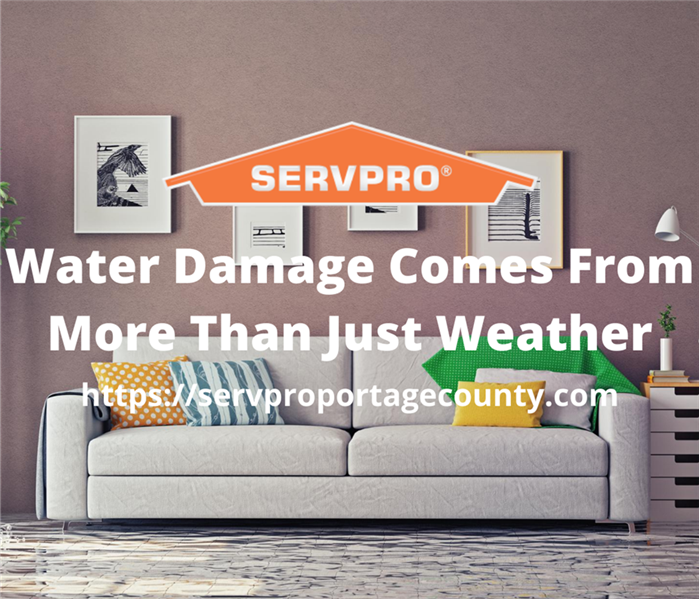 Don't be surprised by in-home disasters causing water damage.
Don't be surprised by in-home disasters causing water damage.
Many home and business owners know that extreme weather can cause damage to their properties. But sometimes, people don’t realize that water damage isn’t just a threat when there are heavy rains falling. Old and faulty plumbing can cause major issues for a property. In fact, plumbing is a much more common cause of water damage for homeowners, especially from devices like water heaters, ice machines, dishwashers, washing machines, and toilets.
Having your plumbing system regularly maintained is a big factor in keeping your home or business free from water damage. One of the most troublesome factors of plumbing water damage is that it can often go unnoticed for long periods of time, leading to bigger problems with the integrity of your structure as well as dangerous mold damage.
Taking the time to regularly service the devices connected to your plumbing could save you much strife in the long run. Checking your sump pump, for instance, is an easy way to ensure that you don’t experience flooding your basement. Additionally, homeowners with a water heater that is more than 15 years old are at a high risk to experience water damage in the property due to faulty equipment.
Other than performing regular maintenance, there are some emergency water alert systems that a home or business owner can invest in to make sure they do not experience water damage. Some systems will alert people that water is running in a place or fashion that it is not supposed to, and other systems will automatically shut off the water if and when leaks or issues are detected. These systems could be very helpful in the event of a disaster in your home.
If you ever do experience water damage at your property, it’s important to remember that a quick response is vital to mitigate the damages. SERVPRO of Portage County will be there any time, day or night to help return your space to normal. We are on your side, faster to any disaster.
Is Your Sump Pump Ready for a Storm?
8/28/2020 (Permalink)
 Look out for common problem with your sump pump before they cause big problems for you.
Look out for common problem with your sump pump before they cause big problems for you.
Your basement – you might not feel like it’s the most important part of your home but if you’ve ever experienced a basement flood then you know just how devastating it can be. We often think of our homes as invincible; they do such a good job of protecting us from the elements most of the time. But if the little contraption in your basement that drains water away from your foundation isn’t working, you could be in store for a major disaster.
Did you know, for instance, that a sump pump is only good for about 10 years? That’s right, everything has a shelf-life and your sump pump is no exception. After a good solid decade of work, that little machine will be due for a change. Unfortunately, most people don’t realize or think about replacing their sump pump until it fails to do its job and you have to deal with some measure of flooding in you home. But if you’ve been in your home for a while and you’re not sure how much life your sump pump has left, you should call a plumber to come out and inspect it. They can let you know if it needs to be replaced or repaired before it’s too late.
Additionally, if your sump pump doesn’t have a lid, there is a chance that dirt and debris have gotten in and clogged it. You should inspect your sump pump on a regular basis to make sure that it isn’t clogged and that it drains the water effectively. Also, you should think about investing in a lid for that sump pump to prevent further troubles.
If your sump pump is running a lot or making excessive noise when it runs, that’s another good indicator that something is wrong. Grinding and thumping noises are definitely unusual for a sump pump so if you start to hear these noises it's probably time to call a professional.
And finally, it is of the utmost importance that your sump pump actually has power. If the circuit that the sump pump is on blows, you might not immediately notice unless it is also connected to something you frequently use. Even more common than that, however, is the instance where your sump pump was harmlessly unplugged but never plugged back in. You would be surprised at how many times this exact situation has spelled disaster for a home. Simply double-checking that the cord is safely plugged into the outlet could make all the difference in the world.
Sump pump testing is fairly easy so there is no excuse not to check yours out and ensure that you are protected. If something isn’t working properly, you will know to call a plumber and get yours in ship-shape before it’s too late. And if you don’t catch your working sump pump in time, SERVPRO of Portage County will be there to pick up the pieces. We are faster to any disaster.
SERVPRO of Portage County is Your Trusted Partner
8/28/2020 (Permalink)
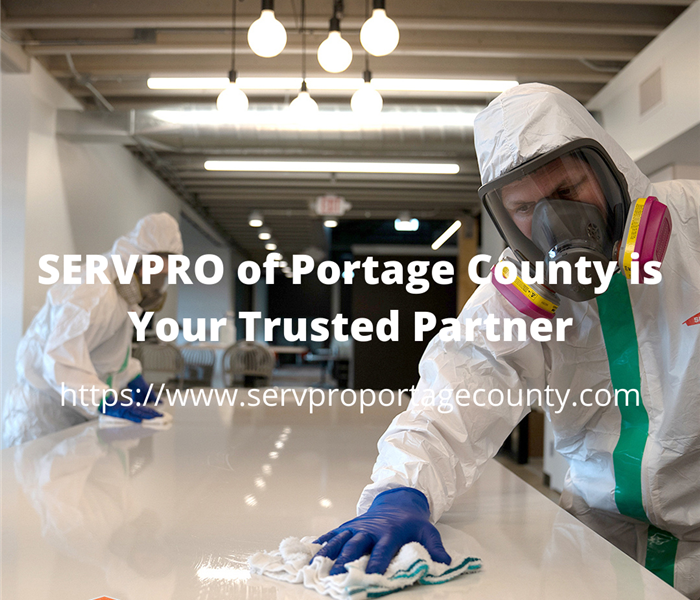 Trust us to get you back up and running efficiently.
Trust us to get you back up and running efficiently.
Living in this strange time in our lives has been a challenge for many of us. For business owners especially, things have been fraught and difficult to navigate. Most businesses were closed for several months and, when they reopened, it was with new rules and restrictions in place to keep both employees and customers and clients safe. Keeping things clean has been of the utmost importance since the pandemic began and it has only become more of a focus for people. That’s why you should make SERVPRO your partner in the event that you have a confirmed COVID-19 case at your business.
A swift and thorough response is absolutely necessary when a COVID event is identified. The CDC recommends:
- Immediately report to the local health district
- Work with them to facilitate contact tracing
- Shutdown the shop/floor for deep sanitation if possible
- Professionally clean and sanitize the site/location
- Reopen in consultation with the local health department
Our Certified: SERVPRO Cleaned program is a defensive program that goes way beyond janitorial or carpet cleaning - always adhering to the cleaning and decontamination standards set by the CDC. SERVPRO professionals have been on the frontlines of proactive and reactive COVID-related cleanup and are here to help as your business begins to reopen. We are working to create a higher standard of clean for everyone. You can trust us to get you back to work swiftly and efficiently. Contact us to talk about Certified: SERVPRO Cleaned for your business.
Unnoticed Water in Your Home Could Lead to Damage and Mold
7/20/2020 (Permalink)
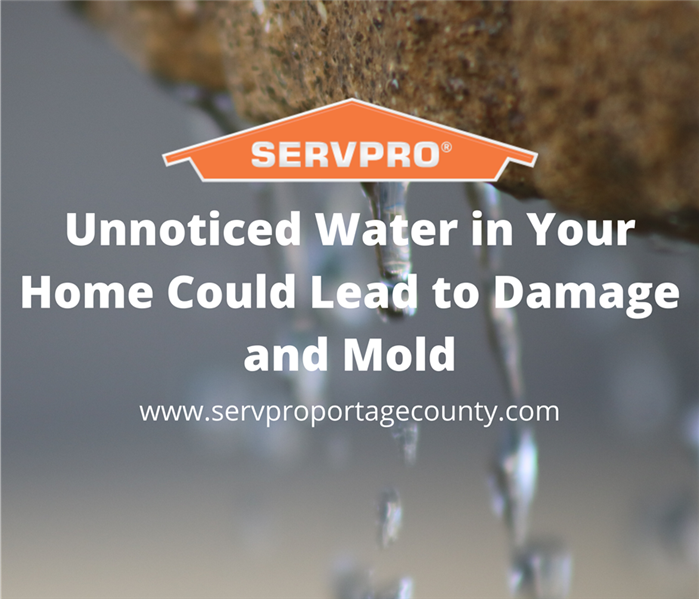 Stay alert for signs of water damage in your home.
Stay alert for signs of water damage in your home.
Water is our main life-force as humans. We are mostly composed of it and we need to drink it to survive. We use it to clean ourselves and our homes and remove our waste – the advent of bringing running water into our homes truly changed the way we exist within the world. But water can also cause problems. This powerful force can eat away at things we love, damage structures, and cause a silent issue: mold and mildew.
Sometimes, when you have water damage in your home, it is easily apparent – situations like a flooded basement or a puddle on the floor next to the sink or the toilet. Of course, when these things happen you know that a quick response is important and cleaning thoroughly after the necessary repairs have been made is crucial. Other times, however, water damage can happen without you having any idea.
There are a lot of places around your home where water could easily be collecting without you noticing it. On the outside of your home, window and door frames, siding, and chimneys are all common places where water can enter and cause damage. Inside, anywhere there are pipes could become an issue. Most commonly, you will want to keep your eye on the area under your dishwasher, around your toilets, under sinks, and behind washing machines. Air conditioning units can also cause problems because of condensation. If you have a window unit, make sure you are looking under and around it, or if you have an HVAC unit, try to keep it regularly maintained and serviced.
If water is collecting in the walls of your home, however, it can be hard to tell unless you rip out the drywall and take a look. It’s important to keep an eye out for signs that something might be wrong. Musty odors, stains or discoloration, peeling paint or wallpaper, and warping walls, ceilings, or floors are all signs that there is an underlying issue that needs to be handled. Perhaps the most obvious sign, however, is visible mold. If you can see mold in your home, there is an issue that needs to be addressed immediately.
If you have water damage in your home, a quick response is vital to effectively address the situation. SERVPRO of Portage County has a team of highly-trained technicians who can help restore your home to perfect condition. From water damage repair to mold remediation, we can handle whatever problems you’re having. Call us at (330) 677-4483 and let us help make it "Like it never even happened."
SERVPRO of Portage County is Dedicated to Training All Personnel
7/20/2020 (Permalink)
 Training is a vital part of ensuring that we do the best job possible.
Training is a vital part of ensuring that we do the best job possible.
At SERVPRO of Portage County, we care about making sure that you receive the best service possible from us. We know that trusting the right company to put your home or business back together after a disaster is an important decision and we don’t take it lightly that you put your faith in us. That’s why we make sure that every one of our technicians is highly trained to be able to do expert level work for your restoration needs.
As a company, we are IICRC certified and we make sure that every one of our technicians gains that certification also. The Institute for Inspection, Cleaning, and Restoration Certifications sets universal standards for cleaning, inspection, and restoration that all of our technicians are trained to achieve. Additionally, every technician is WRT (Water Damage Restoration Technician) certified and all of our supervisors are ASD (Applied Structural Drying Technician) certified as well. Our management team has gone through the even further training of Biohazard, Air Quality, and Mold cleaning as well. All of these certifications come through the IICRC as well, the absolute highest quality training available in our industry.
You should have every bit of confidence in the team that you ask to come into your home or business in your time of need. We spare nothing in the training and certifying of our technicians, supervisors, and managers to get the job done right. Call SERVPRO of Portage County for your restoration and cleaning needs and breathe a little easier knowing that we’ve got your back.
Certified: SERVPRO Cleaned - A Defensive Cleaning Program
7/20/2020 (Permalink)
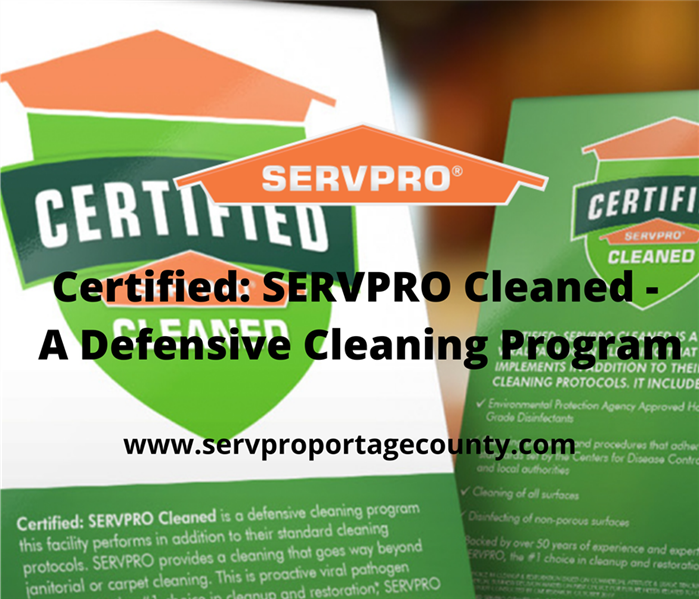 Our defensive cleaning program gives your business a way forward by providing your employees and customers ongoing safety and assuredness.
Our defensive cleaning program gives your business a way forward by providing your employees and customers ongoing safety and assuredness.
Let us help you get back to business
As our communities re-open, we’re all moving back toward a new kind of normal. The expectations of visitors, customers, and employees who come into our establishments have evolved, and staying safe and well is a top concern. The global COVID-19 pandemic has changed what it means to be clean, and we’ve developed a program to help your business meet the new higher standard of clean that is now expected.
Certified: SERVPRO Cleaned is a defensive cleaning program we’re offering to businesses and commercial locations to address the current COVID-19 pandemic. This proactive viral pathogen cleaning program goes well beyond janitorial or carpet cleaning. By choosing Certified: SERVPRO Cleaned, you, your employees, your customers, and your community can rest assured that you’ve selected a higher cleaning standard – you are Certified: SERVPRO Cleaned.
Extensive training and specialized products
As the #1 choice in cleanup and restoration*, we stand on more than 50 years of experience and expertise to help your business become Certified: SERVPRO Cleaned. Beyond fire & water, SERVPRO professionals are trained and experienced in biohazard decontamination and chemical spills – always adhering to the cleaning and decontamination standards set by the Centers for Disease Control and Prevention and local authorities.
From formulating and creating our proprietary cleaning products, like SERVPROXIDE, at our headquarters in Gallatin, TN, to taking the utmost care while disinfecting, we will ensure you and your business are set up to inspire consumer confidence as the economy continues to reopen.
3 C’s – Consult, Clean, and Certify
When the stakes are this high, you want a partner who has developed an industry leading, proprietary training program, cleaning solutions, and remediation processes over decades. We’ve cleaned up some of the most challenging biohazards imaginable. Certified: SERVPRO Cleaned reflects our unique experiences and capabilities. The program is grounded with our unique 3 C’s: Consult, Clean, and Certify.
- Consult – Every business is different, which is why you’ll be assigned a Cleaning Protocol Consultant who understands your business and will create a cleaning program to meet your specific needs. This program will be developed based on your business type, size of space, amount of high frequency touchpoints, foot traffic and congestion points.
- Clean – Based on your specific business needs, your location will undergo a thorough, deep clean, using exclusive cleaning products, according to protocols set forth by the CDC. Our employees have years of experience, and we will go beyond the scope of work that regular janitorial staff perform. Cleanup procedures generally include cleaning of porous and non-porous surfaces, disinfecting of non-porous surfaces, cleaning and disinfecting of equipment, tools, and/or supplies used for cleanup process, and disposal of hazardous materials. In the event of a suspected or confirmed COVID-19 event, we will be there cleaning within 24 hours to ensure you get back to business as quickly as possible.
- Certify - Once your business location has been Certified: SERVPRO Cleaned, you will gain access to proprietary signage, digital emblems, and other collateral that communicates that you’ve selected a higher standard of clean available to help protect your employees and customers. And because we add the day, month, and year to that proprietary stamp of clean, your guests will know that not only did you choose Certified: SERVPRO Cleaned, but that your location is being cleaned regularly at this standard.
Call today for a Certified: SERVPRO Cleaned consultation
We’re Here to Help – 24 hours a day, seven days a week – until life is back to normal in the communities we all call home.
Call SERVPRO of Portage County today at (330) 677-4483 for your Certified: SERVPRO Cleaned consultation.
* #1 Choice in cleanup & restoration based Commercial Attitude & Usage Tracking study. Polling 816 commercial business decision makers on first choice for future needs related to cleanup & restoration work. Study conducted by C&R Research: October 2019
Certified: SERVPRO Cleaned means professionally trained SERVPRO franchises perform the requested cleaning, sanitizing and disinfection services according to proprietary SERVPRO protocols and recognized industry and CDC standards with EPA approved cleaning products to deliver a SERVPRO certified cleaning experience. Each SERVPRO franchise is independently owned and operated.
Things You Should Know About Summer House Fires
6/16/2020 (Permalink)
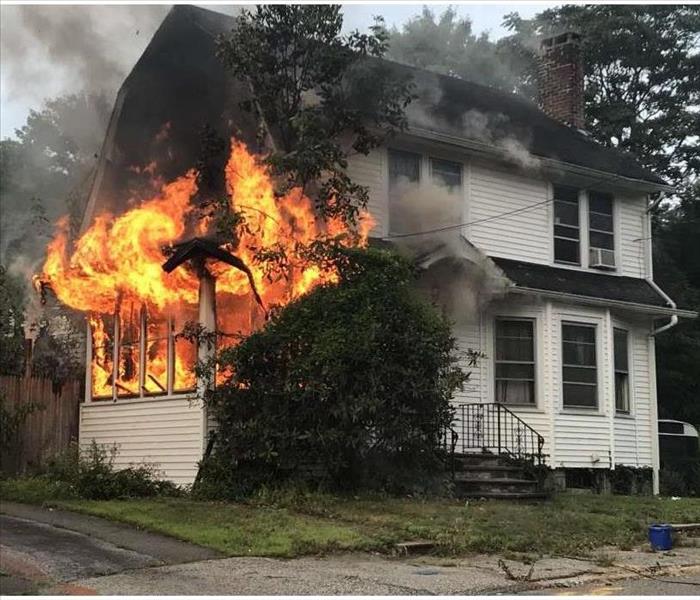 Avoid disasters like this one by taking simple summer precautions.
Avoid disasters like this one by taking simple summer precautions.
House fires are less common during the summer months than during the winter but that doesn’t mean they don’t happen. House fires can happen at any time and the summer presents a range of unique risk factors that cause fires. There are some things you should know about summer house fires to stay aware of your surroundings and help prevent disaster in your home.
One of the biggest causes of fires in the summer is cooking, both outdoor and indoor. Indoor cooking is a leading cause of fire all year round and the summer is no special case. However, in the summer, many people take the cooking outdoors to their grill. Grill fires are often caused by mishandling of propane, improperly maintained grills, and inattentiveness. You should check your propane tank and line for leaks and to ensure that it is properly attached every time you use your grill. Additionally, your grill should never be left unattended. Take the time to clean your grill every time you use it, as buildup could be a major cause of grill fires.
Another common cause of fires in the summer months is air conditioners. Most air conditioner fires are caused by faulty electrical components and short circuits. You should have annual inspections of your air conditioning system to help avoid any electrical failures but also to help reducing cooling costs by cleaning out dirty or clogged systems. If you have central air, you are less likely to be at risk for electrical fire from the air conditioning system. Individual units can get overloaded and cause issues much quicker than central systems.
Smoking is a leading cause of house fires year-round as well. People who smoke in their homes are always at higher risk than those who step outside but dry conditions during the summer months can cause fires from improperly extinguished cigarettes if you are not careful.
Other causes of summer house fires include a spike in arson cases and natural disasters like lightning storms. There is not much you can do to prevent either of these cases but they are far more rare than the other preventable issues that lead to house fires in the summer months.
If the worst-case scenario happens to you, make sure that you call SERVPRO of Portage County. We are faster to any disaster 24/7/365. We have highly trained technicians to repair and clean damage to your home. Contact us at (330) 650-4486.
Prepared for Portage County Storm Season?
5/24/2020 (Permalink)
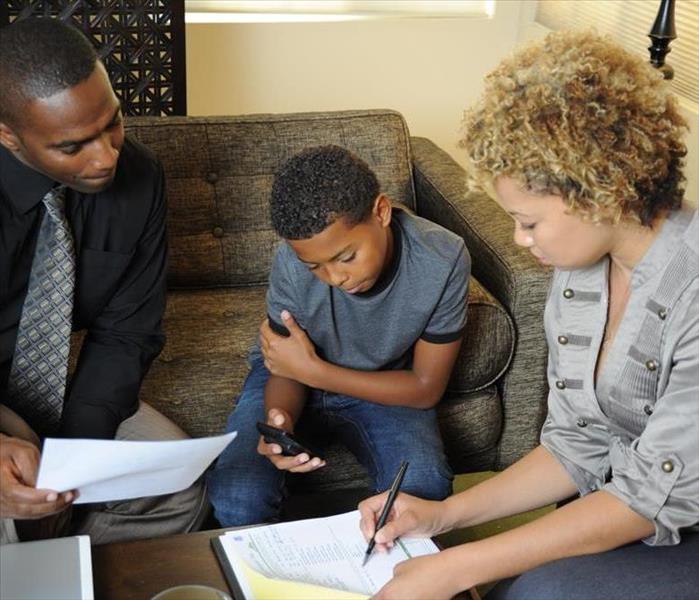 Get your family prepared for anything with a Family Emergency Plan.
Get your family prepared for anything with a Family Emergency Plan.
We never think it will happen to us but disaster could strike at any time. May is the beginning of storm season in Portage County. Are you prepared? Knowing what to do in the event of an emergency could make a huge difference when it comes to keeping your family safe. That's why you should create a Family Emergency Preparedness Plan so you can take action quickly in case anything goes wrong.
There are several great sources for creating a Family Emergency Preparedness Plan. Review a few different plans and then get started gathering items for your Family Emergency Kit. Start with the items which may be medically necessary and prioritize the remaining list according to need. Listing the items in priority of need will help to keep your Emergency Kit budget-friendly as you could easily go overboard when getting prepared. Using items currently in the home is also a good way to cut costs.
Resources for creating your family emergency plan:
Department of Homeland Safety: https://www.ready.gov/plan
National Storm Center: https://www.stormdamagecenter.org/
FEMA: https://www.fema.gov/media-library-data/1440449346150-1ff18127345615d8b7e1effb4752b668/Family_Comm_Plan_508_20150820.pdf
American Red Cross: https://www.redcross.org/content/dam/redcross/atg/PDF_s/Preparedness___Disaster_Recovery/General_Preparedness___Recovery/Home/ARC_Family_Disaster_Plan_Template_r083012.pdf
2020 has been an unprecedented year, Portage County along with the rest of our Nation is dealing with the Coronavirus/COVID-19. We don’t expect the unexpected, but it happens without warning. Developing a family emergency plan is a great way to bring the family together - work together on the plan, and check your needed items off the list. This will help inform the children and remove some of the fear of the unknown. Through practice, your whole family should become confident in your plans.
SERVPRO of Portage County knows that storm, and flood damage can have a huge effect on your family, home, or business. In the face of such a horrible event, we want you to know that SERVPRO is here to help with 24-hour emergency services because we know storms happen at anytime or any-day. SERVPRO of Portage County has highly trained water restoration technicians and is a trusted leader in the water restoration industry.
When a storm hits your Kent home, you need the company with storm damage experience and expertise.
SERVPRO ASSISTS PORTAGE COUNTY BUSINESS IN FIRE RESTORATION
4/14/2020 (Permalink)
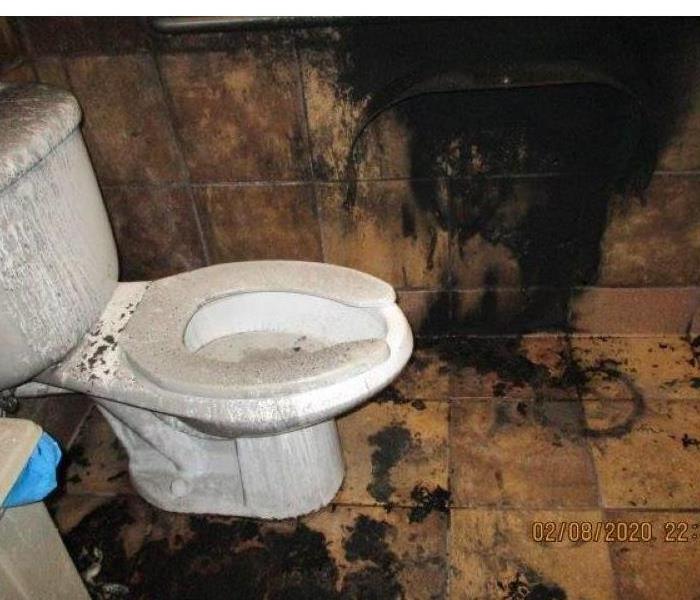 SERVPRO assisted a Portage County business to quickly reopen following a bathroom fire.
SERVPRO assisted a Portage County business to quickly reopen following a bathroom fire.
Experiencing fire damage in your commercial building can be devastating. SERVPRO of Portage County will quickly respond to all emergency request. SERVPRO’S team will immediately assess the extent of damage, areas of contamination, and rapidly develop a structured mitigation plan to implement for your facility. SERVPRO of Portage County has over 35 years of fire damage cleanup, restoration training, and indoor environmental health experience. SERVPRO of Portage County is focused on protecting your employees, your customers, and minimizing disruptions to your operations so that we can help keep your business running smoothly.
Heavy extensive deposit of soot and ash will require professional cleaning to remove soot particulates, contaminates and staining. In the Portage County fire loss, SERVPRO responded to restore after a bathroom fire. SERVPRO’s professional team of restorers used air scrubbers and containment to protect cross contamination to the non-affected area of the building. The methods and equipment used will depend upon the type of combustible substances. Smoke and soot from wood, protein or synthetic material will each create a different kind of cleanup problem. SERVPRO was able to clean and restore this commercial property with the use of professional cleaning agents, IICRC certified cleaning technicians, and quick response. Our Portage County customer was able to reopen their business within 24 hours of this event.
While fires are scary, professional fire damage restoration services can help minimize downtime and quickly return you to business as usual.
Have Questions about Fire, Smoke, or Soot Damage?
Call Us Today – (330) 677-4483
SERVPRO OF PORTAGE COUNTIES RESTORES FINE ART FOLLOWING FIRE DAMAGE
4/13/2020 (Permalink)
 SERVPRO of Portage County assists an art owner to restore several pieces of artwork after soot damage.
SERVPRO of Portage County assists an art owner to restore several pieces of artwork after soot damage.
SERVPRO of Portage County works with insurance companies and claim representatives to evaluate and restore works of art that have been affected by water, mold, soot, or fire damage. Time is of the essence for the best possible restoration outcome. Call us to ensure that damaged artwork is property handled after experiencing damage. Improper handling can further damage the piece and increase the cost of restoration.
SERVPRO of Portage County can provide expert evaluation of damaged artwork. Based on the evaluation of each piece, SERVPRO will provide develop and implement a plan for restoration. SERVPRO can provide all necessary restoration services to return the artwork to its preloss condition.
SERVPRO can assist in restoring books, photographs, ceramics, paintings and works on paper. Our experienced and professional restorers can restore your damaged items and maintain the integrity of your piece at the best possible cost.
Call SERVPRO of Portage County if you have any fine art or family memories that you need restored. We are passionate about restoring your collectibles.
Restoring Your Commercial Property After A Water Damage Event
4/4/2020 (Permalink)
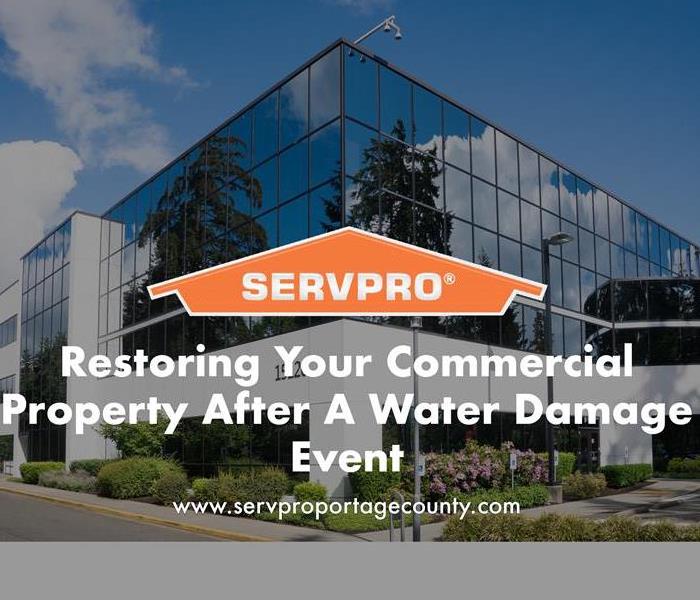 It is important to plan ahead for your business whenever possible.
It is important to plan ahead for your business whenever possible.
Flooding and water damage events in Portage County businesses are often complex that require a knowledgeable and flexible response. Having any sort of damage to your business is stressful. Whether it’s a relatively small water cleanup or a large scale event, we work quickly to assess each unique situation.
Our professionals are trained to fully restore the damaged area while working within your budgetary constraints. We understand that every hour spent cleaning up is an hour of lost revenue and productivity.
Therefore, when an emergency situation arises in your business, give us a call and we’ll be there fast with professional help and restore your business damage efficiently, so you can return open your business doors again.
It is important to plan ahead for your business whenever possible. We know how devastating business disasters can be, but we are here to help! Call SERVPRO of Portage County (330) 677-4483 to help get your Emergency Readiness Plan in place.
Prepare For Spring Storms in Portage County
4/4/2020 (Permalink)
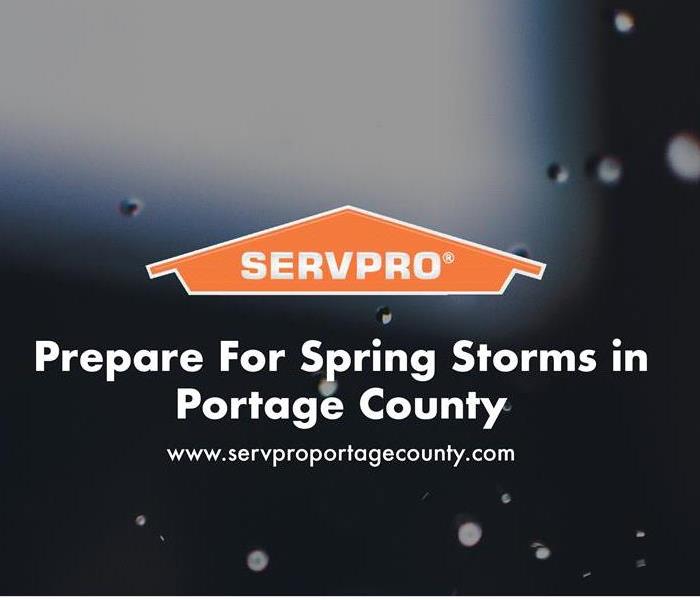 We hope that you stay safe in the spring months of Portage County.
We hope that you stay safe in the spring months of Portage County.
Spring season is here in Portage County. Green grass, colorful flowers, and relaxing rain showers. Consider the tips below to take safe steps when dangerous weather is predicted.
- Download the free Red Cross tornado app. This app puts everything you need to know to stay safe in a tornado at your fingertips.
- Pick a safe room in your home where you can gather if a tornado is headed your way: a basement, storm cellar or interior room on the lowest floor with no windows.
- Prepare for strong winds by removing diseased and damaged limbs from trees.
- Move or secure lawn furniture or anything else that can be picked up by the wind.
- Know the tornado danger signs: dark, often greenish clouds, a wall cloud, cloud of debris, large hail, and a funnel cloud and take shelter immediately.
- Watch for storm signs like darkening skies, flashes of lightning or increasing winds and take shelter immediately.
- Postpone any outdoor activities if there are thunderstorms of any kind.
- Anyone should be prepared to evacuate at a moment’s notice and head for higher ground when a flood or flash flood warning is issued.
- If you come upon a flowing stream where water is above your ankles, stop, turn around and go another way.
We hope that you stay safe in the spring months of Portage County. Should you have any damage from storms this spring we are here to help! Call SERVPRO of Portage County (330) 677-4483.
SERVPRO of Portage County Has Advanced Technology and Techniques
4/4/2020 (Permalink)
 We know how devastating disasters can be, but we are here to help!
We know how devastating disasters can be, but we are here to help!
Advanced Technology and Techniques are implemented at SERVPRO of Portage County. These advancements allow our professionals to restore a property back to preloss condition quickly, reliably, and more effectively. There are many reasons you should choose SERVPRO of Portage County for your restoration needs.
The Institute of Inspection Cleaning and Restoration Certification (IICRC) sets practical standards for restoration and cleaning. The IICRC S500 Water Damage Guide is a specific set of practical standards that incorporate the field of psychometry.
We use Moisture Detection and Measurement Equipment. Scientific drying principles rely upon specialized equipment to detect, measure and monitor a property’s moisture levels. An infrared camera may be used to identify water location for thorough water removal.
Powerful extraction equipment speeds the drying process by removing the bulk of the water from your home or business. We have Submersible and gas-powered pumps for continuous pumping of high-level water.
Water and fire damage often causes powerful odors. The machines we use remove airborne contaminants and control the air quality during the restoration and cleanup process.
We know how devastating disasters can be, but we are here to help! Call SERVPRO of Portage County (330) 677-4483 for your restoration needs.
Choose SERVPRO of Portage County for your Restoration Needs.
3/6/2020 (Permalink)
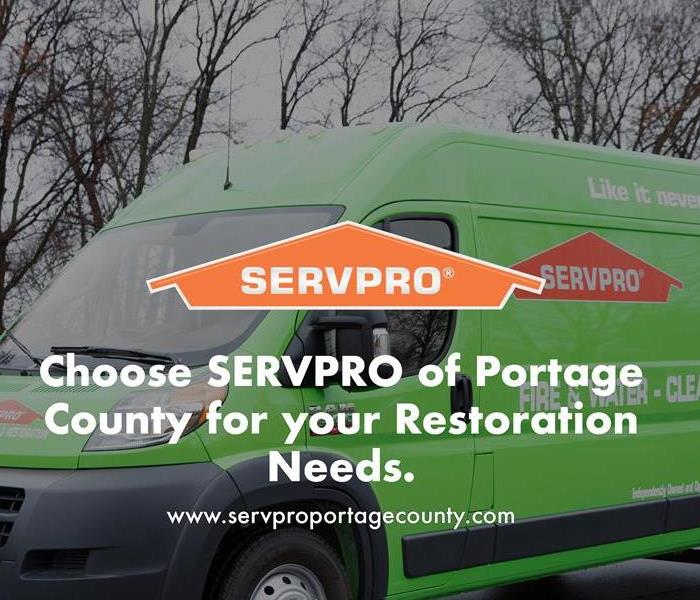 SERVPRO of Portage County is a trusted leader in the restoration industry for your business or home.
SERVPRO of Portage County is a trusted leader in the restoration industry for your business or home.
SERVPRO of Portage County is a trusted leader in the restoration industry for your business or home. We provide 24-hour emergency service and are dedicated to responding faster to any size disaster in your home or business. We are professionals and will restore your home or business in a timely and efficient manner, so you can get your life back to normal in a timely manner. With the training and expertise SERVPRO of Portage County has, we will handle your restoration and cleaning needs. We’re locally owned and operated and can respond immediately to your emergency in SERVPRO of Portage County.
We’re locally owned and operated and can respond immediately to your emergency in SERVPRO of Portage County.
Our crews are IICRC certified: The Institute of Inspection, Cleaning and Restoration Certification. Our highly trained crews make sure the mitigation process runs properly and smoothly. Their expertise along with our highly trained tradesmen will make it “Like it never even happened."
We know how hard a disaster can be, but we are here to help! Call SERVPRO of Portage County (330) 677-4483 to help get your home restored efficiently.
How To Prepare For a Storm in Portage County.
3/6/2020 (Permalink)
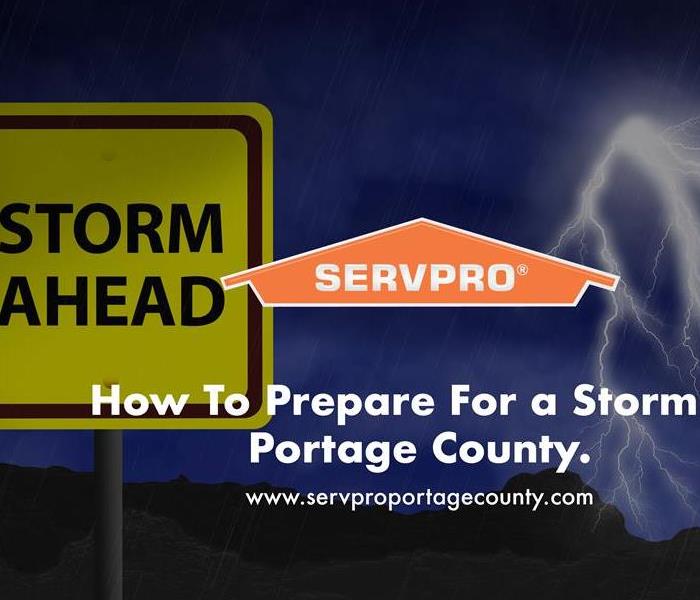 We know how devastating storm disasters can be, but we are here to help!
We know how devastating storm disasters can be, but we are here to help!
Storms can happen at anytime in Portage County. Sometimes they are unpredictable and other times you can prepare for them slightly. Either way mother nature can cause a ton of damage. It is important to know some basic storm tips:
BEFORE THE STORM
- Build an emergency supply kit
- Unplug any electronic equipment before the storm arrives.
- Secure outdoor objects that could blow away or cause damage.
- If you are outdoors, get inside a building.
- Shutter windows and secure outside doors, or close window blinds, shades or curtains.
DURING THE STORM
- Use your battery-operated NOAA Weather Radio for updates from local officials.
- Cordless and cellular phones are safe to use.
- Unplug appliances and other electrical items: computers, power surges, etc. Lightning can cause serious damage to these items.
- Avoid contact with electrical equipment or cords.
- Stay away from windows and doors.
AFTER THE STORM
- Never drive through a flooded roadway.
- Stay away from storm-damaged areas to keep from putting yourself at risk.
- Stay away from downed power lines and report them immediately.
We know that having storm damage can be stressful, but we make sure to handle all of your restoration needs in a timely and professional manner. These are just some tips that you can do in the meantime until SERVPRO of Portage County helps.
We know how devastating storm disasters can be, but we are here to help! Call SERVPRO of Portage County (330) 677-4483 to help get your home restored efficiently.
Flooding Tips for Commercial Buildings in Portage Ohio.
3/4/2020 (Permalink)
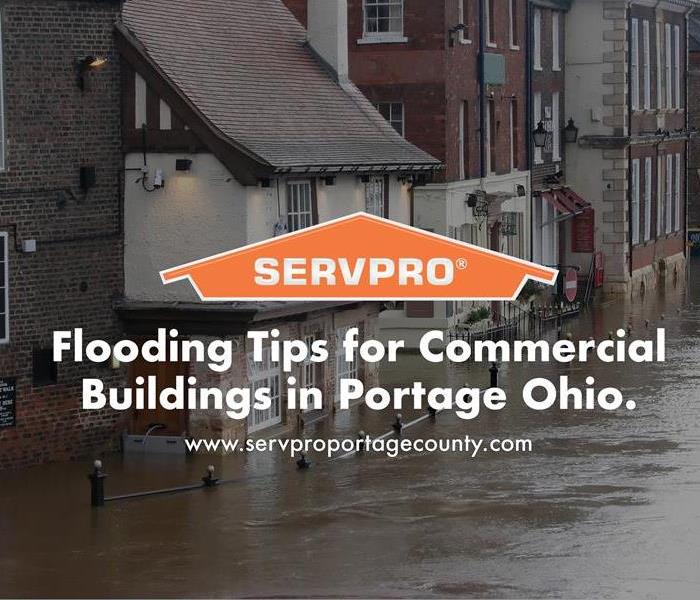 Call SERVPRO of Portage County (330) 677-4483 to help get your Emergency Readiness Plan in place.
Call SERVPRO of Portage County (330) 677-4483 to help get your Emergency Readiness Plan in place.
Flooding occurs in the Northeast Ohio area and is ranked as one of the most common natural disasters in the United States. On average, floods cost $6 billion in annual losses. Flooding can result from weather, plumbing failures, frozen pipes or even damaged structures. SERVPRO of Portage County is the company that will help get your building restored in a timely manner.
However, being prepared with potential flooding in advance can affect how much of your property can be restored:
- Determine if your property is in a floodplain. This is an area of low-lying ground adjacent to a river.
- In any emergency, listen to the local management officials
- Assess how your business functions, both internally and externally.You can do this easily by signing up for our Emergency Readiness Plan; this will help your business prepare in case of an emergency.
- Plan what you will do if your building is not accessible. This type of planning is often referred to as a continuity of operations plan.
- Review your emergency plans annually. Just as your business changes over time, so does your preparedness needs. You can put together an Emergency Plan with our Emergency Readiness Plan.
It is important to plan ahead for your business whenever possible. We know how devastating a business disasters can be, but we are here to help! Call SERVPRO of Portage County (330) 677-4483 to help get your Emergency Readiness Plan in place.
Nine Preparation Tips For a Businesses Disaster
2/5/2020 (Permalink)
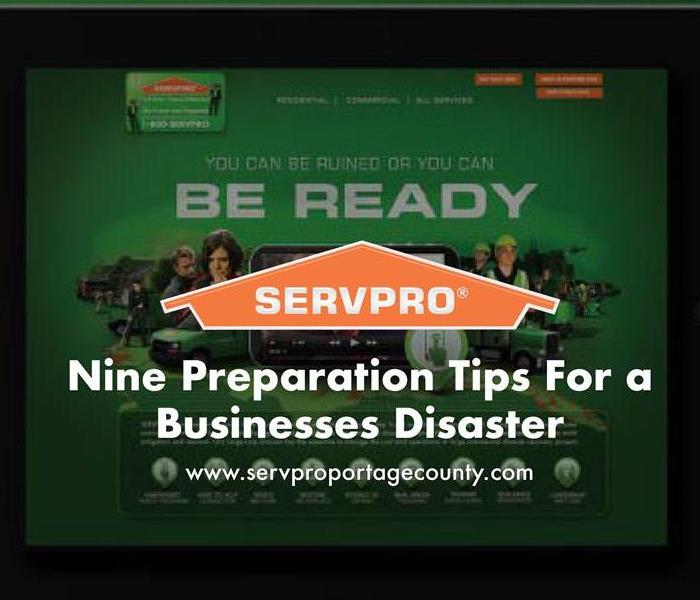 We know how devastating a business disaster can be, but we are here to help! Call SERVPRO of Portage County
We know how devastating a business disaster can be, but we are here to help! Call SERVPRO of Portage County
Would your business be ready to handle a catastrophe? A disaster can hit at anytime, whether it’s for a natural disaster, a man-made hazard, or a large-scale utility disruption. That’s why preparation for a disaster is critical.
Here are tips for disaster preparation and recovery:
1. Make a plan: If you don’t have a plan for business disaster recovery, create one today. SERVPRO of Portage County can help you create this plan for no cost.
2. Involve all employees: Your workforce is your most valuable asset therefore it’s important to educate everyone in the planning, communication, and implementation of your Emergency Readiness Plan. You never know when the disaster can hit.
3. Promote communications: It is important to know who to contact for workforce, business partners, construction services, and insurance companies. Make sure that your contact lists are regularly updated.
4. Evacuation procedures: If you are forced to abandon your business, you will need an alternative location to carry on your business. Ensure that employees know the drill for evacuating your buildings, and identify a second site from which operations may resume.
5. Assess your business assets: You should conduct an audit of facilities and equipment to establish how they may be kept secure in the event of a disaster.
6. Backup essentials: Make sure to keep alternative supplies ready. Some of these items are essentials for power, communications, and first aid.
7. Organize cash flow: Figure out extra resources to handle unforeseen expenses. It is important to also determine which employees will have access to emergency funds.
8. Review your insurance: Does your policies cover areas such as fire and water damage? Discuss essential emergency information with your insurance agent.
9. Practice your plan: Do a few trial runs of your company’s emergency drills. You will want to rehearse and test your contingency plan regularly, and update it as needed.
None of us likes to contemplate the aftermath of a business disaster, but the truth is we also need to prepare for the worst; disaster can strike at anytime.
We know how devastating a business disaster can be, but we are here to help! Call SERVPRO of Portage County (330) 677-4483 to help get your business restored efficiently.
Prevent Winter Storm Damage in Your House.
2/5/2020 (Permalink)
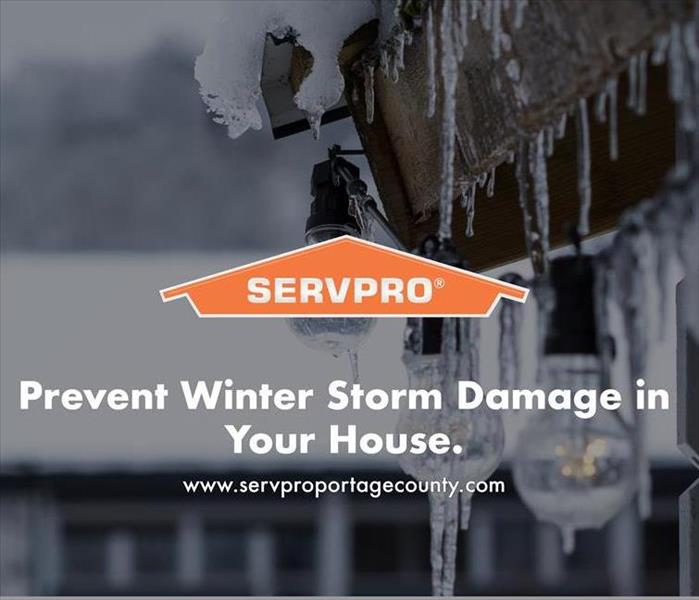 We know how devastating a storm and water disaster can be, but we are here to help!
We know how devastating a storm and water disaster can be, but we are here to help!
After a winter snow storm, temperatures can go up and down which causes melting and freezing. This temperature variation can cause snow or ice to melt and trickle into your house. This can cause damage on the way inside the cracks. Water damage is not fun for any home owner.
The goo news, you can prevent water damage from snow melts by shoveling snow away from your house. Yes, it could be as simple as that.
It may also be necessary to shovel snow from areas with grass underneath. This can help the water from entering and flooding once it warms up.
Contact our team of professionals for more information about snow water damage to your home.
We know how devastating a storm and water disaster can be, but we are here to help! Call SERVPRO of Portage County (330) 677-4483 to help get your home restored efficiently.
Six Ways to Defend Against Ice Dams in Winter
1/4/2020 (Permalink)
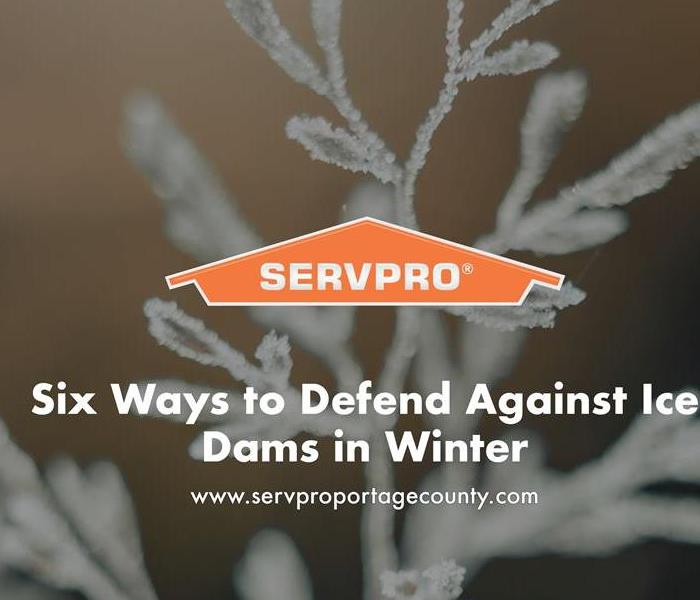 We know how devastating a water disaster can be, but we are here to help!
We know how devastating a water disaster can be, but we are here to help!
Property owners in Portage County can have water damage stemming from the roof. This is a bigger threat after winter storms than any other. The problem starts with ice dams: the roof melts snow, water flows down to the colder eaves and refreezes there.
This cycle repeats and ice accumulates in layers, but also pushes under shingles. It eventually leaks into walls, ceiling and even insulation. This can be heavy enough to pull gutters off buildings or detach.
Here are ways to defend against ice dams:
- Survey your attic to finds openings: Insulate or caulk these openings in chimneys, plumbing pipes, electrical conduits, fan outlets, and junction boxes.
- Improve the attic entrances: Entrances are the biggest offenders that channel heat into attics.
- Increase insulation. Attics should ideally have at least a foot of insulation between living spaces and attic interiors.
- Inspect ventilation outlets: Heat that enters the attic needs an easy escape route make sure that they are not blocked and are working properly.
- Remove heavy snow from roofs: Snow insulates the attic which increases the attic temperature.
- Call a professional. If you suspect ice dams are a problem for your house, call a professional like SERVPRO.
We know how devastating a water disaster can be, but we are here to help! Call SERVPRO of Portage County (330) 677-4483 to help get your home restored efficiently.
We Support Veterans, Thank You!
1/4/2020 (Permalink)
 We support the military veterans and families, we are always looking for well qualified employees
We support the military veterans and families, we are always looking for well qualified employees
SERVPRO of Portage County would like to take this opportunity to thank our American Veterans! We support veterans and their families.
Though it is not Veterans Day SERVPRO of Portage County is dedicated to showing American veterans that we appreciate their sacrifices they have made to preserve the freedom of our country. We thank you!
It is important that we always make sure to thank our veterans everyday and not just on military holidays. Pay it forward to a veteran in the following ways:
- Send a note or a card to a veteran
- Send a care package to a deployed solider
- Visit a veteran in the hospital
- Ask a veteran about his service and just listen
- We support the military veterans and families, we are always looking for well qualified employees, just call (330) 677-4483 for more information.
If you know someone who is experiencing a disaster call SERVPRO of Portage County (330) 677-4483 to help get your home restored efficiently.
SERVPRO Gives To Women who are Victims of Domestic Violence
12/3/2019 (Permalink)
 SERVPRO of Portage County gives back yet again. This Christmas Season we are collecting New and Gently Used Ladies Accessories for Women who are Victi
SERVPRO of Portage County gives back yet again. This Christmas Season we are collecting New and Gently Used Ladies Accessories for Women who are Victi
SERVPRO of Portage County gives back yet again. This Christmas Season we are collecting New and Gently Used Ladies Accessories for Women who are Victims of Domestic Violence
The items we collect will enable the Children of Women in Domestic Violence Shelters and Transitional Housing to give their Mom’s a gift at Christmas time.
So how can you help?
1. Go through your accessories and donate items that you no longer want or use. Please only donate items in good condition. This won’t cost anything and will give you a good reason to purge your closet and jewelry box.
A win-win!
2. Purchase items to donate.
3. Donate funds to help buy additional items.
What type of items are we looking for?
Used and New: Jewelry (separated in boxes or bags- please put sets together), winter hats, gloves & scarves, purses, wallets & tote bags.
New: Full size cosmetics, toiletries, lotion and perfume
This is an easy way to help others this Christmas without spending a dime!
When your items ready for pickup, contact Laura at 330-807-5471 or Laura@SERVPROrri.com
We know how damage can strike, but we are here to help! Call SERVPRO of Portage County (330) 677-4483 to help get your home restored efficiently.
Avoid Bursted Pipes in The Winter Months
12/2/2019 (Permalink)
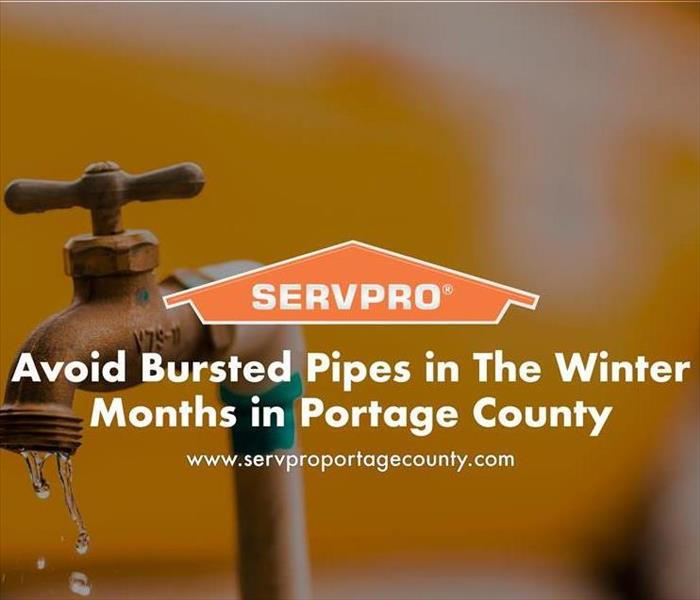 We know how devastating water damage can be, but we are here to help! Call SERVPRO of Portage County (330) 677-4483 to help get your home restored.
We know how devastating water damage can be, but we are here to help! Call SERVPRO of Portage County (330) 677-4483 to help get your home restored.
Winter is the time for frozen pipes and burst pipes. Frozen pipes can mean big problems for your home. As water freezes, it expands and can exert up to 2,000 pounds of pressure per square inch! This pressure can cause pipes to burst and water to flow into your home leaving tons of disaster problems for your home in Portage County.
In order to prevent frozen pipes in those areas, follow these tips:
- Drain water from hoses, water sprinklers, and other outdoor lines, before it is too late.
- On cold days, open cabinet doors to allow warm air to flow around pipes.
- Turn on the water taps slightly to allow a slow drip to run through the faucets.
- Make sure that there is insulation present in areas around pipes that are susceptible to cold weather.
- If you are leaving for vacation, don’t set the temperature any lower than 55°F.
Putting these tips into practice will significantly reduce your chances of having a pipe freeze in your home, and thereby, avoid the larger and much more costly and inconvenient problem of a pipe burst.
We know how devastating water damage can be, but we are here to help! Call SERVPRO of Portage County (330) 677-4483 to help get your home restored efficiently.
The SERVPRO Emergency READY Profile Advantage
12/2/2019 (Permalink)
 We know how devastating a business disaster can be, but we are here to help! Call SERVPRO of Portage County (330) 677-4483.
We know how devastating a business disaster can be, but we are here to help! Call SERVPRO of Portage County (330) 677-4483.
As many as 50% of businesses close down following a disaster, according to the latest research. Of the businesses that survive, the overwhelming majority of them had a preparedness plan in place. Pre-planning can serve as an insurance policy aimed at peace of mind. And knowing you are "Ready for whatever happens" speaks trust to your clients and employees that in the event your business is affected by a disaster, they don’t necessarily have to be.
By developing a SERVPRO Emergency READY Profile for your business, you minimize business interruption by having an immediate plan of action. Knowing what to do and what to expect in advance is the key to timely mitigation and can help minimize how water and fire damage can affect your business.
- A no cost assessment of your facility.
This means there is no need to allocate funds, giving you a great value at no cost.
- A concise Profile Document that contains only the critical information needed in the event of an emergency.
It will only take a little time to complete and will not take you away from current projects. But it will save a lot of time if ever needed.
- A guide to help you get back into your building following a disaster.
This can help minimize the amount of time your business is inactive by having an immediate plan of action.
- Establishes your local SERVPRO Franchise Professional as your disaster mitigation and restoration provider.
You have a provider that is recognized as an industry leader and close by.
- Identification of the line of command for authorizing work to begin.
This saves time so we can begin the work of mitigating the damage which can save you time and money.
- Provides facility details such as shut-off valve locations, priority areas and priority contact information.
Having a quick reference of what to do, how to do it and who to call provides solutions in advance of an emergency so that during the emergency you are "Ready for whatever happens."
We know how devastating a business disaster can be, but we are here to help! Call SERVPRO of Portage County (330) 677-4483 to help get your home restored efficiently.
Christmas House Fire Safety Tips
12/1/2019 (Permalink)
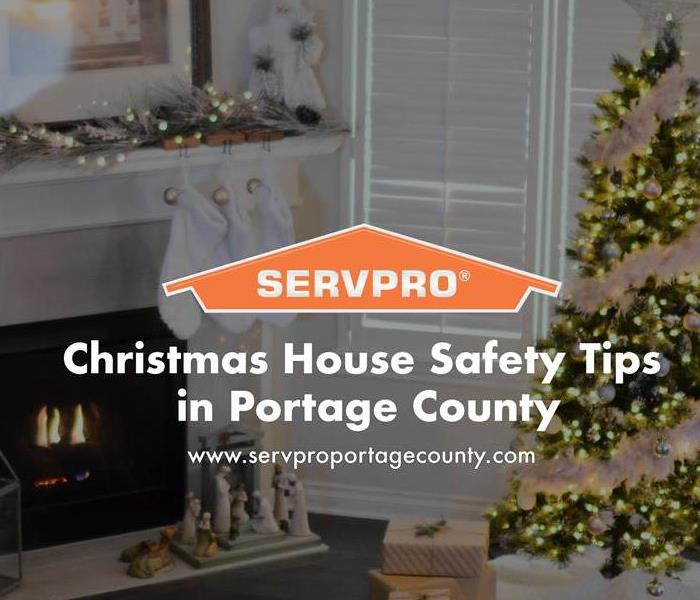 There are so many other ways to prevent fire, around Christmas time, but these are a few of the common mistakes.
There are so many other ways to prevent fire, around Christmas time, but these are a few of the common mistakes.
Christmas is around the corner, and you know what that means: fire safety. Each year, fire departments respond to an average of 210 structure fires caused by Christmas trees. Carefully decorating Christmas trees will make the holidays safer.
Here are some great Fire Prevention tips:
- Choose a tree with fresh, green needles that do not fall off when touched.
- Make sure the tree is at least three feet away from any heat source, such as fireplaces, radiators, candles, heat vents or lights.
- Make sure the tree is not blocking an exit.
- Add water to the tree stand daily.
- Some lights are only for indoor or outdoor use, but not both make sure you choose the right ones.
- Replace any string of lights with worn or broken cords or loose bulb connections.
- Always turn off Christmas tree lights before leaving home or going to bed.
- Get rid of the tree when it begins dropping needles. Dried-out trees are a fire danger and should not be left in the home or garage, or placed outside against the home.
There are so many other ways to prevent fire, around Christmas time, but these are a few of the common mistakes. We hope that you do not ever experience a fire.
We know how devastating fire damage can be, but we are here to help! Call SERVPRO of Portage County (330) 677-4483 to help get your home restored efficiently.
Thanksgiving Fire Tips
11/4/2019 (Permalink)
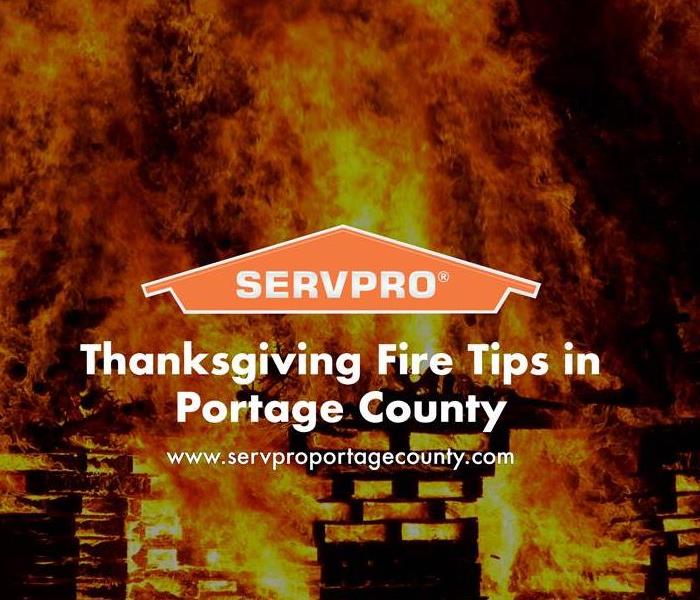 Fire safety top of mind in the kitchen during this joyous time is important, especially when there’s a lot of activity at home.
Fire safety top of mind in the kitchen during this joyous time is important, especially when there’s a lot of activity at home.
For most, the kitchen is the heart of the home, especially during the holidays. Everyone enjoys being part of the preparations.
Fire safety top of mind in the kitchen during this joyous time is important, especially when there’s a lot of activity at home. As you start preparing your holiday schedule and organizing that large family feast, follow a few simple safety tips so you can enjoy time with your loved ones.
Here are some safety tips
- Stay in the kitchen when you are cooking on the stove top and keep an eye on the food.
- Stay in the home when cooking your turkey, and check on it frequently.
- Keep children away from the stove; children should stay three feet away.
- Make sure kids stay away from hot food and liquids. The steam from vegetables, gravy or coffee could cause burns.
- Be sure electric cords are not dangling off the counter within easy reach of a child.
- Keep matches and utility lighters out of the reach of children.
- Keep the floor clear so you don’t trip over anything.
- Make sure your smoke alarms are working. Test them by pushing the test button.
Thanksgiving fire facts
- Thanksgiving is the peak day for home cooking fires, followed by Christmas Day, Christmas Eve, and the day before Thanksgiving.
- In 2016, U.S. fire departments responded to an estimated 1,570 home cooking fires on Thanksgiving.
- Unattended cooking was the leading contributing factor in cooking fires.
- Cooking equipment was involved in almost half of all reported home fires, and it is the second leading cause of home fire deaths.
We know how devastating fire damage can be, but we are here to help! Call SERVPRO of Portage County (330) 677-4483 to help get your home restored efficiently.
SERVPRO of Portage County sewage back up cleaning for commercial buildings is ECO-Friendly and Sustainable.
10/9/2019 (Permalink)
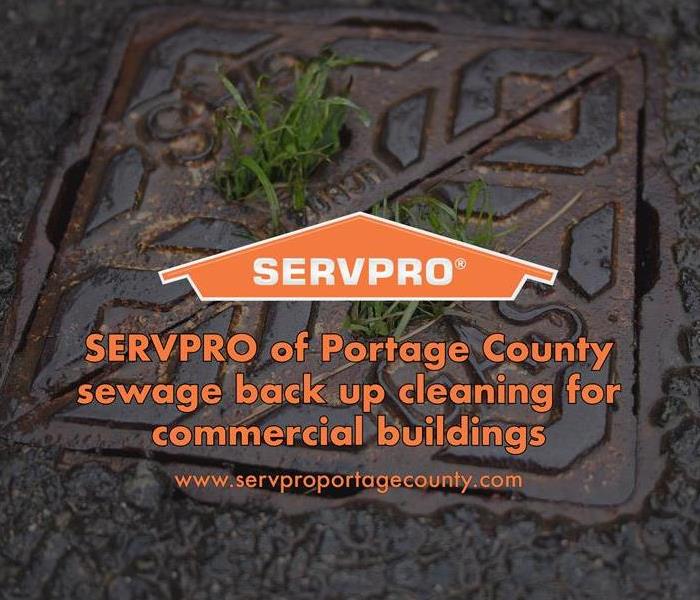 One of the most unhealthy situations for a business is backed up sewer water.
One of the most unhealthy situations for a business is backed up sewer water.
One of the most unhealthy situations for a business is backed up sewer water. Sewage is considered biohazard and carries many bacteria and germs. Even worse, you can spread that bacteria by improper cleaning procedures. As sewage professionals, SERVPRO has the proper gear to prevent exposure. If this has happened to you, we know that every minute counts. You may be tempted to handle your sewage situation yourself, but we highly advise that you call a professional for sewage backup cleaning.
When it comes to sewage backup cleaning, time is of the essence. Without the proper tools and equipment, the cleanup process can go on forever. SERVPRO of Portage County can provide sewage backup cleaning that is efficient and green. Some companies use industrial-grade artificial disinfectants, these harsh chemicals leave behind a harmful residue in the environment. That’s why SERVPRO uses Benefect instead, it is an industrial grade authentic botanical disinfectant that’s powerful enough for sewage but made from natural, safe ingredients. “Benefect products use Thyme Oil that has been specially grown & blended to exacting specifications. This groundbreaking botanical technology is proven to kill over 99.99% of bacteria and surpasses the U.S. Environmental Protection Agency's efficacy requirements for broad spectrum hospital disinfectants”. www.benefect.com
With over 30 years of experience, you can trust that SERVPRO of Portage County will follow mandated regulations and safety standards. In fact, we are a preferred vendor for many local and national businesses. We are IICRC certified, insured and have the resources to return your business to a safe and healthy environment in the most efficient manner possible.
Call anytime – 24 hours a day / 365 days a year – someone is waiting to discuss your unique situation and help you determine the best course of action.
How to Plan for A Disaster In Your Business Before it Happens
10/4/2019 (Permalink)
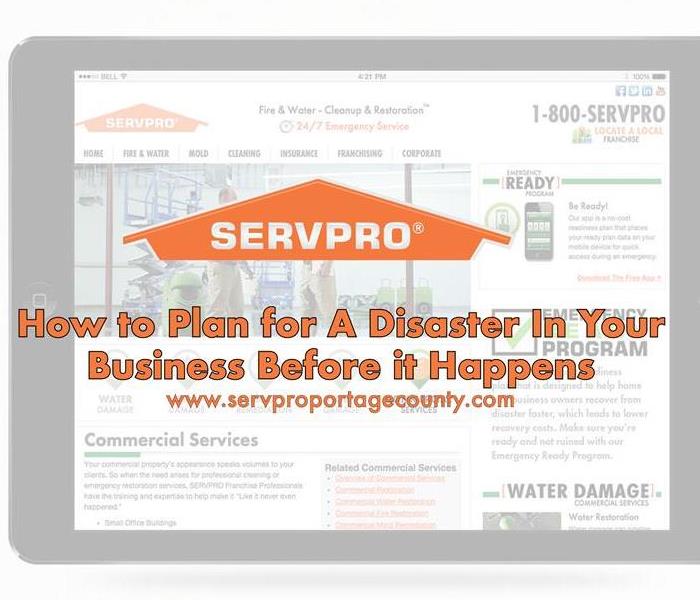 SERVPRO's Emergency Ready Profile for YOUR business will minimize business interruption by having an immediate plan of action
SERVPRO's Emergency Ready Profile for YOUR business will minimize business interruption by having an immediate plan of action
Damage from fire, storm, or water can happen at anytime and affect your business. The best way to reduce business interruption following a disaster is to PLAN for it as much as you can.
The statistics uncovered by industry research say as many as 50% of businesses may never recover following a disaster. Of the businesses that survive, the majority had a preparedness plan in place. There are a lot of ways to have a plan in place so you can get back to operation in your business.
SERVPRO's Emergency Ready Profile for YOUR business will minimize business interruption by having an immediate plan of action; you might not be prepared for the disaster but with a ready profile you will have a plan on how to act. With a no cost assessment of your facility, the program's profile includes your emergency contacts, all shut off valves and their locations, priority areas of your facility and so much more. All of these things are critical so that you can take action effectively.
The SERVPRO Ready Plan provides solutions in advance of an emergency so that during the emergency you are "Ready for whatever happens.” Businesses have raved about how much time was spent when disaster hit because of their action plan. They also have said that it helped get their business restored in an effective amount of time.
Your business will receive the benefit of over 40 years of experience in reducing the impact of any natural or man-made disaster. Call SERVPRO of Portage County at (330) 677-4483 and take the next step in protecting and growing your business.
And now with the SERVPRO Ready Plan Mobile App, help is at your fingertips. Call now and ask how to get started.
How to Prepare For Winter Storms in Portage County.
9/28/2019 (Permalink)
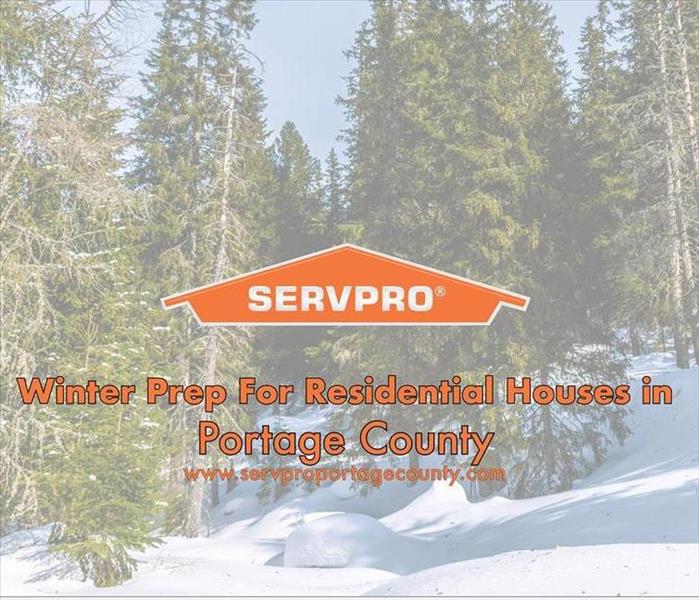 In Portage County winter storms can cause water damage.
In Portage County winter storms can cause water damage.
In Portage County winter storms can cause water damage. Just a thin coating of ice can result in a travel nightmare, and heavier amounts will severely damage trees and power lines. Ice can increase the weight of branches by 30 times. A 1/2-inch accumulation on power lines can add 500 pounds of extra weight.
Ice accumulations are caused by freezing rain. Freezing rain is a result of snow falling through an above-freezing warm layer in the atmosphere above the surface of the earth, which melts the snowflakes into rain. The rain drops then move into a thin layer of below-freezing air right near the surface of the earth, allowing them to freeze on contact to the ground, trees, cars and other objects.
SERVPRO of Portage County put together tips on how to prepare for an ice storm:
- Avoid driving on icy roads for your safety and others.
- Be sure to charge cell phones and laptops ahead of time, and have portable outlet chargers if needed.
- Plan for pets to come inside, and store adequate food and water for them.
- Children should never play around ice-covered trees.
- Think about safe alternate power sources you could use if you lose heat, such as a fireplace, wood/coal stove or portable space heaters.
- Never use portable generators, camp stoves and grills inside your home or garage.
- Use flashlights during power outages instead of candles to prevent the risk of fire.
Before the Power Goes Out: Food Safety
- Check to ensure that the freezer temperature is at or below 0 degrees and the refrigerator is at or below 40 degrees.
- In case of a power outage, the appliance thermometers will indicate the temperatures in the refrigerator and freezer to help you determine if the food is safe.
- Freeze containers of water for ice to help keep food cold in the freezer, refrigerator, or coolers in case the power goes out.
- Have coolers on hand to keep refrigerated food cold.
When the Power Goes Out: Food Safety
- Keep the refrigerator and freezer doors closed as much as possible.
- The refrigerator will keep food cold for about 4 hours if it is unopened.
- A full freezer will keep the temperature for approximately 48 hours if it is unopened.
- Buy dry or block ice to keep the refrigerator as cold as possible if the power is going to be out for a prolonged period of time.
We know how devastating a storm can be, but we are here to help for all of your water damage and restoration needs! Call SERVPRO of Portage County, (330) 677-4483, to help get your home restored efficiently.
Water Damage Can Cause Damage Quickly, Act Quick!
9/26/2019 (Permalink)
 Floods, rainstorms and ice storms can become massive water damage threats to homes in Portage County.
Floods, rainstorms and ice storms can become massive water damage threats to homes in Portage County.
Floods, rainstorms and ice storms can become massive water damage threats to homes in Portage County. Facilities plagued with such water problems this season must take quick action
Water damage can mean much more to a house than just wet carpets. There are other common problems houses face when water wreaks havoc on property, such as indoor air quality problems. Mold and mildew grow rapidly in damp, humid environments, leaving behind an unpleasant smell that permeates floors.
Damage to the building’s structure and foundation also can be an issue. When water sits inside a building for a period of time, the walls, ceilings and floors absorb the water. Total reconstruction of the building often becomes the only option.
To minimize water damage, there are two critical steps that need to be taken:
- Act fast to assess the situation
- Control the environment within the building.
Act Fast and Call an Expert
The absolute first step to take is fast action. The longer the water flows the greater the recovery problem becomes.
In a typical scenario, a team of water damage recovery professionals, such as SERVPRO of Portage County, is dispatched to the site to perform a thorough inspection and fully determine the extent of the damage. A disaster reclamation partner also will develop an intense restoration plan and determine which items are worth restoring and which are better replaced.
Controlling the Interior Environment
The other key in limiting water damage is to quickly control three conditions: relative humidity, temperature and air circulation.
The most effective way to control these conditions is to employ professional disaster drying that combines air movers with desiccant dehumidifiers.
Disaster drying often eliminates the need to rip out and replace walls, carpet, floor covering, hardwood floors and the building structure. On top of that, you preclude the odors and staining caused by mold and mildew. These problems can come back to haunt you weeks later in a superficially dried building.
We know how devastating water damage can be, but we are here to help! Call SERVPRO of Portage County (330) 677-4483 to help get your home restored efficiently.
Winter Prep For Residential Houses in Portage County
9/26/2019 (Permalink)
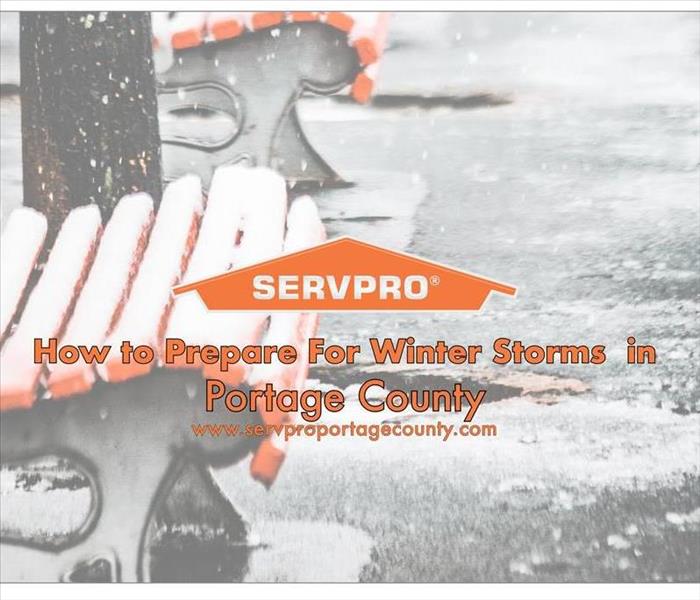 SERVPRO of Portage County has some tips to help you protect your home before winter storm damage
SERVPRO of Portage County has some tips to help you protect your home before winter storm damage
The winter months are upon us soon now. Freezing temperatures, ice, snow and wind can cause severe damage to your home and property. SERVPRO of Portage County has some tips to help you protect your home before winter storm damage:
Build Up of Ice and Snow on Your Roof
Ice dams occur when heat from a house escapes the attic and warms the roof. Snow on the roof melts and then refreezes, causing a ridge of ice to form and trap water on the roof. Protect your roof by thoroughly cleaning your gutters in the late fall, now is the perfect time before winter. Clogged gutters may allow ice to form and back up under the roofline.
Plumbing Inside and Outside Your Home
Plumbing located within exterior walls or unheated crawl spaces is the place for freezing or bursting. All interior pipes should be insulated or have wall insulation around them, such as attics and crawl spaces.
Fireplaces, Furnaces and Heating Systems
Improper use or poor maintenance of heating systems can cause fire and smoke damage. Wood burning fireplaces or stoves are among the worst culprits for fires. Clean chimneys and flues on fireplaces and stoves annually to help prevent fires.
If you run into having water damage from any storm, give SERVPRO of Portage County, (330) 677-4483, a call to help restore your home in an efficient manner.
Would You Be Prepared For A Fire in Portage County.
9/24/2019 (Permalink)
 There is no real way to be prepared, but a fire can strike. Being prepared will help reduce its devastating effects.
There is no real way to be prepared, but a fire can strike. Being prepared will help reduce its devastating effects.
There is no real way to be prepared, but a fire can strike. Being prepared will help reduce its devastating effects. The first few minutes following a fire are the most important; any inappropriate action or inaction at this stage can have far-reaching consequences.
When a fire occurs, notify the fire department, the police department, and the insurance company immediately. Next, call a disaster restoration company, such as SERVPRO of Portage County, to help prevent further damage. Because fire departments usually do not recommend specific disaster restoration professionals, a business should reference its contingency plan or contact its insurance company.
By evaluating the materials and surfaces affected, a disaster restoration company, such as SERVPRO of Portage County, can provide an understanding of the fire's chemistry and allow for a targeted, informed restoration effort. Even though each fire's chemistry differs, one of the most important things disaster restoration companies do immediately is wipe down the affected areas to avoid further damage. We use air scrubbers, which are highly filtered air machines, so soot particles will not recontaminate air and will limit redistribution of contaminated particles while restoration work continues. We pull all filters from the HVAC system, clean and recondition the system, and then install new filters.
A fire can involve well more than 100 chemical elements. A fire at a business is usually a complex fire, the result of incomplete combustion and fueled by synthetic materials, including those found in carpets, furniture, plumbing, and other equipment. Complex fires cause the most damage and leave the most waste, but disaster restoration professionals can professionally handle the cleanup and restoration.
We know how devastating a fire can be, but we are here to help! Call SERVPRO of Portage County (330) 677-4483 to help get your home restored efficiently.
SERVPRO of Northern Summit County uses structure materials with thermal imaging
8/28/2019 (Permalink)
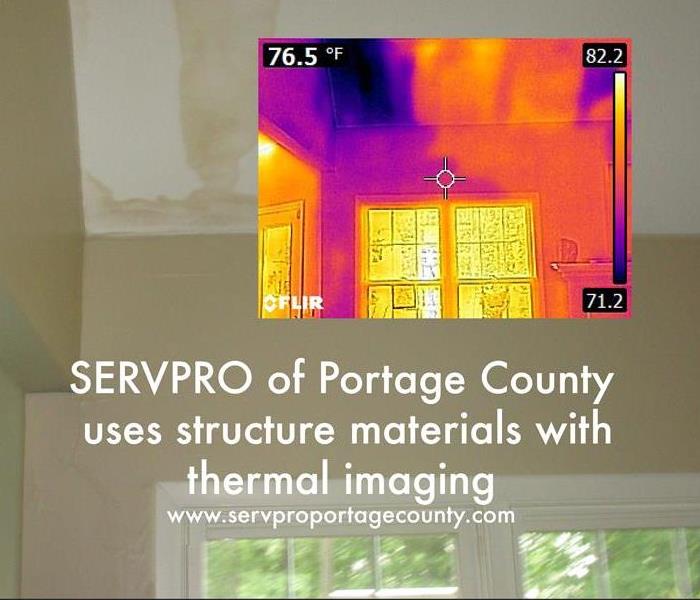 Thermal imaging one service at SERVPRO of Portage County and is used to utilizes water damage in your home.
Thermal imaging one service at SERVPRO of Portage County and is used to utilizes water damage in your home.
SERVPRO of Portage County uses structure materials with thermal imaging such as structure materials with thermal imaging and standard camera. Red, yellow orange indicated dry and blues and purples indicate elevated moisture.
Using thermal imagers to detect moisture intrusion is a relatively new practice in water damage mitigation. Thermal imaging has be used successfully to detect water intrusion in interior walls following roof leaks, foundation failure, chimney leaks, etc. It can find things that the naked eye doesn’t always see.SERVPRO of Portage County has this powerful equipment to help get your water damage taken care of.
There are a number of areas where moisture can accumulate that are frequently overlooked in typical inspections. Thermal imaging technology can help reduce the cost to repairs by minimizing damage to the property to find the core source of water intrusion.
Thermal imaging one service at SERVPRO of Portage County and is used to utilizes water damage in your home. Contact us today to schedule a site inspection(330) 677-4483
Can You Dry Hardwood Floors After A Water Damage in Portage County?
8/24/2019 (Permalink)
The amount of homes with hardwood floors is steadily increasing for many reasons, the most prominent being that hardwood floors not only tend to sell homes faster, but they also increase the price. The only downfall is that in the event of a flood or water overflow, hardwood floors cannot be easily taken out and dried like carpet can. This brings us to our question – "Can you dry hardwood floors in place, or does everything need to be ripped out and replaced?" SERVPRO of Portage County will help you answer that!
First, you need to recognize the many different factors that play into properly achieving a dry hardwood floor. Water damage can increase drastically if not taken care of properly, professionally, and in a timely manner. Here are some of the main considerations:
Response Time - Water damage can be greatly decreased depending on the response time to the problem. Time is of the essence when it comes to hardwood floor water damage – the moisture, temperature, and dust layer beneath a wet wood floor can provide an ideal environment for mold and many other problems.
Type of Wood Flooring - Before you can determine how to properly dry hardwood floor, you need to determine what type of wood flooring you have.
Amount Of Moisture - A flooded hardwood floor can have up to 40% moisture content and can retain well above the normal amount of moisture for weeks if left to dry on their own. Nails may begin to lift, glue may release causing separation between floor pieces, and tongue and groove floors often cup or buckle when moisture has been absorbed.
If you decide to attempt to dry and save hardwood floors in place SERVPRO of Portage County has specialized drying equipment that forces airflow beneath the surface of the floor, allowing moisture to be released.
A restoration specialist can inspect the hardwood floor damage to determine the right plan of action for your home. They will work with you and your insurance carrier to decide the best option, so give as a call (330) 677-4483.
SERVPRO of Portage County provides restoration, reconstruction and remodeling services
8/24/2019 (Permalink)
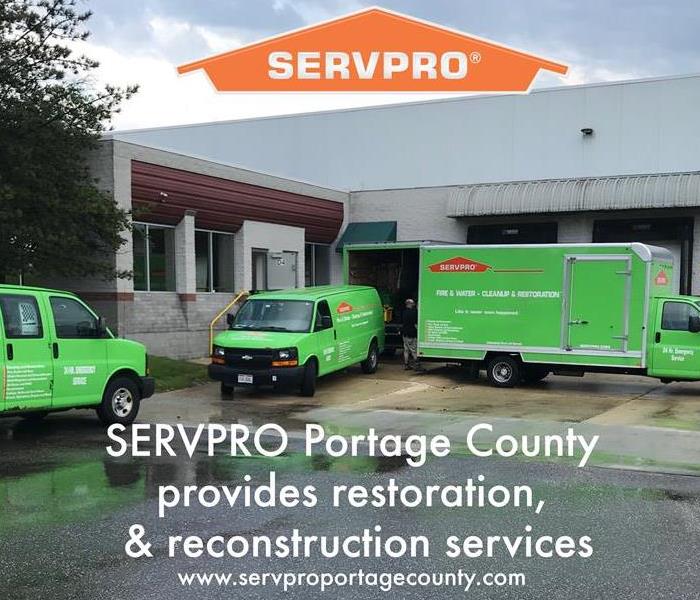 SERVPRO of Portage County provides restoration, reconstruction and remodeling services
SERVPRO of Portage County provides restoration, reconstruction and remodeling services
SERVPRO of Portage County provides restoration, reconstruction and remodeling services to residential and commercial facilities in the Portage County area. Our services include water damage restoration, fire damage restoration, mold remediation, storm damage restoration, repairs, and commercial project services.
Here are our top 5 reasons to call SERVPRO of Portage County(330) 677-4483 when you need restoration services.
#1 We’re Nearby
SERVPRO of Portage County is locally owned and grounded in Portage County. We are centrally located and always ready to respond to 24/7 to provide emergency services.
#2 We’re Faster to Any Size Disaster
A fast response lessens the damage, limits further damage, and reduces cost. SERVPRO of Portage County provides emergency cleaning and restoration services 24 hours a day, 7 days a week – including all holidays.
#3 Advanced Training
All of our technicians are highly trained in property damage restoration and they have access to our advanced equipment.
Training includes The Institute of Inspection Cleaning and Restoration Certification (IICRC), which sets the standard for the cleaning and restoration industries.
#4 Advanced Equipment and Techniques
By investing in the latest technology and equipment we can restore your home more quickly and minimize costs. We also use professional-strength cleaning, sanitizing, and deodorizing products to complete the job.
#5 Confidence
When the job is done our technician provides validation and documentation to your insurance carrier that your property is dry and the job is complete so you can feel confident, safe and comfortable.
There are many more reasons why you should choose SERVPRO Canton including that we have been in business for over 30 years, we are professional, we help save money, we professionally answer all questions and concerns, we help manage insurance paperwork, and more. Give us a call(330) 677-4483 today for all of your restoration needs.
Tips to Help Prevent Summer Claims in Portage County
8/15/2019 (Permalink)
 Accidents and emergencies do happen. If you find yourself in that situation, count on SERVPRO’s extremely well-trained professionals of Portage County
Accidents and emergencies do happen. If you find yourself in that situation, count on SERVPRO’s extremely well-trained professionals of Portage County
In a recent show of data, Farmers Insurance states that more than 50% of flood claims get filed during the summer between June and August. With travel being increased during summertime for families due to vacations and breaks, the weather sometimes causes unplanned and unexpected troubles.
Add a little preparation, forethought, and precaution in your household to allow you to take on some of the disasters summer can bring.
Follow these tips to help prevent summer claims:
- Caution Around Water on Roadways: Although you may FEEL safe driving through water, bear in mind merely six inches of water can reach the bottom of most cars. Flood waters can be dangerous due to depth, flow, and also the unseen debris and possible downed power lines. Losing control of putting yourself in harm’s way out of convenience could be detrimental.
- If in Doubt, Please Re-Route: Be wary of your surroundings and common driving routes. If you travel through underpasses, drainage canals, or similar spots, flash flooding can occur and you should plan alternative routes in case of an emergency.
- Store Valuables Safely: Anything of value such as documents, photos, electronics, or the like need placed on shelves or high enough off the ground should water penetrate your home. Water wreaks havoc enough as is without taking valuable possessions down with any soaking. More irreplaceable items may be better kept in a safety deposit box, safe, or other location.
Accidents and emergencies do happen. If you find yourself in that situation, count on SERVPRO’s extremely well-trained professionals of Portage County.
Local SERVPRO Portage County Receives Outstanding Performance Award
8/1/2019 (Permalink)
 SERVPRO of Portage County is proud to be recognized with such a great company.
SERVPRO of Portage County is proud to be recognized with such a great company.
SERVPRO of Portage County received the CHAIRMAN'S Gold award at SERVPRO’s recent 50th Annual Convention. This event was held from June 24-28 at the Sacramento Convention Center in Sacramento, California, where the company was founded. The theme for this year was “Making History."
“It is always gratifying to earn a distinction for our business,” said Bruce Johnson, SERVPRO of Northern Summit County Owner, “but it feels especially good this year. We are proud to be a member of the SERVPRO franchise family as the company celebrates 50 years of franchising success. SERVPRO’s ongoing commitment to providing innovative tools, ongoing training, and an ever-evolving business framework gives entrepreneurs like us a roadmap for success. We are proud to be part of SERVPRO’s team of dedicated disaster remediation professionals, and to know that we have both the tools and the knowledge to serve home and business owners in our community should the need arise.”
The company’s 50th Annual Convention was a celebration of the company’s history and a showcase of small business best practices and cutting-edge restoration and remediation technology. The event featured a variety of workshops and group sessions ranging across 37 different topics. Attendees gained knowledge and hands-on experience to help them build and grow their businesses and strengthen ties with both residents and businesses in their local communities. Highlights of the convention included a keynote address by motivational speaker Jon Gordon and an awards ceremony recognizing the achievements of top-performing franchisees.
“SERVPRO has come a long way since Ted and Doris Isaacson started the company as a painting business in Sacramento in 1967,” said Rick Isaacson, chief executive officer of SERVPRO. “In 1969, they used their cleanup and restoration background to take their new company in a different direction and never looked back. SERVPRO’s professional services network now includes more than 1,700 individually owned and operated franchises across the U.S. and Canada. Our annual convention brings this diverse group of entrepreneurs together to learn from industry experts and gives us an opportunity to recognize our top-performing franchises. We are incredibly proud of each of these dedicated professionals and the world-class service they provide to their customers and their communities.”
SERVPRO of Portage County is proud to be recognized with such a great company.
Be Prepared With Your Emergency Ready Profile (ERP) in Portage County
7/26/2019 (Permalink)
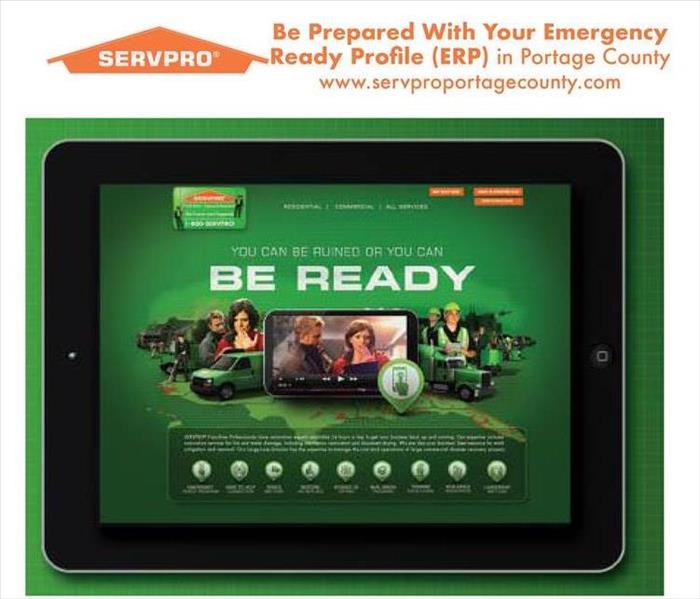 When disaster strikes, having this tool in place will allow you or any employee to effectively handle whatever arises.
When disaster strikes, having this tool in place will allow you or any employee to effectively handle whatever arises.
You may be asking, “What is an ERP?” An Emergency Readiness Plan or Emergency Ready Profile is a method of careful, well-practiced strategy of planning for emergencies before they happen to prevent panic during a catastrophe.
With SERVPRO's Emergency Ready Profile (ERP), you minimize business interruption by having an immediate plan of action at no cost in Portage County.
What should your ERP contain? Besides the essential information such as emergency and primary contacts, gas and water shut-off areas, and priority areas and procedures, the Department of Homeland Security refers to your ERP as “Protective Actions for Life Safety” which includes:
- Fire Drills -- Rehearsing the action to take during a fire.
- Shelter -- Sheltering staff during a natural disaster.
- Shelter in Place -- Sheltering staff during a man-made emergency.
- Lockdown -- Eluding and protecting against an active shooter
You will have peace of mind using SERVPRO’s Emergency Ready Profile. Plus, our mobile app Ready Plan allows for instant share and quick accessibility for assistance. Rest assured, your business is in good hands when you trust SERVPRO and our highly, well-trained professionals.
Emergencies do not wait for you, so do not wait to be prepared. With SERVPRO of Portage County in your pocket 24 hours a day, 7 days a week including holidays and weekends, we will get your commercial property taken care of. When disaster strikes, having this tool in place will allow you or any employee to effectively handle whatever arises.
Summer Home Maintenance Tips in Portage County
7/21/2019 (Permalink)
 SERVPRO of Portage County is available 24/7 including holidays and weekends to assist you and get your home back to “Like it never even happened.”
SERVPRO of Portage County is available 24/7 including holidays and weekends to assist you and get your home back to “Like it never even happened.”
Now that we are in the peak of summer, we all want to take trips, stay outside, and enjoy the nice weather. Here are some summer home maintenance tips to take care of before soaking up the sunshine:
Clean: A whole slew of pieces will need cleaned after the winter months. Eavestroughs, downspouts, gutters, furnace filters, dryer vents, lint traps, air conditioners, and siding could all use a little attention. Clear out any debris or build-up to prevent any damage, backing up, or safety issues. Keeping everything tidy will help reduce risk of disasters or costly fixes later.
Inspect: Chimneys, roofs, decks, patios, swing sets and other equipment, toilets and pipes, doors and windows, and electrical outlets and cords need a good once-over to check for any broken pieces or protruding parts. Finding damage and taking care of them right away will keep costs to a minimum and lessen the chance of any emergencies occurring.
Examine: The exterior of your home, landscaping, and exterior caulking should be looked over thoroughly to find any evidence of any deterioration or marring that may need touched up and repaired. You may see signs of rodents or wildlife that need addressed, also. Proper attention can keep the problem from persisting or worsening.
SERVPRO of Portage County is available 24/7 including holidays and weekends to assist you and get your home back to “Like it never even happened.”
Ways You Can Prevent Water Damage in Portage County
7/12/2019 (Permalink)
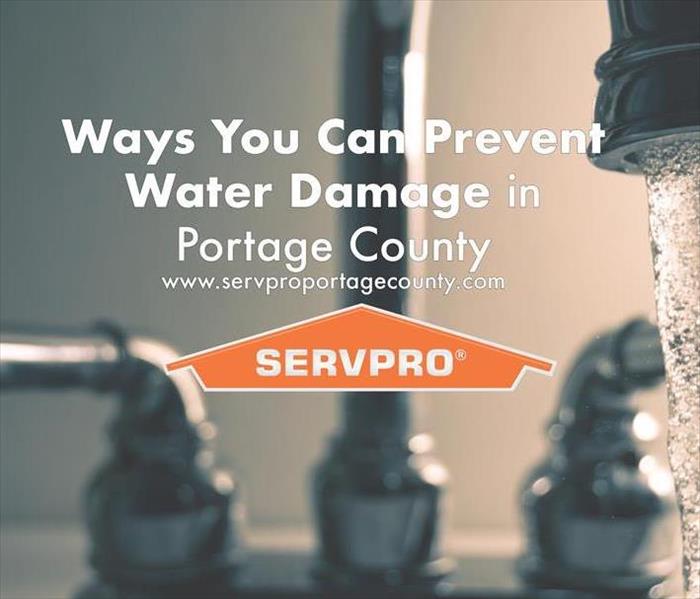 If you need help with any water damage clean-up, don’t hesitate to call our well-trained professionals at SERVPRO of Portage County.
If you need help with any water damage clean-up, don’t hesitate to call our well-trained professionals at SERVPRO of Portage County.
When you own a home, maintaining can seem tiresome. That maintenance is one of the best ways to prevent water damage. Consider it a way to avoid a more costly outcome as water damage ranks among the highest for cost.
What can be done to prevent water damage? Here’s a list to add for maintenance for a start:
- Proper Drainage: This step is vital. Poor drainage can lead to many issues such as cracks in your foundation, uneven settling, and allowing ways for water to seep into your home. Gutters and downspouts are included in this preventative measure. Clean them regularly to keep out leaves and other debris. Gutter guards can help if your gutters tend to clog easily and often.
- Inspections: The following areas should be inspected well and often; refrigerator, water heater, air conditioning unit, attic, hoses, faucets, sinks, showers, tubs, and toilets. All of these pieces may develop leaks or damage that needs to be taken care of before disaster strikes. Stay ahead of those by checking them to catch any danger before it starts or spreads.
- Installations: Some tools to install that may be beneficial are an emergency pressure release valve in plumbing system, water leak detection devices or alarms, a water flow monitoring system, and floor or drain pans. The latter helps with slow leaks while the others work as an extra set of eyes on your home in case of excess pressure, water flowing where it shouldn’t, and any leaks you may not have detected yet.
- Test, Check, and Fix: By testing your sump pump and checking your pipes, you will be on top of any leaks, cracks, or repairs that are necessary. If you get caught in a storm with your sump pump out of commission, you will be in a world of trouble. Fixing any issues right away avoids mold, mildew, dry rot, or any detrimental water damage problems.
These are just a few of the measures you can take to prevent water damage from occurring. If you need help with any water damage clean-up, don’t hesitate to call our well-trained professionals at SERVPRO of Portage County. We are available for assistance 24 hours per day, 7 days a week including holidays and weekends.
Top Fire Safety Tips for Portage County
7/7/2019 (Permalink)
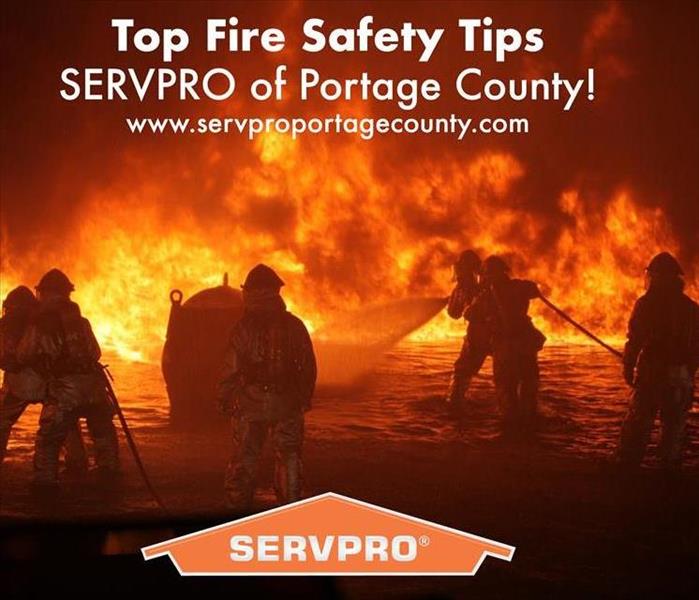 Accidents DO happen. If you find yourself needing emergency services, SERVPRO of Portage County is there to help you 24 hours, 7 days per week.
Accidents DO happen. If you find yourself needing emergency services, SERVPRO of Portage County is there to help you 24 hours, 7 days per week.
The National Interagency Fire Center have been confusing and somewhat contradictory as of late. While they said that spring 2019 wildfire activity should be normal, they also stated that late summer wildfire activity may be especially severe in some areas.
Forest Service claims that each year, the season for wildfires becomes longer, hotter, and, in turn, more expensive.
Do Your Due Diligence: Cooking remains top of the list for residential fires. Continue to be aware of your surroundings, and use caution when you prepare meals. Accidents happen, but safety measures can help prevent some accidents.
Another area on the rise is rental property structural fires. Vacation rentals using places like Airbnb are not held to the same standards as hotels and the like. Look for these safety precautions in the places you visit and stay as a traveler. And, renal owners, equipping your facility with fire-prevention tools and information is protection for both you and your guests that may be well-worth the investment.
Here are the top fire safety tips for you to follow:
- Keep the stovetop clear of anything that could catch fire (i.e. towels or curtains)
- Electrical outlets should remain free of adapters and multiple cords.
- Pathways around the home need to be clear to avoid tripping (including holiday decorations).
- A designated outdoor smoking area (when allowed) should be placed far enough away from the building with a specific, safe discard bin for butts (i.e. a deep, sturdy ashtray).
- Teach children 9-1-1 or local emergency number, how, and when to call from cell phones or outside telephones.
- Create a designated family meet-up place a safe distance from the home in case of an emergency.
- Doors and windows leading outside should have the ability to open.
- Identify escape routes from each room in the house, and routinely go through them, in the event of an emergency.
- Memorize the address of your home and any vacation rental you visit (each member of the family).
- Ensure vacation rental has printed and visible floor plan of property with escape routes, exits, and emergency contact information.
- Place carbon monoxide alarms in various locations throughout the home as required by law, codes, or standards such as every level of the home and outside each bedroom.
- Portable fire extinguishers should be easily found and reached in the home.
- Install smoke alarms on every level, in rooms, and outside bedrooms (look into requirements) and check them regularly; interconnecting them works best so when one sounds, they all sound.
Accidents DO happen. If you find yourself needing emergency services, SERVPRO of Portage County is there to help you 24 hours, 7 days per week. We even help on holidays because we know accidents aren't planned. Our well-trained professionals are here to make it “Like it never even happened.”
The History of Meth & Future of Decontamination
6/21/2019 (Permalink)
Methamphetamine is not a new drug, although it has become more powerful in recent years as techniques for its manufacture have evolved. The History of Meth According to DrugFreeWorld.org, Amphetamine was first made in 1887 in Germany and methamphetamine, more potent and easy to make, was developed in Japan in 1919. The crystalline powder was soluble in water, making it a perfect candidate for injection. In the 1930s, doctors began using amphetamines in the United States to treat asthma and narcolepsy. Methamphetamine went into wide use during World War II, when both sides used it to keep troops awake. High doses were given to Japanese Kamikaze pilots before their suicide missions. And after the war, methamphetamine abuse by injection reached epidemic proportions when supplies stored for military use became available to the Japanese public causing post-war Japan to experience the first meth epidemic. In the 1950s, methamphetamine was prescribed as a diet aid and to fight depression. Easily available, "pep pills" or "bennies" were sold as a nonmedical stimulant to college students, truck drivers and athletes and abuse of the drug spread. This pattern changed markedly in the 1960s with the introduction of home manufacturing of the drug, worsening the abuse. Then, in 1970, the U.S. government added methamphetamine to the Controlled Substances Act regulating the drug. After that, American motorcycle gangs controlled most of the production and distribution of the drug. During the 1980s, Mexican drug manufacturers began producing forms of the drug that could be smoked and towards the end of the decade, new ways to cook methamphetamine began to appear. In the 1990s, Mexican drug trafficking organizations set up large laboratories in California. While these massive labs are able to generate 50 pounds of the substance in a single weekend, smaller private labs were springing up in kitchens and apartments, earning the drug one of its names, “stove top.” Rural locations became ideal for cooking meth because of geographic isolation. Meth Today Today, most of our meth in North America comes out of Mexico or is produced in soda bottles known as the "Shake n' Bake" method. Most of the contaminated properties become contaminated through usage rather than from production. It is estimated that more than 2.1 million Americans are currently using methamphetamine. The problem is that users can contaminate anywhere from one to 50 properties per year, leading to an estimated 12 million properties contaminated in the U.S. and another 800,000 properties contaminated in Canada. Users move from house, to apartment, to hotel, to car, to new relationship, to the next motel, etc. Everywhere they go, they continue to use or smoke meth. Nothing inside this drug is natural. Most of the ingredients contain carcinogens and poisons leaving a dirty trail behind that enters into the cold air returns circulating throughout the property. Studies indicate that just smoking meth two to four times can contaminate a property above habitable standards. Meth residue is sticky and clings to surfaces and inside the ducting system until it is physically decontaminated and removed. The Decontamination Process Here's a quick outline of the process:
- Remove Porous Materials
- Dry Clean
- Wet Clean
- Rinse
- Test
Decontaminating a property starts with removing all porous materials including furniture, carpet, carpet pad, soft ducts, etc. Next, the furnace and duct work is cleaned using duct cleaning equipment to remove dust, dirt, and debris. Dust and dirt also needs to be vacuumed from the floor and surfaces throughout the property. Once everything has been dry cleaned, we bring up the heat and humidity in the home before applying a meth remover product. It is important to use a product that can remove the bio-film from the surface, making physical removal easier. The product can be applied with a ULV fogger, foamer (most recommended) or a paint sprayer. Once product is on the surfaces, scrub it into the surfaces and allow to remain moist up to four hours. This process is repeated two to three times depending on the amount of methamphetamine in the property. Lastly, we rinse. The meth remover product rinses easily with water. Once the surfaces are dry, the home is ready for testing. There are less than 1,000 remediation companies that actually advertise that they remediate methamphetamine and there are nearly 12 million contaminated properties in North America. This means our industry could easily add another 20,000 remediation companies that could complete 50 to 100 jobs a year. The best part about meth remediation is that there are no such things as meth emergencies. Meth remediation calls aren’t made in the middle of the night and the jobs can be scheduled. Contrast this with water damage work. The profit margins are good (35-55% depending on your efficiency). This problem is not going away.
Top Three Tips for Fire Safety in Portage County
6/18/2019 (Permalink)
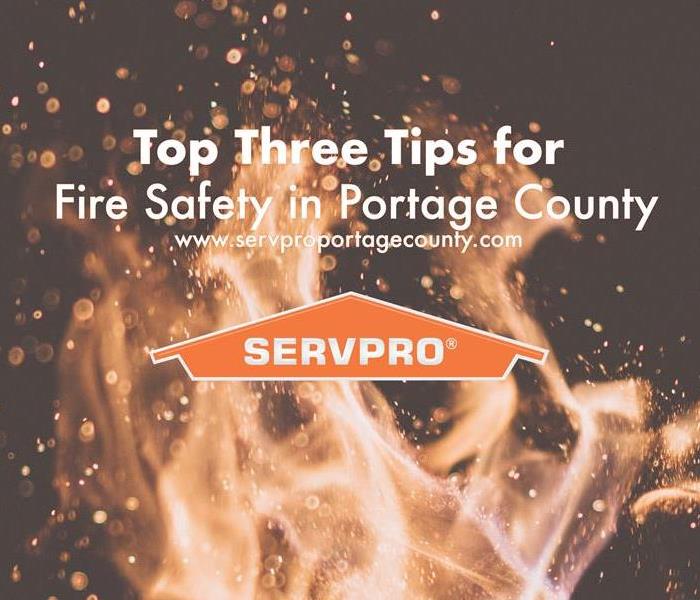 Our team of professionals will get your home or business back to normal in a timely manner.
Our team of professionals will get your home or business back to normal in a timely manner.
Fires escalate quickly, it is important to know before hand how to handle any fire that might happen in your home or business. Having an escape route practiced (committing it to muscle memory) and working smoke alarms can be literal life savers. What else can you do for fire safety in your home?
Here are our top three tips for fire safety that can keep you and your loved ones as protected as possible.
- Every level of your home should have a smoke alarm installed. Place them inside bedrooms and outside sleeping areas, including the basement, in living rooms and/or near stairways for optimal use.
- Test and maintain smoke alarms regularly. Each month, you should check that they are in proper working condition. If they need new batteries, change them right away. Smoke detectors are critical components to alerting you in time to get out before a fire spreads too much.
- Twice a year, you should practice your fire escape plan with your family. Feel free to talk and plan the route together more than twice a year. However, at least two times every year will ensure it stays fresh in your mind if ever you should need to implement the steps.
BONUS TIP: Remember to never go back inside for anything at all. If you experience a fire in your home, GET OUT, STAY OUT, and CALL FOR HELP.
For any fire damage repair or restoration needs, call SERVPRO of Portage County (330) 677-4483. Our team of professionals will get your home or business back to normal in a timely manner.
Swift Arrival to Any Disaster in Portage County
6/13/2019 (Permalink)
 SERVPRO of Portage County will take care of all of your emergencies!
SERVPRO of Portage County will take care of all of your emergencies!
Emergencies happen whether you are ready or not, count on SERVPRO of Portage County to help with professional emergency cleaning and restoration services 24 hours per day, 7 days per week, including holidays. Our promise is to return your property to “Like it never even happened.” Day or night, you can rest assured thatSERVPRO of Portage County will respond immediately to your call.
No Emergency Too Big or Too Small
Many cleaning and restoration situations call for immediate action. SERVPRO is strategically positioned to quickly reach any size emergency with over 1,700 U.S. and Canadian Franchise locations. A prompt response helps to reduce the damage and the costs for cleaning and restoration.
One particularly invasive disaster is water. It rapidly spreads throughout your property and absorbs into floors, walls, furniture, etc.SERVPRO of Portage County arrives swiftly and begins the water extraction method in an instant. Below, you’ll find a timeline for reference to show why reaching and treating as soon as possible is imperative.
Water Damage Timeline
Within Minutes
- Water rushes over your property, saturating everything in its path.
- Walls, floors, upholstery, and belongings absorb water.
- Furniture finishes may bleed and cause permanent stains on carpets.
- Photographs, books, and other paper goods swell and warp.
Hours 1 - 24:
- Drywall begins to expand and break down.
- Metal surfaces start to tarnish.
- Furniture bulges and cracks.
- Dyes and inks from cloth and paper goods spread and stain.
- Musty odors emerge.
48 Hours to 1 Week:
- Mold and mildew may grow and disperse.
- Doors, windows, and studs expand and warp.
- Metal proceeds to rust and corrode.
- Furniture distorts and shows signs of mold.
- Paint forms blisters.
- Wood flooring balloons and bends.
- Possibility of serious biohazard contamination.
More Than 1 Week:
- Time and cost increase exponentially for restoration; replacing contaminated materials and structural rebuilding may be considerable.
- Structural safety, mold growth, and biohazard pollutants present extreme risks to occupants.
SERVPRO of Portage County will take care of all of your emergencies!
About SERVPRO of Portage County
6/11/2019 (Permalink)
 We service the Northern Summit County area including Kent, Streetsboro, Ravenna, Brimfield, Garrettsville, Randolph, Mantua, and Aurora.
We service the Northern Summit County area including Kent, Streetsboro, Ravenna, Brimfield, Garrettsville, Randolph, Mantua, and Aurora.
SERVPRO of Portage County, including Kent and Ravenna, understands the stress and worry that comes with a fire or water damage, and the disruption it causes your life and home or business. Our goal is to help minimize the interruption to your life and quickly return your home or business to preloss condition "Like it never even happened."
SERVPRO of Portage County, including Mantua and Aurora specializes in the cleanup and restoration of residential and commercial property following fire, smoke, or water damage. SERVPRO of Portage County can also mitigate mold and mildew from your home or business in a flash.
Our staff is highly trained in property damage restoration. From initial and ongoing training at SERVPRO’s corporate training facility to regular IICRC-industry certification, rest assured our staff is equipped with the knowledge to restore your property. Our extensive training and opportunities beyond the required training only boosts our team players and the professionalism we bring to every job.
Beyond training, SERVPRO uses the best and most advanced technology and techniques to cleanup and restore the damage left in the wake of disasters. Each machine and product allows our well-trained restoration specialists to perform their duties in a quicker, more efficient manner. When you have already dealt with so much, the time it takes to cleanup and restore your home or business should not be another load to bear.
With a nationwide system of qualified franchises, no damage is too large or too small for SERVPRO of Portage County. SERVPRO supports you when your emergency hits. We know that can happen any time, anywhere, day or night. Call us for immediate assistance, available to you 24/7 including weekends and holidays.
We service the Northern Summit County area including Kent, Streetsboro, Ravenna, Brimfield, Garrettsville, Randolph, Mantua, and Aurora.
Serving you since 1967, SERVPRO is the cleaning and restoration brand you know and trust.
Highly Trained Restoration Specialists Guaranteed in Portage County
6/9/2019 (Permalink)
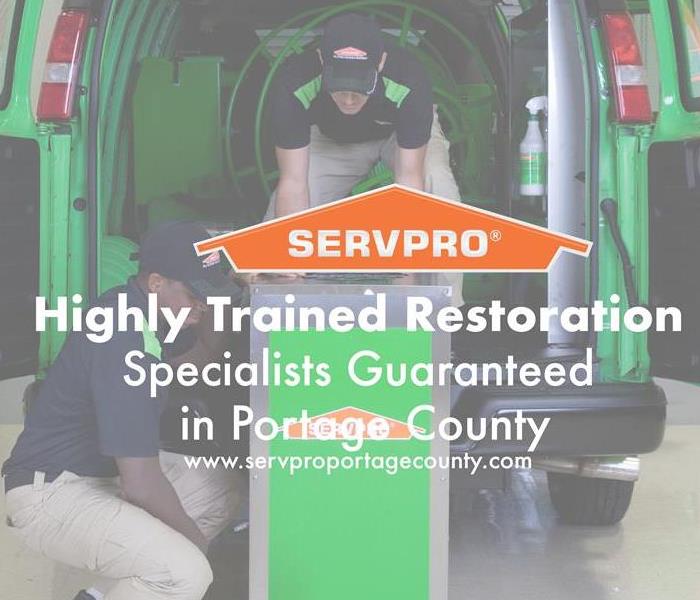 We at SERVPRO of Portage County take pride in restoration process on your home or business. We will provide a timely and professional experience.
We at SERVPRO of Portage County take pride in restoration process on your home or business. We will provide a timely and professional experience.
Emergencies you might experience, you will be in good hands with SERVPRO of Portage County. Our staff receives extensive training for property damage restoration. They will have your home or business back to it was before.SERVPRO takes pride in their restoration process on your home or business for a timely and professional experience.
What kind of training do they obtain?
Initial Franchise Training: In this 15-day hands-on course at theSERVPRO Corporate Training Facility, the foundation of the SERVPRO training program takes place. Primarily for new Franchise owners, this course covers many restoration topics:
- Fire Restoration
- Water Restoration
- Carpet & Upholstery Cleaning
- Mold Mitigation
Employee Certification Training
As a voluntary, self-paced program, this training is designed for SERVPRO Franchise employees. Following successful completion of course materials and an examination, a certification will be awarded. Modules include:
- Crew Training
- Fire Restoration
- Water Restoration
- Carpet & Upholstery Cleaning
IICRC Training and Certification
The Institute of Inspection Cleaning and Restoration Certification (IICRC) certifies and sets the standards for the cleaning and restoration industries. Our professionals must study IICRC standards and best practices in these areas:
- Water restoration
- Fire restoration
- Mold remediation
- Carpet and upholstery cleaning
- Other cleaning and restoration courses
Continuing Education Classes
SERVPRO of Portage County provides both credit and noncredit courses for insurance agents, insurance adjusters, real estate professionals, and Franchise staff. Intended to improve knowledge of emergency mitigation, these sessions include:
- Water Damage Restoration
- Fire Damage Restoration
- Understanding Mold in the Restoration Industry
- Restorative Drying for Loss Control
- Mitigation Awareness Response Seminar (non-credit course)
e-Learning
Access to web-based training is also available to all of our staff. While completely voluntary, this program is designed to be an ongoing, self-paced coaching series for a Franchise's employees. After video presentations and support materials, a knowledge test concludes each module. This additional information keeps our technicians and office staff updated on industry standards and the professional quality you deserve.
We at SERVPRO of Portage County take pride in restoration process on your home or business. We will provide a timely and professional experience.
Expect Advanced Technology and Techniques in Portage County
6/8/2019 (Permalink)
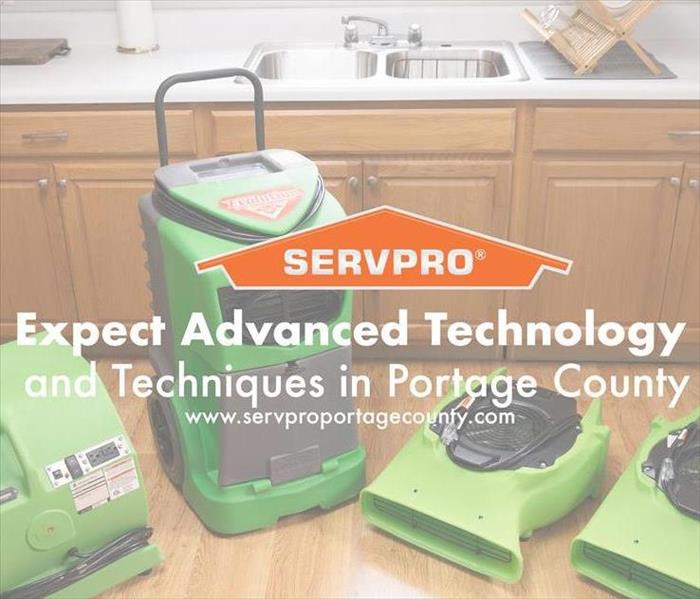 SERVPRO can restore your property swiftly, reliably, and more effectively to its preloss condition.
SERVPRO can restore your property swiftly, reliably, and more effectively to its preloss condition.
Expect Advanced Technology and Techniques in Portage County
At SERVPRO of Portage County we stay up-to-date and provide the most advanced technology and techniques for businesses and houses in Portage County With these advancements, SERVPRO can restore your property swiftly, reliably, and more effectively to its preloss condition. You can count on a timely turnaround whether using SERVPRO for business or home needs. Practical standards for cleaning and restoration are put in place by The Institute of Inspection Cleaning and Restoration Certification (IICRC); The IICRC S500 Water Damage Guide even incorporates the field of psychrometry into its specific set of practical standards.
Some of the equipment that helps SERVPRO adhere to the standards and stay true to the technological advancements are as follows:
Moisture Detection and Measurement
Specialized equipment detects, measures, and monitors a property’s moisture levels to fit certain scientific drying principles. Recent technology, like infrared cameras, helps us find water through a wall, ceiling, or floor.
- For thorough water removal, an infrared camera may be used to identify water location.
- To measure the extent of saturation, we use sensitive moisture detectors, hygrometers, and other meters.
Water Extraction
Powerful extraction equipment removes the majority of the water from your home or business which in turn accelerates the drying process.
- For continuous draining of high-level water, we use submersible and gas-powered pumps.
- For efficient water removal, we prefer truck-mounted and portable extraction units.
Drying
The remaining moisture from ceilings, walls, and floors of your home or business can be removed using industrial strength fans and dehumidifiers. Proper drying techniques help to avoid swelling and warping of floors, walls, and furniture.
- High-speed fans quickly evaporate excess moisture
- Industrial-grade dehumidifiers extract water vapor from the air.
Odor Removal
With water and fire damage, often powerful odors follow. Our advanced machines eliminate airborne contaminants and control the air quality during the restoration and cleanup procedure.
- Air scrubbers
- Thermal foggers and deodorization cleaners
Sanitizing Agents, Germicides, and Antimicrobial Treatments
To fully clean and remove odors and/or contaminants on your property, OSHA-approved cleaning agents may be required.
- Deodorization products control smells from an abundance of moisture.
- Disinfectants ends bacteria, fungi, mildew, and other harmful microorganisms growth.
SERVPRO of Portage County can restore your property swiftly, reliably, and more effectively to its preloss condition.
Top 5 HVAC Problems and Solutions for Portage County Ohio
6/6/2019 (Permalink)
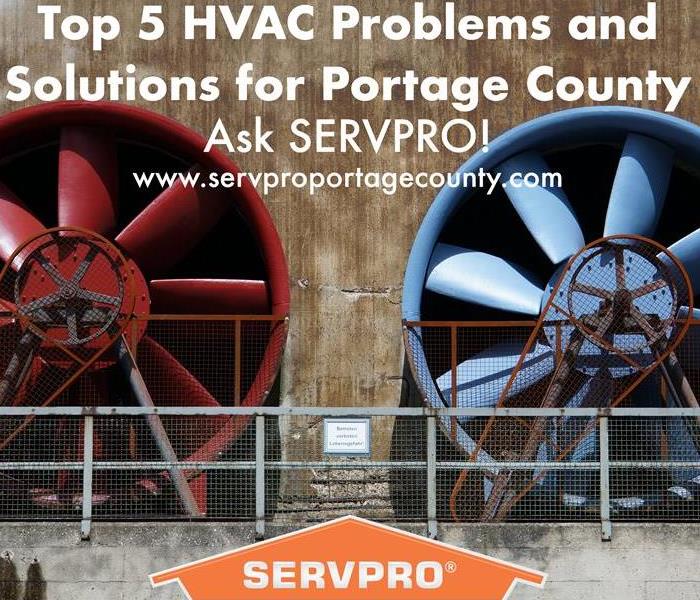 Regular maintenance is critical for the health of your HVAC system.
Regular maintenance is critical for the health of your HVAC system.
Your HVAC system houses many parts and pieces. When you need to troubleshoot an issue, that means finding the source can be difficult. With this common list, hopefully, you’ll have a bit of an easier time.
Here are the top 5 problems and solutions with an HVAC system:
Refrigerant:
Air conditioning and cooling not working properly? You may be looking at a refrigerant leak. Usually, this issue can be resolved by simply refilling or replacing the refrigerant liquid. Without refrigerant, you will likely end up with other issues as the condenser will be working overtime.
Filters:
If your air quality seems less than great, take a look at the filters. Not only will you reduce the dust, pollen, and other pollutants, but a clean filter helps your HVAC machine run more smoothly. Change the filters regularly to avoid future mechanical issues.
Thermostat:
If the unit becomes unresponsive or the temperature fluctuates, the problem may very well be the control pad itself; the thermostat. Restore your heating and cooling needs by trying a couple of routes. First, changing the batteries could be the ticket. You could also check to see if the breaker has been tripped. Otherwise, a replacement thermostat may be in order.
Drainage:
Another issue that causes more problems than just a part that needs changed is if a condensation pump goes out in your HVAC system. This piece results in a lack of proper drainage, so water pools in the unit. If located near your foundation, major water damage could occur. Your machine will be working hard to compensate for the broken pump until fixed.
Maintenance:
Regular maintenance is critical for the health of your HVAC system. If you maintain your system and check it regularly, you’re likely to keep any of the above problems from happening in the first place. Stay on top of keeping it running before any issues arise.
No need to sacrifice your comfort. Be aware of the above problems and solutions to remain as warm or cool as you want to in the event of an HVAC mishap. For any of your air duct and HVAC cleaning needs, call SERVPRO of Portage County at (330) 677-4483. We stand by our word, it’ll be “Like it never even happened.”
What To Do When A Flood Hits in Portage County, Ohio
5/23/2019 (Permalink)
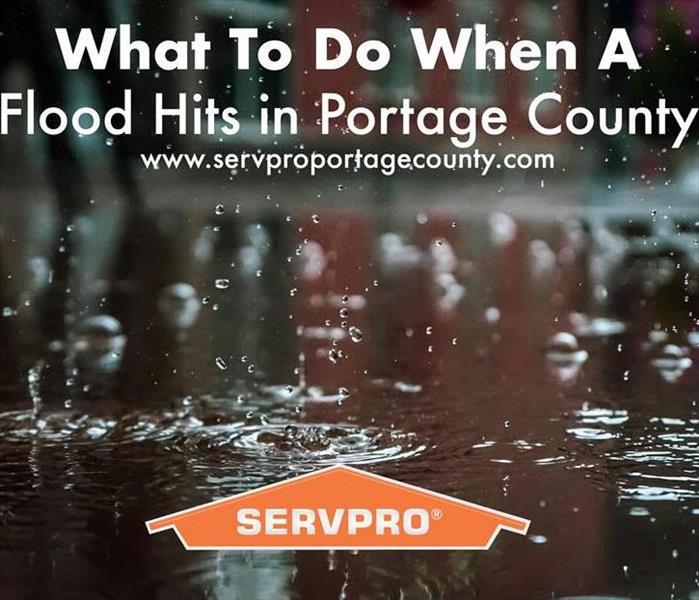 What To Do When A Flood Hits
What To Do When A Flood Hits
Flooding can happen anywhere and is a common natural disaster. The aftermath can cost a pretty penny. Whether floods hit suddenly or more slowly, they can be dangerous and leave a mess in their wake. Don’t underestimate the power of flood waters.
Keep yourself and others safe by following some guidelines of what to do when a flood hits:
- Due Diligence: Check to see if you’re in a flood-prone area. Your local floodplain administrator should be able to help you determine this. Here is a list from the Ohio Dept. of Natural Resources, Division of Soil and Water Resources of the floodplain administrators in Ohio. Installing check valves or having sump pumps installed when necessary will help prevent backing up into sewer traps and homes. Also, ensuring you have comprehensive insurance that covers flood damage is a good idea.
- Proper Preparation: Plan and practice an evacuation route. Having this, disaster supplies, and a communication idea in place will help tremendously in the event of a flood. Be ready to use a radio or TV to stay up to date on the latest information on the storm (status, emergency level, and evacuation readiness). If you have an upstairs and the time to do so, move items of value and possessions you can to higher-ground. Filling the tub, sinks, and vessels with clean water will be beneficial if contamination occurs. Turn off utilities if requested to do so by authorities. Most importantly, never attempt to go through flood waters on foot or vehicle. A split second and two feet is all it takes to be swept away; the waters may be deceiving, as well. Listen closely to the updates and follow any instructions given.
- Aftermath Measures: Depending on the severity of the flood, the county emergency management agency and local government handle everything to meet the immediate needs of the public. The main information you need to remember are merely to be aware of any gas leaks, check the foundation and inspect homes with flood-damage before entering, and any appliances and motors that may have gotten wet should NOT be used until they are appropriately cleaned and dried.
Your state or local emergency management agency can help answer any of your other flood or flood safety questions: the Ohio Department of Natural Resources, Division of Water Resources; the National Weather Service; or your local American Red Cross chapter.
Stay safe, and keep SERVPRO, Portage County, Ohio, (330) 650-4486, in mind for any water damage issues, clean-up, or restoration insurance needs you may have! SERVPRO, “Like it never even happened.”
How Well Does Cleaning Mold From Carpet Work? Ask SERVPRO of Portage Ohio
5/23/2019 (Permalink)
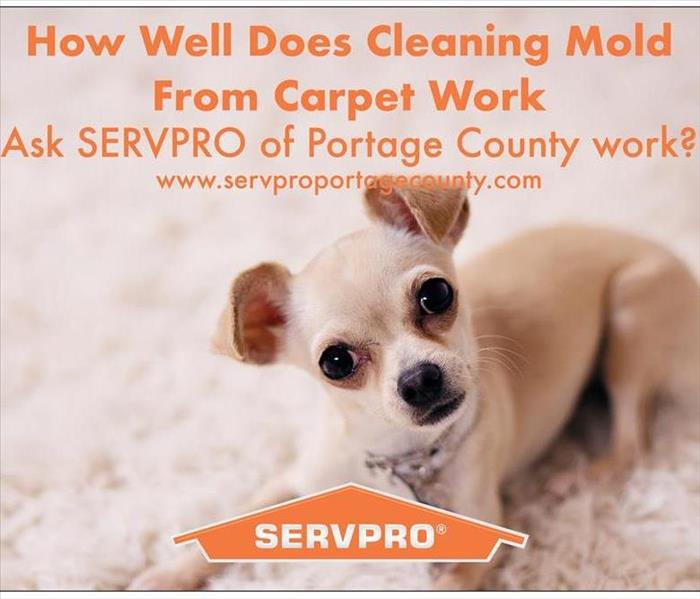 Does Cleaning Mold From Carpet Work?
Does Cleaning Mold From Carpet Work?
Carpets can get rid easily from water loss, or damage, sparks a bit of controversy. One factor to keep in mind is that unless mold is appropriately removed, the restoration contractor has failed in bringing the structure back to its preloss state. Without removing visible fungus colonies, a risk of sickness remains.
Let’s Set the Scene
Wonder Makers Environmental recently called their local Kalamazoo, MI SERVPRO, one of our sister franchises, to help in the cleanup of a building one of their clients own. Fungus had grown between their monthly checks, and at an impressive rate. A trail of clues led to the culprit: a malfunctioning water heater. Despite the checks, conditions suggested the water heater had been leaking for weeks. The question then becomes, how do you effectively restore the building, clean and dry the carpets, and remove the fungus that had grown exorbitantly? Getting rid of the fungus without the possibility of it spreading or returning, and not placing a health risk to anyone now or in the future due to the water damage is a job that SERVPRO takes seriously.
Delivering Results
Using a HEPA air scrubber, SERVPRO technicians were able to collect airborne spores that may be released by the hot water extraction process and to allow for air movement to speed up the drying of the carpet. After the workers completed their cleaning and restoration measures, Wonder Makers Environmental proceeded to run extensive testing on samples of carpet and air to determine the effectiveness of the remediation operation. The results were in: both air and surface samples were equally impressive. Spores per cubic feet were reduced from over 6,000 to less than 50. For more in-depth information, check out this article. Our work speaks for itself, even in a single case study.
As you can see, cleaning mold from carpet DOES work and can be quite effective if done properly and by professionals. Those of us at SERVPRO strive to help with any restorative actions you may seek. After experiencing water damage/loss, the last thing you need is to worry about the cleanup. Call SERVPRO of Portage County Ohio at (330) 677-4483. Our job is to make it “Like it never even happened”.
Deciding When to Demo, and When to Restore
4/26/2019 (Permalink)
To demolish, or not to demolish, that is the question. In a nod to William Shakespeare’s Hamlet and perhaps one of the most popular lines in English literature, we are constantly faced with this issue in our industry. The decision to demolish, either completely or selectively, versus repair/renovate is sometimes like running the gauntlet.
Whether the loss was caused by fire, flood, wind or other peril, the single most important factor to consider is safety.
If your client’s home or business has sustained structural damage, it is imperative a registered design engineer evaluate the structure to determine if it has been compromised and if can it be repaired. The local building authority is likely to have some input in this process. The stamped letter/documents from the engineer will need to be submitted to that authority.
A house or building found to be in very poor condition structurally speaking is usually better off demolished. It may be a cheaper and safer option. If the building can be repaired, now the question becomes should the building be repaired. Factors such as historical significance, cost, condition of the house, building code upgrades, etc. should all be reviewed. Insurance carriers will also have some influence in the decision. Depending on the language in the policy, carriers may have the right to consider replacement versus drying, cleaning or repair.
Demolition Considerations
- Is the property a historic property or in a historic district (aka heritage home)? Is it architecturally significant? There may be historic preservation ordinances and laws to protect historic resources and character. Many cities, towns and communities establish historic preservation commissions and a process for considering alterations or demolition.
- Investigate the permitting process early in the planning stage. If your client decides to demolish a building, even one that has suffered fire or storm damage, it does not automatically follow that you will get planning/zoning permission to build any replacement structure or to change the use of the site.
- Teardown restrictions can require structures to strictly adhere to the predominant architectural size and standards of the neighborhood.
- Demolition permits usually require site specific testing for contaminants such as lead and asbestos, prior to demolition. Building materials such as ceilings, ductwork, flooring, roofing and siding may contain these materials. Disposal of demolition debris that has asbestos-containing material (ACM) can be costly. Consideration should be given to the presence of coolant gases (freon/refrigerant), mercury (fluorescent lamps) and potentially radioactive materials (exit signs). Discovery of an old, underground oil storage tank can also be very costly.
- Utilities must be disconnected, including electricity, gas, cable/phone, sewer and water. Some cities/jurisdictions, such as Boston, may require you to disconnect utilities all the way to the property curb line or Right of Way (ROW).
- The cost to demolish and rebuild a home or business is highly variable.
- Newly constructed homes tend to be more energy efficient than renovated homes.
- Environmentally critical areas, such as wetlands or steep slope, have different restrictions.
- Local fire departments may require permits to be pulled and inspections/oversight by the fire marshall.
- If there is a mortgage on the property, your client must involve their bank in the process. The only legal way to tear down a house is to own it outright or to pay off any existing mortgage(s). If the loan balance is less than the value of the land, there could be an issue. Construction loans and/or insurance proceeds could be used to pay off the debt.
Repair/Renovation Considerations
- Renovation/repair is an alternative to demolition, but it may not be the most affordable option. Costs tend to accumulate the further you get into a renovation project and unforeseen problems discovered. Opening up walls, for example, can reveal pest/termite infestations, leaking pipes, mold, deteriorated framing, damaged wiring, cracked foundations, etc.
- Extensive water damage can undermine foundations and footings. This type of damage can be difficult to identify. A thorough inspection of the property should be completed prior to making the decision to repair/renovate.
- Older buildings/homes often have interior layouts that are difficult to rearrange for modern uses. An open floor plan with lots of natural light may not be so easily or cost effectively accomplished.
- Many homes and businesses were built when building codes were less strict than they are today. Rebuilding or restoring a structure may require meeting more demanding building codes. Even undamaged parts of the structure may be required to be brought up to current building code (plumbing, electrical, mechanical, life safety, ADA, energy, etc.).
- Depending on the extent of the damage, planning and zoning review may also apply to “repaired” buildings. For example, we recently experienced a building that was designated an R-2 usage classification when it was constructed in the 90’s. A partial fire loss caused the local building department and fire department to reevaluate the usage classification as it had changed since the original construction. Ultimately, the classification had to be changed which, in turn, triggered the application of more stringent building and life safety codes. The moral of the story is that, over time, the original approved usage classification of a facility can morph and change into something different despite good intentions from ownership.
- Substantial rehabilitation of historic structures or in a historic district may qualify for significant tax credits.
- In some communities, local government rules encourage substantial renovations over demolition by making it easier, faster and cheaper to obtain the necessary permits. You may be able to retain the foundation or add on to it. You might also be able to retain a portion of the existing structure or incorporate it in to your design thereby allowing you to sidestep local restrictions.
- Deconstruction – the careful removal of building materials to reuse them elsewhere – can provide financial and environmental benefits. Donations are tax deductible. Recycling building materials can be gratifying for environmentally conscious homeowners. The downside is that deconstruction can take two to three times longer than typical demolition.
- Renovations may require that a lead-safe licensed renovation contractor be engaged.
- Existing commercial buildings undergoing substantial renovations are eligible to become LEED certified under LEED for Commercial Interiors and/or LEED for Existing Buildings upon completion of the renovation and three months of occupancy/operation.
- Repairs/renovations can sometimes be completed in stages. Living expenses can add indirect costs to repair/renovation budgets. The homeowner may be able to live in the home while work is being completed.
No matter which route you choose, demand surges for labor, equipment and materials are not uncommon after natural disasters – hurricanes, tornadoes, earthquake, flooding, wildfires, etc. Do your homework and open a dialogue with the local building department, insurance carrier, contractors, vendors and suppliers. The key is proper planning before you pick up a hammer. Don’t go into a project blindly and hope to stay within budget.
Water Damage Requires a Quick Response
4/16/2019 (Permalink)
Floods, rainstorms and tornadoes can become massive water damage threats to businesses during the often-stormy spring and summer months. Facilities plagued with such water woes this season must take quick action.
Floods, rainstorms and tornadoes can become massive water damage threats to businesses during the often-stormy spring and summer months. Facilities plagued with such water woes this season must take quick action to control many possible problems, experts say.
You won’t see it emphasized on the nightly news when a disaster hits, but water damage can represent potentially huge disasters for businesses and building owners and operators.
Water damage can mean much more to a business than just wet and soggy carpets. There are other common, more significant problems businesses face when water wreaks havoc on property, such as indoor air quality problems. Mold and mildew grow rapidly in damp, humid environments, leaving behind an unpleasant smell that permeates floors, walls and ceilings, even after the water has been removed. It also can create health problems for employees.
Damage to the building’s structure and foundation also can be an issue. When water sits inside a building for a period of time, the walls, ceilings and floors absorb the water, which threatens the overall structural integrity of the building and creates an unsafe environment. Total reconstruction of the building often becomes the only option.
Another major threat to business is the loss of expensive equipment, which often can cost hundreds of thousands of dollars to replace.
To minimize water damage, there are two critical steps that need to be taken:
- Act fast to assess the situation; and
- Control the environment within the building.
Act Fast and Call an Expert
The absolute first step to take is fast action. Damage resulting from water and flooding is very progressive. The longer the water flows or wet conditions are allowed to exist, the greater the recovery problem becomes. A water damage consultant must come in immediately to survey the situation.
In a typical scenario, a team of water damage recovery professionals is dispatched to the site to perform a thorough inspection and fully determine the extent of the damage. A disaster reclamation partner also will develop an intense restoration plan and determine which items are worth restoring and which are better replaced.
You can’t always save everything by drying, but you can save a tremendous amount. It’s not unusual to save between 30 and 70 percent of the cost needed to reconstruct a facility.
Controlling the Interior Environment
Another key in limiting water damage is to quickly control three conditions of a building’s atmosphere: relative humidity, temperature and air circulation. Fast, effective action at this point will generally confine the damage to the area that was directly affected by the water damage event.
The most effective way to control these conditions in a high-moisture environment, especially a large facility, is to employ professional disaster drying that combines air movers with desiccant dehumidifiers.
Disaster drying often eliminates the need to rip out and replace walls, carpet, floor covering, hardwood floors and the building structure, which can be a huge expense. On top of that, you preclude the odors and staining caused by mold and mildew. These problems can come back to haunt you weeks later in a superficially dried building.
The Desiccant Way
When a facility has been severely water damaged, you need high volume desiccant dehumidifiers. Some larger desiccant dehumidifiers can pull 800 gallons of water out of a building in one day, compared to the typical small refrigeration units that remove about five gallons a day.
Many people are surprised that “solid” materials such as concrete and hard woods absorb moisture. But they do and rather quickly.
Getting the water back involves a phenomenon called migration. Migration is the tendency for water molecules to move toward a low vapor pressure. When a room is filled with very dry air, which has low vapor pressure, trapped water migrates outward and is evaporated from the surface by the dry air. As the air in the room fills with water vapor, we expel it. We then replace it with more dry air and the process continues.
It’s also essential to be sure the equipment being used is sized right. Inappropriately sized drying equipment can lead to insufficient drying and long-term problems with the building. Only large-volume dehumidifiers could provide the massive drying power needed to dry the space quickly and thoroughly.
Best Defense: A Disaster Recovery Plan
To minimize damage and costs, companies need to think ahead about what to do in a water damage event and contact a water damage expert to create a Disaster Recovery Plan (DRP).
A DRP can limit the extent of water damage occurrences by defining and prioritizing the recovery of areas within a facility and stating immediate next steps. Proper planning and fast action are most certainly the best defense to preventing a catastrophic water damage event.
Helping Property Owners Recover from a Fire-Damage Emergency
4/11/2019 (Permalink)
Dealing with a fire-damage emergency and the claims process is an emotionally trying time for a policyholder. A restoration professional must be sensitive to the personal and emotional aspects of a fire-damage situation. It’s imperative to recognize that a homeowner goes through five stages of grief: denial, anger, bargaining, depression and acceptance.
The professional must be prepared to respond appropriately to each situation. Insurance professionals need to prepare the homeowner for the restoration process, work closely with the restoration professional to ensure quality and timely work, and maintain a constant flow of communication throughout the process. A restoration professional must recognize that every loss is significant to the people impacted by it, and take the proper steps to restore the home to preloss condition.
Dealing With a Fire-Damage Emergency
A fire loss is often more severe than a water loss, and special attention to safety is imperative. The restoration professional needs to ask the property owner some simple questions to quickly evaluate the level of damage: “Is there any structural damage? Is there a lot of smoke?”
Air quality is the most important factor to evaluate. With any fire, carcinogens enter the air, and safeguards will need to be put in place to help ensure the safety of the air that the residents and workers breathe. All necessary PPE should be available for technicians, as well as the proper equipment to replace the bad air with fresh air as soon as possible.
If not already aware, the service professional should consider the ages and health of everyone in the home. Young children, the elderly and pregnant women might need to leave the property immediately, as they are often more susceptible to air-quality related health issues. If the client is not comfortable living in the home, the agent needs to assist in finding alternative accommodations for the residents.
Specifics to Consider When Scoping a Smoke and Soot Loss
There are several important steps to take when analyzing a fire-damage emergency:
- Evaluate how much heat was involved that resulted in damage to the structure, fixtures and contents. Look for a “heat line” on the wall, which often indicates possible damage to the structural integrity of the drywall materials.
- Where did the smoke/soot travel to? Did the smoke get into the HVAC system? Did the smoke travel into the attic areas, or force its way into the crawl space or basement?
- Consider pre-cleaning as an alternative process to save the metal and glass items in a home.
- Is there excessive smoke inside of the walls? This often requires removal of the drywall to get rid of the smoke/soot and accompanying odors.
- Determine which systems are available that will best deodorize the property and contents. These include professional cleaning and sanitizing; organic deodorizing systems; hydroxyls; and/or ozone.
- Determine the extent of the damage and the processes/procedures that will return the property, and the lives of those people involved, back to a “preloss” condition as quickly as possible.
- Respond as rapidly as possible to minimize the long-term effects of smoke and soot damage, and the many acids those materials contain.
Smoke and soot-related emergencies require specific mitigation strategies, depending on the materials affected: flat or glossy paint, finished and unfinished; laminates and solid wood items; particle-board materials; natural and man-made fibers in carpets and upholstered furniture. Porous, semi-porous and non-porous materials all require unique cleaning and deodorizing systems to most effectively deal with smoke/soot damage.
Wildfires often destroy thousands of acres of property and hundreds of homes. There is not much a mitigation company can do in those situations. However, there are often thousands of homes that are downwind from the fire that suffer smoke and soot damage, both on the exterior and the interior of homes. Smoke enters around doors and windows, through the ventilation system and even through the soffit vents into the attic areas.
Knowing how to deal with these materials quickly and professionally to neutralize and remove the compounds from the home, and to control and manage the odor damage are key aspects of a professional restoration/mitigation company.
Overall, the most important thing to understand about a fire damage emergency is that helping a client cope with the property loss is first priority. Communication along the way and hand-holding through the process is just as important, if not more, than the property owner receiving a check for the loss.
The restoration professional should be empathetic and emphasize that the damage will be taken care of, but never pass off the restoration process as a casual routine. The level of damage should be evaluated quickly and efficiently. It is critical to work with the insurance agent to educate the policyholder, ease their concerns, and manage their expectations.
Understand that each client will go through five steps of grief, and anticipate that anger will turn up one way or another. If the restoration professional expects this emotion to surface, they will be prepared to help the client cope and restore their sense of calm.
Back to Basics: 6 Steps to Handle Large-Loss Fire Restoration
4/2/2019 (Permalink)
Not only can a fire be devastating for the structure of a home or building, but it can also be emotionally devastating when it comes to the occupants of that structure, whether that is a family of four or a company of 400 workers. That's part of the reason why handling a large-loss fire doesn't just involve restoring the property to a preloss condition, but also being sensitive and understanding with the occupants of the affected home or business.
That's not to say that restoration professionals are counselors — they're not — but acting with empathy can go a long way toward making a fire loss a little less stressful for the individuals who are most impacted.
Here are six steps to follow to handle large-loss fires:
Getting the call: Whether this initial call comes from a homeowner or the insurance company, this first point of contact is an ideal time to gather as much information as possible about the fire. Where did it occur? How many rooms are affected? What type of fire was it? The goal of this initial point of contact is to gather information to get an idea of the scope of the project before arriving on site.
Arrive on site/inspection: After the initial phone call comes an on-site inspection. This is typically done after the fire department has doused the flames and secured the property. By this point, the restoration team should have a good idea of what type of fire occurred (i.e. protein fire, petroleum fire, etc.) and inspecting the property helps team members estimate the scope of work that will be involved, the timeline of the project and whether or not any demolition and reconstruction will be necessary. Depending on the severity of the fire, the restoration team may also board up the windows and doors to ensure structural stability.
Access occupant needs/packout: If it is possible, restoration professionals will likely ask the building occupants to gather any immediate needs. For a house fire, this may consist of undamaged clothes, school supplies, computers, etc. Everything else in the facility that has been affected by the fire will then likely be packed out and taken to an off-site location for contents restoration.
Estimate and begin work: After estimating the cost of the project and having the proper documents signed by all parties involved, then work can start on the fire loss. For a large fire loss, demolition and reconstruction of at least a portion of the property is likely necessary. Other areas of the property may just require soot and smoke damage restoration, where walls are HEPA (high-efficiency particulate air) vacuumed and washed, items are hand-cleaned and carpets are deep cleaned to remove soot residue. While restoration is occurring on site, it's also likely occurring off site in terms of the packed out contents (i.e. affected clothes, electronics, hard items, soft goods, etc.).
Frequent communication: Whether the project takes five days or five weeks, good restoration contractors will be in regular communication with both the insurance company and the homeowner or business owner. This constant communication helps keep all parties up to date on progress, as well as provides an outlet for questions to be asked and answered related to the project. Communication is often the differentiating factor between good and poor restoration contractors, as keeping in regular touch with relevant parties ensures transparency and provides a regular source of contact.
Final jobs/walk-through: After the crux of the project is complete, the last step is usually having the air ducts professionally cleaned and deodorized so soot doesn't contaminate — or cross contaminate — the facility. Following this, the occupant and insurance adjuster will likely take a final walk-through of the property to ensure the job has been done adequately and correctly. Any contents that went off site for cleaning will also be returned to the home and placed in their original location.
As you can see, a large-loss fire restoration job is a bit of a different challenge compared to a standard water damage restoration or mold remediation job. It's important your crew is trained to properly handle all the steps of every unique job.
Advanced Planning Ensures Experienced Partner Before Disaster Strikes
4/2/2019 (Permalink)
Thousands of commercial and industrial buildings each year are damaged by unforeseen disaster, ranging from fire or smoke and soot to water that infiltrates walls, floors, and equipment through events such as a burst water pipe, seepage, fire sprinkler flooding or leaks from a rainstorm.
Thousands of commercial and industrial buildings each year are damaged by unforeseen disaster, ranging from fire or smoke and soot to water that infiltrates walls, floors, and equipment through events such as a burst water pipe, seepage, fire sprinkler flooding or leaks from a rainstorm.
Wherever such an event occurs, the results can be operationally and financially disastrous. Potential risks include destruction of interior structural materials, equipment and files; disruption of operations; further damage from humidity; and, if water is not abated quickly, microbial damage -- the growth of mold, which is a potential health hazard.
When damage occurs, it is essential to take immediate action to stabilize the loss and mitigate damage. Doing so will maximize recovery of all contents such as inventory, machinery, furniture, carpeting, electronic media, documents and files, will minimize replacement costs, preserve good indoor air quality, and control mold risks.
Advance Planning
The best “insurance” in a recovery situation is to plan in advance of an occurrence by creating a Disaster Recovery Plan (DRP). The DRP defines and prioritizes the recovery and restoration of areas within a facility and details immediate next steps. It also designates the professional disaster restoration services provider to be summoned immediately when an incident occurs.
Pre-selecting a full service restoration provider that provides priority emergency services assures that building owners and managers will have a “partner” in the reclamation process. There will be no learning curve during an emergency because the firm already will be familiar with the structure and the plan. It then can move rapidly to begin recovery work within the first 24 hours – a critical parameter to minimize the effects of water.
Select a restoration provider that offers guaranteed priority emergency services. In the event of a fire, weather related or other water-damage disaster to a building or facility, owners or managers of properties registered in these programs will receive immediate priority for emergency drying and restoration services.
Expectations
Following is a list of services you should expect of the restoration company you contract:
- Consulting. The project scope should be provided at the front end. The firm quantifies the damage, determines what can be saved, recommends the equipment and process and expected results.
- Project Management. The company has the ability to quickly assemble a cohesive work team, provide rapid emergency response time, provide a turnkey operation for recovery and restoration and guaranteed results.
- Stabilization: The provider takes the necessary steps to stabilize the environment and assists with relocation efforts to an unaffected area or off-site, if necessary.
- Dehumidification and Drying. Through removal of standing water and excess moisture, the firm has the ability to reduce material loss, limit indoor air quality problems and speed return to occupancy and operation of the affected business.
- Cleaning and Disinfecting. By cleaning, sanitizing and disinfecting interior surfaces, the provider eliminates contamination from molds, bacteria, mildew and potential biological hazards.
- Odor Control: Thermo fog, wet spray, ozone or dry vapor methods should be properly employed to control odor.
- Electronic Equipment Restoration. In many cases, it is possible to clean and restore hi-tech components following exposure to fire or water damage.
- Preservation of Large-Scale Production Equipment. Contamination removal preserves production-operating equipment.
- Document and Media Restoration. Cleaning, sanitizing, deodorizing and drying restores paper records and electronic and digital media storage. This process is most effective if the firm dry cleans by vacuum and has refrigerated transport storage capabilities to minimize deterioration of materials.
- HVAC and Mechanical Systems Cleaning. Cleaning and deodorizing the supply and return duct system as well as the metal housing that encloses coils, heat exchangers and filter banks assures that clean air again passes through the system into the structure.
- Smoke and Water Decontamination. Residue from damage sources such as fire, flood and storms is removed.
- Corrosion Control. Metal surfaces are cleaned and treated to prevent further damage from corrosion.
- Controlled Demolition and Disposal. Surfaces that will not respond to restoration efforts in a cost-effective way are removed to expose hidden cavities and to expedite the recovery process or to remove sources of odor.
Selecting the Right Firm
It is important to have properly trained cleaning and restoration technicians overseeing your recovery project. A list of providers can be obtained from organizations like the Property Loss Research Bureau (PLRB). You also may want to do the obvious: review Web sites; read the case histories on the site; contact company representatives.
While it may sound as a cliché, the assessment process begins with reviewing experience, reputation and references. Plan to do more in-depth research before making a commitment.
Ask Annissa: How Do I Handle Sensitive Documents Damaged in a Fire Loss?
4/2/2019 (Permalink)
Personal papers like bills, canceled checks, credit card statements and everyday magazines have no value in the eyes of the insurance company and they often don’t want to pay for them to be cleaned or deodorized. However, they often have value to the homeowner.
The biggest problem with this is that paper can hold a lot of odor and may re-contaminate the house once everything is unpacked. So first off, we check with the homeowner and see if the paperwork is something that they can live without. Or is it really important and needs to be kept? Once you explain that the papers can hold a lot of odor and may cause recontamination of the house and belongings, this will sometimes make the homeowner more aggressive about putting them in the round file.
If the paperwork cannot be parted with and must go on the “keep it list,” then we dust them off and organize them into a large 11x14 inch spec bag. This is a heavy duty plastic bag that keeps the odor and contamination contained until the homeowner can photo copy or reprint the documents they want to keep. The cost to the insurance company to handle them this way is really no more than their cost would be to throw them away, so this keeps your adjuster and homeowner happy.
This also allows the homeowner to go through the papers at their convenience as they are dealing with a lot of pressing decisions in the first few days after a fire. Having one less pressing thing to have to handle right away can be a huge relief for them.
Mold Remediation: Dangers in the Ducts
4/1/2019 (Permalink)
Mold remediation is a serious subject, covered at large by professionals and institutions that specialize on the subject matter. While I'm not a mold expert, I do know air duct cleaning and how important it is to complete an HVAC Duct Cleaning after any mold, mildew, or fire restoration. The HVAC system of a building, residential or commercial, is designed to convey the dirty undesirable air from the living space and replace it with clean, heated or cooled, conditioned air that is pleasant to breathe and comfortable to building occupants. Depending on the building type and room use, many building codes call for the air in a room to be exchanged five to 15 times per hour. For HVAC that are clean and have adequate filtration, every exchange of air generally means the indoor air quality is improving. However, when mold, mildew, soot, allergens, and other contaminants are present, in the HVAC system, the IAQ is reduced with every air exchange. Proper source removal HVAC air duct cleaning, following any restoration project, will reduce the contaminants within the HVAC system and in some cases completely remove the chances of recontamination. It sometimes is overlooked that while a building itself is being remediated, the HVAC system is still in operation and therefore moving mold spores, smoke particles, and other contaminants throughout the return and supply air duct, as well as other HVAC system components. Because the HVAC system is redistributing the air throughout the building, a small about of dirty/contaminated air has the potential to recreate the need for an entire restoration project in as little as a few days. Source removal, the practice of cleaning by removing contaminants the HVAC system, is the method prescribed within the NADCA (National Air Duct Cleaners Assocaiton) Standard, ACR-2013. Source removal can be achieved in a variety of ways, but is most often achieved by using a negative air vacuum/collector, rotating duct brushes, and compressed air whips/skippers to loosen debris from the duct walls allowing the airflow from the vacuum/collector to evacuate it from the HVAC system. The methods for a proper professional HVAC Air Duct Cleaning have been continually developed and refined for 30 years by working professionals engaged with NADCA and other IAQ associations.
After the Disaster: Providing Restoration Solutions, Not Suggestions
4/1/2019 (Permalink)
Hurricanes. Tornadoes. Flooding. Frozen pipes. Storms.
All of these will occur during the course of a year. All will cause major damage to dwellings and buildings. What is one of the major sources of damage- WATER. Water damage is caused by a variety of things including plumbing leaks, burst pipes and broken hoses, moisture ingress within a structure, clogged toilets, foundation cracks and leaking roofs. While the symptoms will be addressed by plumbers, roofers, foundation specialists and other tradesmen and tradeswomen, clean-up and remediation specialists have some of the toughest and potentially dangerous jobs to tackle to ensure a safe and functional dwelling or building. Before a building is considered safe, someone must disinfect affected areas, remove damaged or mold/mildew- contaminated items, properly dispose of the water-damaged items and then review and inspect areas to ensure that they’re safe.
So, what can we recommend to residents and occupants of the buildings that have significant (or even small levels of) water damage?
- Stop the flow of water.
- Turn off the power.
- Assess the conditions. Is it safe to stay in the building?
- Look for electrical hazards and “slip and fall” areas. Stay away from compromised areas.
- Get away if possible, but if you must stay, then only do activities that are absolutely necessary.
- Try not to lift wet materials. Water will add significant weight to any material that absorbs.
What can you recommend an owner do after flooding?
- Gather items from floors and low lying areas.
- Remove any excess water by mopping or blotting up the water with towels or absorbent material.
- Remove wet rugs and carpeting that can easily be removed.
- Remove any wet upholstery, cushions, pillows, blankets and dry them out
- Wipe excess water from furniture, cabinets, accessories
- Turn AC ON for maximum drying during the summer
What should you recommend an owner NOT do after flooding?
- Don’t use household appliances, televisions or any other electronic devices
- Don’t leave wet fabrics in place. Hang luxury items such as leather goods, furs and dresses.
- Do not use a vacuum cleaner (unless it’s a wet-dry vac) to remove moist or water from a room.
- Don’t leave colored items on a wet floor.
- Don’t turn on ceiling fans or lights if the ceiling is wet.
- Stay out of rooms where the ceiling is sagging.
After a homeowner or building occupant has taken the requisite steps to ensure his/her safety, then its time for the professional to come in and do their work. Professionals will use the following steps to assess and restore property following water damage:
- Initial contact and pre-inspection survey
- Inspection and water damage assessment
- Water removal and extraction
- Drying and dehumidification
- Cleaning and sanitizing
- Restoration
A fast response is crucial to prevent long term damage, sick-building syndrome and irreversible damage. While professionals are responsible and knowledgeable, sometimes little things that might be missed become critical to the successful remediation/restoration after water damage or flooding.
- Mold and Mildew are the ENEMIES. Protect yourself and building inhabitants by using the proper protective gear including body suits, gloves and masks or respirators. Contain the mold/mildew before trying to disinfect. Wrap your booties, pants and gloves with tape to ensure a good and proper seal of your body suit.
- Use environmentally-friendly antimicrobial and antibacterial treatments when you can. These will leave less of an impact to the inhabitants once the job is complete.
- Properly dispose of refuse. Bag the molded, damaged and soiled items in a thick plastic bag and twist the opening to form a goose-neck then seal the opening tightly with duct tape to ensure that the contents are secure and will not escape during transport to the landfill, preventing further contamination.
- Seal off the contaminated environment from the area that is not contaminated or is being used by the building inhabitants. Hang poly-sheeting, build airflow containment units and properly seal them off with strong polyethylene or cloth duct tape suitable for use in damp, moist environments. Innovative containment systems with pre-inserted zippers and doors are now available for ease of use.
Customers are now used to fast, reliable and almost instantaneous service. The e-commerce model used to obtain goods is now being applied to service as well. By offering easy “one-stop” access to water damage cleanup; easy contact, assessment, water removal, drying, cleaning, sanitizing and restoration; you will enhance your relationship with your customers and attract them to your business. Remember these tips when communicating potential water leakage and flooding issues with your customers and you will become their one-stop source providing solutions, not suggestions.
Giving Back
2/26/2019 (Permalink)
At SERVPRO we feel that it is important to give back to the community so we’ve partnered with our local insurance agents to support local domestic violence shelters. Every 9 seconds in the U.S. a women is assaulted or beaten. Domestic violence is the leading cause of injury to women- more than car accidents, muggings and rapes combined. 92% of women surveyed list reducing domestic violence and sexual assault as their top concern. In December of 2018 women in our industry came together to provide Christmas gifts to over 140 women in local shelters. The outpouring of support was staggering! We plan to continue the supporting domestic violence shelters by providing volunteer opportunities and continued donations. In May we plan to give jewelry and scarves to the shelters so the children can give them a moms a Mother’s Day gift. To all the generous women who have helped provide gifts for our local domestic violence shelters a special Thank You for your kindness and caring. We will continue to keep everyone updated on this cause which is very near and dear to all our hearts. Thank you!
Backup or Overflow?
2/26/2019 (Permalink)
What is the difference between a water backup and an overflow? Overflow is caused by a blockage in the plumbing system. Water causing damage never enters the sewer system and in some cases, water damage can be considered an overflow if blockage is in the lateral pipe. It all depends on insurance policy language. A backup is a situation where water or sewage enters through drains or sewers or overflows from a sump pump, sump pump well or any other system designed to remove subsurface water which is drained from a foundation area. A water backup is excluded in most Homeowners policies but coverage can be added with an endorsement. Coverage is usually limited to a specified amount but a few insurance companies offer more extensive options. Water backup coverage is critical for not only homeowners but condo owners, renters and commercial insureds as well.
Keep in mind that any property can experience a backup and the damage can be expensive especially if the area is finished. There are four main areas to consider when deciding how much coverage you need including mitigation or drying out the area, structure reconstruction, contents damage and mechanicals such as furnace and water heater. Be sure to discuss the right coverage option with your insurance agent so you are well protected in the event of a backup event.
Ordinance or Law Coverage- Every Building Should Have Coverage
2/19/2019 (Permalink)
Ordinance Or Law Coverage allows for payment of losses arising out of the enforcement of building laws or ordinances, including those that may require the demolition of damaged structures that increase the cost of repairing or rebuilding the damaged property. According to Adjusters International Disaster Recovery Consulting, compliance with ordinances and laws after a loss can add 50% or more to the cost of the claim.
Building codes or ordinances set minimum standards that must be met when structures are built or reconstructed. Their purpose is to protect the health and safety of building occupants. Building codes may be enacted and enforced by state and/or local governments. Building codes are primarily directed at new construction. Yet, they may also apply when existing structures are renovated, altered, reconstructed or used in a different way.
Some codes may require a building that is only partially damaged to be demolished and reconstructed rather than repaired. A building may require demolition and reconstruction if the damaged portion is worth 50% or more of the building's value. Codes can affect the size, design, height, usage and location of a structure. They may also determine the building materials that may be used.
Building codes change frequently. Codes that existed when a structure was built may be outdated when a loss occurs. To meet current codes, a damaged building undergoing repair may require expensive materials. Some structures may need to be reconfigured. Thus, building codes can significantly increase the cost of the repairs or renovations.
Homeowners policies often include a standard amount of ordinance or law coverage which is 10% of the dwelling coverage or coverage A. This may be enough for newer or updated homes but careful review of possible building code issues should be made in order to determine if more coverage makes sense. In commercial insurance, ordinance or law coverage is not typically included and can be added with an endorsement. It is important to take a comprehensive look at the building and potential ordinance or law costs that may be incurred in order to determine how much coverage should be added.
Consult your insurance agent for more information so you won’t get burned if you have a disaster.
Storms and Little Warning
2/5/2019 (Permalink)
Storms occur with little warning and can be especially devastating, so you’ll need the company that you can trust to rise to the occasion. Regardless of the type of storm, SERVPRO of Portage County can handle any size disaster.
When severe weather breaks, storm water builds up on streets, near lakes, rivers, and local storm control channels. Should storm water begin to accumulate around your house, here are a few easy steps that may help protect your home:
- Make sure all windows are closed tightly – especially check windows in your basement area
- Move valuables to higher ground
- Continuously monitor the sump pump (if you have one) to verify that it is operating properly
- Make sure to secure any outside furniture or decorations that can become airborne with high winds
- Cover basement window wells to help divert water from pooling inside the well
- Make sure to pick items off the floor that may get damaged from water exposure
- Keep your shoes, car keys, and family emergency kit near the door
Safety should always be your main focus when faced with storm water.
- Do not walk through moving water, as even 6’ of water is enough force to knock you off your feet
- Stay away for flood waters as it is contaminated and unhealthy and may pose health hazards
- People or vehicles in flooded areas can hamper Emergency Responders ability for quick response
Storm and flood water damage can be very destructive. Immediate action is needed, and you need the company with storm damage experience. SERVPRO of Portage County has the expertise and the resources to handle any size disaster. If you need assistance with storm or flooding call 1-800-648-1212.
Sump Pumps
1/30/2019 (Permalink)
Looking at the weather predictions for the week, today is a great day to check your sump pump to verify it is working properly.
When to check your sump pump? How To Test Your Sump Pump?
When to replace it?
When to check it? Sump pumps remove water pressure from homes during times of excessive snowmelt or rainfall. To ensure that your sump pump will work properly when it’s needed, you should check it periodically. It is a habit in my house to check it before, and sometimes during, an extreme weather event.
When to replace it? Did you know that generally sump pump manufacturer warranty their sump pumps for 1 year, 3 year or 5 years. When is the last time you replaced your sump pump? Depending on how much your sump pump runs – you should consider these warranties a good indicator of replacement time. Just because it is still running, doesn’t mean it is functioning at full capacity.
How to test your sump pump? The following tips will help prevent sump pump malfunction:
- Debris in the Basin: Sometimes debris such as children’s toys and other household objects may fall into the basin and interrupt the float mechanism which can cause it to malfunction. The float mechanism can also fail naturally over time. To test this mechanism, fill up the basin with water to make sure the sump pump starts like it should.
- Check Valve: The check valve prevents water from going back into the sump pump in the event of a failure. Make sure to check this valve because it is not always installed properly; the arrow should be pointing away from the sump pump.
- Weep Hole: Sometimes sump pumps may have a weep hole between the pump and the check valve. You can clean the weep hole with a tiny object such as a toothpick, just be careful not to break anything off in the hole.
- Clean the Impeller: The impeller is a small filter that may become clogged and when this happens it can cause the sump pump to suddenly stop running or make a whining noise. Cleaning or replacing the impeller can get the sump pump to function properly again.
- Back Up Power Source: Sump pumps are only useful when plugged into a power source and if the power goes out during a thunderstorm, the sump pump will stop working. Installing a backup power source for the sump pump is the best way to prevent this from happening in the middle of a thunderstorm when the sump pump is needed the most.
NEVER...walk away from your stove
1/3/2019 (Permalink)
Sporting Events and Television!
It happens, especially during sporting events…… you can hear the roar of excitement from the other room, and you know you are missing the big play of the game. So you leave the stove, just for a quick peek. Only it’s just never as quick as you anticipate. Meanwhile back in the kitchen….grease fire has erupted. It can happen so quickly, the cooking oil gets over heated and out of control.
Good Rule: never leave the stove or turn your back for any period of time.
Think fast!
1) Evaluate – call 911 if it is out of control while gathering family and get to safety
2) Put a metal lid on it
3) Turn off the heat
4) Dump baking soda
5) Chemical fire extinguisher is best as a last resort or if the above options are not available
6) Stop. Let the area sit, cool down, before you address the damage.
NO, NO, NO
1) Do not throw water
2) Do not use a hand towel
We hope you never need to remember these tips. But your SERVPRO Team is here to help with the clean up should disaster strike. The photos are from a kitchen grease fire; just a second of “unattended”. The good news is the final repairs are beautiful; "Like it never even happened." No family members, or pets were injured in the event. Just frayed nerves and a bit of quilt. (Accidents happen and we should learn from them and move forward.)
Quick thinking allowed the structure damage to be contained to the kitchen. However soot and smoke damage occurred throughout the residence.
We are here to help 800-648-1212
Timing is Everything
12/27/2018 (Permalink)
Water damage requires a quick response by stopping the source of water intrusion as soon as possible. Knowing where your water shut off value is located in your residence, and reviewing the location with your immediate family and service professionals (housekeeper, babysitter, dog walker, house sitter, ect) is critical. Prompt response to stopping the water intrusion and clean up and dry out can greatly reduce overall restoration costs. Before water mitigation can begin, the source of the water intrusion will need to be addressed.
Initial steps to assess the damage and evaluate the level of contamination will help to formulate an action plan and determine if professional assistance is needed to help restore your home.
Professional water mitigation should be highly considered when:
- Water originated from a contaminated source: dishwasher, water bed, drain line, toilet, washing machine, flood water, etc. When addressing contaminated materials protecting the home from cross contamination, mold and securing the environment for the occupants becomes a primary focus for the emergency services.
- Porous materials affected by water: hardwood flooring, cabinetry, carpet and padding, drywall, etc. An immediate response to with water extraction and application of a biocide can help reduce the amount of structural material damage and reduce the amount of time the home or affected area is out of use.
- Water traveled from one floor to the floor or floors(s) below. It’s not the obvious water that causes damage, you can easily mop up that. When water and bacteria is trapped between layers of structural materials, this “hidden moisture” can cause long term damage and possible mold growth.
SERVPRO’s professional mitigation team is IICRC Certified, trained, and expertise knowledge to help you evaluate the extent of damage, and create an action plan for cost effective dry out of the affected area(s).
Remember, quick response time can reduce the overall mitigation costs and loss of use. Contact our office to schedule a site inspection and scope of damages for your home today.
Mold Stain Remover
12/3/2018 (Permalink)
Mold stain removal can be challenging, even after you have removed the mold itself. Unfinished areas of the home such as the basement and attic are often susceptible to mold stains, as these areas are not typically seen and the longer the mold lives, the longer the stains can penetrate the surface of the material. Wood decks and concrete are also susceptible to mold stains because they have porous surfaces that allow the mold stains to penetrate deep, making them harder to clean. Not all mold stains can be removed, but there are some steps you can take to reduce or eliminate staining.
What Causes Mold Stains?
To understand mold stains, it helps to understand the structure of mold. Mold is a fungus that grows in multi-cellular filaments called hyphae. These hyphae produce pigment, or color. Mold colors can range from white or gray to green, red, brown or black, and the darker the color, the more pigment it produces.
As these mold hyphae grow into the material of your home, be it wood, drywall, fabric or others, the pigment can transfer to that material. So, even if you kill or remove the mold, the pigment is left behind.
Are Mold Stains Dangerous?
Unlike the mold itself, any stains left behind after you have removed the mold are harmless. However, mold stains are an aesthetic problem and removing the mold stains is important for property value and improving the appearance of your home.
While you may choose to ignore mold stains in an unobtrusive area of your home like the basement or attic, you should never ignore the growth of mold. Mold can grow on most surfaces in your home including tile grout, wood, carpet, drywall/sheetrock, ceiling tile, painted surfaces, fabric and paper. Unchecked mold growth can cause damage by eroding the structural integrity of beams, trusses, walls, ceilings, floors and more.
In addition, mold growth is a sign that you have a water problem that needs to be addressed immediately. You must identify the source of the water, whether it is a leaky pipe, humid bathroom, broken appliance, septic tank backup or storm water infiltration, and perform the necessary repairs.
Mold growth is also dangerous because it is a known health hazard. Mold acts as an allergen, and if you breathe in mold spores you may experience sneezing, nasal and sinus congestion, asthma symptoms, itchy eyes and more. Over time, your symptoms may get worse or you may experience fungal infections or chronic rhinitis or asthma. Mold can cause more serious, long-term health problems in young children, the elderly and people with other health conditions or compromised immune systems.
Mold Stain Removal Guidelines
Mold stain removal depends upon the material where the staining has occurred. You can try using soap, vinegar and household cleaners to remove stains. For difficult to remove mold stains, we recommend Concrobian Mold Stain Eraser. It is bleach-free, so it won’t damage surfaces. It is safe to use on wood, stone, fiberglass, plastic, laminate, metal, aluminum and concrete.
Grout: Mold growth in grouts cannot be satisfactorily removed because it grows into the grout. If you try to clean it, it will quickly grow back. The grout has to be dugout and replaced with new grout.
Wood: Mold stain removal on wood such as flooring, decks, fences or wood trim may require a trip to the hardware store. But first, try cleaning with ingredients you probably have in your kitchen. To clean surface wood stains, mix vinegar, mild dish soap, and water. Dip a rag in the vinegar mixture and wipe the wood. Wipe again with another damp rag, and dry thoroughly. If the mold grows back in a week or two, that means it has penetrated the surface.
If the mold has penetrated the surface of the wood, you will need to sand it to remove it all. Sanding can be dangerous because it will release mold spores. Always wear an N-95 face mask when sanding moldy wood, and only sand wood that is located outdoors. Using #100-grit sandpaper, sand the wood in a circular motion wherever you see mold. Then follow up with #220-grit sandpaper. Use a HEPA-vacuum to clean up the dust after sanding. Now you can repaint or re-stain the wood. If you are unable to completely remove the mold because it has penetrated too deeply, you should replace the wood.
If the wood is located indoors, it is not safe to sand it yourself. The risk of inhaling or spreading mold spores is too great. For small amounts of mold on wood inside, clean as much as possible by scrubbing with a cleaner, allow the surface to dry, and then encapsulate any remaining mold with a commercial mold sealant, like Foster 40-50. If the mold covers more than 10 square feet, the U.S. Environmental Protection Agency (EPA) recommends hiring a professional removal company.
Walls and Ceilings: Walls and ceilings are usually porous, so if the mold has penetrated the material, it will need to be replaced. To clean surface mold from painted walls and ceilings, use a mold cleaner. Spray the affected area and scrub with a soft brush or rag to remove the mold. If staining still shows then the mold has penetrated the surface, and the material should be replaced.
Make sure that all of the mold has been removed before repainting. Otherwise, the mold will continue to grow and return.
Masonry Surfaces: Unpainted masonry surfaces, such as walls and ceilings, constructed of unpainted concrete cinder blocks, poured concrete, cement boards, clay blocks, ceramic tiles, plaster, marble, and granite, do not support mold growth. However, white salt deposits that migrate to the surface can have elevated levels of mold and bacteria. Also, if the masonry surface was painted, mold can grow on the paint. Remove the mold by spraying the surface with water, then use a wire brush or scraper to remove the salt deposits and loose paint. Allow it to dry, HEPA-vacuum, and then spray with a fungistatic disinfectant such as RMR-141. Any remaining stain can be removed using Concrobian Mold Stain Eraser.
Leather: Mold on the surface of leather can be cleaned using either mild soap or vinegar. If you choose to use soap, mix a solution of gentle detergent or saddle soap and water in a spray bottle. Spray the stained leather and wipe with a clean, dry cloth. Or you can spray vinegar and wipe it off, or wipe the leather with a cloth soaked in vinegar. In either case, don’t let the surface get or stay too wet, otherwise the moisture can permanently damage the leather. If mold has penetrated the surface, it will come back, and the leather will need to be discarded.
Clothing: Your success in removing mold stains from clothing can depend on the fabric and how long the stain has been sitting. For white cotton fabrics, wash with chlorine bleach according to the instructions that came with your washing machine or on the bleach bottle. For colored fabrics, use a wash booster like OxiClean or pretreat the stain with a stain lifter. It may be helpful to let the item soak in OxiClean before washing. For delicate fabrics, items that are not machine washable, or stains that don’t come out with the other suggested methods, you can try taking it to a dry cleaner. Be sure to point out the stain so they can treat it properly. If the mold cannot be removed, the clothing should be disposed of.
Mold Remediation
11/4/2018 (Permalink)
How to determine if I can handle the mold clean up in my house?
Do I need a professional mold remediation company?
Firstly, the source of the water intrusion needs to be resolved. If the source continues to allow water intrusion, the home will eventually return to an unhealthy condition.
You might want to consult a mold remediation company….
- If the visible mold spores affected area, from tip to tip, is larger than a 10 square foot area
- If you suspect that the heating ventilation system may be contaminated
- If the original water was from a black water source (sewage contamination)
- If you have health concerns of the occupants
There are numerous mold cleaning products on the market for consumer use. It is best not to use OVER USE any harsh chemicals. Simply scrub hard surfaces with a detergent and water, and let the area dry. It is very important to use personal protective equipment while cleaning: eyes, hands, and respiratory system. Upon completion of the cleaning, the area should be free of visible mold spores and musty, moldy odors (mold staining on structural materials may still be present). It is critical to monitor the affected area for a few months to make sure the area does not return to unhealthy. The area needs to continue to be dry, clean and odor free. If the area again begins to deteriorate, go back to correction of the source of water intrusion. It is possible that the original correction was not sufficient or there might a secondary source of water intrusion.
If you determine that your home or business has a mold problem, and the source of the moisture intrusion has been corrected, SERVPRO of Portage County can inspect and assess your property. If professional mold remediation is needed, we have the training, equipment, and expertise to handle the situation.
How to keep clients’ properties dry in all seasons
11/3/2018 (Permalink)
With water around every corner, clients’ properties are more vulnerable to water damage than many would imagine. In fact, water is the number one property-related homeowners claim, according to Chubb’s claims data, and the Insurance Information Institute found that one in 50 homeowners will experience a related claim each year. When they do, it will cost close to $10,000 per leak.
Despite being both a common and costly risk, a recent Chubb survey of homeowners examining their approach to water damage prevention shows that it’s a threat clients largely overlook. Luckily, agents and brokers can help clients prevent water from damaging their homes, no matter where it comes from. It starts by helping clients understand the seasonal exposures they face.
Ensuring a fun, carefree vacation
Most clients take advantage of the summer to travel with family and friends. Yet too many vacations are ruined as a result of clients failing to take the appropriate water protection steps before departing. Consider that even though many clients ask a caretaker to watch their homes while away, Chubb’s study found that just 30% leave water leak information and only 17% provide information about what to do in the event of a weather-related flood with caretakers.
Why the concern? Time is of the essence when it comes to water damage, with even the smallest leaks or drips building up over time. In fact, the Insurance Institute for Business & Home Safety reports that plumbing supply system failures and toilet failures are the two most common sources of residential water loss. If either of these systems drip for days, the results can be devastating, both in terms of property and financial damage.
Before your clients head out, advise them to:
- Turn off the water supply. This is the only way to prevent a leak from occurring while away; or
- Install a water shut-off device. This is the surest way to prevent wide-spread damage in the event of a leak.
Beyond travel, the warm summer months also provide clients with the opportunity to jumpstart home renovations. But in their desire to drive value, the number one home-related concern identified in Chubb’s study, many clients are inadvertently inviting new water risk into their homes.
Start with encouraging clients to pay close attention to a contractor’s qualifications, prioritizing certifications and licensing above word-of-mouth recommendations. Although both play an important role in the hiring process, Chubb’s study found that 42% of homeowners prioritize the latter, versus 32% who emphasize the former. If contractors don’t have the right experience or professional background, they should not be involved in the client’s renovation project.
Making the most of your time outdoors
Homeowners eager to enjoy the last warm days of the year often spend time working on their gardens, yards and outdoor areas. Many use this time to install sprinkler systems, construct outdoor kitchens and build decks, all designed to enhance their homes’ landscapes. According to Chubb’s survey, close to a third of homeowners (30%) think these types of exterior upgrades most positively impact their homes’ values.
Yet, these projects can quickly let water into all the wrong places. Agents and brokersshould encourage clients to consult with a landscape architect about how enhancements may alter the slope of their garden or clog drains and gutters. Failure to take this into account means new upgrades could redirect water toward clients’ homes, seeping into the foundation or basement over time and potentially resulting in significant damage. By speaking with your clients about their garden renovation projects, this is an expensive loss that agents and brokers can help clients avoid.
Forecasting frozen pipes
Most homeowners know that the pipes in their homes are at risk of bursting during the cold winter months. Homeowners are 40% more likely to have water damage in the winter than any other time of the year, according to Chubb claims data.
Still, only 21% of homeowners report installing pipe insulation, even though it is one of the surest, simplest and cheapest ways to protect exposed pipes in the basement or garage in cold weather. Homeowners might also want to consider hiring a contractor to install pipe insulation for interior pipes that are located adjacent to an outside wall.
Not only does installing pipe insulation help keep the water in a home’s plumbing system from turning to ice and expanding (and thus bursting the pipes), it often helps homeowners save money on their energy bill. In essence, a reminder to install insulation could help clients avoid a major winter headache while also lowering utility bills.
10 tips to prevent chimney fires
11/3/2018 (Permalink)
Proper home maintenance requires constant vigilance.
Chimneys, in particular, require upkeep. A chimney that is dirty, blocked or in disrepair can inhibit proper venting of smoke up the flue, and can also cause a chimney fire. Nearly all residential fires originating in the chimney are preventable, according to the New York State Homeland Security and Emergency Services.
Chimney fires account for 75% of home heating fires, meaning homeowners should actively monitor their chimneys. Homeowners looking to avoid damage to their property and increased premiums should prepare for fires by checking their smoke alarms and updating their emergency plan.
The Chimney Safety Institute of America recommends looking for these signs of a pending chimney fire: a loud cracking and popping noise; a lot of dense smoke; or an intense, hot smell.
Cyber Awareness
11/3/2018 (Permalink)
Why is SERVPRO concerned about creating community awareness regarding cyber attacks and cyber security? The more our world becomes connected to the internet the greater the risk for property damage. Consider the following scenarios:
- Hackers gain access to a steel mill via a phishing attack introducing malware to the control system that prevents the shutdown of a blast furnace causing massive damage.
- A power grid is remotely disabled by hackers causing extensive power outages.
- Using a homemade transmitter, a teenager trips rail switches and derails train cars.
- A hacker infiltrates the computerized waste management system and deliberately spills millions of gallons of raw sewage.
- Machines at a hospital are infected by malware and a remote-access program is installed on the hospital's HVAC system. This jeopardizes patient safety by putting drugs and other medical supplies at risk by altering the heating, AC and ventilation systems.
Sound like science fiction? They are all true incidents and it is predicted that as the IoT (Internet of Things) continues to expand, property attacks will become more prevalent and costly. Imagine hackers gaining access to the freezer temperature control at a frozen food manufacturer or infiltrating the computer system that regulates the fire sprinkler system in a large hotel. The focus on cyber security and providing appropriate cyber coverage for commercial customers is not only important to protect data but also to protect vital system functions. Hackers have only scratched the surface when it comes to property damage so it is important to educate yourself about cyber risks before a catastrophic incident occurs.
Vacant Homes and Mold Growth
11/3/2018 (Permalink)
Vacant homes or unattended homes have unique issues that can that increase the likelihood of mold growth. These homes are locked up without inhabitants coming or going, turning on the heat, running air exchangers or ventilation fans, and have restricted air flow. Thus moisture or condensation can build up inside and create an ideal climate for mold. To thrive mold needs moisture, oxygen, a food source and a surface on which to grow; easily available within a residence. Mold spores are abundant in our environment, and once a mold spore has attached itself to dust particles, which provides the nutrients needed, all the spore needs is moisture.
Procrastinate where mold cleaning is necessary can be a costly decision. If mold spores are allowed to proliferate, you may be faced with extensive structural damage to your home and possibly loss of property value. Today’s buyers are very leery about investing into a home with visible mold contamination. Additionally, consumers are very aware that some molds species can produce toxins and allergens.
The remediation priority would be to correct the excessive of moisture build up in the residence. Remediation would include 1) water proofing, 2) corrective measures to secure windows and doors, 3) create healthy air flow. etc. After the corrective measures to reduce the moisture, professional mold remediation of all affected structural materials, contents, and HVAC system would need to be completed. If the issues that are causing the elevated moisture are not corrected prior to remediation services, after a period of time, the home would again become unhealthy.
If you determine that your home or business has a mold problem, and the source of the moisture intrusion has been corrected, SERVPRO of Portage County can inspect and assess your property. If mold remediation is needed, we have the training, equipment, and expertise to handle the situation.
Evaluating Mold: Air Sample Testing
11/3/2018 (Permalink)
All buildings contain mold spores since they a natural part of the environment. An elevated mold count especially one that contains spores from varieties of mold that are commonly found when water damage is involved, such as stachybotrys chartarum, can indicate that there may be a structural moisture problem.
In the insurance claim process, mold testing in is generally utilized after the mold has been remediated to confirm that the mold spore count is at or below the count found outside the building. The test is conducted while the remediated area is contained in order to confirm the success of the cleaning process.
Determination of airborne spore counts is accomplished by way of an air sample, in which a specialized pump with a known flow rate is operated for a known period of time. Conducive to scientific methodology, air samples should be drawn from the affected area, a control area, and the exterior.
The air sampler pump draws in air and deposits microscopic airborne particles on a culture medium. The medium is cultured in a laboratory and the fungal genus and species are determined by visual microscopic observation. Laboratory results also quantify fungal growth by way of a spore count for comparison among samples. The pump operation time was recorded and when multiplied by the operation time results in a specific volume of air obtained. Although a small volume of air is actually analyzed, common laboratory reporting techniques extrapolate the spore count data to equate the amount of spores that would be present in a cubic meter of air.
If you have questions or need further information about the mold testing process, contact SERVPRO of Portage County at 800-648-1212.
After the Disaster: Providing Restoration Solutions, Not Suggestions
10/25/2018 (Permalink)
Hurricanes. Tornadoes. Flooding. Frozen pipes. Storms.
All of these will occur during the course of a year. All will cause major damage to dwellings and buildings. What is one of the major sources of damage- WATER. Water damage is caused by a variety of things including plumbing leaks, burst pipes and broken hoses, moisture ingress within a structure, clogged toilets, foundation cracks and leaking roofs. While the symptoms will be addressed by plumbers, roofers, foundation specialists and other tradesmen and tradeswomen, clean-up and remediation specialists have some of the toughest and potentially dangerous jobs to tackle to ensure a safe and functional dwelling or building. Before a building is considered safe, someone must disinfect affected areas, remove damaged or mold/mildew- contaminated items, properly dispose of the water-damaged items and then review and inspect areas to ensure that they’re safe.
So, what can we recommend to residents and occupants of the buildings that have significant (or even small levels of) water damage?
- Stop the flow of water.
- Turn off the power.
- Assess the conditions. Is it safe to stay in the building?
- Look for electrical hazards and “slip and fall” areas. Stay away from compromised areas.
- Get away if possible, but if you must stay, then only do activities that are absolutely necessary.
- Try not to lift wet materials. Water will add significant weight to any material that absorbs.
What can you recommend an owner do after flooding?
- Gather items from floors and low lying areas.
- Remove any excess water by mopping or blotting up the water with towels or absorbent material.
- Remove wet rugs and carpeting that can easily be removed.
- Remove any wet upholstery, cushions, pillows, blankets and dry them out
- Wipe excess water from furniture, cabinets, accessories
- Turn AC ON for maximum drying during the summer
What should you recommend an owner NOT do after flooding?
- Don’t use household appliances, televisions or any other electronic devices
- Don’t leave wet fabrics in place. Hang luxury items such as leather goods, furs and dresses.
- Do not use a vacuum cleaner (unless it’s a wet-dry vac) to remove moist or water from a room.
- Don’t leave colored items on a wet floor.
- Don’t turn on ceiling fans or lights if the ceiling is wet.
- Stay out of rooms where the ceiling is sagging.
After a homeowner or building occupant has taken the requisite steps to ensure his/her safety, then its time for the professional to come in and do their work. Professionals will use the following steps to assess and restore property following water damage:
- Initial contact and pre-inspection survey
- Inspection and water damage assessment
- Water removal and extraction
- Drying and dehumidification
- Cleaning and sanitizing
- Restoration
A fast response is crucial to prevent long term damage, sick-building syndrome and irreversible damage. While professionals are responsible and knowledgeable, sometimes little things that might be missed become critical to the successful remediation/restoration after water damage or flooding.
- Mold and Mildew are the ENEMIES. Protect yourself and building inhabitants by using the proper protective gear including body suits, gloves and masks or respirators. Contain the mold/mildew before trying to disinfect. Wrap your booties, pants and gloves with tape to ensure a good and proper seal of your body suit.
- Use environmentally-friendly antimicrobial and antibacterial treatments when you can. These will leave less of an impact to the inhabitants once the job is complete.
- Properly dispose of refuse. Bag the molded, damaged and soiled items in a thick plastic bag and twist the opening to form a goose-neck then seal the opening tightly with duct tape to ensure that the contents are secure and will not escape during transport to the landfill, preventing further contamination.
- Seal off the contaminated environment from the area that is not contaminated or is being used by the building inhabitants. Hang poly-sheeting, build airflow containment units and properly seal them off with strong polyethylene or cloth duct tape suitable for use in damp, moist environments. Innovative containment systems with pre-inserted zippers and doors are now available for ease of use.
Customers are now used to fast, reliable and almost instantaneous service. The e-commerce model used to obtain goods is now being applied to service as well. By offering easy “one-stop” access to water damage cleanup; easy contact, assessment, water removal, drying, cleaning, sanitizing and restoration; you will enhance your relationship with your customers and attract them to your business. Remember these tips when communicating potential water leakage and flooding issues with your customers and you will become their one-stop source providing solutions, not suggestions.
Insurance coverage for drain, sewer and sump pump problems
10/3/2018 (Permalink)
Analysis brought to you by the experts at FC&S Online, the recognized authority on insurance coverage interpretation and analysis for the P&C industry. To find out more — or to have YOUR coverage question answered — visit the National Underwriter website, or contact the editors via Twitter: @FCSbulletins.
Question: This is a Commercial Property risk. I have a toilet that continued to run as the toilet stopper did not seal properly. All would be fine except the heavy rains saturated the drain field not allowing the water to drain from the toilet. This resulted in an overflow causing damage.
The insured has a $10,000 limit on discharge from sewer, drain, or sump from a CP 73 51 endorsement.
Does this limit apply or would it be considered a loss under the normal limits? But for the saturated drain field, there would be no loss. The drain field caused the water to not be able to drain properly; is that a back-up by definition?
— North Carolina Subscriber
Answer: Endorsement CP 73 51 is a proprietary endorsement that includes additional coverage for Discharge From Sewer, Drain Or Sump (Not Flood-Related), up to a $10,000 limit in the endorsement. This response is in regards to the water damage claim submitted for our review. Here are the facts as presented:
- A toilet ran continuously due to a stopper that did not seal properly. The toilet overflowed.
- The drain field overflowed due to heavy rains.
- The drain field is tied to the septic system serving the insured property.
Based on these facts, there are two causes of loss, and we cannot determine the extent of damage from each cause of loss:
- What caused the toilet stopper to not seal properly? Was it wear and tear or faulty workmanship? What interior water damage resulted from the toilet overflow?
- What caused the drain field to overflow? Despite heavy rains, it should still have absorbed the water. So what factors may have contributed to the drain field overflow? Was sludge or other obstruction a contributing factor? What interior water damage resulted from the drain overflow?
This is not an expert opinion, just personal experience with a broken toilet flapper. Regardless of how much the toilet ran, it never ran outside the toilet bowl because the drain carried out the water. If the drain was stopped up, not allowing the water to flow through the drain, then the water could back up and out from the toilet bowl, causing interior water damage.
If the water damage was caused by the broken toilet seal, there would be no coverage.
If the water damage was caused by the drain field overflow, then there would be limited coverage of $10,000 for Discharge From Sewer, Drain Or Sump (Not Flood-Related) provided in the proprietary endorsement CP 73 51.
However, this is an issue of fact, not coverage. We can only speak to the coverages that would be provided in the forms based on the two causes of loss as presented.
Washing machine overflow
Question: Our property coverage contains an exclusion for flood. Included under the flood definition is the exclusion of water or sewage that backs up through sewers, drains or sumps. It also excludes overflow of any body of water.
We have a claim where the fire department put a load of clothes in the washing machine and was called out on a run. During the washing cycle, water overflowed into the building due to the drain being frozen from an ice storm. This was while the firefighters were gone performing their duties. When they returned, the building was flooded, damaging carpet and sheet-rock. Is this covered?
— Oklahoma Subscriber
Answer: We do not see an exclusion that would apply in this situation. It doesn’t sound as if the water actually went down a drain and then backed up. The washing machine overflowed because water could not go down the frozen drain, which would not constitute a backup. So, in our opinion, the loss is covered.
Sump pump and water backup
Question: One of the more common claims we handle deals with sump pumps and applicable exclusions. In this case, the business owner’s policy contains the following provision, “We will pay for loss or damage to covered property caused by water that backs up from a sewer or drain, subject to the following limitations: We will not pay for loss or damage under this Additional Coverage caused by the emanation of water from a sewer or drain that itself is caused by, or is the result of “flood,” surface water, waves, tides, tidal waves, overflow of any body of water or their spray, all whether driven by wind or not;”.
Carrier issued a denial, as follows:
In view of the cited exclusions, the water damage to the basement is the result of flood and groundwater; therefore, we would not make a payment for this loss.
The loss was not caused by flood or surface water, but a high water table that overwhelmed the pump’s capability to function due to two major rain events one year ago. When the water table receded, the pump functioned so it was not failure in the sense one thinks of failure, i.e., mechanical or electrical. Water entered through the sump, through some cracks in the floor.
My belief is that this is a covered loss. I could not find any information on the definition of “sump pump,” the purpose of a sump pump, or the definition of “groundwater.”
The carrier used the term “groundwater” in the denial. That is not addressed in the endorsement.
— Connecticut Subscriber
Answer: It does not sound like the water backed up through the sump pump but in fact came through the cracks in the floor.
This type of loss would be subject to the part of the water exclusion that states, “Water under the ground surface pressing on, or flowing through… floors… basements.” (This can be seen in the ISO BP 00 03 01 10, B.1.g.) If the insured has purchased sewer and drain backup coverage, it would not apply to this type of loss. However, if it can be shown that the water really did overflow or was discharged from the sump (as opposed to seeping in through floor cracks), that would be covered.
The ‘whys’ behind lack of flood insurance coverage
10/3/2018 (Permalink)
One of the ongoing issues with hurricanes and other flood disasters is the fact that many, many people lack flood insurance. But why is that? Why are people not buying the coverage they need?
The Private Risk Management Association (PRMA) conducted a survey of agents about why their insureds do or do not carry flood insurance. We had the chance to talk to Lisa Lindsay of PRMA about the study and its results.
Their study showed that across the board, whether high net worth or not, people’s mindset is that “It won’t happen to me.” Flood insurance is seen as something homeowners are required to have, not something they need to protect their assets. The study showed that many people only buy flood insurance because the bank says they have to. They later celebrate when they’re no longer required to hold flood insurance because their mortgage has been paid off.
Likewise, consumers have been conditioned to believe that unless they are in a high-hazard flood zone, coverage is not needed. The fact that flooding occurs in many non-high hazard areas is overlooked. It’s not just coastal areas that flood, but areas near rivers, streams and even low-lying areas in towns where runoff can accumulate often flood, causing unsuspecting homeowners damage that’s not covered by their normal homeowners’ policy.
Better understanding of mitigation efforts
Not only do people need a better understanding of flood insurance, but they also need a better understanding of mitigation efforts, that is, steps they can take to prevent or minimize flooding and reduce the potential damage. Sandbags, inflatable barriers and landscaping are just some ways people can prepare for a flood. Both the National Flood Insurance Program (NFIP) policy and the new ISO Personal Flood Policy provide up to $1,000 for steps taken to protect the insured building from flood or imminent danger of flood. The $1,000 is provided for the cost of:
- Sandbags and sand to fill them,
- Fill for temporary levees,
- Pumps,
- Plastic sheeting, and
- Lumber used in connection with these items.
As most insureds don’t read their policies, it’s likely that most are unaware of these coverage benefits for mitigation of damages.
Private flood policies to the rescue?
With the concern surrounding the National Flood Insurance Program (NFIP), carriers are beginning to issue private flood policies. For example, one carrier has a private flood policy with limits up to $15 million on property, much higher than the NFIP limits of $250,000.
ISO has developed both a Commercial Flood program and a Personal Flood program, both available this year. The expansion of available coverage should be a tremendous help in getting homeowners insured. However, education of agents and the public is key.
Better analytics is helping to make private coverage possible; instead of just referring to the standard flood maps, which may be out of date, there are companies providing better analysis of property that includes rainfall, local topography, elevation and susceptibility to hurricanes, not just for rains but for winds and storm surge as well.
Although flood insurance can be expensive in some places, in many areas that’s not the case. As a result, property owners don’t investigate their options for coverage.
Another issue is construction itself. Builders resist changes to codes to make properties safer while continuing to want to rebuild in areas that have been flooded. If building is going to occur in such areas, the buildings need to be built in a way to protect the property as much as possible from flooding. People also get a false sense of security from the fact that the town has allowed buildings to be constructed in low-lying areas, figuring that if zoning approved of the area it must be safe to construct a home in that area.
Understanding the 100-year flood
Yet another large issue is the misperception of the 100-year flood. Many people believe that this means that the chance of their property being flooded is one in 100 years. What it really means is that every year there is a 1% chance of flood. This puts the property at significant risk, as not only do 100-year storms need to be accounted for, but other storms as well.
Time Period10 Yr.25 Yr.50 Yr.100 YrTotal Odds1 yr.10%4%2%1%17%10 yr.65%34%18%10%127%20 yr.88%56%33%18%195%30 yr.96%71%45%26%238%50 yr.99%87%64%39%289%
Source: FC&S Online
The overarching issue is how to educate both the public and the industry on flood mitigation techniques and the availability of insurance coverage. The industry needs to inform people of not only what their risk is but also about the available risk evaluation tools, mitigation techniques and available coverage. Agents and brokers need to be well informed in order to proactively change the narrative of flooding and coverage.
How small businesses can better protect themselves
10/3/2018 (Permalink)
Even the best-run small businesses face the risk that external factors beyond their control, like a natural disaster, could derail operations.
A recent joint survey conducted by Insureon and Manta revealed that approximately 60% of small business owners don’t have either a formal disaster recovery plan or business interruption insurance, both of which could help them bounce back if an unforeseen event like Hurricane Florence forces their business to temporarily close.
Natural disasters are unpredictable such as the recent wildfires in California are unpredictable. Out-of-control fires in Yosemite threatened the livelihood of small business owners in the hospitality industry, with one innkeeper estimating a loss of at least $20,000. Other local businesses, such as guided tour and day trip operators, faced the possibility of serious financial losses and the need to dip into savings to cover operating expenses.
While a disaster recovery plan won’t completely insulate small businesses from problems caused by Mother Nature, a well-thought-out strategy can help minimize the impact. In addition to purchasing commercial property insurance to help pay for repairs to damaged property, business owners should also consider buying a business interruption insurance policy. Not only can it help expedite recovery from a disaster, it can also minimize a business’ financial losses.
Developing a comprehensive disaster recovery plan
In the event of a natural disaster, small businesses may be forced to temporarily close. Unfortunately, not all businesses are equipped to survive a prolonged shutdown. According to the survey, 31 percent of owners don’t know if their companies would be able to resume operations if they had to close for longer than one month, with an additional 13 percent confident that they would definitely not be able to reopen. However, only 39 percent of small business owners surveyed said they have a formal disaster recovery plan in place.
Disaster recovery plans can help business owners act fast to protect their company’s infrastructure and get the business back up and running as quickly as possible. Some information to consider including in a recovery plan includes:
- A list of key contacts, such as the insurance company, utility companies, suppliers and financial institutions
- A detailed plan of what steps employees should take in the event of an emergency
- A communication plan for notifying customers and vendors of the closure
- Documents and resources that are critical to the business’ operations
To keep everyone in the loop, employers may want to review disaster recovery plans with employees during on-boarding, and hold annual emergency response drills.
Why add business interruption insurance?
Companies face more than just physical damage from natural disasters; they also experience financial losses from being forced to halt operations for a period of time.
While property insurance can pay to repair building damage caused by a wildfire, business interruption insurance covers the potential income lost during a temporary closure. These payout amounts are usually based on income and expense records, so business owners should carefully store copies of these documents in a safe, off-site location.
Business interruption insurance can vary from policy to policy, but typically provides coverage for the following three things:
- Profits an owner would have earned if the business was not forced to close
- Normal operating expenses, including employee wages, taxes and loan payments
- Temporary relocation expenses, such as moving and rent costs
Business interruption insurance usually will not cover costs related to utilities, income that isn’t properly documented and losses caused by a partial closure.
Some policies might not protect against every natural disaster. For example, if events like wildfires are not covered by a proprietor’s property insurance policy, their business interruption policy won’t cover expenses related to wildfires either. For total protection, proprietors should verify with their insurance carriers that their policies cover common natural events that are specific to their geographical vicinity.
Above all, small businesses can best prepare by taking a proactive approach to disaster recovery planning. In the absence of a plan or adequate insurance, small business owners are putting themselves at risk for significant financial losses that could force some to permanently close. With the right combination of preparedness and comprehensive insurance, business owners can ensure they are ready for anything Mother Nature throws their way.
Disaster recovery for agents, brokers & claims professionals
10/3/2018 (Permalink)
A hurricane is coming. You’ve implemented your business’s emergency preparedness plan. You’ve boarded up your brick-and-mortar location in the storm’s path. You’ve ensured your staff’s safety. You’ve secured your CRM data at an offsite, low-risk location (or in the cloud), and armed your staff with printouts just in case. You’ve mobilized your claims workforce. And you’ve prepared your clients with disaster-specific risk mitigation and claims reporting information.
But are you ready for what comes next?
After a weather-related catastrophe passes, agents, brokers and claims professionals must be prepared to ride out the next storm: the onslaught of claims. In 2017, Hurricane Harvey resulted in nearly 670,000 combined personal and commercial property insurance claims to private insurers, the Texas Windstorm Insurance Association and the Texas Fair Access to Insurance Requirement Plan, according to the Texas Department of Insurance. All those insureds expect a prompt, professional response, and rightfully so.
Here are seven tips to help you get back to business with minimal interruption.
1. Keep an eye on the weather
Large storms seldom follow their forecasted track. Watch for changes in weather patterns and reach out to high-risk insureds — such as large car dealerships or marinas — that might be impacted by a sudden shift in the storm track, so they can relocate their assets if possible and take all necessary precautions.
Then, stay in touch with emergency management officials. To provide timely outreach to your clients, you’ll need to know when roads will re-open and when it will be safe to bring claims representatives into the area.
2. Set up temporary offices
Today, power outages from storms don’t bring businesses to a halt. Wi-Fi hotspots mean your insureds may be able to stay connected with their mobile devices. You should too. For agents and brokers, this may mean working “virtually” — from homes, hotel rooms or coffee shops — rather than finding a temporary brick-and-mortar location. Claims professionals (especially CAT adjusters) are accustomed to finding Wi-Fi hotspots wherever they go so they can determine coverage, assess damages and resolve claims without interruption.
3. Mobilize your claims force
Start to determine how many claims professionals you’ll need on the ground to assess the damage. Know the physical location of CAT adjusters and how to contact and deploy them as needed so they can reach out to your clients and help them calculate property loss and business interruption loss.
4. Determine your priorities
For agents and brokers, making sure your clients are safe and handling their first-notice-of-loss response will be your two biggest business priorities in the immediate aftermath of a storm. Determine what your staff can handle, and what they can’t. Small or mid-sized retail agents or brokers may ask their clients to report claims directly to the carrier. The agent or broker should also understand all their carriers’ documentation and estimate requirements for clients who sustained smaller losses that don’t need to be inspected by the carrier. In any event, the agent or broker will still need to follow up on the progress of all claims.
It’s also important to be aware of carrier binding suspensions, state moratoriums on non-pay and other cancellations, and other guidelines, procedures and processes that might be disrupted by the weather event.
Another option may be to outsource some of those critical business functions to an external vendor that specializes in insurance operations and business process management. If you’re already working with such a vendor, this is a natural next step. If you’re seeking such a vendor, look for one with offshore and on-shore capabilities and practical business continuity plans not tied to a physical location that can help you minimize business interruption.
5. Keep your insureds informed
This is where an agent or broker’s online presence will pay major dividends. Use your website and your social media channels to let your insureds know you’re back in business, who to call, where to submit claims, and how to contact you, your staff and their carrier.
6. Rely on your data
Gather analytics around the property or assets you insure and track the potential loss. For example, if you know you insure 1,000 homeowners who were in the swath of the hurricane, you can calculate the potential impact beforehand, and then re-calculate based on the storm’s actual path. This will give you the data you need to comprehend the number and severity of claims you and your staff may be handling.
7. Plan better the next time
No matter how well you plan, the days after a weather catastrophe will be frenetic. But proper planning will help you ensure business continuity.
I spent 20 years working in carrier claims departments, and have been a part of organizations helping people recover from serious storms since Hurricane Gloria hit New York City in 1985. One of the biggest lessons I’ve learned is that the right time to help in a natural disaster is both before and after.
In the days after Hurricane Harvey, we at ReSource Pro offered our clients help with their priority work, for example. We rerouted our impacted clients’ calls to our on-shore center and handled loss reporting calls, and we followed up with carriers and insureds to confirm adjuster assignments. We leveraged offshore locations to handle first-notice-of-loss data entry for impacted clients.
Although that helped clients after the storm, helping clients prepare for the next storm is just as crucial. That’s why I advise our clients that, when you work with external vendors, ask them to do a portion of work on a regular basis. If you anticipate asking a vendor to handle first-notice-of-loss data entry during a storm, having them do a portion of that work with some frequency during normal business operations ensures a smooth transition — and familiarity — with the work during an emergency.
This will ensure your external strategic partner knows your processes, understands your clients, and is prepared to offer seamless support when catastrophe strikes. You’ll gain a level of confidence in your business partner that will keep your clients satisfied, which in turn will become a key differentiator for your agency or brokerage.
This website requires certain cookies to work and uses other cookies to help you have the best experience. By visiting this website, certain cookies h
9/9/2018 (Permalink)
Coping with repairs or replacement of equipment and furnishings seriously damaged by water filtration or flooding is challenging enough for owners and managers of commercial businesses and offices.
Coping with repairs or replacement of equipment and furnishings seriously damaged by water filtration or flooding is challenging enough for owners and managers of commercial businesses and offices. Yet, many overlook one of the greatest consequences – the potentially irreparable damage to documents.
Whether the documents are paper, books, files, medical records, electronic media or legal documents, any delay in the decision to dry the materials can result in permanent loss. Inks can break down, making the text illegible. Dirt and grime can penetrate the paper and pages can adhere. Mold and mildew will grow quickly on water-soaked documents.
That’s why the key to a successful recovery of these materials is rapid response time. And, this response should be handled by a document restoration specialist.
An experienced provider will rapidly identify the best recovery method for a particular material, based on the value of the documents and the level of damage. For example, in the right circumstances, freezing documents can drastically reduce the time and cost of restoration. It also prevents the need for mold remediation, page separation and other, more expensive, corrective procedures.
Consider partnering with a provider that can assist in the clean-up of the disaster area and stabilize the indoor environment to reduce the moisture load to prevent the spoiling of unaffected documents.
Following are the key phases of a document restoration project and the steps involved for a successful recovery.
The Recovery Process
The recovery process requires the technical expertise and equipment of a proven service provider. It’s important that this restoration company is up-to-date with the most advanced techniques available, such as vacuum freeze drying, blast freezing, microbial disinfecting, deodorization, soot removal, and more.
The recovery process to dry and clean documents begins with two initial steps:
- Freezing. In order to halt deterioration, it is essential that documents be frozen as soon as possible. Usually, freezer-equipped truck trailers or freezer warehouses are used for this stage. The frozen materials can be stored until the professional drying procedure begins.
- Inventory and Sorting. While the documents are frozen, decisions can be made regarding which to dry and clean and which to discard; work can begin to prune unwanted materials. Loose documents and files stored in cabinets are packed into boxes, labeled to identify contents.
The Drying Procedure
The second phase is the drying of the materials. Depending upon the type and extent of damage, and the materials, different treatments may be recommended. There are two primary methods used to dry documents – vacuum freeze-drying and desiccant drying.
Vacuum Freeze-Drying
A freeze drying process is the most efficient and effective method for the drying of wet papers and other documents. Using accelerated vacuum freeze dry systems, Polygon technicians can restore water-damaged materials quickly and effectively, reducing back processing time by 20 to 30 percent compared to similar systems.
During this process, the materials are placed in an airtight chamber into which negative vacuum pressure is induced. As a function of physics, moisture in the documents turns into a gaseous state. The “gas” is expelled from the chamber, where it is condensed into liquid, which is then aborted. As a result, the documents go from the frozen state to being dry without ever becoming re-liquefied.
This method is especially beneficial in cases where documents may warp or distort. After drying, materials will have a smoother appearance than is generally achieved via slower, less efficient freeze drying methods.
Desiccant Drying
In this process, the frozen documents are removed from the packing cases and placed on racks and shelves in a large, vault-like 6,000 square-foot room. Applying desiccant dehumidification, the room atmosphere is maintained at about 68ºF and 12% humidity.
Desiccants attract moisture molecules directly from the air and release them into an exhaust air stream. Desiccants can attract and hold from 10 to more than 10,000 percent of their dry weight in water vapor. The essential characteristic of desiccants is low surface vapor pressure. A cool, dry desiccant can attract moisture from the air because its surface vapor pressure is low. When the desiccant becomes wet and hot, creating high surface vapor pressure, it will give off vapor to the surrounding air. Vapor moves from the air to the desiccant and back again depending on the vapor pressure differences.
Desiccant dehumidifiers use the changing vapor pressures to dry air continuously in a repeating cycle. In so doing, the continually moving dry air created in the drying room removes the moisture from the documents. Depending on the amount of moisture and documents being dried, the process can take from one to seven days to complete.
Cleaning
After drying, the documents are cleaned and then placed into new boxes, re-labeled according to the inventory and returned to the owner.
Cleaning removes any dirt or grime and, more importantly, fungi spores. Trained staff clean each document using materials such as sponges and scrub pads, while avoiding the application of liquid solutions that would reactivate the moisture in the materials. In cases when they deal with mold spores, individuals wear personal protection equipment and follow standard procedures for spore removal, including the use of High Efficiency Particulate Arrestor (HEPA) vacuum systems.
Cleaning also is accomplished on non-paper materials that are not first dried, such as film, microfiche, x-rays and audio and videotape.
All of this work requires the provider to offer properly trained cleaning and restoration technicians and management staff oversee your recovery projects. Some providers will use temporary labor while others utilize seasoned professionals that typically have five to 10 years experience.
Offering the necessary technology also is important. A qualified document center should offer blast freezing, which freezes quickly and kills bacteria; stabilization or capacity to freeze documents to mitigate damage; cleaning; desiccant air drying; vacuum freeze drying; and secure document storage.
On-Site Drying Option
In some cases, disaster-affected entities require that documents be dried at the site. Confidential files, information needed on a regular basis or legal requirements all may dictate that situation. In such cases, an on-site drying facility is established.
In this case, standing water is removed and damaged documents packed and placed in a nearby freezer warehouse or refrigerated trailers. The goal is to use the fastest methods to make critical documents usable and to save as many others as possible.
A provider may establish a processing center nearby in a rented building a short distance from the freezer warehouse. This space must be prepared by sealing air leaks and creating a climate controlled environment via portable industrial desiccant dehumidifiers.
This processing center will include a thawing room, where frozen documents are identified, categorized, labeled and logged into a computerized inventory control system. It also should include a second area where moisture is removed from the documents in a drying chamber.
At the same time, non-paper items, including x-rays and computer disks, which are not suitable to the freeze-drying process, are salvaged through desiccant drying.
Preparation is Key
The best insurance against catastrophic loss of vital documents is to be prepared in advance of a disaster. Having a written Disaster Recovery Plan (DRP) can limit the extent of damage by defining and prioritizing the recovery steps. Including a document recovery section in the overall DRP will detail essential steps and include contact sources for recovery.
STORM, FLOOD, AND HURRICANE RESPONSE
9/4/2018 (Permalink)
Recommendations for the Cleaning and Remediation of Flood-Contaminated HVAC Systems: A Guide for Building Owners and Managers
Introduction
During flooding, systems for heating, ventilating, and air conditioning (HVAC) can become submerged in flood waters. As a result, these systems may contain substantial amounts of dirt and debris and may also become contaminated with various types of microorganisms such as bacteria and fungi. The following recommendations will help ensure that HVAC systems contaminated with flood water are properly cleaned and remediated to provide healthy indoor environments.
Microorganisms may grow on all surfaces of HVAC system components that were submerged in flood waters. In addition, moisture can collect in HVAC system components that were not submerged (such as air supply ducts above the water line) and can promote the growth of microorganisms. Therefore, all components of the HVAC system that were contaminated with flood water or moisture should be thoroughly inspected, cleaned of dirt and debris, and disinfected by a qualified professional. The following recommendations will help ensure that HVAC systems contaminated with flood water are properly cleaned and remediated to provide healthy indoor environments.
These recommendations will be reassessed periodically and updated as appropriate.
Steps Before Cleaning and Remediation
- If the building is to remain partly occupied (for example, on upper floors not affected by flood waters), isolate the construction areas where HVAC systems will be cleaned and remediated by using temporary walls, plastic sheeting, or other vapor-retarding barriers. Maintain the construction areas under negative pressure (relative to adjacent non-construction areas) by using blowers equipped with HEPA filters (high-efficiency particulate air filters) to exhaust the area. To ensure complete isolation from the construction areas, it may be necessary to pressurize the adjacent non-construction areas and temporarily relocate the outdoor-air intake for the HVAC system serving the occupied areas.
- Take precautions to protect the health of workers who are cleaning and remediating the HVAC system. Make sure that workers wear at least an N-95 NIOSH-approved respirator to protect against airborne microorganisms. Increased levels of respiratory protection (for example, powered, air-purifying respirators equipped with high efficiency filters) may be appropriate depending on the level of visible contamination. In addition, when using chlorine bleach or other disinfectants in poorly ventilated environments, it may be necessary to use appropriate chemical cartridges in addition to the particulate filters to protect workers from breathing the chemical vapors. Employers must implement a complete respiratory protection program that meets the requirements of the OSHA respiratory protection standard (29 Code of Federal Regulations 1910.134). The minimum requirements for a respiratory protection program include a written standard operating procedure for the following: selecting and using respirators; the medical evaluation of workers to determine whether they are physically able to wear the respirator selected for use; training and instructions on respirator use; the cleaning, repair, and storage of respirators; the continued surveillance of work area conditions for worker exposure and stress; and a respirator fit-testing program. For tight-fitting respirators, fit-testing is necessary to help ensure that the respirator fits tightly, reducing the potential for leakage of outside air from around the edge of the mask. In addition, employers must provide workers with appropriate skin, eye, and hearing protection for the safe performance of their jobs.
HVAC Cleaning and Remediation
- Remove all flood-contaminated insulation surrounding and within HVAC system components. Discard these contaminated materials appropriately following applicable Federal, State, and local regulations.
- Remove contaminated HVAC filter media and discard appropriately following applicable Federal, State, and local regulations.
- After removing any insulation and filters, clean all flood-contaminated HVAC system component surfaces with a HEPA-filtered vacuum cleaner to remove dirt, debris, and microorganisms. Pay special attention to filter racks, drain pans, bends and horizontal sections of air ducts where debris can collect.
- After removing any insulation or debris, disinfect all HVAC system component surfaces while the HVAC system is not operating. Use a solution of 1 cup of household chlorine bleach in a gallon of water. Do not mix bleach with other cleaning products that contain ammonia.
- Conduct the cleaning and disinfection activities in a clean-to-dirty work progression. Consider the use of auxiliary fans to supply “clean” air to the worker position and carry aerosolized contaminant and disinfectant in the clean-to-dirty direction, away from the worker’s breathing zones and towards the point of filtration and exhaust.
- Follow the disinfection procedure with a clean water rinse. Depending on the amount of debris present, it may be necessary to mechanically clean the HVAC system component surfaces with a steam or a high-pressure washer before using the disinfectant. Gasoline powered pressure washers should be used outside away from air intakes to prevent carbon monoxide hazards. (See NIOSH topic webpage, “Carbon Monoxide Hazards from Small Gasoline Powered Engines”
Note: Remove and discard HVAC system components that are contaminated with flood water, and cannot be effectively cleaned and disinfected. Replace them with new components.
- After cleaning and disinfecting or replacing the HVAC system components, replace the insulation – preferably with an external (i.e. not in the air stream) smooth-surfaced insulation to help prevent debris and microorganisms from collecting in the future.
- Make sure that the HVAC system fan has been removed and serviced (cleaned, disinfected, dried thoroughly, and tested) by a qualified professional before it is placed back into the air-handling unit.
- During the cleaning and remediation process, consider upgrading the HVAC system filtration to the highest efficiency filters practical given the static pressure constraints of the HVAC system fan. This step has been shown to be one of the most cost-effective ways to improve the long-term quality of the indoor environment, since it reduces the amount of airborne dusts and microorganisms.
Resuming HVAC Operations
- After cleaning and disinfecting or replacing HVAC system, have a qualified professional thoroughly evaluate its performance and correct it as necessary before the building is occupied again. The HVAC system performance should conform to the recommendations contained in ASHRAE Standard 62.1-2016, Ventilation for Acceptable Indoor Air Quality.
- Before the building is occupied again, operate the HVAC system continuously in a normal manner at a comfortable temperature for 48 to 72 hours. During this period, it may be beneficial to open the HVAC outdoor air dampers to the maximum setting that still allows you to provide the desired indoor air temperatures. If objectionable flood-related odors persist after this “flush out” period, reassess by looking for flood-contaminated areas that were not identified earlier and continue the flush-out process until odors are no longer apparent. Replace the HVAC filters used during the flush-out prior to building occupancy.
- After a building is occupied again, make frequent (for example, weekly) checks of the HVAC system to ensure that it is operating properly. During these checks, inspect the HVAC system filters and replace them when necessary. Gradually reduce the frequency of the HVAC system checks to monthly or quarterly inspections, depending on the routine operation and maintenance specifications for the HVAC system.
- If no routine operation and maintenance program is in place for the HVAC system, develop and institute such a program. At a minimum, include the following routine procedures: inspection and maintenance of HVAC components, calibration of HVAC system controls, and testing and balancing of the HVAC system.
- After the building is occupied again, maintain the interior temperature and relative humidity to conform with the ranges recommended in ASHRAE Standard 55- 2013, Thermal Environmental Conditions for Human Occupancy.
Additional Resources
Additional information about the cleanup and restoration of water-damaged and mold contaminated HVAC systems is available from the Institute of Inspection, Cleaning and Restoration Certification (IICRC) and the National Air Duct Cleaners Association (NADCA). Their pertinent documents (Standard and Reference Guide for Professional Mold Remediation [IICRC S520] and Assessment, Cleaning and Restoration of HVAC Systems [ACR 2013]) are available for purchase at www.IICRC.org/ and http://acrstandard.nadca.com/, respectively. The University of Minnesota has a document titled, “HVAC System Decontamination” available for free off the internet at www.dehs.umn.edu/iaq_hsd.htm. The Commonwealth of Pennsylvania, Department of Environmental Protection also has a document entitled “Flood Recovery: Heating and Cooling Systems available at http://www.dep.state.pa.us/dep/deputate/watermgt/GENERAL/FLOODS/fs1957.htm.
References
- OSHA [1998]. Occupational Safety and Health Standards (29 CFR 1910.134). Occupational Safety and Health Administration, Washington, D.C.
- ASHRAE [2016]. ASHRAE Standard 62.1-2016: Ventilation for Acceptable Indoor Air Quality. ASHRAE, Atlanta, GA.
- ASHRAE [2013]. ANSI/ASHRAE Standard 55-2013: Thermal Environmental Conditions for Human Occupancy. ASHRAE, Atlanta, GA.
The Anatomy of a Fire: Understanding 3 Types of Fires & Effective Cleaning Techniques
9/4/2018 (Permalink)
According to the National Fire Protection Association, it’s estimated that some 370,000 home fires occur each year, costing close to $7 billion in total property damage. In many of these home fires, however, the fire starts and is contained in a certain area of a home or business. Even though containment eliminates the necessity for complete demolition and reconstruction, it is still necessary for proper cleaning of soot and smoke to commence, in order to restore the property to a preloss condition. Anatomy of a FireContrary to what many may believe, there is more than one type of fire — and the type of fire that occurred will dictate the appropriate cleaning method. The most prevalent types of fires are: high-oxygen fires, which produce dry soot; low-oxygen fires, which produce greasy, wet soot, and kitchen fires. Here’s a closer look at how to clean each type of fire:
- High oxygen: Dry sponges are a must. Follow this by applying a low-alkali detergent and then rinse thoroughly.
- Low oxygen: Use high-alkali detergents along with warm water to wash the walls and structures. Rinse, then paint over.
- Kitchen: These are often the most challenging fires to clean, as soot residue is difficult to detect. For this reason, cabinets, drawers and other appliances often need to be removed to adequately clean the area.
General Cleaning TechniquesSmoke and soot can penetrate paint, carpet, upholstery and clothes. While carpet can be deep cleaned and clothes can be taken to the dry cleaner, properly restoring walls, structures and objects is a different story. Here’s a look at some general cleaning techniques:- Personal protective equipment: Gloves, a protective mask, long-sleeved shirts and pants should be worn on site to minimize contact with ash.
- Remove contents: Remove contents from the house. While some contents may have to be discarded, others can be effectively hand cleaned. Cleaning contents in an ultrasonic machine is also an option with some items.
- Ventilate: Open windows and doors to remove odor.
- Beware of other contaminants: Lead and asbestos can turn a fire restoration job into an environmental restoration job if they’ve become disturbed.
- Hand scrubbing: Fire damage work is one of the most tedious types of repair work. It involves a lot of handwork, such as scrubbing walls and structures with sponges — and using chemicals and specialized restoration equipment, such as media blasting tools, in the event of heavy residue.
- Duct cleaning: Following restoration, a duct cleaning is required. That’s because smoke and soot have a tendency to become trapped within a home or business’s duct system. This can spread contaminants — and odors — to other areas of the home when in operation. Hence, a professional duct cleaning is necessary.
Techniques for Various Materials- Clothes and fabrics: A specialized dry cleaner is capable of restoring these items to preloss condition. Cleaning soot-contaminated clothing is somewhat of a science, and while a homeowner may be able to adequately restore clothing on his own, it’s always best to leave this to the professionals.
- Carpet: A professional carpet cleaning is a must in order to effectively remove contaminants and odor from the carpet.
- Building materials: Dry chemical sponges are your best bet for wallboard, plaster, wood and wallpaper. These will remove much of the soot and also prevent it from being lodged deeper into the material.
- Other materials: Sponges, towels and mops are ideal for cleaning tile, glass, metal and certain appliances. Since these aforementioned objects are less porous than drywall, for example, it’s OK to use a wet or dampened sponge or cleaning tool. Plus, there’s no risk of lodging contaminants deeper into the material.
- Specialty cleaning tools: Ultrasonic cleaning machines can come in handy as they can adequately clean non-porous items quickly and efficiently, compared to hand cleaning.
When it comes to a fire damage situation, you also need to remember how vulnerable the homeowner is in the situation. While any type of home catastrophe is never welcome, a fire has the potential to be the most devastating. With that in mind, also be sure to work on your customer service skills, communicate effectively and regularly with the homeowner to determine his needs throughout the process, and keep him up to speed on the project’s progress. Where a water damage situation can be restored in as little as three days, it’s not uncommon for a fire damage situation to last several weeks — or even months if reconstruction is involved. Hence, proper cleaning and handling of a project is all the more important.
Ask Annissa: How Do I Handle Sensitive Documents Damaged in a Fire Loss?
9/4/2018 (Permalink)
What’s the best way to handle and clean personal papers in a fire loss that have been damaged by soot and also smell? The homeowner wants to keep them and won’t let me throw them away.
Personal papers like bills, canceled checks, credit card statements and everyday magazines have no value in the eyes of the insurance company and they often don’t want to pay for them to be cleaned or deodorized. However, they often have value to the homeowner.
The biggest problem with this is that paper can hold a lot of odor and may re-contaminate the house once everything is unpacked. So first off, we check with the homeowner and see if the paperwork is something that they can live without. Or is it really important and needs to be kept? Once you explain that the papers can hold a lot of odor and may cause recontamination of the house and belongings, this will sometimes make the homeowner more aggressive about putting them in the round file.
If the paperwork cannot be parted with and must go on the “keep it list,” then we dust them off and organize them into a large 11x14 inch spec bag. This is a heavy duty plastic bag that keeps the odor and contamination contained until the homeowner can photo copy or reprint the documents they want to keep. The cost to the insurance company to handle them this way is really no more than their cost would be to throw them away, so this keeps your adjuster and homeowner happy.
This also allows the homeowner to go through the papers at their convenience as they are dealing with a lot of pressing decisions in the first few days after a fire. Having one less pressing thing to have to handle right away can be a huge relief for them.
Lightning coverage and safety
9/4/2018 (Permalink)
Lightning can cause damage to your home and belongings—and can cause bodily harm. It's prudent to take steps to prevent the dangerous effects of lightning and to keep yourself and your family safe. Here are some things you can do.
Lightning and insurance
Your standard homeowners and business insurance policies, and the comprehensive portion of an auto insurance policy cover damages—such as a fire—that results from a lightning strike. Some policies also provide coverage for the damage caused by power surges.
That said, it's far better to prevent lightning damage than to have to deal with the consequences.
Protect your home by installing a lightning protection system
A lightning protection system (LPS) provides a specified path on which lightning can travel. The Lightning Protection Institute (LPI) explains how LPSs work in this infographic. A rooftop network of lightning rods or air terminals is connected to a series of down conductors, which carry the current down to a grounding network. In that way, the system safely directs the destructive power of the lightning strike into the ground, which leaves the structure of your home or business and its contents undamaged.
Lightning protection is not a “do-it-yourself” project—contract a UL-listed lightning protection specialist to install the system in accordance with national safety standards.
Protect your home and electronics from surges
Electrical surges from lightning can enter a structure via power transmission lines and cause electrical fires as well as damage to your building's electrical system, your appliances and your home electronics.
Regular power strips offer little surge protection. To assure the best safeguards, UL-listed surge protection devices (SPDs) should be installed to filter and dissipate damaging electrical discharges. Most electric utilities will rent or sell a surge device for the electric meter to “clamp down” on incoming surges; licensed electricians can install similar protection.
To protect valuable electronics like computers, home entertainment centers, gaming systems and smart home technology, install UL-listed transient voltage surge suppressors–and consider unplugging expensive electronics when you know a storm is approaching.
Protect yourself and your family with precautions
- When thunder roars, go indoors. During a storm, it's best to take shelter in a house or other fully enclosed building. Inside, don’t stand near open windows, doorways or metal piping. Stay off the phone and avoid contact with small appliances, like toasters and hairdryers. As water conducts electricity, also stay away from plumbing, sinks, tubs and radiators.
- If you know a storm is coming, avoid known hazards and dangerous locations. These include areas where you will be the highest object—a golf course, for example. Bodies of water also attract lightning, so avoid lakes, beaches or open water, and fishing from a boat or dock. Never ride golf carts, farm equipment, motorcycles or bicycles during a thunderstorm.
- If you are caught outside in a thunderstorm, take shelter in a hard topped-vehicle or a low area such a tunnel or even a cave if necessary. Stay clear of fences, isolated trees and other conductive objects such as telephone poles, power lines and pipelines. These present a danger from a potential side flash, which is voltage from a nearby, lightning-struck object.
- If you're caught in an open field with no nearby shelter, and your hair begins to stand on end, drop down into a crouch with your hands on your knees, and balance on the balls of your feet. The static electricity in your hair is an indication that lightning is about to strike, and the idea is to make as little contact with the ground as possible. Never lie down flat or place your hands on the ground.
5 things you should do if your property is damaged in storm
9/4/2018 (Permalink)
SACRAMENTO, Calif. (KCRA) —
After a storm moved through the Sacramento area, emergency crews responded to hundreds of calls regarding toppled trees that damaged property.
Experts break down what you should do if your property sustains storm damage:
Advertisement1) File a claim immediately
Insurance agents said they are busy processing claims after Wednesday's storm. They said the faster you file, the sooner you can get an agent to your property to assess the damage.
Claims that aren't complicated usually don't take long to process, Sacramento-based State Farm Michael Yee insurance agent said.
2) Contact storm damage repair companies
Some storm damage repair companies in the Sacramento area said their phones have been ringing off the hook. They recommend getting problems fixed as soon as possible, especially with more wet weather and potential problems ahead.
3) Make sure your contractor is licensed with the state
When it's time to make repairs, the California Office of Emergency Services warns people to make sure your contractor is licensed with the California Contractors State License Board.
The board also warned against paying in cash, being cautious about door-to-door offers of repair services and recommend always having a written contract.
4) Be prepared to pay out of pocket
Yee said whether the damage was done by a tree owned by you, your neighbor or the city, some expenses will likely come out of your pocket through a deductible.
5) Don't wait for more storms to contact your insurance company
Yee said damage to your home or car can't always be bundled together. Some problems will have different deductibles, so make sure to file as soon as the damage happens -- even if you have to file multiple times.
Water Damage Requires a Quick Response
9/4/2018 (Permalink)
Floods, rainstorms and tornadoes can become massive water damage threats to businesses during the often-stormy spring and summer months. Facilities plagued with such water woes this season must take quick action
Floods, rainstorms and tornadoes can become massive water damage threats to businesses during the often-stormy spring and summer months. Facilities plagued with such water woes this season must take quick action to control many possible problems, experts say.
You won’t see it emphasized on the nightly news when a disaster hits, but water damage can represent potentially huge disasters for businesses and building owners and operators.
Water damage can mean much more to a business than just wet and soggy carpets. There are other common, more significant problems businesses face when water wreaks havoc on property, such as indoor air quality problems. Mold and mildew grow rapidly in damp, humid environments, leaving behind an unpleasant smell that permeates floors, walls and ceilings, even after the water has been removed. It also can create health problems for employees.
Damage to the building’s structure and foundation also can be an issue. When water sits inside a building for a period of time, the walls, ceilings and floors absorb the water, which threatens the overall structural integrity of the building and creates an unsafe environment. Total reconstruction of the building often becomes the only option.
Another major threat to business is the loss of expensive equipment, which often can cost hundreds of thousands of dollars to replace.
To minimize water damage, there are two critical steps that need to be taken:
- Act fast to assess the situation; and
- Control the environment within the building.
Act Fast and Call an Expert
The absolute first step to take is fast action. Damage resulting from water and flooding is very progressive. The longer the water flows or wet conditions are allowed to exist, the greater the recovery problem becomes. A water damage consultant must come in immediately to survey the situation.
In a typical scenario, a team of water damage recovery professionals is dispatched to the site to perform a thorough inspection and fully determine the extent of the damage. A disaster reclamation partner also will develop an intense restoration plan and determine which items are worth restoring and which are better replaced.
You can’t always save everything by drying, but you can save a tremendous amount. It’s not unusual to save between 30 and 70 percent of the cost needed to reconstruct a facility.
Controlling the Interior Environment
Another key in limiting water damage is to quickly control three conditions of a building’s atmosphere: relative humidity, temperature and air circulation. Fast, effective action at this point will generally confine the damage to the area that was directly affected by the water damage event.
The most effective way to control these conditions in a high-moisture environment, especially a large facility, is to employ professional disaster drying that combines air movers with desiccant dehumidifiers.
Disaster drying often eliminates the need to rip out and replace walls, carpet, floor covering, hardwood floors and the building structure, which can be a huge expense. On top of that, you preclude the odors and staining caused by mold and mildew. These problems can come back to haunt you weeks later in a superficially dried building.
The Desiccant Way
When a facility has been severely water damaged, you need high volume desiccant dehumidifiers. Some larger desiccant dehumidifiers can pull 800 gallons of water out of a building in one day, compared to the typical small refrigeration units that remove about five gallons a day.
Many people are surprised that “solid” materials such as concrete and hard woods absorb moisture. But they do and rather quickly.
Getting the water back involves a phenomenon called migration. Migration is the tendency for water molecules to move toward a low vapor pressure. When a room is filled with very dry air, which has low vapor pressure, trapped water migrates outward and is evaporated from the surface by the dry air. As the air in the room fills with water vapor, we expel it. We then replace it with more dry air and the process continues.
It’s also essential to be sure the equipment being used is sized right. Inappropriately sized drying equipment can lead to insufficient drying and long-term problems with the building. Only large-volume dehumidifiers could provide the massive drying power needed to dry the space quickly and thoroughly.
Best Defense: A Disaster Recovery Plan
To minimize damage and costs, companies need to think ahead about what to do in a water damage event and contact a water damage expert to create a Disaster Recovery Plan (DRP).
A DRP can limit the extent of water damage occurrences by defining and prioritizing the recovery of areas within a facility and stating immediate next steps. Proper planning and fast action are most certainly the best defense to preventing a catastrophic water damage event.
Business Owners Find Varied Paths to Recovery Post-Disaster
9/4/2018 (Permalink)
As small business owners in Hawaii and California clean up following Hurricane Laneand wildfires, they’ll find there’s no one formula for recovery.
The same disaster can devastate businesses in divergent ways – a hurricane might tear the roof off one restaurant, flood another and leave a third with little damage.
Whether a business recovers often depends on how prepared it is, such as whether it has insurance and its computer data is backed up remotely. Owners should also find out what resources are available to them from the government, their communities and other entrepreneurs, says Craig Markovitz, a professor of entrepreneurship at Carnegie Mellon University’s Tepper School of Business. Communication with customers and vendors is also crucial, Markovitz says.
“Let people know you’re going to get back on your feet,” he says. Anything from a sign on a company’s premises to advertising to media coverage will help.
Markovitz also advises owners to rally their entrepreneurial spirit, which helped them succeed in the first place.
Here are the stories of business owners who were able to recover:
OWNER: Patrice Farooq, Cupcake Kitchen Houston
THE DISASTER: Hurricane Harvey, August 2017
When Houston was inundated by over 4 feet of rain in four days, Farooq’s bakery was damaged by water that entered through the roof. She lost appliances including a commercial freezer and all her perishables including eggs and dairy products. Farooq estimates her losses at $30,000, and she was shut for about three weeks.
THE RECOVERY: Even as she was first dealing with the damage, Farooq began using Facebook ads to let customers know she’d be reopening, and to ensure they didn’t forget about her shop.
“I had an idea that the (customer) traffic was not going to be the same and we would run the risk of going out of business,” Farooq says.
Farooq kept advertising after she reopened, and revenue had returned to about 80 percent of pre-Harvey levels by January. But because the neighborhood was still rebuilding, Farooq decided to move the store five miles away, opening in May. Revenue is now 50 percent above the level of before the storm.
OWNER: Nate Stokes, Visiting Angels senior care franchise
THE DISASTER: Tornado; Joplin, Missouri; May 22, 2011
The tornado destroyed Stokes’ cars and his office, which no one was in when the twister hit, and he later learned that his accountant had been killed. Stokes saw the area the next day; it was acres of rubble.
“If you had blindfolded me and brought me there, I wouldn’t have been able to tell you where we were,” he says.
Three of 50 employees had to quit because they lost their homes and needed to focus on rebuilding their lives. Three more were temporarily unable to work. He lost several clients whose homes were destroyed.
THE RECOVERY: Stokes’ church offered him office space, and the Visiting Angels franchise in Tulsa, Oklahoma, lent him a car and computer. About a month after the tornado Stokes found an office 12 miles away, in Carthage, Missouri, but he was unable to replace all his lost equipment and cars until he received insurance money six months later.
It took about a year for Stokes’ business to return to its pre-disaster functioning. He’s still based in Carthage but now has a satellite building in Joplin.
OWNERS: Brent and Juan Reaves, Smokey John’s BBQ restaurant
THE DISASTER: Fire; Dallas; Sept. 9, 2017
Wood stored near a meat smoker caught fire, heavily damaging the kitchen, sending smoke into the entire restaurant. It caused no injuries, but the restaurant had to be gutted.
THE RECOVERY: The brothers, who had several catering gigs on their schedule, realized they could still have money coming in by focusing up that part of their business. They quickly found kitchen space where they could prepare food. And other barbecue purveyors were ready to pitch in when they heard about the fire, Brent Reaves says.
“People started calling us and said, ‘Hey guys, if you need smokers, we can help,”’ Reaves says.
With advertising, the catering business soared, helping fund the restaurant’s reconstruction. The rebuilt Smokey John’s will be 1,000 square feet larger to handle the booming catering business, and the Reaves brothers have set a goal of $1 million in catering revenue this year. They expect to reopen the restaurant in September.
OWNER: Brandon Gaille, Gaille Media, internet marketing agency
THE DISASTER: Hurricane Harvey, August 2017
Gaille’s second-floor office became flooded when nearby Lake Houston overflowed. He and his staffers couldn’t re-enter the building for three months – even after the water receded, it left behind dangerous levels of mold. When Gaille was allowed back in, he had to wear a mask.
THE RECOVERY: Gaille and his two staffers and 10 freelancers were able to keep working because most of their documents and records were stored online and could be accessed remotely. So the company had minimal disruption. But last fall, one of Gaille’s employees asked him to consider making the remote work arrangement permanent.
“I don’t want to go back to the office,” the staffer told Gaille.
The move is saving Gaille thousands of dollars a year in overhead – rent, utilities and commuting costs.
OWNER: Bob Tuck, Mr. Appliance, repair company
THE DISASTER: Hurricane Charley; Port Charlotte, Florida; Aug. 13, 2004
The hurricane hit as Tuck was shifting from being a Maytag appliance retailer and repair shop to a Mr. Appliance franchisee, doing only repairs. Tuck was able to move inventory from the store to a warehouse. It took nearly three days before Tuck could travel to the store because of debris and downed power lines. The store, which still had mock-ups of kitchens with appliances, was almost completely destroyed. But the office with all the company’s records was unscathed, as was the warehouse and his inventory.
THE RECOVERY: When Tuck was able to contact the Mr. Appliance corporate offices, the company offered to help him and the community, and told him it would send water and take over his phone lines and answer his calls.
Tuck didn’t try to find another retail space; over the next four months he sold off his Maytag inventory to homeowners who lost their appliances to the storm.
However, there was little demand for appliance repair and therefore little revenue coming in. Tuck’s insurance policy helped cover his financial losses and he also obtained a Small Business Administration disaster loan.
“It was our only means of survival,” Tuck says.
OWNER: Jeff O’Hara, AlliedPRA, event/conference planning company
THE DISASTER: Hurricane Katrina; New Orleans; Aug. 29, 2005
Physical damage at his company wasn’t an issue for O’Hara; it was the city’s overall devastation that for two years wiped out New Orleans’ tourism and convention industries. O’Hara also lost his house. He had to move away from New Orleans for more than a year, getting part-time jobs in Colorado to support himself.
THE RECOVERY: O’Hara worked the phones while he was away, staying in touch with clients, suppliers and tourism officials. He was working to convince people that despite the widespread belief that the city was in ruins, its most popular tourist areas including the French Quarter were undamaged and ready for visitors.
He also traveled around the country, meeting with clients. Even after moving back he worked side jobs, and in 2007, business began to trickle back in.
But O’Hara and the industry faced more problems – the Great Recession hit, devastating the corporate travel business.
“In all, it took seven years to get back to our previous levels of revenue,” O’Hara says
Selecting the Proper Drying Equipment for Commercial Restoration
9/4/2018 (Permalink)
In May we looked at the different players in the commercial market. This time we will delve into the twisted and somewhat misunderstood world of equipment. Many restorers still use the “WOT” method of equipment selection, as in “Whatever’s On the Truck.”
I want you now to consider the “WHAT” method, as in “Whatever the Project Requires.” Have you ever lost a bid when you were sure you charged less per day for air movers or labor than anyone else? You may have thought someone had the inside track and maybe so, but most likely you lost the bid on the total bottom line, not on just the bid price.
As we discussed, it is the occupant that pays rent to the owner, who then pays the bank and insurance. So if we keep the tenants happy, we have a better chance of keeping everyone pleased. A successful selection of equipment and deployment depends on the parameters of the job not what you have on hand.
So what are the parameters? How do I get to the total bottom line? Once again, Zig Zigler says it the best: “You can get what you want if you just help enough of the right people get what they want.”
We now know who the right people are; we just need to provide them with a finished project with as little cost and interruption to their services as possible. This is what they want.
Imagine a disaster has just struck your business: fire, flood, earthquake, tornado or maybe like me by a little hurricane called Katrina. After making sure everyone is safe, what are your concerns about your business? Can I stay open? Can I get supplies from my vendors? How long will it take to get the place back together? How are we going to pay for it all?
Our job is to help answer these questions and provide the best overall solution. This is Bottom Line Drying. What we need to do is combine these concerns and needs with equipment available on the market to produce the best result. The fundamentals of drying dictate that adding energy (heat) to a material while passing the driest available air over its porous surface will invoke evaporation of unwanted moisture from the material and thus the building itself. We call it HAT (Humidity, Airflow and Temperature).
(I like “HATE” better. The E stands for Evaporation, but I don’t want to be the one called out for preaching hate in this day and age. But it is probably OK to HATE water – it doesn’t have much of a lobby in Washington!)
Seriously, let’s look at the parameters individually and deploy equipment accordingly.
The first is, can the business stay open? This is determined by structural integrity: Is it safe for occupancy? Can the occupants vendors supply the occupant with the materials or services needed in order to conduct business on a day to day basis? Is there Business Interruption Insurance?
This is of primary concern, because the occupancy of the building is one of the most important factors when developing an allowable temperature range. If people are going to be in the building shopping, eating or working, then noise and temperature level – as well as equipment visibility – are important considerations. So large equipment located away from customers, with air movers on low, and comfortable temperatures are best. You may even need to constantly relocate air movers for aesthetic reasons.
Make sure everyone involved is on the same pageBy the way, a hot-air drying unit works fine here if it is cool and dry outside, or you can use localized or “spot” heating for specific, tough-to-dry materials. If the business will be closed for a few days, we do not have creature comfort or visibility concerns, but we have to check on materials and products in the building before we allow for elevated temperature drying (generally above 80 F).
The building’s design is the second most important consideration. You must understand, this consists of the building’s construction materials and physical layout as well as the contents. Most building materials have no problems handling temperatures up to 120 degrees and most materials, especially the denser or less permeable, actually dry better in these higher temperatures.
Please be careful on total temperature (air or material), because sprinkler systems are part of many commercial buildings and their heads are designed to rupture on temperature, not from sensing flame, and some are rated as low as 130 degrees. (How good is your liability insurance? Want to find out?)
The contents are a mixed bag of every material you can imagine, and many are sensitive to temperature or even low humidity – operational computers or server rooms are obviously concerned with high temperature, but low humidity may induce static discharges into the system, doing serious damage.
You need to consult with the occupants and building engineer about temperature- or humidity-sensitive items, and get them to sign off on any elevated temperature drying so you will not be held responsible for something you did not know was there.
The layout generally determines air mover placement and quantity, but it also very important to the drying system selection: LGRs, desiccants or heat-based systems. Here, the general guidelines are simple: it is much cheaper to rent one big piece of equipment than many smaller pieces, thus decreasing the bottom line.
This is why many commercial projects that have large common areas or hallways use desiccants or larger trailer-mounted heating systems. But if the layout is one of multiple exterior entrances (1,000- to 3,000-square-foot individual units) like condos or hotel rooms, LGR’s are going to be the fit. Layout also includes site access and power availability, as they are also major determining factors, as well as what equipment happens to be available when you need it (as much as I hate to say it, sometimes “WOT” is all we have to work with).
Use the right equipment to suit the project’s needsThen there is the Question of All Questions: “How long is it going to take?” “It will be dry when it’s dry” is true, but that’s not what I mean. Lately, a lot of focus has been on drying as fast as possible, and that is great in the residential or commercial market when the building is unoccupied, but when a commercial customer needs his facility to conduct business, being out of business even for two days can be unacceptable.
Businesses such as restaurants and hotel ballrooms have planned functions. Since Mrs. Jones will probably have only one 50th anniversary party, are you going to tell her she can’t have the party tonight? Many times you can dry the carpet/flooring in several hours, have it safe for the party and start the wall drying after hours, when the guests have left.
In this case, you are going to spend a few more days drying with increased equipment billing and labor hours, but there would be no business interruption payout, again making the bottom line lower. I call this “Ghost Drying” because you are constantly working on the wet structure, but anyone who uses the facility hardly even notices you are there. You have just made the insurance company, the building owner, the occupant, and Mrs. Jones very happy.
The last word in drying is communication: Be sure that when you are bidding on a project that the owner, tenants, insurance folks and all of your people are on the same page. Just because you know the benefits of how you custom tailored this drying project for them does not mean they understand it.
It is important to start every bid submission with a meeting of all concerned and continue with these meetings on a daily basis until the project is complete. This openness in working together as well as showing concern and understanding for all involved will make you a successful Bottom Line Dryer.
Northeast Ohio Home Fire Campaign
9/4/2018 (Permalink)
The Red Cross is working to reduce death and injury from home fires by 25%. American Red Cross Home Fire Campaign
The Home Fire Campaign helps save lives by installing free smoke alarms in homes that don't have them, and by educating people about home fire safety.Do You Need A Smoke Alarm?
Request a Smoke Alarm Here
Together we installed 1 million smoke alarms – a major milestone achieved!
Thank you to the thousands of volunteers that joined us to Sound the Alarm to install 100,000 free smoke alarms in at-risk communities across more than 100 cities. Together, we’re saving lives!
Help save lives in your community.Every day, seven people die in home fires, most in homes that lack working smoke alarms. Sadly, children and the elderly disproportionately lose their lives. The American Red Cross wants to improve the odds and save lives, that’s why we launched our Home Fire Campaign in 2014.
A critical part of the campaign is Sound the Alarm, a series of home fire safety and smoke alarm installation events across the country. Red Cross volunteers, along with fire departments and other partners canvass at-risk neighborhoods, installing free smoke alarms, replacing batteries in existing alarms, and providing fire prevention and safety education. In just three years, we’ve accomplished so much, including the installation of more than 1 million smoke alarms and prepared more than 1 million people against home fires through our home visits.
Get Involved
There are several ways you can get involved with Sound the Alarm: Volunteer to install smoke alarms in your community.Find Local Volunteer Opportunities
Fundraise to support the Home Fire Campaign.Start a Fundraiser
Make a donation to support Sound the Alarm.Donate Now
The Red Cross Responds to a Home Fire or Other Disaster Every 8 Minutes.
In Northeast Ohio, the Red Cross and its partners have:Previous Made 15,336 households safer
Installed 42,869 smoke alarms
Helped create 15,336 escape plans
Replaced 1,317 smoke alarm batteries
Reached 11,280 youth with preparedness information
Made 15,336 households safer
Installed 42,869 smoke alarms
Helped create 15,336 escape plans
Replaced 1,317 smoke alarm batteries
Reached 11,280 youth with preparedness information
Made 15,336 households safer
Installed 42,869 smoke alarms
Helped create 15,336 escape plans
NextCan your family escape in just 2 minutes? You can keep your family safe with 2 simple steps. Step 1. Practice your 2-minute drill. Make sure your family can safely escape a home fire in under 2 minutes.
Step 2. Test your smoke alarms monthly. Make sure you and your family are alerted as soon as a fire is detected. If the smoke alarm isn't working, change the batteries.
HVAC Problems ? Here Are 5 Problems and Solutions
6/21/2018 (Permalink)
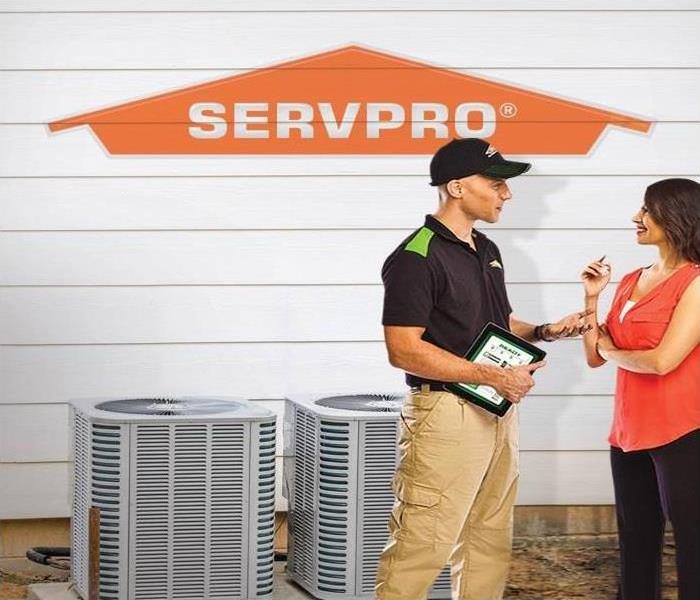 SERVPRO will make recommendations about the best way to address any indoor air quality concerns. This can save you money and provide peace of mind.
SERVPRO will make recommendations about the best way to address any indoor air quality concerns. This can save you money and provide peace of mind.
When your HVAC system isn't cooling your home efficiently and comfortably, there's likely a big problem requiring maintenance, troubleshooting or repair. Here are the 5 most common HVAC problems and solutions.
Noisy Air Vents
Noisy air vents mean trouble. Rattling and clamoring noises are often caused by loose ductwork connections. Wrapping the rattling ducts with metal tape will do the trick.
Loud pops and bangs are usually ductwork expansion and contraction due to temperature variances. Make sure your ducts are well insulated.
Frozen Evaporator
Ice buildup on the evaporator coil brings home cooling to a halt -- even though your A/C may still run. Dirt buildup on the evaporator is a common problem for ice accumulation. Clean the evaporator with a spray can of self-rinse coil cleaner.
High Indoor Humidity
High indoor humidity is one of the most common HVAC and indoor air quality problems during the cooling months. The only practical way to control high humidity in your home is with a dehumidifier. This could be a portable unit, or install a whole-home dehumidifier for optimal results, comfort and efficiency.
Water Leaks
Your central air system produces an unbelievable amount of condensate during the cooling months. So, it's quite common for the drainage system to become clogged and/or malfunction and spill water in your home. You can try to alleviate the clog with a shop-vac, but it's better to call your HVAC technician right away.
Dirty Air Filter
Air filters are among the simplest HVAC devices. Yet, a dirty filter can cause a long list of expensive problems -- including all of the preceding four most common HVAC problems. Moreover, running your HVAC system with a dirty filter drains your energy budget. Change your filter as suggested by the manufacturer.
Worried about your HVAC Compressor and lightning damage ? Check out our blog post HVAC Compressor Damage: Lightning or Wear & Tear
Also check out what SERVPRO of Portage County's Air Duct and HVAC cleaning services can do for you.
Questions or in need of service ? Call us today - 330-677-4483
Dentist Abandons Practice After Fire Loss- Will Policy Proceeds be Recovered?
5/7/2018 (Permalink)
 Fire & Smoke Restoration Technician | Odor Control Technician | Upholstery & Fabric Cleaning Technician | Water Damage Restoration Technician
Fire & Smoke Restoration Technician | Odor Control Technician | Upholstery & Fabric Cleaning Technician | Water Damage Restoration Technician
An Excerpt from Property Casualty 360 Q&A
Question: Our insured had total fire loss and is insured under a business-owners policy. The insured is a dentist and determined that as of this loss she would abandon this practice as she had other locations that were more productive.
Since there was a direct loss from a covered peril, but no period of restoration to speak of, will the insured recover any policy proceeds under business income coverage?
Answer: In order for business income coverage to be triggered, the insured must suffer an actual loss of business income due to the necessary suspension of operations during the period of restoration. If the dentist is not continuing the business at that location, and it is not going to be repaired or replaced, you are correct that there is no period of restoration, and there is also no loss of income due to suspension of operations, so there would be no business income coverage.
Fire Damage ? Call SERVPRO of Portage County's 24/7 Emergency Service line - 330-677-4483
For information on SERVPRO of Portage County fire damage services, click here.
We're On Social Media !
5/2/2018 (Permalink)
SERVPRO of Portage County is active on social media, and we would love for you to follow us!
On our social media pages, you can find relevant safety, cleaning, and remodeling tips, local and industry news, event information, before and after pictures of completed jobs, pictures of our crew, volunteer and fundraising campaigns, and more!
We are currently on Facebook, LinkedIn and Google+, with more platforms to come. Social media allows us to interact with our customers, local businesses, and industry partners in new and exciting ways. We love to hear your thoughts and feedback through social media, and we welcome comments on industry topics and content you would like to hear more about. Please click the links below and follow our pages to receive the latest updates from us!
Facebook
LinkedIn
Google+
SERVPRO of Portage County
4/26/2018 (Permalink)
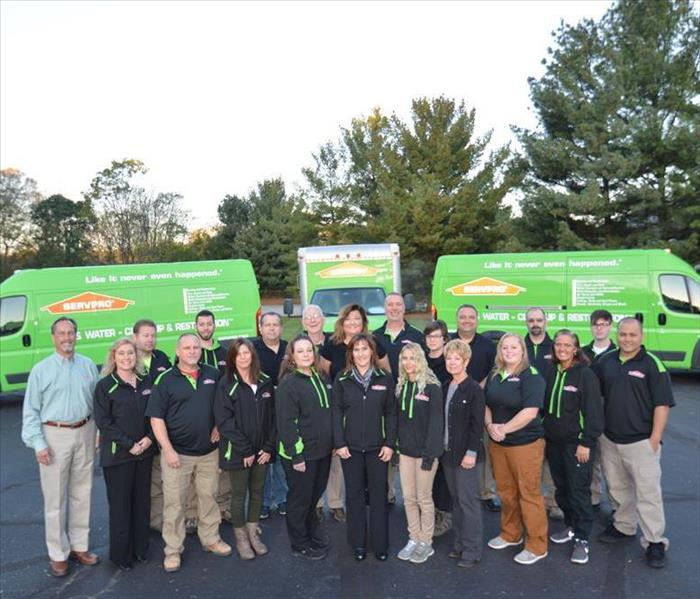 Hire SERVPRO of Portage County today - 330-677-4483
Hire SERVPRO of Portage County today - 330-677-4483
SERVPRO of Portage County takes great pride in being a part of the Portage County community. We understand that communities like ours hold America together. We want to do our part to ensure the Portage County community thrives by helping those less fortunate, keeping the area safe and making our community the best it can be.
Our staff is highly trained in property damage restoration. From initial and ongoing training at SERVPRO’s Corporate Training Facility to regular IICRC industry certifications, rest assured our staff is equipped with the knowledge to restore your property. Our training program includes the following:
- IICRC Training
- Employee Certification Training
- Initial Franchise Training
- e-Learnings
- Continuing Education Classes
The Institute of Inspection Cleaning and Restoration Certification (IICRC) certifies and sets the standards for the cleaning and restoration industries. Our Professionals study IICRC standards and best practices in water restoration, fire restoration, mold remediation, carpet and upholstery cleaning, and other cleaning and restoration courses.
The IICRC sets practical standards for restoration and cleaning. The past few decades has seen a rapid advancement in the technology and techniques used in the restoration industry. These advancements allow SERVPRO of Portage County Professionals to restore a property back to preloss condition quickly, reliably, and more effectively.
In need of our services ? Hire SERVPRO of Portage County today by calling our 24/7 Emergency Service line - 330-677-4483, or Request Help Online
Know What Steps to Take as Spring Storms Occur
4/16/2018 (Permalink)
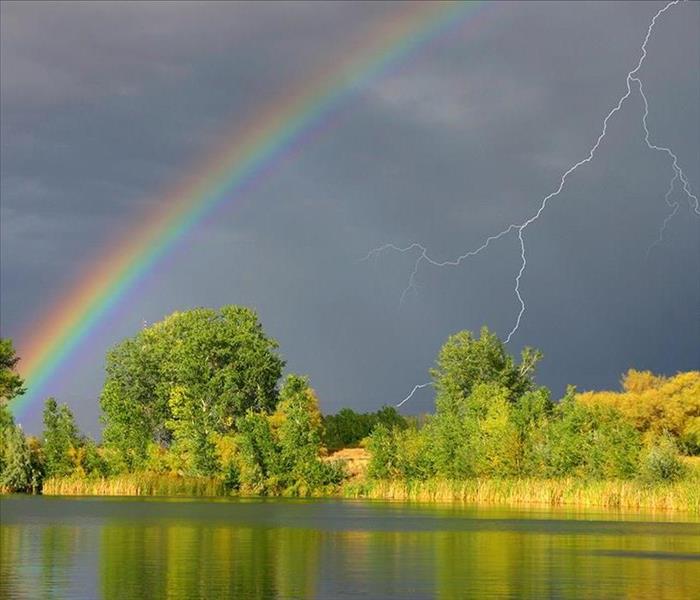 Beautiful Spring... It can also bring major storm activity and being prepared to protect yourself, your home and contents is important.
Beautiful Spring... It can also bring major storm activity and being prepared to protect yourself, your home and contents is important.
Spring-
Green grass, colorful flowers, relaxing rain showers and distant, whispering rumbles of thunder. But it isn't always this peaceful. Consider the notes below, Northeast Ohio, and take to safe steps when dangerous weather is predicted for Summit County, Portage County and/or Canton.
Tornadoes- Spring can be the peak season for tornado activity. Tornadoes occur mostly on warm spring days between 3:00 and 9:00 p.m. However, tornadoes can occur anywhere, at any time of the year, at any time of the day.
The Red Cross has safety steps people should take now to be ready if a tornado warning is issued for someone’s neighborhood:
- Download the free Red Cross tornado app for mobile devices. The tornado app puts everything you need to know to stay safe in a tornado at your fingertips. The app can be downloaded from the iTunes or Google Play stores by searching for American Red Cross.
- Know your community’s warning system.
- Pick a safe room in your home where family members can gather if a tornado is headed your way. This should be a basement, storm cellar or interior room on the lowest floor with no windows.
- Prepare for strong winds by removing diseased and damaged limbs from trees.
- Move or secure lawn furniture, trash cans, hanging plants or anything else that can be picked up by the wind and become a projectile.
- Know the tornado danger signs – dark, often greenish clouds, a wall cloud, cloud of debris, large hail, a funnel cloud or a roaring noise.
Thunderstorms- Thunderstorms are most likely to happen in the spring and summer, during the afternoon and evening. However, like tornadoes, they can happen anywhere, at any hour of the day. Every thunderstorm produces lightning, which kills more people every year that tornadoes or hurricanes.
The Red Cross has steps you can take if a thunderstorm is predicted for your area:
- If thunder roars, go indoors. If you can hear thunder, you are close enough to be in danger from lightning.
- Watch for storm signs like darkening skies, flashes of lightning or increasing winds.
Postpone any outdoor activities. Many people who are struck by lightning are not where it is raining. - Take shelter in a substantial building or a vehicle with the windows closed. Shutter windows and close outside doors securely. Stay away from windows.
- Do not take a bath, shower or use plumbing.
If you are outside or driving, there are things you should do to remain safe. Information can be found with the following link discussing what to do before, during and after a thunderstorm.
Flooding-Spring can be a time of year for flooding. Communities in the Midwest and south have already seen floodwaters inundate neighborhoods. Snow melt and heavy spring rains fill rivers and streams and flooding can occur. Flash floods occur suddenly when water rises rapidly along a stream or low-lying area. People should be prepared to evacuate at a moment’s notice and head for higher ground when a flood or flash flood warning is issued.
Other safety steps include:
- Stay away from floodwaters. If you come upon a flowing stream where water is above your ankles, stop, turn around and go another way. Six inches of swiftly moving water can sweep you off of your feet.
- If you come upon a flooded road while driving, turn around and go another way. If you are caught on a flooded road and waters are rising rapidly around you, get out of the car quickly and move to higher ground. Most cars can be swept away by less than two feet of moving water.
- Keep children out of the water. They are curious and often lack judgment about running water or contaminated water.
- Be especially cautious at night when it is harder to recognize flood danger.
Heed this advice as the Spring weather begins ! Stay safe, Northeast Ohio !
Storm Damage ? Call SERVPRO of Portage County at our 24/7 Emergency Service line - 330-677-4483 or Request Help Online
Safety Tips When Preventing House Fires
4/11/2018 (Permalink)
 Have Questions? Call Us Today – 800-648-1212
Have Questions? Call Us Today – 800-648-1212
For our last blog post, "Homeowners policy. Fire coverage. What do I need?," we covered the following:
Insurance coverage is very important in protecting your home and belongings.
Know what you own- document everything in a video. Educate yourself on the policy you are buying and choose your agent based on your needs.
We also want you to consider the five most common causes of house fires:
- Cooking equipment
- Heating equipment
- Electrical distribution and lighting equipment
- Intentional fires
- Smoking materials
- Candles
In this blog post we will explain how you can reduce the risk of a fire starting in your home.
- Cooking equipment.
- Be alert when cooking and don’t leave food unattended
- DO NOT throw water on a grease fire- put a lid on the pan or powdery material such as baking soda to smother the fire
- If an oven fire flares up, turn the oven off and leave the door shut until the fire extinguishes itself
- Keep clothing, pot holders, paper towels and other flammable items away from fires
- Keep working smoke detectors in the house, and have a fire extinguisher nearby just in case
- Heating equipment.
- Keep anything that can burn at least three feet away from heating equipment, like the furnace, fireplace, wood stove, or portable space heater
- Maintain a three-foot “kid-free zone” around open fires and space heaters
- Turn off space heaters and make sure any embers in the fireplace are extinguished before going to bed or leaving home
- If you must use a space heater, place it on a level, hard and nonflammable surface (such as ceramic tile floor), not on rugs or carpets or near bedding or drapes; keep children and pets away from space heaters
- Make sure your fireplace is properly cleaned and checked before the cold weather season starts.
- Keep the fire in your fireplace by using a glass or metal fire screen large enough to catch sparks and rolling logs
- Make sure wood and coal stoves, fireplaces, chimneys, and furnaces are professionally inspected and cleaned once a year
- Electrical distribution and lighting equipment.
- Don’t overload outlets or electrical cords
- Make sure you have the right cord for the job – inside cords for inside, heavy duty/outside cords for outdoor use
- Don’t leave Christmas lights, Christmas trees, or halogen lights on overnight, or when not at home
- Consider having an electrician perform an annual checkup of your home’s wiring
- Intentional fires.
- Consider what could burn
- Remove overgrown vegetation
- Remove abandoned cars
- Secure vacant homes
- Watch for kids
- Get to know your neighborhood
- Report suspicious activity
- Work with your community
- Watch local businesses
- Organize a watch program
- Install and test smoke alarms
- Call 911
- Smoking materials.
- If you smoke, consider smoking outside
- Use wide, sturdy ashtrays to catch butts and ashes
- Look for cigarette butts under furniture and between seat cushions to make sure no lit butts have fallen someplace where they can’t be seen
- This one might be obvious, but nonetheless, don’t smoke in bed, when you’re tired, or around medical oxygen
- Candles.
- Never leave a candle burning near flammable items
- Never leave a candle burning in a child’s room or an unoccupied room
- Make sure candles fit securing into candle holders so they won’t tip over
- Blow out any candles before leaving a room or going to sleep
You can follow every piece of advice above, and the chances are positive that you’ll avoid any type of fire in your home. However, even though the risk is greatly reduced, accidents still happen.
The bottom line is that you need to make sure you have enough coverage in the event of a major loss.
Does your home have fire damage ? Call SERVPRO of Portage County's 24/7 Emergency Service line at 330-677-4483 or Request Help Online
Homeowners policy. Fire coverage. What do I need?
4/4/2018 (Permalink)
In Ohio alone, there were 105 home fire fatalities reported in 2016.
A home fire is reported every 90 seconds in the United States.
One death occurs every 2 hours and 35 minutes, according to the National Fire Protection Association (NFPA).
Now is the time to review your coverage, Northeast Ohio.
But first, consider the five most common causes of house fires:
- Cooking equipment is the number one source of home fires and the second leading cause of home fire deaths – usually leaving pots or pans unattended on the stove while you run away to do something for “just a minute.” The NFPA says that 47% of all house fires start this way.
- Heating equipment accounts for 15% of home fires, specifically this time of year. Trying to heat the home with space heaters or chimneys that aren't properly cleaned are the leading causes of heating equipment fires.
- Electrical distribution and lighting equipment account for approximately 9% of home fires, and can come from a number of different origins. They can be caused by an equipment malfunction, from an overloaded circuit or extension cord, or from an overheated light bulb, space heater, washer, dryer or other appliance.
- Intentional fires account for approximately 8% of home fires. The majority of these fires are started outside but still average $1 billion in direct property damage.
- Smoking materials are on a downward trend, however, they still account for 5% of home fires and are the leading cause of home fire deaths.
Other common causes include candles, children playing with fire, and Christmas trees.
*Stay tuned for our next blog post covering House Fire Safety Tips for each "cause of fire" listed above.
Taking precaution will reduce the risk of a fire starting in your home, but the bottom line is you need to make sure you have enough coverage in the event of a major fire loss.
Fire insurance is a necessary part of your homeowners policy. If you have a comprehensive homeowners policy, fire coverage will be included. However, there are many different providers and policies, therefore a variety of coverage limits, deductibles and exclusions defining what is, and is not, covered.
If your property is insured for actual cash value, your fire coverage may be less than what is needed to replace your damaged structures and items.
You can, and should, very seriously consider insuring your property with replacement value coverage instead. This type of coverage will cover the cost of rebuilding a house similar to your previous one after a fire, and provides funds to replace damaged appliances, clothing, and furniture with new items.
KNOW WHAT YOU OWN. We highly recommend you do a video recording of your full house and document your contents.
Your homeowners policy provides the following coverage options to protect your home from fire (check your policy to make sure you understand any exclusions):
- Covers the structure of your home
- Covers additional structures on your property, including sheds, garages and outbuildings
- Insures the contents, or your personal belongings, in each of the structures, including furniture, appliances, electronics, clothes, etc.
- Provides for living expenses if a fire displaces you and your family for a period of time, including rent or hotel expenses
Choosing the right insurance company is incredibly important, but even more important is selecting the best insurance agency to service your needs, and educating yourself on what you are buying.
Does your home have fire damage ? Call SERVPRO of Portage County for help - 330-677-4483 or Request Help Online.
Asbestos and the Work Place
3/27/2018 (Permalink)
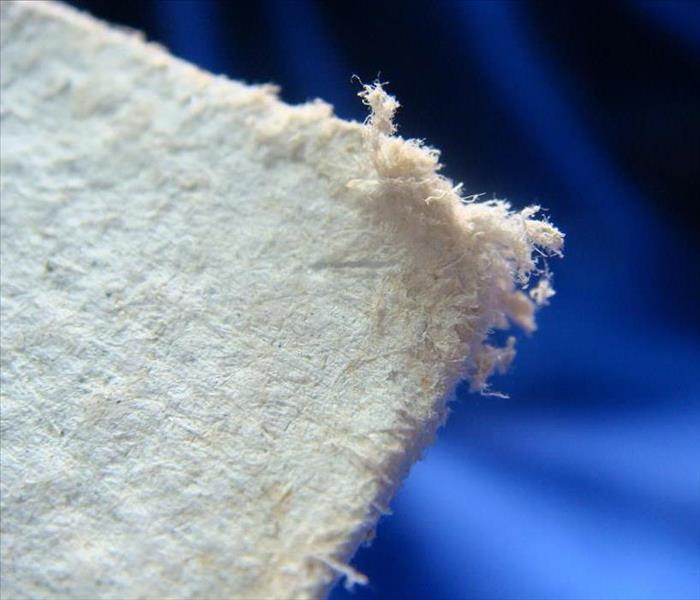 Non-adherence to OSHA standards could result in larger jury awards against non-compliant companies.
Non-adherence to OSHA standards could result in larger jury awards against non-compliant companies.
1972, Congress passed the Occupational Safety and Health Act into law- asbestos risks have beset the industry with decades of health-related liability issues, resulting in ripple effects for insurers. Congress created the Federal Occupational Safe and Health Administration (OSHA), which remains at the forefront of employee safety and has had a significant impact on modern U.S. asbestos litigation.
Beyond the immediate consequences of a regulatory violation, OSHA standards impact today's asbestos litigation in three important ways:
- OSHA violations are often cited by plaintiff's counsel arguing for the imposition of a higher degree of culpability
- OSHA's applicability can allow certain knowledge to be legally imputed to a defendant (irrespective of what the defendant actually knew)
- Because OSHA's regulations control the actions of employers and their employees’ workplace, the adherence or non-adherence to OSHA standards may give rise to arguments for apportioning greater liability to defendants in physical control of the plaintiff's work space.
The current OSHA standard for workplace exposures to asbestos is .1f/cc and has been in effect since 1994.
FEMA Publishes Guidance for Handling Flood Losses
3/19/2018 (Permalink)
 There's no easy solution.
There's no easy solution.
The 2017 Hurricane Season was a brutal one. Seventeen named storms struck the United States causing a record-setting $200 billion in damage.
Much of this damage occurred not from high winds or storm surges, but from extended heavy rains that triggered major flooding.
In an effort to facilitate prompt post-inspection advance payments to policyholders, the Federal Emergency Management Agency (FEMA) published an outline of steps, serving as guidance for handling flood losses.
- Report the loss to your insurance agent or the insurance carrier, who will in turn assign an adjusting firm who provides an adjuster to assist you with presenting the support for your loss.
- The adjuster inspects the property (scoping visit) and may ask if you wish to request an advance payment from your insurer; the adjuster will send you a detailed room-by-room unit-cost estimate of damage and a proof of loss form. If you agree, the proof of loss form should be signed to and sworn to, and upon your insurer's review and agreement, the loss is settled.
- If you do not agree, you should work with your adjuster to find a dollar amount for the covered loss that can be agreed on. Also, working with your general contractor is helpful.
- If you are unable to reach an agreement with the adjuster, you should contact your adjuster's supervisor by calling the adjusting firm.
- The supervisor should work with you to find a dollar amount for the covered loss that can be agreed on.
- If you are unable to reach an agreement with the adjuster's supervisor, you should contact your insurance carrier's claims department to discuss the amount difference or coverage issue with the claim examiner.
- If you are unable to reach an agreement with the claims examiner, you should complete a proof of loss form for the total amount you are requesting (the disputed amount plus any additional amount), and then send the signed and sworn-to proof of loss form with documentation to support the additional amount you are requesting, directly to the insurance carrier claim examiner.
- If the insurer agrees with your documentation, they will pay the amount you are requesting; or they may provide the adjusting firm with their recommendation which may lead to an additional payable amount and a new Proof of Loss. If the insurer disagrees, they will issue payment for any undisputed amount, and a written denial letter will be sent to you fully explaining the reasons for the disallowance (denial) of your claim or any portion of your claim.
- If you agree with the denial or no longer dispute the decision, the loss is settled.
- For any denial of payment, in whole or in part, which you are disputing, three options remain:
- You may send an amended Proof of Loss with supporting documentation back to the claim examiner; see STEP 8
- You may submit a formal Appeal to FEMA
- A written appeal letter must be sent to FEMA within 60 days of your insurer's denial letter, along with a copy of the denial letter and the documentation you have to support your appeal.
- You may file a lawsuit against your insurer
- A lawsuit must be filed within one year of your insurer's first written denial letter and only in U.S. District Court in the district where the property is located at the time of the loss
- However, once you file a lawsuit, you may no longer appeal your claim to FEMA or file an amended Proof of Loss with your insurer.
Storm or water damage ? Call SERVPRO of Portage County's 24/7 Emergency Service line - 330-677-4483 or Request Help Online
With Spring Comes Thunderstorms- Are You Ready ?
3/12/2018 (Permalink)
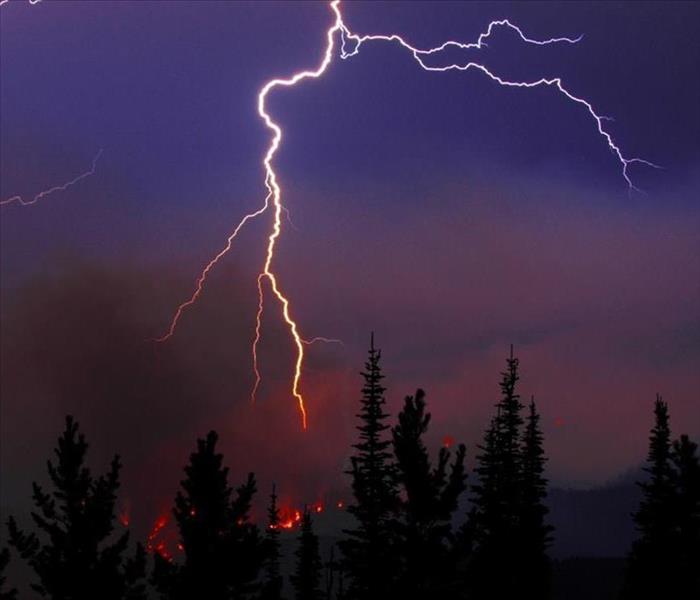 When lightning strikes near a power line, it increases the electrical current. The extra burst of electricity can lead to computer & appliance damage.
When lightning strikes near a power line, it increases the electrical current. The extra burst of electricity can lead to computer & appliance damage.
Did you know that 50% of businesses never reopen after a fire or water disaster? SERVPRO of Portage County is available 24 hours a day to get YOUR business back up and running, "Like it never even happened."
Thunderstorms are absolutely something to be conscious for. 6.5% of all property claims are due to lightning strikes. Wood and other flammable building materials can easily be ignited when lightning comes in contact or passes through them. In addition, high winds, heavy rain and flooding from a thunderstorm can destroy a business in minutes.
If not prepared for a quick recovery, the lost revenue of your business could mean closure.
That is why SERVPRO has local franchises across the nation. When an emergency situation arises, call one of our highly trained professionals, certified in water, fire and mold clean up and restoration.
SERVPRO of Portage County can provide:
- Over 40 years of experience as leading fire and water cleanup and restoration providers.
- There are over 1,500 franchises servicing 48 states.
- More locations for faster responses.
- Quick response time to help ensure the damage is contained and the restoration process begins promptly.
- Large loss capabilities - no fire or water damage is too big.
When the next storm hits Portage County, Ohio, call the professionals at SERVPRO of Portage County - 330-677-4483, or Request Help Online.
Also consider joining our Emergency Ready Program and reduce business interruption following a disaster. Call for details.
Overlooking Water Leaks in Your Home- A Mold Threat
3/6/2018 (Permalink)
DO NOT overlook water leaks in your home. Beware of mold.
A Chubb survey revealed the majority of homeowners do not view internal water leak damage as the most concerning home threat.
Chubb North America Personal Risk Services Division President, Fran O'Brien, said "the time between when a leak occurs and when it's discovered is the single greatest factor in determining the amount of damage."
Nearly 80 percent of homeowners overlook the threat of costly water leaks while on vacation, Chubb survey found. Something to consider as families leave for Spring vacation.
And on top of the drip, drip, drip of what could start as a minor leak, depending on the duration of your Spring vacation, the drip, drip, drip could result in not only water damage to your home, but mold damage as well. For information on how that works, refer to our blog post, 5 Levels of Mold Remediation.
If you'd like to know more about Chubb's survey, click here to visit their site.
Mold Damage ? Water Damage ? Call SERVPRO of Portage County's 24/7 Emergency Service Line at 330-677-4483, or Request Help Online.
Flooding Rains and Toxic Spills, Beware, Ohio
2/26/2018 (Permalink)
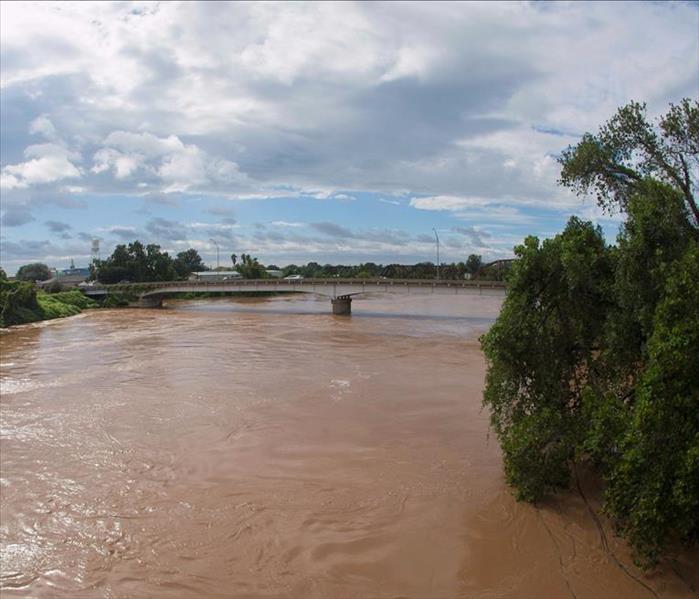 With floods becoming more frequent, the risk of toxic spills has increased too, experts warn.
With floods becoming more frequent, the risk of toxic spills has increased too, experts warn.
"A report by The New York Times found that of the more than 21,600 facilities across the country that handle large quantities of toxic materials, over 1,400 are in areas the Federal Emergency Management Agency considers to have a high risk of flooding.
The proximity of these chemical sites to areas prone to flooding is a relic from a time when industrial operations benefited from being close to rivers and oceans – the bodies of water allowed for transportation, trade, or even a ready supply of cooling water.
Experts believe that this outdated business practice could lead to a major environmental and health disaster." Excerpt from: Insurance Business Magazine
Reported by the Cleveland Patch in their Feb. 8, 2018 article, Toxic Waste Being Reduced In Cuyahoga, Across Ohio, while Cleveland is one of the top five states with the most toxic releases, reports from the Environmental Protection Agency (EPA) show less toxic waste is being released. Also reported, Ohio is seeing a new low in toxic waste being disposed.
"There was 102 million pounds of toxic waste disposed of in the Buckeye State in 2016, the lowest total since at least 2003," the author, Chris Mosby, writes.
"Cuyahoga County had about 7 million pounds of waste to dispose of in 2016. More than 47 million pounds of waste was either disposed of, recycled, treated, used for energy recovery or source reduction."
The EPA said the majority of compounds released in our country falls into the "other" category. The largest identified compound being zinc, the Centers for Disease Control and Prevention's Agency for Toxic Substances and Disease Registry reports very little is known about the long-term effects of exposure to zinc.
As Cleveland and surrounding counties are prone to Lake Erie's floods and lake-effect weather, we must continue the movements Ohio is making to improve our toxic waste disposals.
Sources: https://patch.com/ohio/cleveland/toxic-waste-being-reduced-cuyahoga-across-ohio
https://www.insurancebusinessmag.com/us/news/environmental/experts-as-floods-worsen-so-does-the-risk-of-toxic-spills-91979.aspx
Twelve Things You Can Do to Prepare for Spring
2/26/2018 (Permalink)
Done with Winter ? Prep for Spring ? Here are 12 things you can do to prepare your home.
- Clean your rain gutters.
Wind, animals, and gravity bring sticks, leaves, and other organic matter into your rain gutters, and chances are yours have accumulated their share of detritus over the winter. That's bad news for your home: When downspouts are clogged, rainwater can spill out of your gutters and around the perimeter of your house, putting it at risk for leaks and flooding. Get ready for spring showers by removing the mess from your gutters to ensure that the water will flow freely. Check out our blog post Rain Gutters and Water Problems for clues you may have a problem. - Change filters.
To maintain optimal air quality in your home, it’s a good idea to replace your HVAC system's air filter seasonally as well as the filter in your kitchen range hood. While you're at it, consider changing the filters in your water purification system. Depending on your water, you might not need to change these as often as your HVAC filters, but it's not a bad idea to check them now. So, go ahead and welcome spring with new filters all around to keep your home clean and fresh, and your appliances in good working order. Need help ? See what SERVPRO of Portage County can do to help with our Air Duct and HVAC Cleaning Services. - Check vents.
As snow melts away from your home’s foundation, it’s a good time to check any vents along the foundation or in the attic. Look for missing or damaged screens, debris, signs of insect or rodent infestation, or other issues, and correct them before they have a chance to become bigger problems later in the season. - Service the Lawn Mower.
Get your lawn mower ready for the season with a tune-up. If you didn’t do it in the fall, now’s the time to drain and replace oil, sharpen the blades, remove caked-on grass and mud, and lubricate moving parts. - Prep the gas grill.
After a long winter spent cooped up indoors, you're probably eager for a sunny day and a burger hot off the grill. Get your outdoor cooking station ready for spring by scraping away any rust spots that developed over the winter, cleaning the grill inside and out, and checking the fuel tank hose for damage. - Clean Backyard Furniture
As the weather warms up, outdoor entertaining may be just around the corner. Prepare for warmer days ahead by thoroughly hosing down all backyard furniture—chairs, tables, and lounge chairs—wiping away cobwebs, and bringing outdoor chair cushions out of winter storage. - Pamper the Lawn
Once the danger of frost has passed and your grass starts to come out of winter dormancy, it’s time to jump-start your spring lawn-care routine. Address winter damage to your turf by seeding bare patches—although if you do reseed at this time of year, you should avoid spring applications of chemical weed or crabgrass treatments, which can harm new grass. Then get a head start on weed prevention by manually removing broad-leaf weeds before they have a chance to multiply. For cool-season grasses, spread a light application of fertilizer in early spring; for warm-season grasses, fertilization can wait until late spring or early summer. - Groom Shrubs and Trees
Winter storms can be hard on your landscaping, resulting in broken tree limbs, ragged shrubs, and a garden full of organic debris. Get your yard ready for spring by removing broken or damaged branches, pruning summer-blooming trees and shrubs like butterfly bush and crepe myrtle, and raking up fallen leaves. For information on our Storm Damage services, click here. - Check the Roof
Take advantage of the sun’s return to check your roof for cracked or missing shingles or tiles, and examine flashing around vents and the chimney for damage. While you’re at it, have the chimney cleaned and inspected by a professional. - Plant Bulbs
Spring is the ideal time to plant summer-blooming flowers, which include beauties like dahlias and gladioli. Go ahead and get them into the ground as soon as the danger of frost has passed. - Clean Windows
Winter storms and rain can leave your windows streaked and dirty. Improve your view of mellower weather and let more sun into the house by cleaning windows, both inside and out. Storm Damage ? Click here. - Test Alarms
Let the change of season be your reminder to test all smoke alarms and carbon monoxide detectors for proper functioning. Change batteries if necessary. Alarms can malfunction as they age, so if yours are older than seven years, consider replacing them.
Happy Spring, Portage County ! In need of SERVPRO of Portage County services ? Questions ? Visit our website or call us at - 330-677-4483
Is Your Business Ready?
2/20/2018 (Permalink)
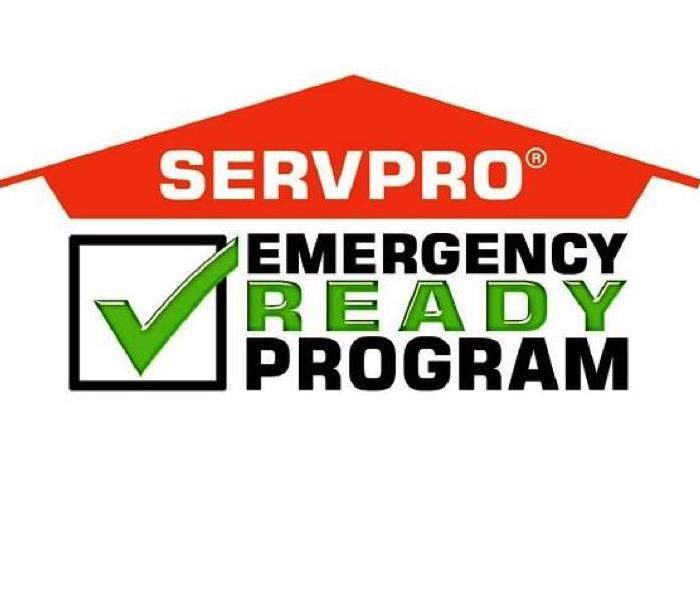 When disaster strikes, getting help is now quicker and easier using the SERVPRO Ready Plan.
When disaster strikes, getting help is now quicker and easier using the SERVPRO Ready Plan.
The best way to reduce business interruption following a disaster is to PLAN for it NOW.
The statistics uncovered by industry research say as many as 50% of businesses may never recover following a disaster. Of the businesses that survive, the majority had a preparedness plan in place.
SERVPRO's Emergency Ready Profile for YOUR business will minimize business interruption by having an immediate plan of action. With a no cost assessment of your facility, the program's profile includes your emergency contacts, all shut off valves and their locations, priority areas of your facility and more.
The SERVPRO Ready Plan provides solutions in advance of an emergency so that during the emergency you are "Ready for whatever happens."
Your business will receive the benefit of over 40 years of experience in reducing the impact of any natural or man-made disaster. Call now and take the next step in protecting and growing your business.
SERVPRO of Portage County - 800-648-1212
And now with the SERVPRO Ready Plan Mobile App, help is at your fingertips. Call now and ask how to get started.
Preparing for Spring
2/5/2018 (Permalink)
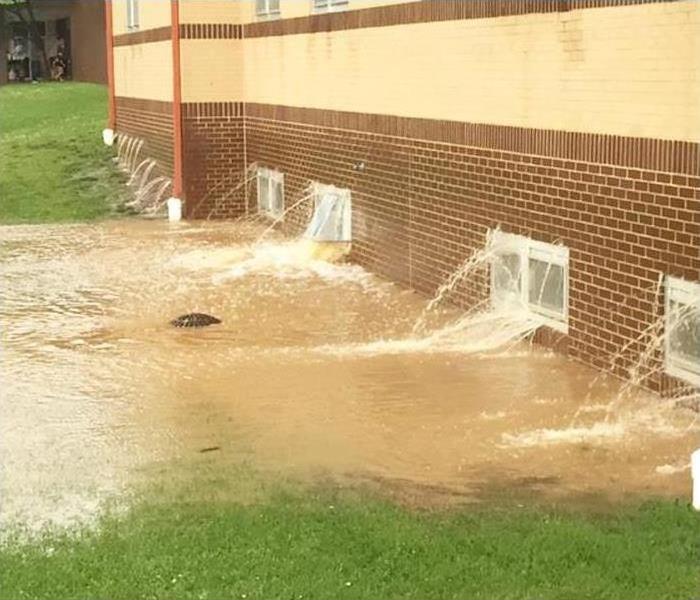 There are dangers posed by wet or flooded basements, so it's important to call a flood damage professional like SERVPRO of Portage County.
There are dangers posed by wet or flooded basements, so it's important to call a flood damage professional like SERVPRO of Portage County.
Well, folks, Punxsutawney Phil has seen his shadow, predicting 6 more weeks of winter. While we have trusted the Pennsylvania groundhog for countless years, additional weather-predicting rodents have called for an early Spring this year, 2018. That said, it is never too soon to begin preparing for the back and forth weather that Spring is.
The most severe of storms Spring can bring are thunderstorms. When warm, moist air collides with cool, dry air, thunderstorms can bring lightning, tornadoes and flooding, and if not properly prepared, this can cause extensive damage to your home or business.
Below are 5 ways to prepare your home for storm damage that can cost you hundreds, even thousands, of dollars, if not kept on mind:
- Clean your gutters. Clear any debris from your gutters to make sure all the rain water can easily flow off your roof away from your home. When water can't get through your gutters, it pools on your roof and around your house. For further information on this subject, refer to our blog post, "Rain Gutters and Water Problems."
- Trim your trees. Some of the worst storm damage is caused by falling trees. A healthy, sturdy tree is unlikely to topple in high winds, but one with dead limbs, or disproportionate growth might. Spring is the perfect time to contact an arborist to evaluate your trees, and if you’ve got large trees on your property, you should have them evaluated yearly. Maintaining them will help you protect both your property and the tree itself.
- Back up your sump pump. When heavy rains come, sump pumps can get overloaded. A flooded basement can cause all sorts of damage to your contents, and when water covers wiring or electric appliances, things get dangerous. Make sure your sump pump has a battery backup just in case the electricity goes out. You might also consider installing a second, battery operated pump that will come on if the main one fails.
- Gather emergency supplies. American Red Cross recommends keeping a three-day supply of food and water for your family, and a seven-day supply of any medications. You might also add a battery operated radio, and a car adapter for your cell phone.
- Grade your yard. If water pools around your home, your foundation is in jeopardy. Ensuring that your yard slopes away from your home will keep rain water from sitting by your foundation and causing damage. Click here for a YouTube tutorial, provided by "This Old House," on how to grade your home. Most lawn companies, however, offer this service.
As we get closer to the rainy season, consider these five steps to keep your home and family safe.
Do you have water problems ? Call SERVPRO of Portage County for help- 330-677-4483
Rain Gutters and Water Problems
2/2/2018 (Permalink)
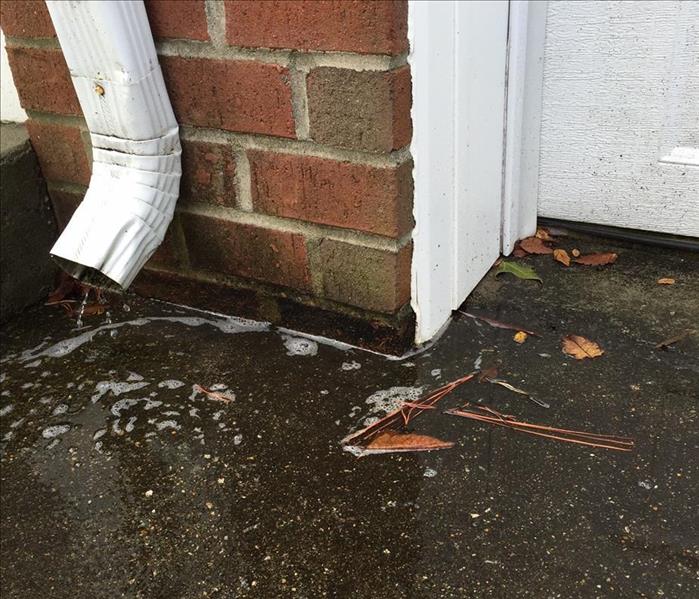 The financial costs of poor drainage can be substantial, and the human health costs significant too.
The financial costs of poor drainage can be substantial, and the human health costs significant too.
Most homes have gutter downspouts that lead straight to the ground, which means all the water from the roof is pouring to just one point where it can collect against a home's foundation. This most often causes the water drainage problems and, thus, the damage.
Prevention is important. Here are some clues that you may have a problem with your gutters:
- Areas where the ground is wet for long periods of time after it rains or the sprinklers are running signal an area where the water is collecting
- Discoloration and mold growth on a home's foundation and siding or paint is easily falling off your house are indications that water is pooling.
- Musty smells in your basement or crawlspace signal water may be getting into your home.
Financial costs of poor water drainage can add up, but the good news is that gutter problems are an easy fix.
Do you have water damage in your home or business ? Call SERVPRO of Portage County's 24/7 Emergency Service line at 330-677-4483 or request help online at our franchise website.
Renters Insurance and a Squirrel On Fire- What You Need to Know
1/11/2018 (Permalink)
 Blow torch the fur, they said. It'll be great, they said. One massive fire later... Better call SERVPRO.
Blow torch the fur, they said. It'll be great, they said. One massive fire later... Better call SERVPRO.
It's been proven, Portage County, that using a blowtorch to remove the fur of a squirrel is not an intelligent thing to do. Renter's insurance, however, is absolutely an intelligent thing to do, especially if you insist on using a blowtorch on your rented property to remove the fur of a squirrel rather than use a knife to skin the thing.
$300k renters insurance settlement proves you shouldn’t blowtorch a squirrel, a piece written by Marc Christopherson and published on LiveInsuranceNews.com, tells its readers the crime, the consequences and the solution of blow torching a squirrel on rental premises and setting afire multiple units of the apartment complex. What I want our readers to pay attention to is the insurance company's role in this situation and understand the impact of having renters insurance.
To keep it simple, they believed the blow torch would remove the fur from the squirrel so they could eat it as their main course meal. They did not intend to light on fire their apartment unit as well as those around theirs, but that is precisely what happened, causing $2 million in damage.
Naturally, the complex owners sued the couple for the damage costs and the case moved its way around the appeals court, never reaching an agreement until about 4 years later.
Finally, in August of 2016, the apartment complex and the tenant's renters insurance company agreed on a settlement of $300,000, which would be paid by the insurance company to the complex owners. That is not exactly the $2 million settlement the complex wanted, but you can't have it all, I guess.
The fact to take away from this story is that without renters insurance, who knows where this couple would be now. $300,000 from their insurance policy compared to $2 million from who knows where, having their renters insurance, an annual or monthly price that is very affordable, saved their you-know-what's in the end.
But, seriously, blow torching a squirrel ? Kids, don't try this at home. Actually, I take that back- kids and adults, don't try this ever.
For more information on this story, follow this link.
Do you have fire damage to your home or business ? No matter the cause, squirrel or oven grease, we will help. Call us today at 330-677-4483, or request help online.
Frozen and Burst Pipes- Understand and Take Precaution
12/27/2017 (Permalink)
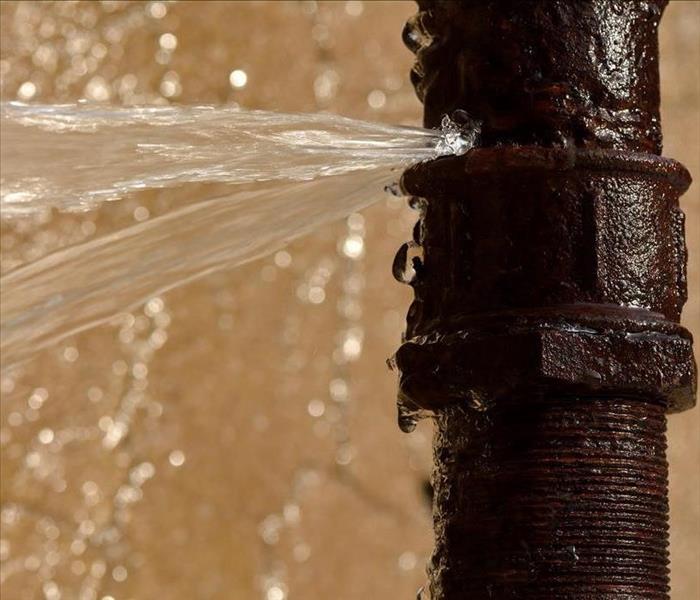 "Even a small crack in a burst pipe can spew hundreds or even thousands of gallons of water in a day."
"Even a small crack in a burst pipe can spew hundreds or even thousands of gallons of water in a day."
If your pipes are exposed to temperatures below 32 degrees Fahrenheit for an extended period of time, the water can freeze and cause extensive damage to your home. This can be avoided!
Frozen pipes can occur for two basic reasons:
- Installation of pipes in an unheated space without adequate protection
- Insufficient heat in the area of the freeze
What types of pipes are susceptible this situation? Domestic water piping, HVAC heating and cooling piping and sprinkler piping are all vulnerable if left in cold and unprotected conditions as stated above. Plastic and metal pipes can burst when they freeze, and depending on the size of the pipe, even a small crack in a burst pipe can spew hundreds or even thousands of gallons of water in a day.
Why does a pipe burst, anyway? Well, when water freezes, it expands. The ice expansion will exert pressure against the pipe wall but also pressurizes the water trapped between the ice and a closed valve or fixture. As the water continues to freeze and expand inside the pipe, it causes the trapped water to continue to increase in pressure, thus, just as a can of soda will burst in your freezer, so does your water pipe.
Some common locations where pipes will freeze are outdoor hose bibs, swimming pool supply lines, fire sprinkler lines and water supply pipes in unheated interior areas. These areas include basements, crawlspaces, attics, garages, bathroom sink cabinets and kitchen cabinets. Pipes along exterior walls that have little or no insulation, voids in the insulation or improperly installed building wrap are subject to freezing. You might want to check in on that sooner rather than later. Review the International Plumbing Code by clicking here.
On what you, the homeowner, can do to prevent a pipe burst from happening, refer back to our blog piece, "How to Thaw a Frozen Pipe."
Remember, this stressful situation can be avoided if you think ahead!
With any questions or if your home has been water-damaged, call SERVPRO of Portage County on our 24/7 Emergency Service line, 330-677-4483 or Request Help Online.
Call SERVPRO of Portage County
11/29/2017 (Permalink)
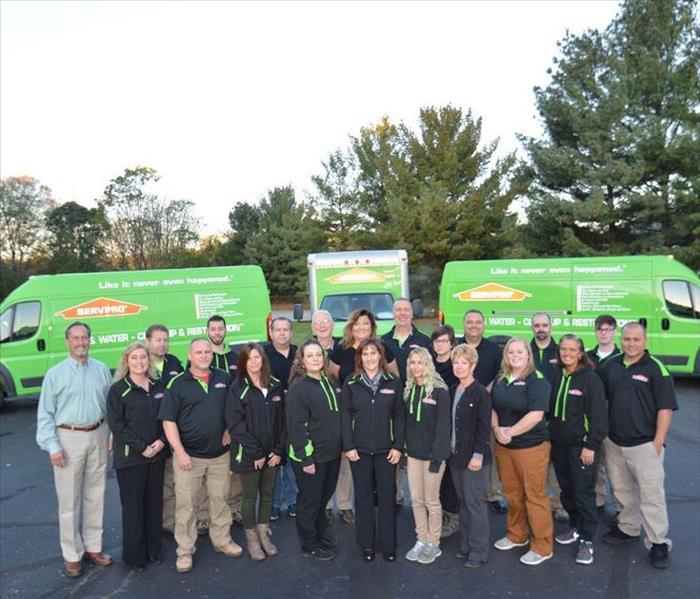 Our franchise professionals are uniquely qualified to help. Need Help? Call us at 330-677-4483
Our franchise professionals are uniquely qualified to help. Need Help? Call us at 330-677-4483
SERVPRO of Portage County understands the stress that comes with damage to your home or business, whether it be from fire, water, mold, storm or even biohazards. Our franchise professionals are uniquely qualified to help.
Our team is trained to IICRC standards in fire and water cleanup and restoration. In addition, we have Employee Certification Training, Initial Franchise Training, e-Learnings and Continuing Education Classes. For more information on our training program, click here.
Restoring your property is SERVPRO's first priority, and restoring your property is less expensive than replacing your property.
We respond immediately to your loss with our 24/7 Emergency Service team. With over 1,700 U.S. and Canadian Franchise locations, SERVPRO is strategically positioned to be faster to any size emergency. An immediate response helps to minimize the damage and the cleaning and restoration costs.
For more information on SERVPRO of Portage County, visit our Company Profile page.
Need Help? Call us at 330-677-4483, or Request Help Online.
How to Remove Mold And Mildew Stains From Washable Clothes
11/23/2017 (Permalink)
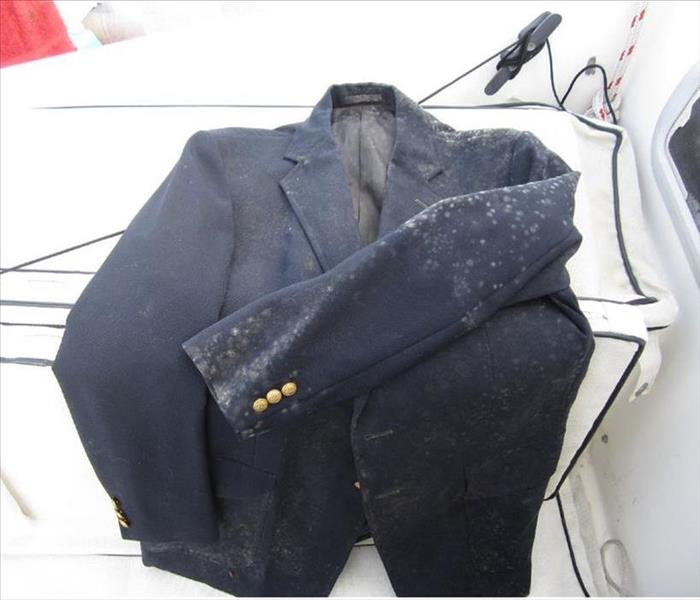 Even if you can't see any spots or growth, if the odor is present there are spores growing and treatment is necessary.
Even if you can't see any spots or growth, if the odor is present there are spores growing and treatment is necessary.
Mold can easily grow on clothes and fabric if you have too much moisture in your home. Clothes made of cotton or other organic materials make great food sources for mold and mildew to live on.
There are a few tips to keep in mind when removing mold from clothes:
- It's best to wash your clothes in hot water. Hot water kills mold more effectively than cold water and better removes mold spores and allergens too. Of course make sure you don't use water so hot that it can damage your clothing.
- When you're washing your clothes with a mold killing solution, it's best to wash them through at least two full cycles. Then after your clothes have been washed hang them on the line in the sun. The heat from the sun and the sun's ultraviolet light help to kill mold.
There are quite a few solutions you can wash moldy clothes in to get rid of the mold. Some good ones include:
- Bleach
- Borax
- Vinegar
- Baking soda
- Mold killing detergent
For the full article and a step-by-step explanation of the cleaning process, click here.
Does your home or business have mold damage? Call SERVPRO of Portage County at 800-648-1212
Include Safety in Your Thanksgiving Holiday
11/15/2017 (Permalink)
 Candles cause an estimated 15,600 house fires, 150 deaths, and 1,270 injuries each year. Never leave a candle unattended.
Candles cause an estimated 15,600 house fires, 150 deaths, and 1,270 injuries each year. Never leave a candle unattended.
Especially during the holidays, the kitchen is the heart of the home. From baking and decorating cookies to testing family recipes, keeping kitchen fire safety at the top of your mind is a must- certainly when there is a lot of activity and people in one space.
Some Thanksgiving not-so-fun facts:
- Thanksgiving is the peak day for home cooking fires, followed by Christmas Eve/Day.
- In 2015, U.S. fire departments responded to an estimated 1,760 home cooking fires on Thanksgiving.
- Unattended cooking was the leading contributing factor in cooking fires and fire deaths.
With that said, here are some safety tips for the 2017 Thanksgiving holiday:
- Stay in the kitchen/home when you are cooking so you can keep an eye on the food.
- Make sure kids stay away from the stove and oven.
- Keep the floor clear so you don’t trip over kids, toys, pocketbooks or bags.
- Be sure electric cords are not dangling off the counter within easy reach of a child or pet.
- Keep matches and utility lighters out of the reach of children.
- Never leave children alone in room with a lit candle.
- Make sure your smoke alarms are working.
Caution is not a buzz kill. A house fire, on the other hand, is.
Have a happy and safe Thanksgiving holiday, Portage County!
How to Thaw a Frozen Pipe
11/14/2017 (Permalink)
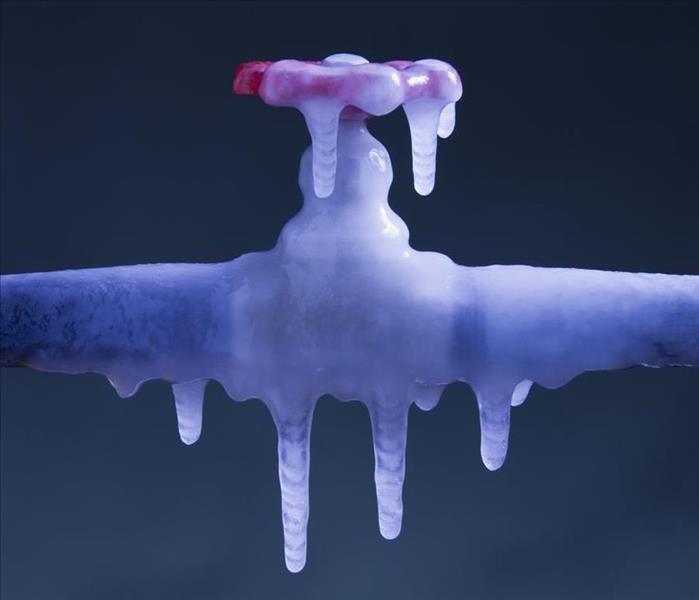 A frozen pipe exerts pressure at over 2,000 Lbs/ square inch, enough pressure to rupture almost any pipe filled with water.
A frozen pipe exerts pressure at over 2,000 Lbs/ square inch, enough pressure to rupture almost any pipe filled with water.
Frozen water pipes are a serious risk during very cold winter weather. When water freezes in a pipe it expands and can exert pressure at over 2,000 pounds per square inch. This pressure is enough to rupture almost any pipe filled with water, which provides no place for the ice to expand. A burst pipe can spill several hundred gallons of water per hour, and that equates to thousands of dollars of damage to your home. Pipes are most susceptible to freezing when they are located:
- in an outside wall
- in a cabinet under a sink (especially near an outside wall)
- in an unheated crawl space or basement
If your pipe is frozen but not yet ruptured, you must thaw it right away. There are a few thawing techniques to try, depending on where the frozen pipe is located.
Warning: Never use a blow torch or other open flame to thaw a pipe. This presents a serious fire hazard and can damage the pipe.
A frozen pipe that hasn't burst yet often reveals itself at a faucet: when you turn on the faucet and no water comes out or it has slowed to a trickle, there's probably a blockage of ice somewhere in the line. It's time take immediate action:
- Shut off the water to the faucet locally or at the home's main water shutoff valve.
- Open the faucet that is supplied by the frozen pipe; do this even if you don't know where the blockage is.
- Identify the frozen pipe and locate the blockage: Follow the pipe back from the faucet to where it runs through cold areas, such as an exterior wall or unheated crawl space. Look for areas on the pipe that have frost or ice; it may also be slightly bulged or fissured.
When you find that the frozen—but not yet burst—pipe is behind a wall or ceiling, you've got a challenge on your hands. You have three options for thawing the pipe:
- Turn up the heat in the house and wait.
- Cut out a section of the wall or ceiling to access the frozen section of pipe, then thaw the pipe as an exposed pipe (see next slide).
- Use an infrared lamp to help heat the wall section in front of where you believe the pipe is frozen. Infrared lamps are better than regular heat lamps because they pass through the air without heating it and will direct more energy to warming the wall and frozen pipe.
If the frozen pipe is exposed, you have several options for thawing it. Whichever remedy use use, heat the pipe from the faucet toward the frozen area. This allows water to flow out as the ice melts.
- Hair dryer: Usually the easiest and safest way to thaw a pipe. If the pipe is close to the wall, place a cookie sheet behind the pipe to help radiate heat onto the backside of the pipe.
- Heat lamp: You can use an infrared or incandescent heat lamp. As with a hair dryer, if the pipe is close to the wall, use a cookie sheet behind the pipe to help reflect heat onto the pipe.
- Portable heater: A small, powerful heater works great for warming pipes under a kitchen or vanity base cabinet. Direct the heater onto the frozen section of pipe. It will work like a hair dryer on steroids!
- Electric pipe heat tape: Heat tape is a ribbon-like wrap that contains electrical heating elements. You wrap it around the pipe you want to heat and plug it into the wall. The temperature of the tape is controlled with a thermostat. Heat tape can also be used to prevent pipes from freezing in critical areas; you can leave the heat tape on the pipe and plug it in only when needed.
There are a few things you can do to prevent the problem of freezing pipes from occurring again:
- Leave the faucet dripping slightly during the coldest time of the day or night.
- Open the cabinet doors to allow the heated air from the room to reach pipes inside the cabinet.
- Wrap the problem pipe with electrical heat tape.
- Insulate problem pipes with foam insulation wrap, especially those that run through unheated spaces. Note: Insulation merely slows the transfer of heat and will not prevent a pipe from freezing if the surrounding air is cold enough.
- Heat unheated areas with a permanent heater, just to keep the temperature above freezing, or about 40 degrees F. Warning: Do not use portable heaters, which should never be left running unattended.
- Remove garden hoses attached to outdoor faucets (hose bibs or sill cocks). If the faucet is not a frost-proof type, turn off the water to the faucet inside the house and drain the exterior section of the pipe and faucet.
Does Your Home or Business Have Mold Problems?
11/9/2017 (Permalink)
If you see visible mold, do not disturb it. You can inadvertently spread the mold infestation throughout your home or business. When mold is disturbed, the mold can release microscopic mold spores which become airborne and can circulate inside your building.
What to Do:
- Stay out of affected areas.
- Turn off the HVAC system and fans.
- Contact SERVPRO of Portage County for mold remediation services.
What Not to Do:
- Don’t touch or disturb the mold.
- Don’t blow air across any surfaces with visible or suspected mold growth.
- Don’t attempt to dry the area yourself.
- Don’t spray bleach or other disinfectants on the mold.
About Our Mold Remediation Services
SERVPRO of Northern Summit County, Portage County and Canton specialize in mold cleanup and restoration, in fact, it’s a cornerstone of our business. Our crews are highly trained restoration professionals that use specialized equipment and techniques to properly remediate your mold problem quickly and safely.
If You See Signs of Mold, Call Us Today – 800-648-1212
Is It Possible to Restore Clothes that Have Been Affected by Mold?
11/9/2017 (Permalink)
 If you decide to remove mold from clothes yourself, be sure you do it safely. Refer back to our blog for more on clothing restoration.
If you decide to remove mold from clothes yourself, be sure you do it safely. Refer back to our blog for more on clothing restoration.
Any garment or fabric that has not suffered physical deterioration or discoloration as a result of mold growing on it, and that is washable (typically, a minimum of 130ºF for at least 10 minutes), can be restored completely. That goes for bacterial contamination as well, as evidenced by hospitals daily as they wash linens, gowns, surgical drapes, etc.
Dry cleaning also does a good job when evaluated and cleaned - often twice - by a qualified professional. Again, this assumes no deterioration or discoloration of the garment. Ultimately, sampling and evaluation by a qualified environmental professional can be used to confirm remediation of the garment.
Professional restoration technicians understand the need for quick response. Immediate remediation is key to controlling any escalating costs. The longer the remediation is delayed, the higher the cost of restoration. Certified restorers have the knowledge to test materials and apply the restoration techniques required to return the items to their preloss condition. Look for the IICRC logo to verify IICRC certification.
Does your home or business have mold damage? Call SERVPRO of Portage County at 800-648-1212
A Brief Guide to Mold, Moisture and Your Home
11/3/2017 (Permalink)
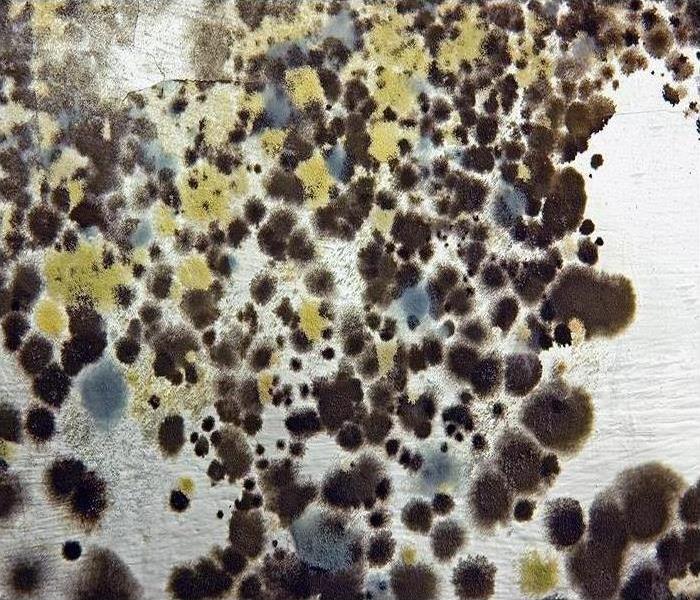 SERVPRO of Portage County can respond quickly, working to first contain the infestation and prevent its spread to other parts of the building.
SERVPRO of Portage County can respond quickly, working to first contain the infestation and prevent its spread to other parts of the building.
Provided by the U.S. Environmental Protection Agency, Office of Air and Radiation- Indoor Environments Division, this Guide provides information and guidance for homeowners and renters on how to clean up residential mold problems and how to prevent mold growth.
Contents:
- Mold Basics
- Why is mold growing in my home?
- Can mold cause health problems?
- How do I get rid of mold?
- Mold Cleanup
- Who should do the cleanup?
- Mold Cleanup Guidelines
- What to Wear When Cleaning Moldy Areas
- How Do I Know When the Remediation or Cleanup is Finished?
- Moisture and Mold Prevention and
Control Tips- Actions that will help to reduce humidity
- Actions that will help prevent condensation
- Testing or sampling for mold
- Hidden Mold
- Cleanup and Biocides
- Additional Resources
Click Here for the full PDF
Have a Mold Problem? Call SERVPRO of Portage County Today – 800-648-1212
Agents: Watch Word Choice in Claims Letters
10/31/2017 (Permalink)
 Grammar matters.
Grammar matters.
The following bullets point out random errors in word choice. You may not lose a client because you make a poor word choice, but you’re not helping the relationship either. Here are several word choice issues to watch for as you phrase your letters:
- “ABC Insurance Company will make no voluntary payment of your claim…” Voluntary?
- "e.g., and i.e.," most people don’t know the difference. Use e.g., when you are giving examples; use i.e., to introduce your thought “in other words.”
- “Exception” and “exclusion” are words that have their own meanings. One adjuster wrote,” the exception that pertains to your loss can be found in your policy and is provided below for your reference. I think the word should be “exclusion.”
Here’s the difference: An insurance policy tells you what is covered.
Exclusions are classes of items that are not covered, such as nuclear war, acts of God, or terrorism. Exceptions are “exclusions to the exclusions, reinstating particular items within a whole category that had been “excluded.” For example, a homeowner’s policy may have an exclusion for all motorized vehicles. The exception to that exclusion might be a lawnmower, because a mower helps service the premises.
- “Said” – Very legalistic: “Said payment would allow you a discount of $300.” Just write, “This payment would allow you a discount of $300.”
- “Regard” and “Regards.” Do not write, “This is in regards to…” Write, “This is in regard to…”
- “Were” and “was.” Take the phrase, “If there were no coverage…” Using “were,” known as the subjunctive mood in English, represents situations contrary to fact.
- “Confirm.” When you confirm a lunch date, you restate your agreement as to the time and place. In insurance, however, it’s common to see a claims letter that starts, “This will confirm my phone call of 4/11/17." But what does “confirm” mean? Is the writer summarizing the previous call? Documenting it? Confirming is something you do to re-check a future date or agreement.
- “Advise.” About 80 percent of the time claims people use “advise,” they just mean “tell” or “inform.” No need to use “advise” in a sentence like, “Let me advise you that it will rain today.” There is no “advice” being given. However, if you write, “Let me advise you to bring your umbrella,” you are using “advise” correctly.
"Your grammar is a reflection of your image. Good or bad, you have made an impression, and like all impressions, you are in total control." -Jeffrey Gitomer
Preparing Your Home for Winter Weather- Avoiding Water Damage
10/31/2017 (Permalink)
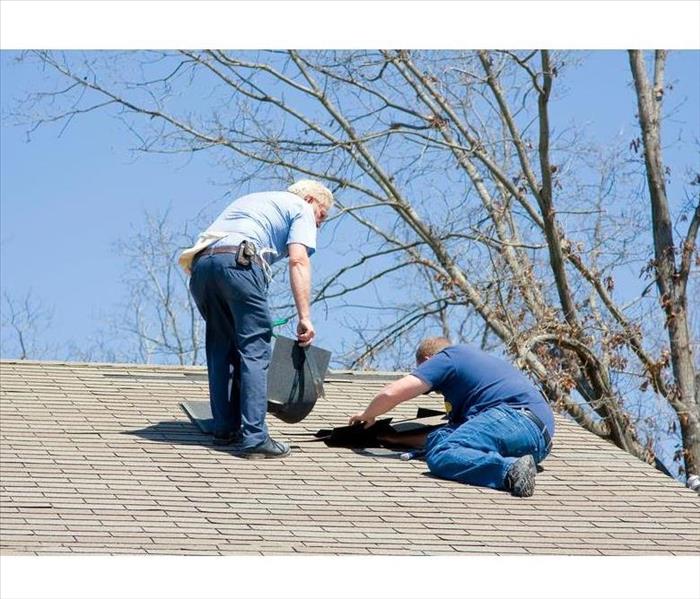 Inspect your roof and gutters on a regular basis — at least twice a year.
Inspect your roof and gutters on a regular basis — at least twice a year.
With winter on the way, we’re heading into a busy time of year that includes several major holidays coming back-to-back. The last thing we want to worry about is the risk of water damage due to the changing weather.
Here are some wintertime considerations to keep your home safe and reduce, or even prevent, possible insurance risks:
- Keep your drains and gutters clean. Exactly how frequently depends on where you live, but you want to plan for twice a year. Clogged gutters can cause a few issues including roof leaks. If your gutters can't drain properly, the excess water can soak through the shingles and eventually start leaking into your home. Don't forget melting snow can also fill up the gutters, causing similar issues!
- Inspect your roof for damage and leaks. While you're cleaning those gutters, take the time to inspect your roof. Keep an eye our for cracks, leaks where different parts of the roof meet, and general wear and tear. You should do this also twice a year at least.
- Water expands, its mass increasing by about 9% when it freezes. Blocked pipes result in a buildup of pressure, which can cause a burst pipe, equipment malfunction, or contaminated water back-up inside the building. To avoid this, consider insulating your water lines and using heat tape as well.
- For extreme weather, it is wise to always leave a tap running at a trickle because running water is less likely to freeze.
Watch for our next blog post on how to defrost a frozen water pipe.
Defending Your Family Business Against Fraud
10/26/2017 (Permalink)
 Fraud can occur anywhere within a company and the right controls can limit its successful execution.
Fraud can occur anywhere within a company and the right controls can limit its successful execution.
In a study done by the Association of Certified Fraud Examiners (ACFE), the 2016 Global Fraud Study found that "businesses with fewer than 100 employees, which are in many cases family-owned, experience fraud at a rate of 28.8%, compared to the 19.8% experienced by those with more than 10,000 employees."
Smaller business often suffer more from fraudulent activities. It's more difficult to manage the damage it causes in a $5 million company than a $250 million company. This kind of activity also damages the company culture.
The median fraudulent loss suffered by small organizations is the same as large organizations: $150,000. However, while it is the same number, this number takes up a larger percentage of the small business revenue.
Here are 5 ways to defend your small business from fraudulent activities and enforce internal controls:
- Segregate financial duties. Create a three-person system of checks and balances: one person opens the bank statements, one prepares the bank reconciliations, and a third reviews all transactions and canceled checks.
- Stay away from signature stamps. Family and small businesses should require two signatures for any payment over a certain monetary amount.
- Establish routine checks of payroll, supplier and vendor lists by multiple people within the company. The final payroll list should be reviewed by someone other than the person distributing checks and preparing the payroll, and the list of vendors should periodically be checked for unrecognized names.
- Educate employees on financial reporting. To increase levels of security, outsource your financial reporting and ensure someone is monitoring for fraud.
- Every employee — including family members — should understand protocols in a business from expectations to pay rates and benefits. Clear expectations help avoid a power struggle and will clearly define who is double-checking various aspects of the business.
Fraud can happen anywhere. The more you believe it won't happen to your business, the more susceptible you become to it.
Source: 5 Ways to Defend Your Family Business Against Fraud by Bill Kowalski
Mold Cleanup Information for You and Your Family
10/23/2017 (Permalink)
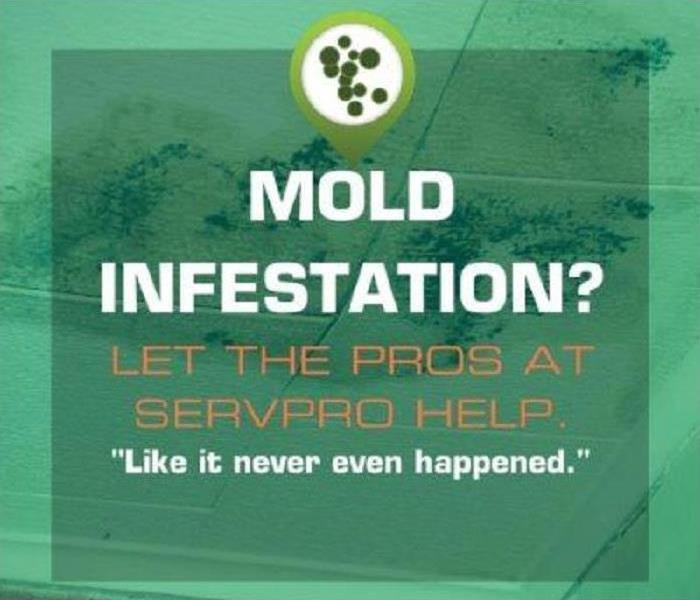 We invest in the latest equipment and ongoing mold remediation training because it helps us restore your home or business quickly and effectively.
We invest in the latest equipment and ongoing mold remediation training because it helps us restore your home or business quickly and effectively.
Molds are a natural part of the environment. They can be found anywhere there is water and moisture, so the key to controlling them in and around your home or business is moisture control. If mold is found in your home or business, you should clean up the mold promptly and fix the water problem immediately. It is also important to dry water-damaged areas and items within 24-48 hours to prevent mold growth.
Centers for Disease Control and Prevention offer resources for proper and safe mold cleanup. Click here for more information on mold cleanup information for you and your family.
Mold Damage? SERVPRO of Portage County will help- 330-677-4483
Also check out our webpage for our mold remediation process.
Why a Fire Restoration Contractor is the Way to Go
10/20/2017 (Permalink)
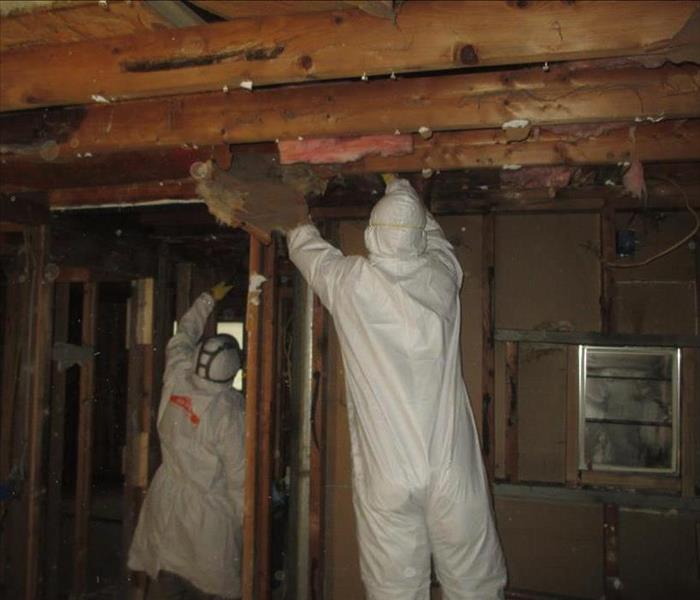 When fire & water damage strikes, a fast response is critical. We’re dedicated to responding immediately, day or night, to your Summit County property
When fire & water damage strikes, a fast response is critical. We’re dedicated to responding immediately, day or night, to your Summit County property
A fire restoration contractor can help you restore your home properly after a house fire.
When you hire a fire restoration company, it dispatches several fire restoration contractors, each of whom has the knowledge to use the tools necessary to complete the job. Their skills vary, from reducing the dangers in your home after a fire to preventing secondary water damage. Hiring a fire restoration contractor is an excellent idea because it allows the experts to work on many different things at once, which lets you focus on other things like insurance matters.
A Fire Restoration Contractor’s Equipment
A fire restoration contractor has a variety of tools and the knowledge necessary to use them effectively. One example of this is an ozonation machine. This machine generates ozone, a toxic gas, which fills the house and can partially reverse the effects of smoke odor from embedding itself in everything. These machines are expensive and dangerous, and only a qualified professional should use them.
Getting a referral from your insurance provider is an excellent idea. This ensures that the company you hire has contractors that actively implement sound business practices and can restore your home properly and in accordance with any applicable laws. In addition to this, this method allows you to be sure that the contracting company and your insurance provider can work well together and agree on an appropriate settlement.
Have Questions about Fire, Smoke, or Soot Damage?
Call Us Today – 330-677-4483
The Truth About 100-Year Floods
10/17/2017 (Permalink)
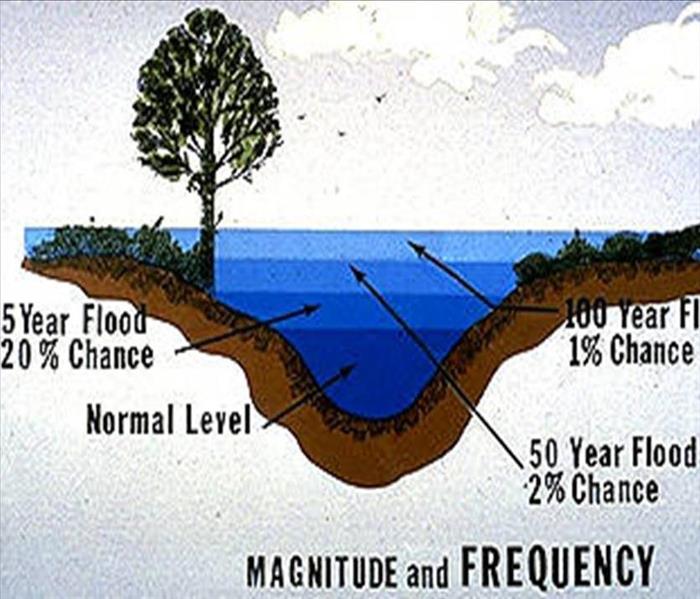 The above image includes a diagram demonstrating the magnitude and frequency of water levels during a flood.
The above image includes a diagram demonstrating the magnitude and frequency of water levels during a flood.
Whenever a strong hurricane or storm causes significant flooding, there is often talk of a 100-year flood. People will think a flood of that magnitude occurs once every hundred years, so they should be safe from harm for the next hundred years. Some base their decision to buy flood insurance on this false belief, putting them at risk of a catastrophic loss.
In order to determine the true frequency of floods, scientists will create a history of the area, tracking the frequency of different sized floods and the average number of years between them to develop the probability of a given sized flood in a particular year.
But rain volume alone does not always create the flood. The condition of the ground before the rain is critically important. If the area has received a lot of rain recently and the ground is already saturated, less rain is needed to flood the area. If the area has been experiencing a drought and the rain is falling fast, it is possible for the water to run off instead of soaking into the ground.
Factors such as a river basin and the addition of dams and levees will be considered. Once a flood recedes, high-water marks will be surveyed by scientists to estimate the maximum flows and streamgages will record the height and quantity of flow.
Explained by Property Casualty 360 in their article "The truth about 100-year floods," "The accumulation of data allows for a determination of the annual probability that a given stream or river will exceed its banks. This is known as annual exceedance probability, or AEP. A 1% AEP flood has a 1 in 100 chance of occurring every year, with an average recurrence every 100 years. This is the 100-year flood." They also predict during a span of a 30-year mortgage, "there is a 26% chance of a home in a 1% AEP, or 100-year flood area, of being flooded."
Questions about flood damage? Call SERVPRO of Portage County today at- 330-677-4483.
Mobile Homes- Are They Covered?
10/5/2017 (Permalink)
 Wind-damaged mobile homes in Oklahoma.
Wind-damaged mobile homes in Oklahoma.
We might be in Ohio, away from all the severe hurricane damage to trailer parks in Florida, Georgia and Texas, but this does not change how the events have changed our perspective on these homes' insurance coverage.
That perspective being: this is important!
Enlightened by Property Casualty 360's article, Mobile homes — A unique insurance exposure, a mobile home serves as both a home and a vehicle. When on the road, authorities treat it as a vehicle, and once settled down in a trailer park, it becomes a home.
Because of the portable and lightweight nature of mobile homes, wind is a significant hazard! Hurricanes and tornadoes, especially, can cause significant damage to mobile homes with the high winds easily flipping, uplifting and damaging the home.
Strap-downs and straps are required to offer stability from these cases, and some newer models use frame anchors tied to the chassis. Some carriers may require a particular type of tie-down for a specific part of the country. Wind zone ratings will indicate how much wind a mobile home can withstand.
With all this in consideration, is the part-vehicle part-home eligible for homeowner's insurance? Coverage is offered for when the mobile home is on the move, covering collision, collision defined as it is in the auto policy.
"As long as the collision happens while the vehicle is being transported there is coverage," Property Casualty 360's article reads. "Not covered is a loss caused by the home making contact with the transportation vehicle that results in damage to the home unless the transport vehicle was in an accident. The coverage applies for 30 days from the effective date on the endorsement. Coverage also includes upset of the home while it is in transit or stranding or sinking if the home is on a licensed ferry line."
Mobile homes require their own coverage needs, meaning its policy will be different from a homeowner's policy. There are carriers that specialize in mobile homes and the coverages they need:
HomeInsuranceWeb.com
Do you have storm damage? Call SERVPRO of Portage County at 330-677-4483
Fire Safety: Unplug Household Appliances
9/14/2017 (Permalink)
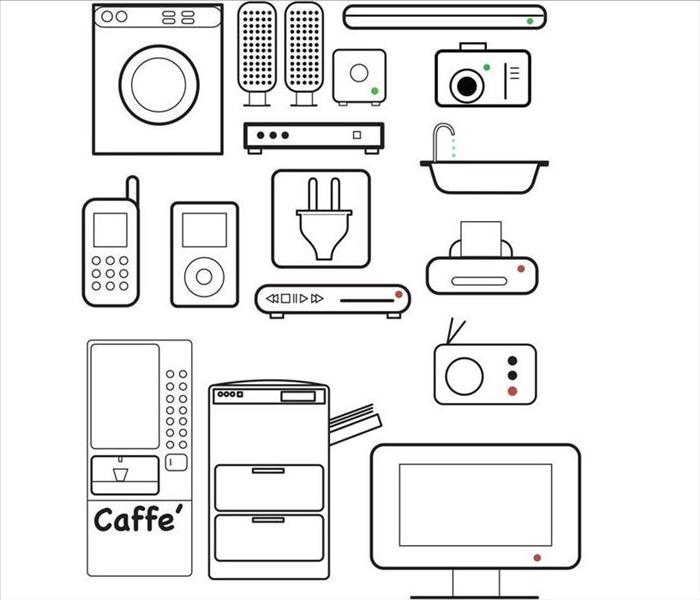 The consumption of household appliances worldwide is forecast to generate nearly 590 billion U.S. dollars in revenues by 2020.
The consumption of household appliances worldwide is forecast to generate nearly 590 billion U.S. dollars in revenues by 2020.
With electric appliances being so common in modern homes, it's easy to forget that there are very real risks and hazards associated with their use and even non-use.
Being safe when using electrical appliances, extension cords, light bulbs and other equipment is easy. It only takes one mistake to spark an electrical fire, but simple prevention measures can be effective solutions.
These safety tips can help keep all appliances operating safely and help you prevent unexpected fires in the home:
- Ensure any appliances you purchase are approved by Underwriters Laboratories (UL) or another reputable consumer laboratory.
- Unplug unused appliances and store cords safely out of reach of pets, young children or hazardous situations.
- Appliances that generate heat, such as clocks, televisions and computer monitors, should be given several inches of clearance all around for good air circulation and cooling.
- Do not attempt amateur repairs or upgrades.
- Keep all electric appliances away from water such as sinks, bathtubs, pools or overhead vents that may drip.
- Do not operate any electrical appliance with wet hands or while standing in water.
- Keep clothes, curtains toys and other potentially combustible materials away from radiators, space heaters, heating vents and other heat sources.
Source: Stephanie Sage of Sage Restoration
To read more on this subject, click here.
Have Questions about Fire Safety? Do you have fire damage? Call Us Today – (330) 677-4483
Faster to Your Portage County Water Damage
9/6/2017 (Permalink)
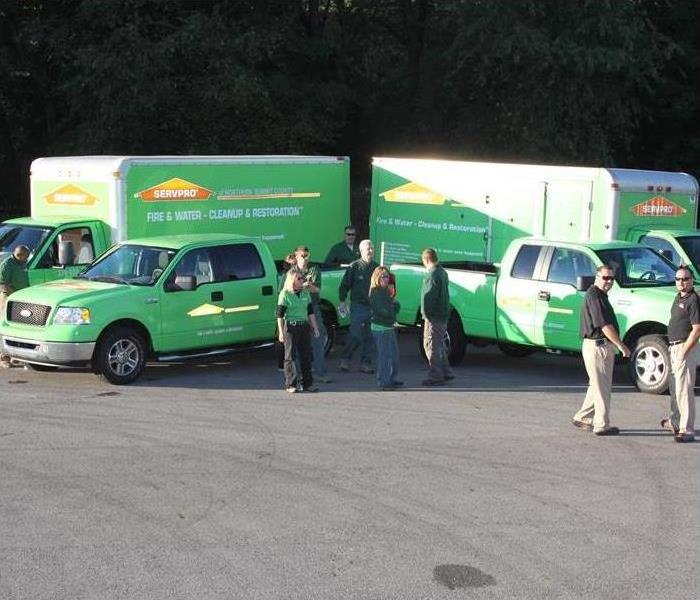 SERVPRO of Portage County provides 24 hour fire and water damage restoration service in Kent, Ravenna, Streetsboro and surrounding areas.
SERVPRO of Portage County provides 24 hour fire and water damage restoration service in Kent, Ravenna, Streetsboro and surrounding areas.
Flooding and water emergencies don’t wait for regular business hours and neither do we. SERVPRO of Portage County, OH provides emergency cleaning and restoration services 24 hours a day, 7 days a week—including all holidays.
Faster To Any Size Disaster
Flooding and water damage is very invasive. Water quickly spreads throughout your home and gets absorbed into floors, walls, furniture, and more. SERVPRO of Portage County arrives quickly and starts the water extraction process almost immediately. This immediate response helps to minimize the damage and the cleaning and restoration costs.
Need Emergency Service? Call Us 24/7 – 330-677-4483
Water Damage Timeline
Within Minutes
- Water quickly spreads throughout your property, saturating everything in its path.
- Water is absorbed into walls, floors, upholstery, and belongings.
- Furniture finishes may bleed, causing permanent staining on carpets.
- Photographs, books, and other paper goods start to swell and warp.
Hours 1 - 24:
- Drywall begins to swell and break down.
- Metal surfaces begin to tarnish.
- Furniture begins to swell and crack.
- Dyes and inks from cloth and paper goods spread and stain.
- A musty odor appears.
48 Hours to 1 Week:
- Mold and mildew may grow and spread.
- Doors, windows, and studs swell and warp.
- Metal begins to rust and corrode.
- Furniture warps and shows signs of mold.
- Paint begins to blister.
- Wood flooring swells and warps.
- Serious biohazard contamination is possible.
More Than 1 Week:
- Restoration time and cost increase dramatically; replacing contaminated materials and structural rebuilding may be extensive.
- Structural safety, mold growth, and biohazard contaminants pose serious risks to occupants.
About SERVPRO of Portage County
SERVPRO of Portage County, OH specializes in the cleanup and restoration of residential and commercial property after a fire, smoke or water damage event. Our staff is highly trained in property damage restoration. From initial and ongoing training at SERVPRO’s corporate training facility to regular IICRC-industry certification, rest assured our staff is equipped with the knowledge to restore your property
Hotel Chain Suffers Water Loss: What Will the Carrier Pay?
9/6/2017 (Permalink)
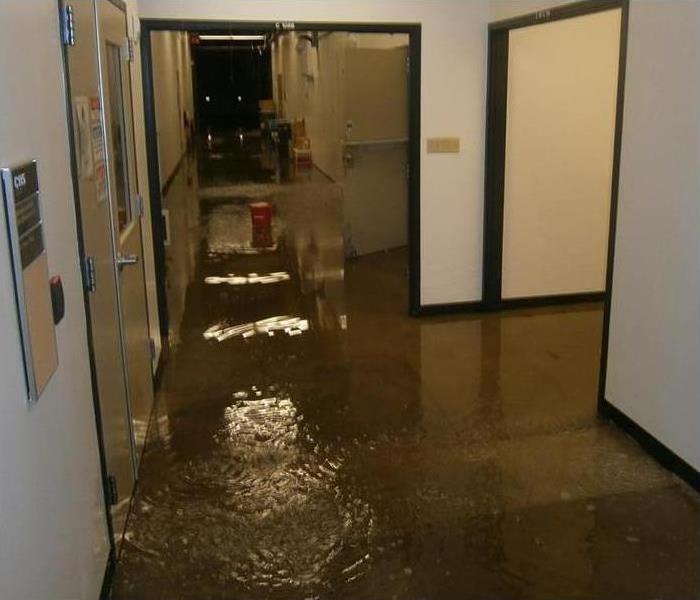 The extent of the destruction will be the most determining factor when calculating price. Most restoration companies bill by the square foot.
The extent of the destruction will be the most determining factor when calculating price. Most restoration companies bill by the square foot.
Inside a Property Casualty article discussing property damage repairs and what the carrier will cover in replacement costs, there is a question regarding a water loss at a hotel chain with a replacement cost policy. Read below:
Question: Our insured is a hotel that suffered water damage to some of its rooms. The insured is a franchisee and has an agreement with the hotel chain that requires replacement of damaged decor with current decor; all of the rooms on the same floor must be updated to the current decor. The hotel has a replacement cost policy, but the other furniture was not damaged. The carrier's position is that it is not responsible for the non-damaged rooms. What should the carrier pay?
Answer: This scenario differs from the matching issue, about which we often receive questions. The carrier is correct in not paying to bring all of the rooms up to the current decor. There is no loss or damage to the other rooms, and while the rooms would not match each other, this is not something that would be apparent to guests. Nothing in the self-contained rooms themselves would be mismatched.
If the chain requires franchisees to maintain a uniform look to all rooms on a floor, that falls more under the cost of doing business. If the rooms themselves are not damaged, it is not an insurance matter to bring them up to speed with the other rooms.
If items in the rooms themselves are not matched, that would be a different matter. For instance, if a headboard needed to be replaced on one bed but a matching one could not be found, then both headboards should be replaced.
Does your commercial property have water damage? Call our 24/7 Emergency Service number, 330-677-4483, or ask for help online.
Read more on our Commercial Restoration Services.
The Basics of Sewer Backup Insurance
9/6/2017 (Permalink)
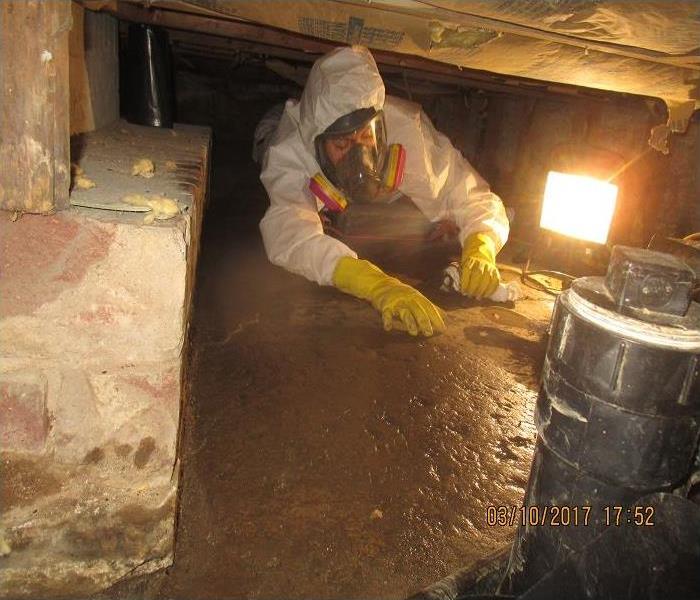 Our Professionals are trained to regular IICRC industry certifications, Employee Certification Training, Initial Franchise Training & Continuing Edu.
Our Professionals are trained to regular IICRC industry certifications, Employee Certification Training, Initial Franchise Training & Continuing Edu.
While shopping for home insurance, it's important to anticipate all the headaches that can go along with home-ownership, including sewer backup.
When sewage flows into your home, it can cause thousands of dollars in damage, and typical home insurance and flood insurance policies won't cover those expenses.
If your sewer's system's pipeline combines storm water and sewage, it's more likely to become overloaded during harsh weather. Tree roots can enter your pipes and cause blockages, or improperly disposing of cooking grease or flushing inappropriate objects down the toilet (diapers, feminine hygiene products or paper towels).
Many homeowners may not realize they are responsible for the maintenance and repair of the pipeline between the city sewer main, usually located in the street, and their house.
Sewage backup coverage is available from most insurers as a rider to a home insurance policy. Coverage for $5,000 to $10,000 in damages can run about $75 to $150 a year, according to FEMA, and there's usually a deductible.
If sewage seeps into your home, not only does the spill itself need to be addressed, but your plumbing may need to be flushed or replaced. Duct-work carpets, drapes and walls may be soiled, possibly beyond repair. Ewser backup insurance helps pay for incidental damage, such as cleaning contents, walls and furniture and some policies may cover work on plumbing.
To get the maximum claims payment to which you're entitled, make sure you have photos on hand of what your home looked like before the damage took place. That way, you can provide your claims adjuster with "before" and "after" pictures. Be sure to itemize property losses and save all receipts for repairs and cleaning.
Do you have water damage in your home?
For help restoring your home after a water loss, call our 24/7 Emergency Service team at 330-677-4486
Water Damage After a Major Storm
9/6/2017 (Permalink)
 We have the storm damage restoration experience and specialized equipment to restore your home or business back to pre-storm condition.
We have the storm damage restoration experience and specialized equipment to restore your home or business back to pre-storm condition.
When a major storm passes close to the house, the home may suffer water damage that is difficult to repair.
There are many things a family can do to begin repairing any destruction, but a certified professional will likely be needed to get rid of any serious health or structural threats. Contaminated storm surges or floods can carry pathogens and become a breeding ground for mold. If allowed to fester, these mold spores can spread throughout the building and become even more difficult to remove. In many cases, governmental agencies could condemn the structure if the microbial threat is too great.
The main reason a home is sensitive to water damage is because moisture is difficult to detect once the floods recede. Standing liquids can encourage microbial growth within 24 hours and can saturate all kinds of textiles and seep through drywall. Moisture may collect behind the walls, where mold and bacteria may multiply out of sight.
Professional restoration services can quickly identify what items in the home are compromised by water damage. Normally, anything that is porous may need to be discarded if it has come in contact with contaminated fluids. These items, like mattresses, box springs, pillows and particle board, trap more moisture than other materials and foster the growth of microbes.
A family can prepare for professional cleaning by getting rid of these items before the technicians arrive, but be sure to properly record and itemize the items for insurance purposes prior to disposing. Once professionals arrive at the building, they will be able to track down any pockets of excess moisture and remove them.
It’s important for a family to hire professionals that are certified through a reputable organization. Technicians trained in this area know how to find compromised areas and do what it takes to restore them.
Flood damage in your home or business? Call SERVPRO of Portage County today at our 24/7 Emergency Service Line - (330) 677-4483 or at our Online Help Line.
Why a Fire Restoration Contractor is the Way to Go
9/6/2017 (Permalink)
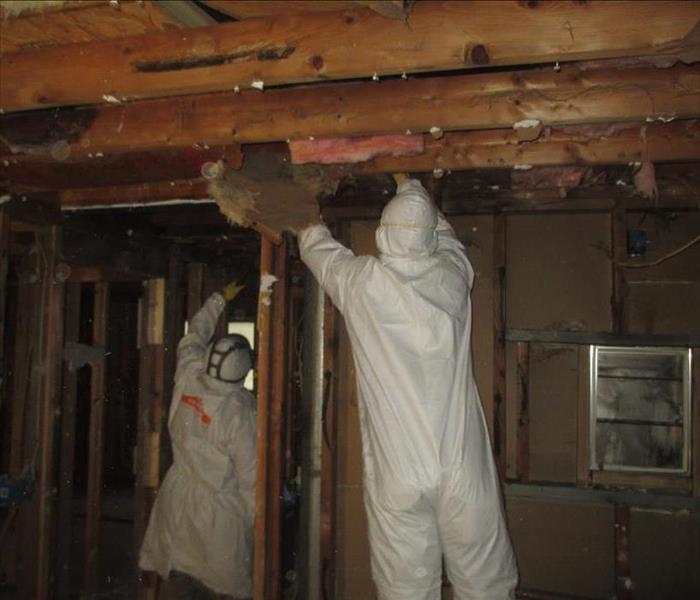 SERVPRO of Portage County has specialized equipment, specific training, and certifications that allow us restore your home to pre-fire condition.
SERVPRO of Portage County has specialized equipment, specific training, and certifications that allow us restore your home to pre-fire condition.
A fire restoration contractor can help you restore your home properly after a house fire.
When you hire a fire restoration company, it dispatches several fire restoration contractors, each of whom has the knowledge to use the tools necessary to complete the job. Their skills vary, from reducing the dangers in your home after a fire to preventing secondary water damage. Hiring a fire restoration contractor is an excellent idea because it allows the experts to work on many different things at once, which lets you focus on other things like insurance matters.
A Fire Restoration Contractor’s Equipment
A fire restoration contractor has a variety of tools and the knowledge necessary to use them effectively. One example of this is an ozonation machine. This machine generates ozone, a toxic gas, which fills the house and can partially reverse the effects of smoke odor from embedding itself in everything. These machines are expensive and dangerous, and only a qualified professional should use them.
Getting a referral from your insurance provider is an excellent idea. This ensures that the company you hire has contractors that actively implement sound business practices and can restore your home properly and in accordance with any applicable laws. In addition to this, this method allows you to be sure that the contracting company and your insurance provider can work well together and agree on an appropriate settlement.
Have Questions about Fire, Smoke, or Soot Damage?
Call Us Today – 330-677-4483
Overcoming Hoarding: 12 Tips
9/5/2017 (Permalink)
 There’s obviously the assault on your eyes of the quantity of the clutter, then there’s the appreciation of what a mishmash the clutter is. -WebMD
There’s obviously the assault on your eyes of the quantity of the clutter, then there’s the appreciation of what a mishmash the clutter is. -WebMD
Compulsive hoarding, also known as hoarding disorder, is a persistent difficulty discarding or parting with possessions because of a perceived need to save them, according to MayoClinic.org. Excessive accumulation of items, regardless of value, occurs.
People with compulsive hoarding may not see it as a problem, and this makes treatment challenging. Below are some tips to overcoming hoarding, pulled from Oprah.com:
- Just because you can think of a use for an object, doesn't mean you need to keep it. If you haven't used an object in over a year, if you didn't know you had it until you found it, you can probably live without it.
- More is not necessarily better. Try to get rid of the extras.
- Categorize items into piles. A pile of things to keep, to donate, to sell or give away, and to throw away, but don't make too many piles and stress yourself out.
- Don't overthink. If the decision takes you more than a couple of minutes for a particular object, you're making it too complicated.
- Learn to get past the imperfections- you don't have to do a perfect job, just a good enough job.
- Only Handle It Once (OHIO). If you pick something up, make a decision and put it where it belongs.
- Be brave. The people who gain the most are usually those who are willing to risk the most.
- Understand what you're afraid of, and recognize when your fears are irrational. Ask yourself, what's the worst that can happen if I throw this out? How bad would that really be? Then discard it and watch for whether or not that bad thing happened.
- Be patient. No one overcomes compulsive hoarding overnight. Take it one room at a time.
- Keep the ball rolling. Clean things as they come along before they become overwhelming problems. Once you start, don't stop. Create a pattern, 5 minutes a day, 30 minutes...
- Be strict with yourself. Promise yourself a reward for doing it.
- Know when to ask for help. Compulsive hoarding is a potentially serious mental health issue. If you can overcome it on your own, great. If you can't, get help from someone who has experienced it.
For further information, visit WebMD.
Winter is Coming: Prepare Your Business for Winter
9/5/2017 (Permalink)
 A winter storm can bring with it sleet, ice, high winds, and heavy snow, which can result in sudden unexpected commercial property damage.
A winter storm can bring with it sleet, ice, high winds, and heavy snow, which can result in sudden unexpected commercial property damage.
September has arrived and before we know it so will Halloween, then Thanksgiving, then the holidays. Is your business ready for the frigid temperatures, the heavy snowfall?
According to Leavitt Group's article, Prepare Your Business for Winter Weather, In the past five years, 15 percent of small businesses have experienced damages caused by water and freezing. The average cost of these claims is $17,000.
Leavitt Group also discusses common types of winter-related damages, including:
- Damage to contents, inventory and equipment caused by significant temperature changes.
- Water damage caused by pipes freezing and bursting.
- Wind damage to roofs, buildings and landscape.
- Fire suppression efforts delayed by inaccessible fire hydrants (covered by snow or ice)
- Frozen fire suppression sprinkler pipes, resulting in flooded rooms and malfunction of system.
- Ice damming, resulting in damage to roof and gutters.
- Injury to guests and employees.
- Loss of revenue (business interruption).
Taking preventative actions now while the weather is still warm is incredibly important and could save you business a lot of time and money. Here are some maintenance tips Leavitt Group suggests in preparing your business for winter:
- Drain water from all systems and equipment not needed in winter months, including landscape sprinklers and air conditioning units
- Check for and repair damages to the roof. Make sure roof drains are clear and in good condition. Clear rain gutters to ensure proper drainage and make sure downspouts are intact and draining in areas away from foot traffic
- Inspect the exterior of the building for gaps and seal appropriately to prevent weather and critters from getting inside
- Trim tree branches and lanscape that might come in contact with the building in the event of heavy snowfall and ice accumulation
- Make sure the heating system has enough fuel for unexpected conditions and a back-up in case of emergency
- Maintain a temperature of at least 45 degrees Fahrenheit in unoccupied facilities, attics and basements
- Make arrangements for snow removal with a reputable company before winter starts- don't wait until the storm hits and you are buried under a pile of snow. Discuss snow removal from the roof. To avoid damages from snow removal equipment, mark curbs, fire hydrants, drains, speed bumps and other features that may not be visible under a layer of snow
- Make sure you have sand, ice melt and shovels on hand for winter maintenance that won't be covered by your snow removal contractor
Begin checking off your maintenance needs while the weather still allows for it. Stay tuned for our next blog for commercial property owners, "Developing a Business Continuity Plan for the Winter Weather."
Have questions? Call our office at 800-648-1212 or our 24/7 Emergency Service number at 330-677-4483.
Storm Damage: Validating Claims Through Weather Data
9/5/2017 (Permalink)
 In the past year, the U.S. was hit with 8 major storm and climate-related events that each caused more than a billion dollars in property damage.
In the past year, the U.S. was hit with 8 major storm and climate-related events that each caused more than a billion dollars in property damage.
Data and analytics can go a long way in improving inefficiencies and processes, weather data, to be specific, holding a significant value.
Extreme weather events will always occur and certain areas of the country are more susceptible than others. For the insurance claims industry, this data is especially critical to verify claims following an extreme weather event.
3 ways to validate claims through weather data | PropertyCasualty360
According to Aite Group, "79% of insurers believe that data and analytics will have a significant impact on meeting the needs of [property and casualty] (P&C) customers."
Insurers have several options in capturing data to enhance insurance claims. Drone assessment is among the list for property damage assessments. Pairing weather data with drone services and their accurate imagery of a site could add validity to a claims decision.
Lightning and hail data and additional advanced weather data technologies are imperative for insurance companies in improving internal efficiencies as well as customer operations.
Do you have storm damage? Call us at our 24/7 Emergency Service number, 330-677-4483.
Cybercrime From An Insurance Perspective
9/1/2017 (Permalink)
 MyDoom is considered the most expensive virus in the world and in cyber security history, having caused an estimated financial damage of $38.5B.
MyDoom is considered the most expensive virus in the world and in cyber security history, having caused an estimated financial damage of $38.5B.
We've heard the stories. Cyber hacks influencing the presidential election, ransomware attacks across the globe. We might even think the hackers are winning the war- the cyber war, that is.
Insurance Business America discusses this matter with an insurance perspective in a recent article, interviewing James Shaheen, cyber risk practice leader at Integro.
According to Shaheen, with every attack, our cyber security experts learn something new, and counter every attack with a defense. It will take us some time, though, to figure out what we need to implement, where the gaps are in the security, to fully protect our data.
When it comes to insurance, Shaheen believes we are doing well in the protection of Protected Health Information (PHI), Personally Identifiable Information (PII) and the Payment Card Industry (PCI), but the concern is what he calls "second-tier data."
Second-tier data, or trade secrets, is what drives businesses, and is also what is not well protected by insurance from these cyber attacks.
Shaheen claims at Integro this is an issue being addressed and developed. How much would such a development be worth to your business?
To read Insurance Business America's article and for related stories, click here.
Creating a Killer Facebook Ad Campaign for Your Business
9/1/2017 (Permalink)
Marketing on Facebook doesn't have to be confusing and intimidating. Here are some things to consider when developing your Facebook Ad campaign, a simple and straightforward strategy that will expose your message to your ideal market and present a relevant message that drives prospects to take action:
- Target your audience. Identify your ideal client, find people who had had “liked” groups related to the subject, target a specific ZIP code or individuals who fall between certain ages. Facebook allows you to filter these and more demographics.
- The ideal budget. Facebook allows you to start your campaign budget at $5. As you progress, so can your investment.
- The perfect Facebook Ad. What should it look like?
- Don't mention pricing. Studies show that ads without price have 10% higher conversion rates.
- Add a face to the ad.
- Choose images that show the desired result of your clients, where they will be after your work.
- Test Red vs. Blue. Studies also show ads with red and blue have 20% higher conversion and click-through rates.
- Use a "call to action" button, such as "Apply Now."
- Where should the clicks go? You do not want to send your prospects to the home page of your website. Direct your traffic to a landing page where they can download a report, where the only action they can take is the next step in the process.
For details and graphics on this subject, click here to read the main article.
Follow These Tips If You Suspect Mold In Your Home or Business
9/1/2017 (Permalink)
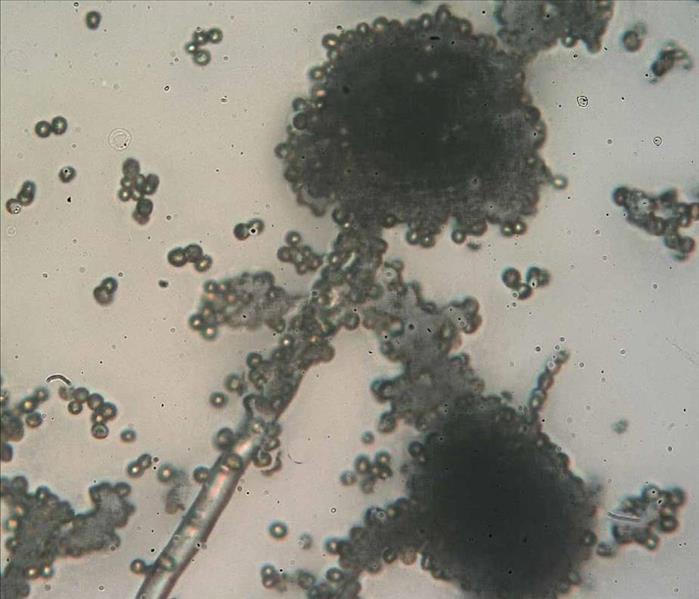 Indoors, mold needs moisture to grow; it becomes a problem only where there is water damage, elevated and prolonged humidity, or dampness.
Indoors, mold needs moisture to grow; it becomes a problem only where there is water damage, elevated and prolonged humidity, or dampness.
If you see visible mold, do not disturb it. You can inadvertently spread the mold infestation throughout your home or business. When mold is disturbed, the mold can release microscopic mold spores which become airborne and can circulate inside your building.
What to Do:
- Stay out of affected areas.
- Turn off the HVAC system and fans.
- Contact SERVPRO of Portage County for mold remediation services.
What Not to Do:
- Don’t touch or disturb the mold.
- Don’t blow air across any surfaces with visible or suspected mold growth.
- Don’t attempt to dry the area yourself.
- Don’t spray bleach or other disinfectants on the mold.
About Our Mold Remediation Services
SERVPRO of Northern Summit County, Portage County and Canton specialize in mold cleanup and restoration, in fact, it’s a cornerstone of our business. Our crews are highly trained restoration professionals that use specialized equipment and techniques to properly remediate your mold problem quickly and safely.
If You See Signs of Mold, Call Us Today – 330-677-4483
Does Your Home or Business Have Mold Problems?
9/1/2017 (Permalink)
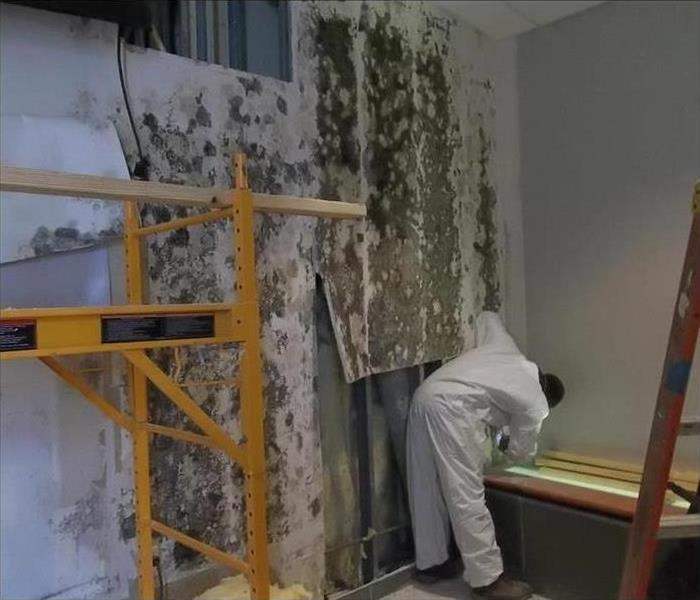 Almost all molds that grow in the built environment can produce triple helical glucan, both of which are toxic to lung cells.
Almost all molds that grow in the built environment can produce triple helical glucan, both of which are toxic to lung cells.
Microscopic mold spores naturally occur almost everywhere, both outdoors and indoors. This makes it impossible to remove all mold from a home or business. Therefore, mold remediation reduces the mold spore count back to its natural or baseline level. Some restoration businesses advertise “mold removal” and even guarantee to remove all mold, which is a fallacy. Consider the following mold facts:
- Mold is present almost everywhere, indoors and outdoors.
- Mold spores are microscopic and float along in the air and may enter your home through windows, doors, or AC/heating systems or even hitch a ride indoors on your clothing or a pet.
- Mold spores thrive on moisture. Mold spores can quickly grow into colonies when exposed to water. These colonies may produce allergens and irritants.
- Before mold remediation can begin, any sources of water or moisture must be addressed. Otherwise, the mold may return.
- Mold often produces a strong, musty odor and can lead you to possible mold problem areas.
- Even higher-than-normal indoor humidity can support mold growth. Keep indoor humidity below 45 percent.
If your home or business has a mold problem, we can inspect and assess your property and use our specialized training, equipment, and expertise to remediate your mold infestation.
6 Ways to Protect Your Home From Flooding
9/1/2017 (Permalink)
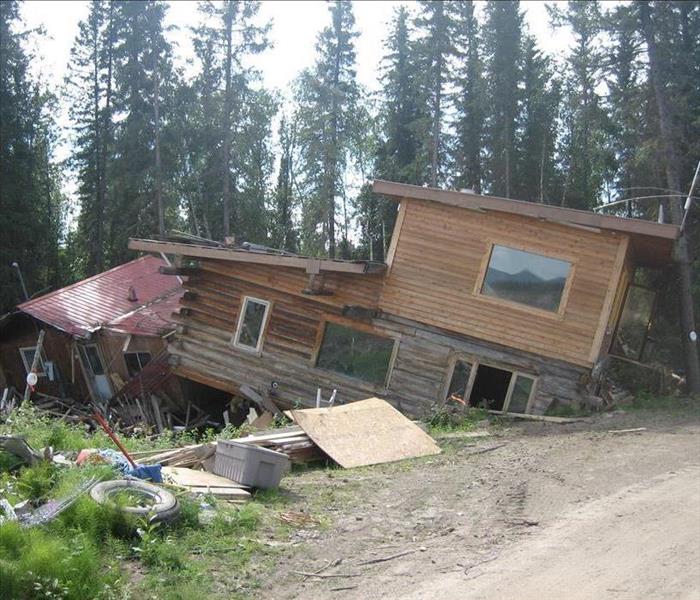 The erosive force of moving water can drag dirt from under a building's foundation, causing it to crack and tumble.
The erosive force of moving water can drag dirt from under a building's foundation, causing it to crack and tumble.
Flooding can strike anywhere and at any time, and floods are the most common and most expensive natural disaster in the U.S. Ignoring the risk means a destroyed home and belongings, and mold soon follows that.
Your first step in avoiding this risk is knowing the flood level of the home you're buying- an official measure of how high floodwaters could rise. You can find this information at FEMA's online flood maps.
Your next steps in protecting your home from flooding should include these 6 measures:
- Safeguard in-home electrical and climate systems. Raise switches, sockets, circuit breakers and wiring at least a foot above the expected flood level in your area. Modify your furnace, water heater, and any other anchored indoor equipment.
- Anchor and raise outdoor equipment. Fuel tanks, air-conditioning units and generators should be anchored above your flood level. Unanchored fuel tanks can break free, and severed supply lines will contaminate surrounding ground.
- Modify water valves. A flooded sewer system can cause sewage to back up in your home. Install an interior or exterior backflow valve.
- Determine how water flows around your house. The grading or slope of the house, the angle of the ground, can direct water to or away from your house. This is easy to determine by watching how water flows or accumulates during an average rainstorm.
- Opt for a major retrofit. If your home floods frequently and moving isn't an option, you may need to take drastic and costly measures. Either raise your home on piers or columns so the lowest floor is above flood level, wet-proof your home by installing foundation vents that would allow water to flow through the building instead of rising inside, or do some dry-proofing by applying coatings and other sealing materials to your walls to keep our floods.
- Take last-minute measures as waters rise. Clear gutters, drains and downspouts. Move furniture, rugs, electronics and other belongings to upper floors. Shut off electricity at the breaker panel. Elevate major appliances onto concrete blocks if they're in harm's way.
If you have any flood damage in your home or building, call SERVPRO of Canton today at our 24/7 Emergency Service Line - (330) 966-2377 or at our Online Help Line.
Fire Damage Cleanup
8/31/2017 (Permalink)
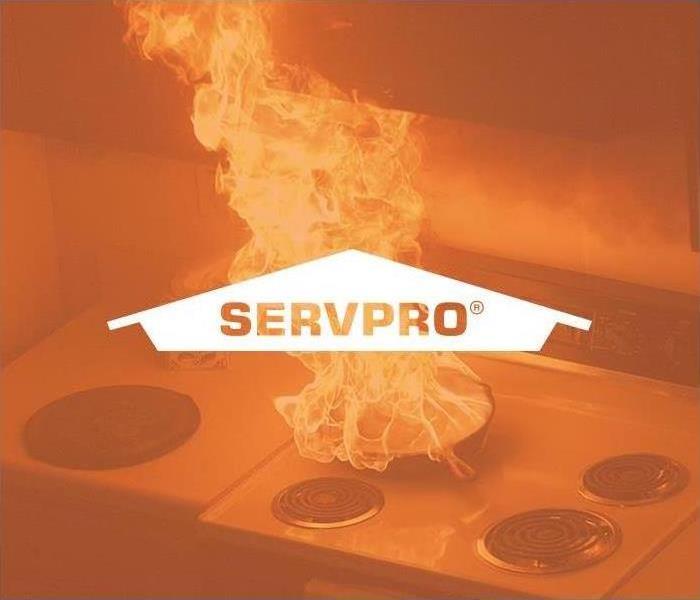 With our advanced training in restoration techniques, we have the experience and specialized equipment to quickly restore your property.
With our advanced training in restoration techniques, we have the experience and specialized equipment to quickly restore your property.
Fire damage clean up is an arduous process that often requires the proper industrial equipment and time. A standard vacuum cleaner is rarely enough. In addition, time is of the essence. In the wake of a fire, when victims are faced with insurance matters, arrangements for interim housing, and possible health concerns, homeowners are unlikely to make salvage efforts the top priority. Sadly, this could present a costly dilemma. In these cases, the services of a certified fire restoration company are invaluable.
The Institute of Inspection, Cleaning and Restoration Certification (IICRC) states that delays in fire damage clean up can have serious consequences. In addition to the obvious devastation created by heat, flames, and soot, water and smoke are powerful contaminators and destructors in their own right. Immediate intervention is critical to minimize exposure to these damaging agents in hopes of limiting restoration costs.
In addition to the structural destruction caused by the flames, acidic soot alone can cause irreparable harm to a home’s interior and belongings. But the problems don’t end there. Odor removal can present another challenge, and ceiling or box fans alone are not always powerful enough to disperse the smell of smoke. Water damage caused by first responders in an effort to extinguish the inferno further complicates matters.
For more information on fire cleanup and how to choose a restoration firm to do the damage cleanup, visit the IICRC website.
Do you need fire damage cleanup? Call our 24/7 Emergency Service line at (330) 677-4483, or request online help.
5 Levels of Mold Remediation
8/28/2017 (Permalink)
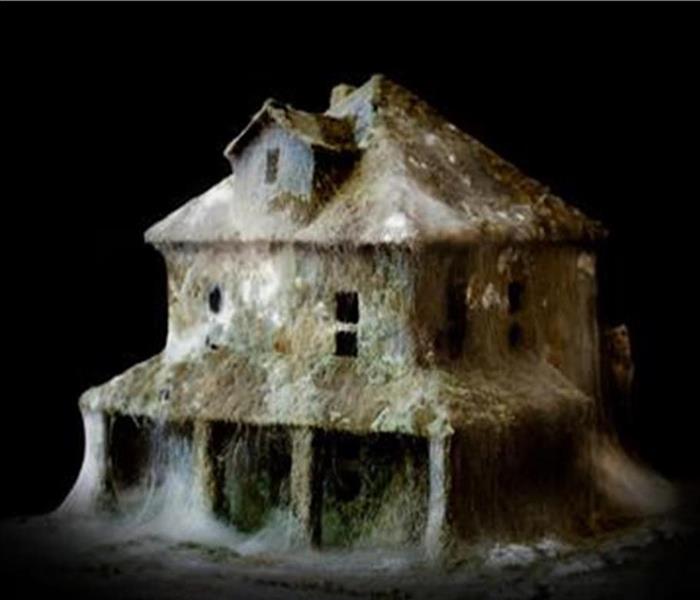 Molds destroy the material they feed on, including walls, carpets, insulation and ceilings. Unless dealt with and removed, it will continue to grow.
Molds destroy the material they feed on, including walls, carpets, insulation and ceilings. Unless dealt with and removed, it will continue to grow.
When dealing with mold contamination in your home it can be difficult to decide when a mold remediator is needed or what you can take care of yourself.
In the following 5 levels, you will have a guideline to go by when removing mold from your home:
- Level I (10 square feet or less)
Mostly found on ceilings or baseboards. Level I mold contamination may be cleaned without hiring a mold remediator, but there are several important safety precautions that you need to know: - Do not attempt cleaning mold if you suffer from asthma, allergies, or immune disorders
- Wear gloves, eye protection, and an N95 disposable respirator
- Vacate from your work area any infants less than 12 months old, individuals recovering from recent surgery, anyone with a suppressed immune system, or people with chronic lung diseases such as asthma, sever allergies, emphysema, etc.
- Contaminated materials that cannot be cleaned should be removed from your home in a sealed plastic bag to prevent an infestation in another part of your home
- Clean your work area when you’re done with a damp cloth or mop
- Make sure all areas are left dry and visibly free of mold contamination
- Level II (10-30 square feet)
About the size of one wall panel. To clean, the same precautions used in Level I should be taken. - Level III (30-100 square feet)
The size of patches of mold on several wall panels. To clean, the same precautions used in Level I and II should be taken, as well as: - Seal ventilation ducts/grills in the work area and areas directly adjacent with plastic sheeting
- Vacate everyone from your work area until work is completed.
- Level IV (greater than 100 square feet)
An infestation depending on how much greater than 100 square feet may require the assistance of a mold remediator. If not, the same requirements should be followed as were needed in levels I, II, and III along with the following: - Every worker must be trained in the handling of hazardous materials and equipped with full face respirators with high-efficiency particulate air (HEPA) cartridges, with disposable protective clothing covering both head and shoes.
- Make sure workers completely isolate their work area from the rest of your home with sheeting sealed with duct tape, including ventilation ducts/grills, fixtures, and any other openings.
- Air monitoring should be conducted prior to moving back into your home to determine if it is fit to reoccupy.
- Level V (Air Conditioners and HVAC Systems)
All remediation procedures for air conditioning units and HVAC systems should be left to professionals. Procedures for level V remediation for areas larger than 10 square feet are the same for all previous levels with the following precautionary measures added: - Shut down the HVAC system prior to remediation
- Growth-supporting materials that are contaminated, such as the paper on the insulation of interior lined ducts and filters, should be removed and sealed in plastic bags
- A variety of biocides – broad spectrum antimicrobial agents designed to prevent the growth of microorganisms – are recommended by HVAC manufacturers for use with HVAC components, such as cooling coils and condensation pans. HVAC manufacturers should be consulted for the products they recommend for use in their systems.
Do you have mold in your home or business? With questions or if you need a mold remediator, call our 24/7 Emergency Service line at (330) 677-4483. Request help online by clicking here.
Water Back-Up, Overflow or Discharge? Homeowners' Claims
8/22/2017 (Permalink)
Last month we talked about how to protect your home from flood damage. Hopefully the tips served you well, but here are some tips on what causes a water back-up or overflow and whether or not there is coverage for such a loss.
Is it a water back-up, an overflow or discharge?
A back-up is a build-up caused by a stoppage in the flow. Something prevents the water from continuing down its path, so it is forced to reverse direction and go back the other way.
- Causes: A collapsed drain pipe can cause a back-up because water can no longer proceed down its normal course. A blockage can also cause a back-up. The blockage prevents the water from going forward. Both of these factors force the water to reverse direction.
An overflow is when excess or surplus is not able to be accommodated by an available space.
- Causes: The space is filled to capacity and water then spreads beyond its limits. A bath tub left running creates an overflow, as well.
Discharge is what happens when water is released from plumbing or appliances and then floods your home.
- A leaking pipe discharges water from the hole in the pipe.
The ISO HO 00 03 provides coverage for water damage that is the result of a discharge or overflow of a plumbing, heating, air conditioning, or household appliance if it is on the resident’s premises. This covers:
- Pipes that leak behind walls
- Floors, or ceilings
- Washing machines and dishwashers that overflow
- Toilets that overflow
- Storm drains off premises that overflow due to high rains or floods
It is important to note that a sump, sump pump or related equipment, or a roof drain, gutter or downspout or similar equipment is not considered a plumbing system or household appliance.
A discharge or overflow caused by a storm drain, water, steam, or sewer pipe is covered as well if it is off the premises.
How to Keep Safe During a House Fire
8/17/2017 (Permalink)
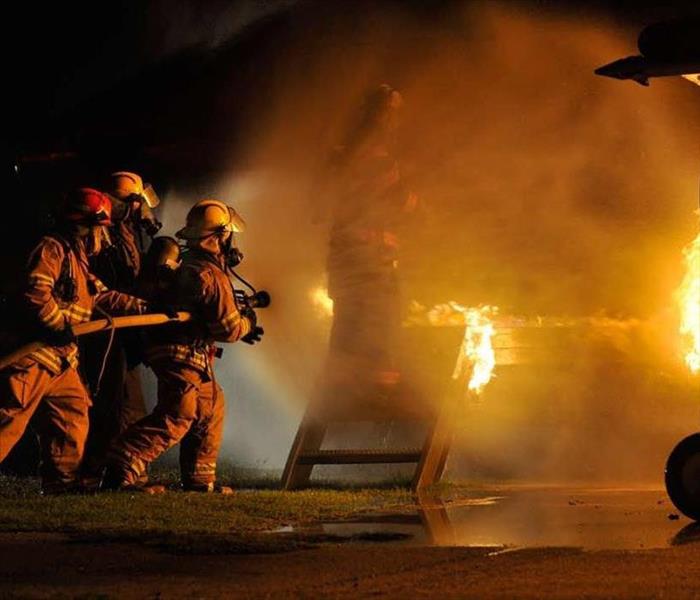 In less than 30 seconds a small flame can turn into a major fire. It only takes minutes for thick black smoke to fill a house or for it to be engulfed
In less than 30 seconds a small flame can turn into a major fire. It only takes minutes for thick black smoke to fill a house or for it to be engulfed
You may not think you'll ever fall victim to a house fire, but it's better to be prepared and know what to do to avoid panicking if it happens to you. To increase your chances of survival, follow these steps:
Keeping safe in your house during a fire:
- React as soon as you hear your smoke alarm go off. If you hear your smoke detector or see fire, exit your home as safely as possible. Do not stop to grab your belongings. Your only concern should be to get out as quickly as possible.
- Safely exit through doors. If you see smoke under the door, do not open the door to escape. If you do not see smoke, put the back of your hand to the door to feel for heat. If it is cool, open slowly and pass through. If you see fire, close the door to protect yourself from the fire and search for another exit.
- Prevent yourself from smoke inhalation. Get low to the floor and crouch or crawl on your hands and knees to evade the toxic smoke, avoiding disorientation and unconsciousness. If you must walk through the smoke, cover your nose and mouth with a shirt or towel.
- Stop drop and roll if your clothes catch fire. Immediately stop what you're doing, drop flat on to the ground and roll around until you smother the fire. Cover your face with your hands as you're rolling to protect yourself.
- Ward off the smoke if you can't get out. If you cannot escape, you can always reclaim some measure of control and stay safe, even if you feel trapped. Close the door and cover all vents and cracks with a cloth or tape to keep the smoke out.
- Call for help from a second story window. If you are trapped in a second story room, do what you can to get yourself to an area where people will be able to hear or see you. Take a sheet- preferably white- and hang it out the window to signify you need help. Be sure to close the window to the fresh oxygen doesn't draw the fire towards you. Put a blanket or towel at the base of the door to prevent the smoke from coming underneath.
- Escape from a second story window if you can. If you have an escape ladder, toss it down the side of the house. If you must go out the window, look for a ledge you can get yourself onto and hang down from your hands, facing the side of the building. Let yourself fall to safety.
What to do once you exit your home:
- Do a head count. Make sure everyone is accounted for. If anybody is missing, only re-enter the building if it is safe to do so. Tell the first responders immediately on their arrival if you are afraid someone is missing.
- Call 911. Use your cellphone or call from a neighbor's house.
- Do an injury assessment. After making the call and the resources are coming, check yourself and your family for any injuries. If there are, do what you can to address them until the fire department arrives.
- Get away from the structure. Keep a safe distance between you and the fire.
Preventing future house fires:
- Form and practice your family's escape plan. Have a plan of escape in the event of a fire. Practice at least twice a year to get comfortable with the routine. Plan to find two ways to escape from each room. Practice escaping by crawling, being in the dark and having your eyes closed.
- Make sure your home is prepared. Check your smoke detectors are working and always have fresh batteries. Make sure your windows can easily be opened and that screens can be quickly removed. Everyone in your family should be able to open and close all windows. Buy reliable collapsible ladders in case of higher level escapes.
- Practice safe behaviors. Teach your children that fire is a tool, not a toy. Always be in the kitchen when you're cooking. SO not smoke in the house and make sure you put out your cigarettes entirely. DIspose of any electronics with frayed wires. Avoid lighting candles unless they're directly in your line of vision. Always check that the gas is turned off as well as any other wired electronics. Finally, try to use a lighter instead of matchsticks.
For more information as well as a community Q&A, click here for the source of the above information.
HVAC Compressor Damage: Lightning or Wear & Tear?
8/15/2017 (Permalink)
In the summer months, when severe weather is most prevalent, property carriers see an increase in claims for lightning damage to HVAC equipment, and most often to the compressor.
HVAC compressor damage due to lightning is commonly misdiagnosed. More often than not, an HVAC claim that is originally reported as damaged by lightning is ultimately found to have suffered damage due to some other cause of loss.
No matter the time of year, one of the most common culprits of compressor failure is mechanical damage due to age-related wear and tear. Nearly 43% of all compressors (regardless of how the damage is initially reported) fail due to this cause of loss.
Considered the “heart” of the HVAC system, the compressor is not only critical to proper system function, but can often be impossible to repair and expensive to replace. Moreover, without understanding the root cause of compressor failure, the simple act of replacing this component may not ultimately resolve the overarching issue. When handling HVAC claims, it is critical to understand what caused the compressor to fail before agreeing on a scope of repair for settlement.
For additional information on mechanical damages versus electrical damages, click here to the source of this information.
Vehicles After Flooding: Filing a Claim
8/14/2017 (Permalink)
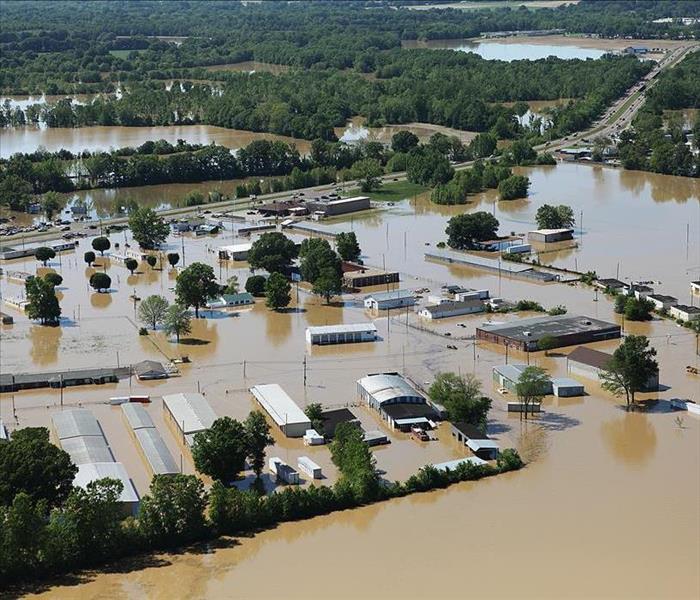 No region is safe from flooding. All 50 states are subject to flash floods.
No region is safe from flooding. All 50 states are subject to flash floods.
In the aftermath of a natural disaster, it is important for consumers to be aware of the warning signs of a flood damaged vehicle. If you are in the market to buy a used vehicle, be sure to inspect it carefully.
The following tips on filing a claim will help those with flooded vehicles after a storm:
- Contact your insurance agent as soon as possible. Have your policy readily available and find out whether the damage is covered under the terms of your policy and how long you have to file a claim.
- Your automobile insurance policies cover flooding if you have purchased comprehensive coverage. If you only have liability coverage, your vehicle is not covered for flooding.
- Minimize your losses and document the damage. Take photos of any damage and then make whatever reasonable temporary repairs that are needed.
- Remember that flooding is generally not covered under standard homeowners and renters insurance policies. Flood insurance is a separate policy through FEMA’s National Flood Insurance Program and some private insurers.
- Ask for identification from any agents, adjusters or contractors. Do not sign any contracts for repairs until you have been instructed to do so by your adjuster and you have called the Better Business Bureau in your area.
- Don’t be afraid to file a claim. Storms are considered “Acts of Nature” and an insurance company cannot cancel, refuse to renew or increase the amount of a premium on a homeowners policy based solely on this type of incident.
Do you have storm damage? Contact our SERVPRO franchise at (330) 677-4483 or request help online.
Determining Death Coverage: Are Bodily Fluids Considered a Pollutant?
8/9/2017 (Permalink)
Are bodily fluids considered a pollutant?
It has been held that living, organic irritants or contaminants do not constitute pollutants under the policy definition because the irritants specifically identified in the definition, namely, "smoke, vapor, soot, fumes, acids, alkalis, chemicals and waste," are primarily inorganic in nature.
The current trend is to view pollutants and the pollution exclusion in connection with environmental issues. Therefore, bodily fluids are not a pollutant, meaning there is coverage in many instances.
For further details from a related article, click here.
Do You Need a Mold Remediator?
8/9/2017 (Permalink)
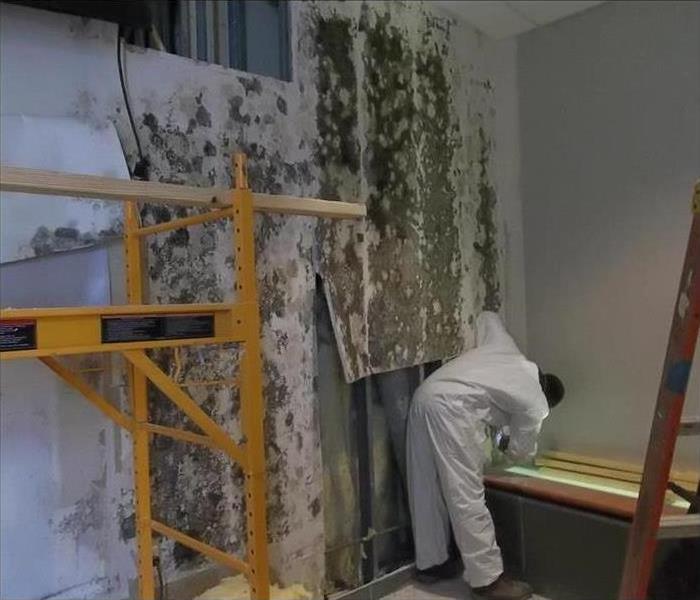 Mold spores thrive on moisture. They can quickly grow into colonies when exposed to water, producing allergens and irritants.
Mold spores thrive on moisture. They can quickly grow into colonies when exposed to water, producing allergens and irritants.
If you suspect mold in your home or business, you're probably anxious to get the problem taken care of as soon as possible. If you have small children, older adults or animals, it is even more important to effectively rid your home of mold so it doesn't affect their health.
When choosing a reliable mold remediator, it is important to consider the following tips:
- Only choose mold remediators that are certified. To ensure the highest quality of service, go with mold remediators that perform all of their own inspections and remediations. Generally, those who have been in business for a while and who have worked in a variety of settings including commercial and residential areas will be able to perform the most reliable services.
- Find a mold remediator that will inspect your home before they begin work. Later, the mold remediators should perform both an air-quality check and a swab check to test for mold. SERVPRO, among other mold remediation companies, will test for asbestos and lead as well as different types of mold. Make sure that contact information is included in the proposal so you’ll know who to get in touch with in case of problems.
- Check for a warranty. Check that the mold remediator also offers to come back and redo any area that shows signs of mold within six months to a year.
It is important to take some extra time to choose the best mold remediator to avoid further serious problems in your home or business.
If you are experiencing troubles with mold, call SERVPRO of Portage County at our 24/7 Emergency Service number, 800-648-1212 or request help online.
Windstorm Damage: Whose Insurance Covers the Loss?
7/28/2017 (Permalink)
 Straight-line winds are common with the gust front of a thunderstorm or originate with a down-burst from a thunderstorm.
Straight-line winds are common with the gust front of a thunderstorm or originate with a down-burst from a thunderstorm.
Yes, windstorm damage is covered on a standard homeowner's insurance policy. But whose homeowner's insurance policy covers the loss?
First, it is important to understand what windstorm insurance policies cover. Windstorm insurance is a special type of property and casualty insurance designed to cover damages caused by high winds. Windstorm insurance may cover damages from hurricane-force winds, tornadoes, hail and other weather events that are accompanied by wind gusts that exceed 35 miles per hour.
A hypothetical tree falls on your house.
- Scenario 1: your tree falls on your house. Your homeowner's policy will provide coverage up to your policy limits, after you pay the deductible. The coverage extends to cover damage to your main home, garage, shed or other additional buildings and structures such as a fence. If there is damage to the structure of the house, debris removal is also covered, up to policy limits.
- Scenario 2: your tree falls on your neighbor's house. The basic rule is that the insurance policy of the property that was damaged pays for the loss.
- Scenario 3: your neighbor's tree fell on your house. Your homeowner's insurance policy should pay for any damage per the property claim.
Please note that homeowners insurance usually won't cover a loss caused by negligence or a maintenance-related issue. So if the tree was rotting and ready to fall down before the storm, homeowners insurance likely would not cover the damage the tree caused to your home.
Is Hazard Insurance the Same as Homeowners?
7/27/2017 (Permalink)
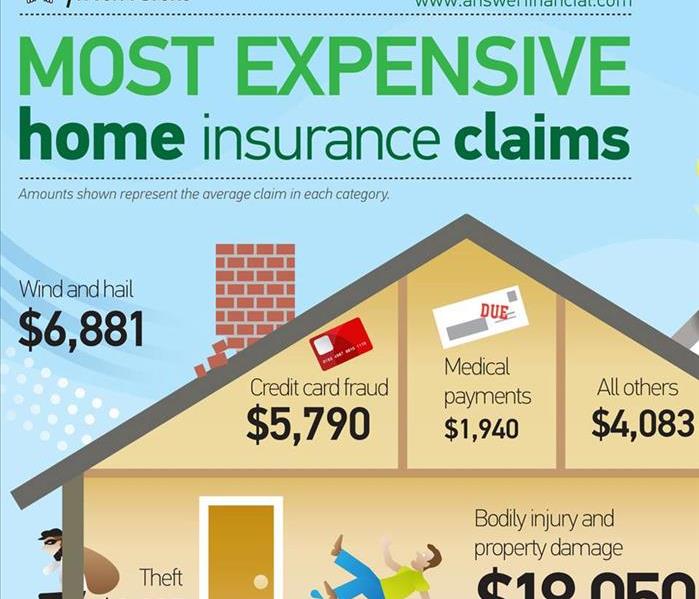 For maximum protection against the unexpected, a reliable homeowners insurance policy is the way to go.
For maximum protection against the unexpected, a reliable homeowners insurance policy is the way to go.
As a home owner, you will likely have a need for this insurance at some point in your lifetime. Lending companies tend to use the terms "hazard insurance" and "homeowner's insurance" interchangeably, but there is a definable difference between the two.
Hazard insurance, which protects you financially from the effects of damage to the structure of your home from hazards such as natural events, vandalism, and fire, is usually bought PART OF your homeowner's insurance policy. Generally hazard coverage is not sold separately but is combined with liability and contents coverage as a package.
There are certain hazards that are not covered by homeowner’s insurance and they are listed as exemptions in the policy. Examples include damage caused directly by pollution, floods, and earth movement. Open perils policies provide insurance coverage for any reason not specifically excluded in the policy. A named perils policy, on the other hand, provides coverage only for the perils listed. A homeowners named perils policy typically covers 16 named perils including fire, theft, windstorms and vandalism.
A standard homeowners HO3 policy covers the structure of your home under open perils and contents such as clothes, furniture, appliances and books under named perils. A standard homeowners HO5 policy covers the structure and contents under open perils. Many insurance companies have modified versions of the HO3 and HO5 policies so if you have questions about your homeowners policy coverage, be sure to speak with your insurance agent.
For additional information from a related article, click here.
Portage County Smoke and Soot Cleanup
12/1/2016 (Permalink)
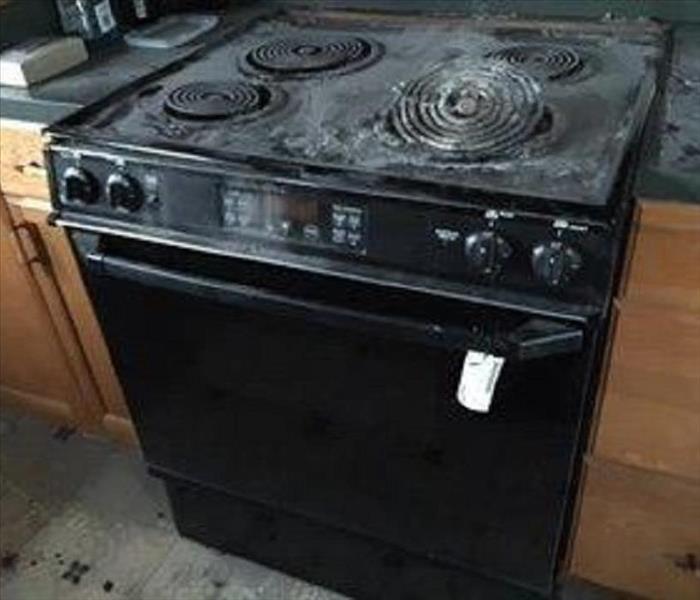 Smoke and Soot Damage Can Cause a Pervasive Odor in Your Portage County Home.
Smoke and Soot Damage Can Cause a Pervasive Odor in Your Portage County Home.
Smoke and soot is very invasive and can penetrate various cavities within your home, causing hidden damage and odor. Our smoke damage expertise and experience allows us to inspect and accurately assess the extent of the damage to develop a comprehensive plan of action.
Smoke and soot facts:
- Hot smoke migrates to cooler areas and upper levels of a structure.
- Smoke flows around plumbing systems, seeping through the holes used by pipes to go from floor to floor.
- The type of smoke may greatly affect the restoration process.
Different Types of Smoke
There are two different types of smoke–wet and dry. As a result, there are different types of soot residue after a fire. Before restoration begins, SERVPRO of Portage County will test the soot to determine which type of smoke damage occurred. The cleaning procedures will then be based on the information identified during pretesting. Here is some additional information:
Wet Smoke – Plastic and Rubber
- Low heat, smoldering, pungent odor, sticky, smeary. Smoke webs are more difficult to clean.
Dry Smoke – Paper and Wood
- Fast burning, high temperatures, heat rises therefore smoke rises.
Protein Fire Residue – Produced by evaporation of material rather than from a fire
- Virtually invisible, discolors paints and varnishes, extreme pungent odor.
Our Fire Damage Restoration Services
Since each smoke and fire damage situation is a little different, each one requires a unique solution tailored for the specific conditions. We have the equipment, expertise, and experience to restore your fire and smoke damage. We will also treat your family with empathy and respect and your property with care.
Have Questions about Fire, Smoke, or Soot Damage?
Call Us Today – 330-677-4483
IICRC Certified Firm
11/15/2016 (Permalink)
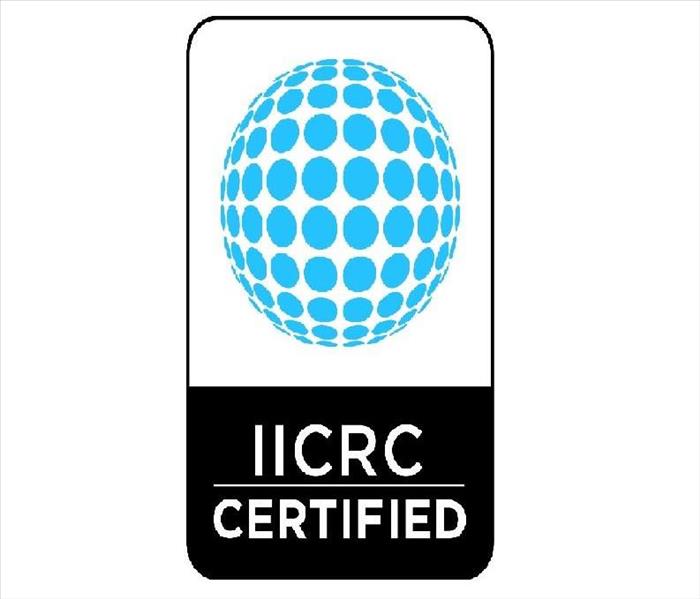 We are an IICRC Certified Firm
We are an IICRC Certified Firm
SERVPRO of Portage County is an IICRC firm. The Institute of Inspection, Cleaning and Restoration Certification (IICRC) creates the standards for the restoration industry and provides training and certification to restoration companies. IICRC Certified Firms have the right to display the IICRC Certified Logo.
IICRC Certified Firms must
- Present accurate information to consumers and conduct business with honesty and integrity.
- Require a technician on all jobs who has been formally trained and passed all required tests.
- Require a continuing education program to keep technicians up-to-date on the latest changes in the industry.
- Maintain liability insurance to protect all parties in the event of an accident.
- Maintain a written complaint policy and agree to Better Business Bureau or similar arbitration to resolve disputes, and accept the conclusions and recommendations of arbitration.
The IICRC Develops The Standards For The Restoration Industry
The IICRC has been the driving force in establishing the main industry standards and reference guides for professional carpet cleaning, water damage restoration and mold remediation. These IICRC standards take years to develop and require the coordination of experts in the field: manufacturers, industry organizations, insurance professionals, training schools, contractors, and public health professionals.
Every five years, the standards are reviewed and updated. The water damage restoration field changes rapidly with advancements in technology and science, and therefore the standards must evolve to keep pace.
Restoring Your Portage County Commercial Property After A Water Damage Event
10/13/2016 (Permalink)
 Commercial Water Damage Events Present Unique Challenges
Commercial Water Damage Events Present Unique Challenges
Flooding and water damage events at Portage County commercial properties are often complex with numerous issues that require a knowledgeable and flexible response. Whether we’re dealing with a relatively small water cleanup scenario or a large scale event, we work quickly to assess each unique situation and isolate the damaged area. In many instances, normal operations can continue in a temporary space while we restore your facility.
Restoring Commercial Properties Presents Unique Challenges
Our professionals are trained to be mindful of legal and environmental concerns and strive to fully restore the damaged area while working within your budgetary constraints. We understand that every hour spent cleaning up is an hour of lost revenue and productivity. So when an emergency situation arises in your business, give us a call and we’ll be there fast with the help you need.
September is National Preparedness Month
9/7/2016 (Permalink)
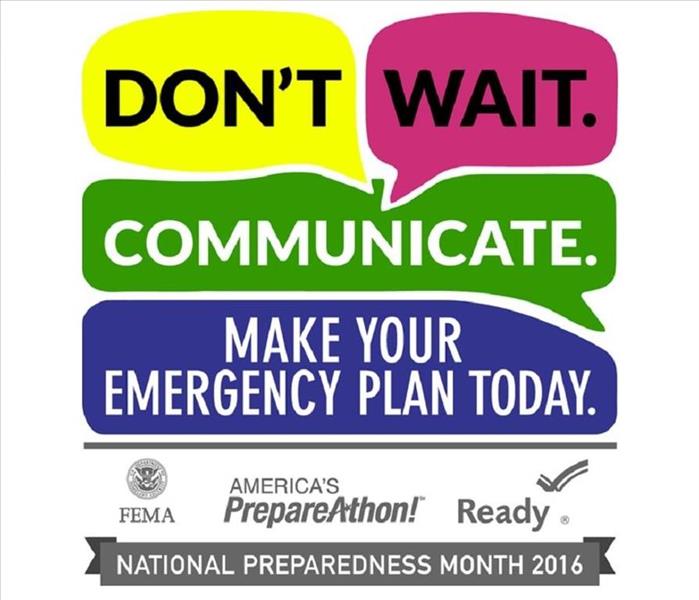 Consider ways that you can prepare for potential emergencies during National Preparedness Month
Consider ways that you can prepare for potential emergencies during National Preparedness Month
Did you know that September is National Preparedness Month? National Preparedness month encourages individuals be prepared for potential emergency situations. The more that you are prepared for the unexpected, the more equipped you will be to deal with situations quickly and effectively and to limit the damage. AT SERVPRO we understand the challenges and stresses of unexpected disaster. National Preparedness Month is a great time to put together readiness plans for potential emergency situations that could affect your home or business. It is a time to consider how your family could stay in touch if separated when an emergency occurs, how you can work together with your neighbors and community in a disaster situation, and how you can assist those who are particularly vulnerable during an emergency, such as children and older adults. The best way to mitigate a disaster is to be prepared! You can find lots of great resources at https://www.ready.gov/september.
Follow us on social media
6/16/2016 (Permalink)
 Follow us on social media!
Follow us on social media!
SERVPRO of Portage County is active on social media, and we would love for you to follow us! On our social media pages, you can find relevant safety, cleaning, and remodeling tips, local and industry news, event information, before and after pictures of completed jobs, pictures of our crew, volunteer and fundraising campaigns, and more! We are currently on Facebook and LinkedIn, with more platforms to come. Social media allows us to interact with our customers, local businesses, and industry partners in new and exciting ways. We love to hear your thoughts and feedback through social media, and we welcome comments on industry topics and content you would like to hear more about. Please click the links below and follow our pages to receive the latest updates from us!
Facebook: https://www.facebook.com/SERVPRON.SummitCounty
LinkedIn: https://www.linkedin.com/company/restoration-resources-inc-dba-SERVPRO-n-summit-county-portage-county-and-canton
Factors to consider when faced with a biohazard cleanup
4/7/2016 (Permalink)
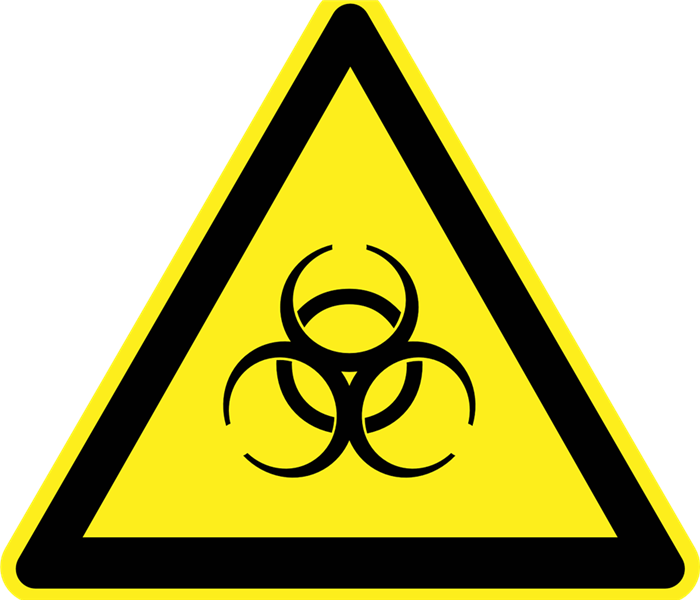 If you are faced with a biohazard cleanup, our professional, compassionate staff can guide you through the process.
If you are faced with a biohazard cleanup, our professional, compassionate staff can guide you through the process.
If you are faced with a biohazard cleanup, such as a trauma scene, sewage backup, or hoarding situation, here are some key factors to consider:
- Avoid exposure to any contaminants present. There are serious health risks associated with exposure to blood, bodily fluids, animal waste, sewage, and other biohazardous materials. Treat all potentially hazardous materials as if they are contaminated.
- Assess ways to secure your personal safety and contain the situation, such as turning off the HVAC system and avoiding standing water or sagging ceilings.
- Before attempting to clean up a trauma scene yourself, particularly when it involves a loved one, consider the long-term mental and emotional consequences of doing so. The cleanup process can be emotional and traumatic in itself. Biohazard cleanup professionals are trained to deal with trauma situations with compassion and discretion.
- If you would like assistance with a biohazard cleanup, our trained professionals can assess the situation, provide a no-cost estimate, and clean the affected areas and dispose of the waste in accordance with federal and state regulations.
Flood Safety Awareness Week is March 13-19
3/17/2016 (Permalink)
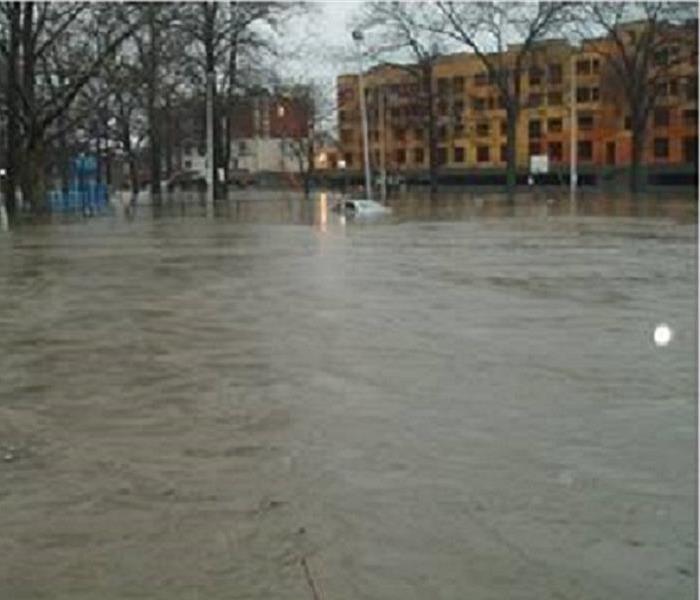 Floods can be unpredictable and cause a lot of damage. Stay informed and prepared as flood season approaches!
Floods can be unpredictable and cause a lot of damage. Stay informed and prepared as flood season approaches!
March 13-19 is Flood Safety Awareness Week. According to the National Weather Service, "Each year, more deaths occur due to flooding than from any other severe weather related hazard. The main reason is people underestimate the force and power of water. More than half of all flood related deaths result from vehicles being swept downstream. Of these, many are preventable." As flood season approaches, now is a great time to review such topics as the dangers of flooding, driving through water, and flood insurance. Additional resources are available at http://www.weather.gov/okx/FloodAwarenessWeek2016.
SERVPRO's Reconstruction and Remodeling Services
2/18/2016 (Permalink)
 A finished kitchen remodel that was done by our reconstruction team!
A finished kitchen remodel that was done by our reconstruction team!
Did you know that in addition to water mitigation, fire cleanup, and mold remediation, SERVPRO also offers reconstruction services? After our pros are done with drying out a home or removing smoke-damaged materials, we can put homes back together just like they were before the damage occurred. The convenience and savings of working with one company to assist with mitigation and repairs can be significant. In addition to reconstruction after damage, we also do general home remodeling. Have you been considering remodeling your kitchen? We can help. Does your bathroom need an update? We do that too. From drywall to painting to framing and much more, we can assist with your reconstruction project!
Here are just some of the reconstruction services SERVPRO offers:
- Drywall repair and installation
- Floor repair and replacement
- Kitchen and bath installation and remodeling
- Cabinet and trim replacement
- Insulation installation
- Ceiling repair
- Fixture replacement
- Painting
Frozen Pipe Bursts Part 3: What to do if a Frozen Pipe Bursts
2/2/2016 (Permalink)
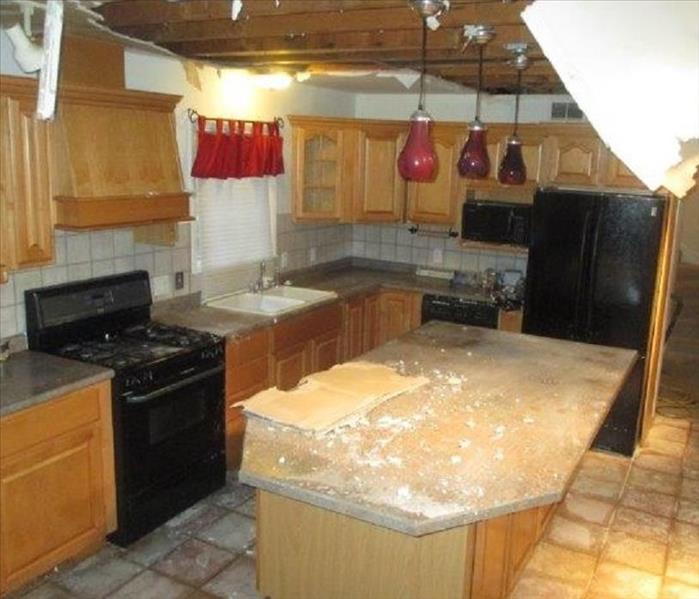 Damage resulting from a pipe burst due to a frozen pipe
Damage resulting from a pipe burst due to a frozen pipe
Taking preventative measures and noticing frozen pipes in time to thaw blockages are key to avoiding pipe bursts. Unfortunately, sometimes disasters occur despite our best efforts at prevention. In the unfortunate event that a frozen pipe does burst, you can mitigate the damage by following these important tips:
- Turn off the main water supply immediately.
- If the water is flowing near any electrical outlets or conductors of electricity, you should also shut off the electricity.
- Contact a plumber to repair the burst pipe.
- Remove the water. Use buckets, towels, and a wet/dry vacuum to remove water from the affected area.
- Act quickly! The longer there are wet materials in your home, the greater chance there is for mold, warping, and more serious damage.
- If you feel that the water damage is too much for you to handle on your own or you would like assistance in the cleanup, contact the qualified water mitigation specialists at SERVPRO to assist you.
If you or someone you know is faced with a pipe burst, the experts at SERVPRO can help to mitigate the damage and restore your home!
Sources:
http://www.policyexpert.co.uk/insurance-blog/house-home/pipes-burst-freeze/
https://www.washingtonpost.com/local/what-to-do-if-a-frozen-pipe-bursts-in-your-home/2015/02/19/af9b87be-b857-11e4-aa05-1ce812b3fdd2_story.html
Frozen Pipe Bursts Part 2: Thawing Frozen Pipes
1/5/2016 (Permalink)
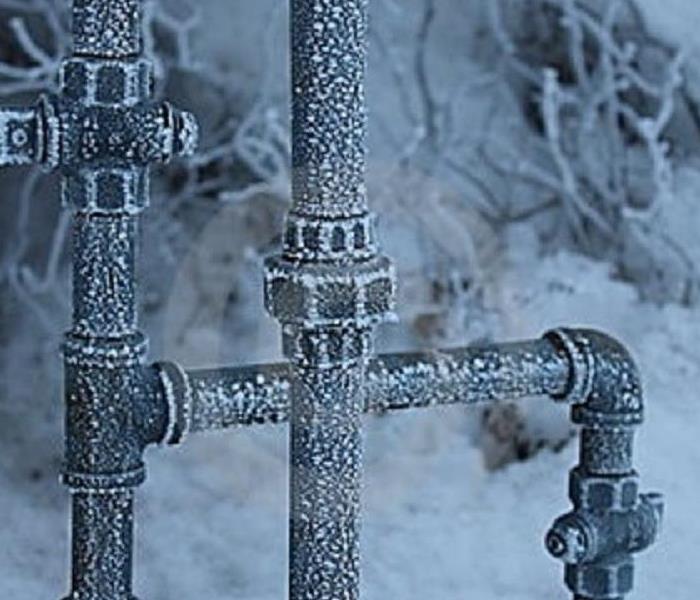 Act quickly if you discover frozen pipes in your home to avoid damage due to pipe bursts.
Act quickly if you discover frozen pipes in your home to avoid damage due to pipe bursts.
Frozen Pipe Bursts Part 2: Thawing Frozen Pipes
In the previous blog post, we discussed how to prevent frozen pipes in order to avoid a pipe burst. If a frozen pipe occurs despite your best efforts at prevention, there are still steps that you can take to thaw the affected pipe before a burst occurs and the situation becomes a much bigger issue. You will notice a pipe may have frozen when after turning on a tap no water or a very small trickle comes out.
- The first thing you should do is turn off the main water supply. If you don’t already know where your main water supply is, locate it now in order to be able to act quickly if you ever find yourself in a situation where your pipes have frozen.
- Locate the frozen pipe by turning on taps one at a time to see if water flows out. If water flows in all areas of the house except for one, trace the line from the blocked faucet to areas that may be more exposed to cold. If water does not flow out of any of the taps, the frozen pipe may be located near the water meter.
- Once you have located the affected area, use a blow dryer, heat lamp, or other heat source to apply heat to the affected area. Do NOT use a blowtorch or any other device with an open flame.
- Keep the faucet open and apply heat from the open tap toward the blockage. Continue to apply heat until the water flows from the faucet at normal pressure.
- If you are struggling to find the blockage or are unsure if the pipe is clearing properly, contact a plumber.
Even during a close call with a frozen pipe, if you follow these steps and put the preventative tips from the previous blog post into action, you can boost your chances of avoiding water damage to your home due to a pipe burst.
Sources:
http://www.oldhouseweb.com/how-to-advice/thawing-frozen-pipes.shtml
http://www.redcross.org/prepare/disaster/winter-storm/preventing-thawing-frozen-pipes
Frozen Pipe Bursts Part 1: Preventing Frozen Pipes during Winter Months
12/16/2015 (Permalink)
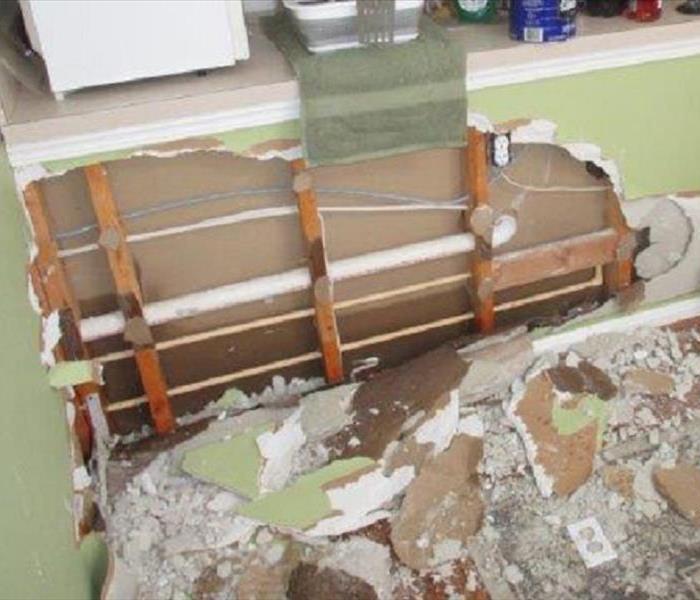 Damage that occurred as a result of a pipe burst due to a frozen pipe.
Damage that occurred as a result of a pipe burst due to a frozen pipe.
Frozen pipes can mean big problems for your home. As water freezes, it expands and can exert up to 2,000 pounds of pressure per square inch! That pressure can cause pipes to burst and water to flow into your home, potentially causing extensive damage.
Taking preventative measures during the cold winter months is the best course of action to avoid frozen pipe bursts. The pipes that are most susceptible to freezing are those that are outdoors, are exposed to exterior walls, or are in unheated areas like under cabinets or in attics or crawl spaces. In order to prevent frozen pipes in those areas, follow these tips:
- Drain water from hoses, water sprinklers, and other outdoor lines when the weather starts to cool down and they will no longer be in use.
- On particularly cold days, open cabinet doors to allow warm air to flow around pipes and turn on the taps slightly to allow a slow drip to run through the faucets.
- Make sure that there is insulation present in areas around pipes that are more susceptible to cold weather.
- Consider installing heating cable, heating tape, newspaper, or another form of insulation around exposed pipes.
- If you are leaving for vacation, don’t set the temperature any lower than 55°F.
Putting these tips into practice will significantly reduce your chances of having a pipe freeze in your home, and thereby, avoid the larger and much more costly and inconvenient problem of a pipe burst.
Sources:
http://homerepair.about.com/od/plumbingrepair/ss/thaw_frzn_pipe.htm#step1
http://www.redcross.org/prepare/disaster/winter-storm/preventing-thawing-frozen-pipes
Holiday Fire Safety Tips
12/4/2015 (Permalink)
 Stay safe this holiday!
Stay safe this holiday!
As the holiday season approaches, so does the peak time of year for cooking and candle fires. Cooking equipment is the number one cause of home and workplace fires. Thanksgiving, Christmas Day, and Christmas Eve are the three peak days for cooking fires. Candle fires peak on Christmas Day, Christmas Eve, and New Year’s Eve. SERVPRO reminds you and your family to stay safe this holiday season by following these fire safety tips:
Cooking Safety Tips
· Be especially careful when frying food. Frying is the greatest fire risk.
· Be aware that electric ranges cause more fires than gas ranges.
· Never leave cooking unattended. Unattended cooking causes 90% of kitchen fires.
· Clean thoroughly to prevent grease buildup.
Candle Safety Tips
· Please candles a safe distance from flammable objects. The leading cause of candle fires is placing candles too close to something that can burn, such as curtains or furniture.
· Do not leave candles unattended.
Smoke Detector Safety Tips
· Test smoke detectors once per month. Having working smoke alarms reduces one's chance of dying by fire by about half.
· Change batteries twice per year.
· Replace smoke detectors every 10 years.
· Be sure you have smoke detectors on each level of the home and placed near or inside each bedroom at a high point in the room.
Fire Extinguisher Safety Tips
· Follow the acronym P.A.S.S. – Pull the pin, Aim at the base, Squeeze the lever, & Sweep from side to side
· The best type of fire extinguisher for home use is a multipurpose "ABC" extinguisher, which uses a dry powder that is able to put out most types of fires.
· Fire extinguishers should be placed in plain sight close to ground level in areas of the home that are more prone to fires, such as the kitchen and garage.
· Keep a fire extinguisher in each occupied bedroom to help you and your family escape if a fire occurs during the night.
· Although fire extinguishers should last for 5-15 years, check the gauge regularly to make sure the needle is in the green area and inspect the pin, hose, and handle periodically.
Sources:
Akron Fire Department General Fire Safety presentation materials
http://www.nfpa.org/safety-information/for-consumers/causes/cooking
http://www.nfpa.org/research/reports-and-statistics/fire-causes/candles
SERVPRO Offers GREEN CLEANING
3/16/2015 (Permalink)
Did you know SERVPRO® offers “GREEN” alternatives for some of our products? SERVPRO® is a proud member of the EPA’s Design for Environment initiative (EPA/DFE). The EPA/DFE has established set criteria for formulating environmentally friendly cleaning products. The initiative is designed to allow chemical formulators (such as our very own in-house chemists) a resource to formulate environmentally friendly cleaning products using environmentally friendly raw materials.
Some of the "Green" products SERVPRO® offers are:
Benefect® Botanical Disinfectant
SERVPRO® All Surface Green Clean
SERVPRO® Carpet & Upholstery Green Clean
SERVPRO® Window Green Clean
Contact us for more product information!
Prevent Christmas Tree Fires This Holiday Season!
12/9/2014 (Permalink)
Christmas tree safety tips
From the National Fire Protection Association: http://www.nfpa.org/ Each year, fire departments respond to an average of 210 structure fires caused by Christmas trees. Carefully decorating Christmas trees can help make your holidays safer.
Picking the tree
- If you have an artificial tree, be sure it is labeled, certified, or identified by the manufacturer as fire retardant.
- Choose a tree with fresh, green needles that do not fall off when touched.
Placing the tree
- Before placing the tree in the stand, cut 1" - 2" from the base of the trunk.
- Make sure the tree is at least three feet away from any heat source, like fireplaces, radiators, candles, heat vents or lights.
- Make sure the tree is not blocking an exit.
- Add water to the tree stand. Be sure to add water daily.
Lighting the tree
- Use lights that have the label of an independent testing laboratory. Some lights are only for indoor or outdoor use, but not both.
- Replace any string of lights with worn or broken cords or loose bulb connections. Connect no more than three strands of mini string sets and a maximum of 50 bulbs for screw-in bulbs. Read manufacturer’s instructions for number of LED strands to connect.
- Never use lit candles to decorate the tree.
- Always turn off Christmas tree lights before leaving home or going to bed.
After Christmas
- Get rid of the tree when it begins dropping needles. Dried-out trees are a fire danger and should not be left in the home or garage, or placed outside against the home. Check with your local community to find a recycling program. Bring outdoor electrical lights inside after the holidays to prevent hazards and make them last longer.
Tips for Winterizing Your Home!
11/3/2014 (Permalink)
 Winterize Your Home to Avoid Pipe Breaks!
Winterize Your Home to Avoid Pipe Breaks!
Cold Weather can have a huge impact on businesses and homes that aren’t protected. Heavy precipitation, freezing temperatures and damaging winds can all have a negative impact on your property. To help avoid costly and time-consuming damages due to the weather, consider the following tips while winterizing this year:
Keep cabinet doors open during cold spells. This allows warm air to circulate around pipes.Keep a slow trickle of water flowing through faucets, especially if the pipes for faucets run through unheated or un-insulated areas of your home and/or business.Consider shutting off outdoor faucets. Find the shut off valve in the basement
or crawl space and turn it to “off”.If you follow the previous step, then open the outdoor faucet to help ensure it drains completely and the inner valve is shut off.
Do's and Don'ts to follow after a Flood or other Water Loss
9/8/2014 (Permalink)
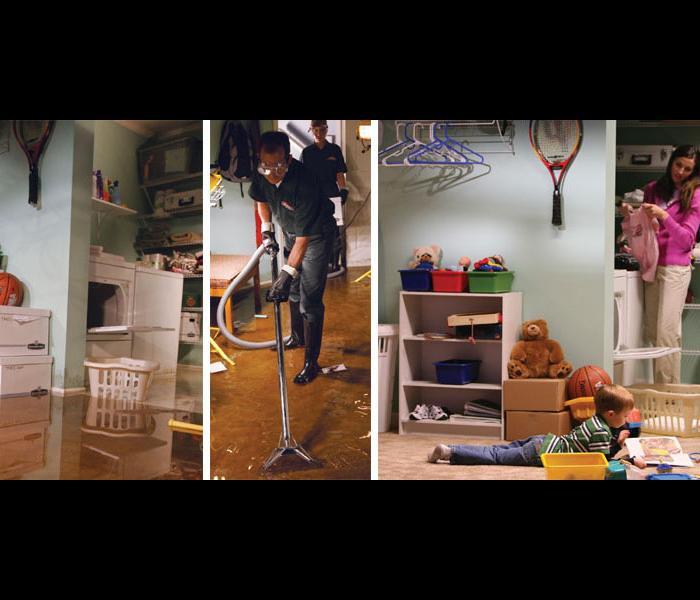 By following these steps before water mitigation begins, you can take great steps to avoid further property damage in your wet basement or other area
By following these steps before water mitigation begins, you can take great steps to avoid further property damage in your wet basement or other area
The period after a large storm or flood is often a hectic and confusing time. While waiting for SERVPRO to arrive to perform water damage or flood cleanup, here are some simple do’s and don’ts to follow until help arrives. By following these steps before water mitigation begins, you can take great steps to avoid further property damage in your wet basement or other areas of your home:
For CLEAN Water Losses
DO
1. Shut off the source of water if possible or contact a qualified party to stop the water source.
2. Turn off circuit breakers for wet areas of the building when access to the power distribution panel is safe from electrical shock.
3. Remove as much excess water as possible by mopping and blotting.
4. Wipe excess water from wood furniture after removing lamps and tabletop items.
5. Remove ad prop up wet upholstery cushions for even drying.
6. Place aluminum foil or wood blocks between furniture legs and wet carpeting.
7. Remove to a safe, dry place any paintings, art objects, computers, documents and other materials that are valuable or sensitive to moisture.
8. Use wooden clothespins to keep furniture skirting off damp floors.
9. Hang draperies with coated hangers to avoid contact with wet carpeting or floors.
10. Hang furs and leather goods to dry separately at room temperature.
DON’T
1. Enter rooms with standing water where electrical hazards may exist.
2. Enter affected areas if electrical outlets, switches, circuit breakers or electrical equipment are exposed to water. Always avoid electrical shock hazards.
3. Leave books, newspapers, magazines or other colored items on wet carpets or floors to cause staining.
4. Leave Oriental rugs or other colored rugs on wet wall-to-wall carpets to cause staining.
5. Use your household vacuum cleaner to remove water, possibly causing electrical shock or damage to the vacuum cleaner.
6. Use TV’s or other appliances while standing on wet carpets or floors, especially not on wet concrete floors.
7. Turn on ceiling fixtures if ceiling is wet or enter rooms where ceilings are sagging from retained water.
Additional Information for CONTAMINATED Water Losses
DO
1. Avoid all contact with sewage and items contaminated by sewage.
2. Wash your hands thoroughly after contact with contaminated items.
DON’T
1. Spread contaminated water by walking unnecessarily on damaged or wet areas.
2. Turn on the HVAC system is there is a possibility of spreading contaminated air.
3. Use household fans to dry the structure and spread contaminants.
4. Use products for personal hygiene and cleanliness if exposed to the contaminated area.
September 1 starts National Preparedness Month
9/5/2014 (Permalink)
Today is the first day of National Preparedness Month! This week will focus on How To reconnect with your family after a disaster? Make sure your family has a family emergency communication plan. How will you reconnect with each other? Where will you meet? What if your neighborhood is being evacuated? Communicating with your friends and family when a disaster occurs is important to make sure everyone is safe. This is why having both an evacuation and communication plan is important. Have peace of mind when a disaster strikes and create your evacuation and emergency communication plans. Ready to make a plan? Start today by visiting http://www.ready.gov/make-a-plan





 24/7 Emergency Service
24/7 Emergency Service
